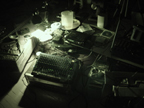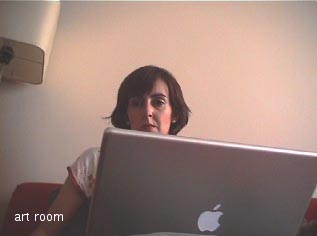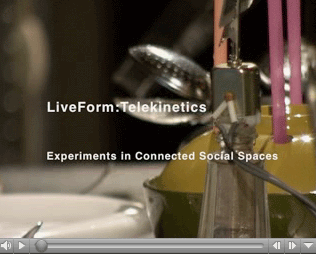July 10, 2007
The Hole in the Wall:
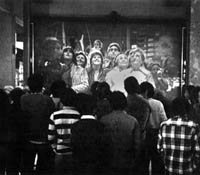
How Humans Connect No Matter What
In 1980, on a November evening in Los Angeles, pedestrians who walked past the glass windows of the Broadway Department Store noticed something strange…they did not see their reflection. There were other people walking by, just not them. They ended up talking with the alien reflections and realized that they were in two different locations, indeed, on other sides of a country: the Lincoln Center for the Performing Arts in New York City and the Broadway Department Store in Century City in LA. This work, called Hole-in-Space, was created by Kit Galloway and Sherrie Rabinowitz.
Last year I was recruited to a group to consult on a project for the Australian communications company Telstra. I recommended that Telstra, given their core brand is (I believe) enabling people to communicate with each other (not tourism!), that they install a contemporary version of Galloway and Rabinowitz’s work. Using their substantial communications infrastructure they could link together two key and important communities: rural Australia with urban Australia; and Australians in the street with people in the streets of the online virtual world Second Life. The project has been put on hold indefinitely and since the future of the project is unknown and I wasn’t compensated for my advice, I’m sharing it here. But recently I came across a different iteration on the theme, and one that bypasses the corporate and art world.
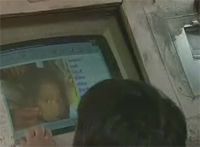
A few years ago Dr. Sugata Mitra, head of research and development at an IT firm in India, installed a computer in the wall of a slum area in India. He put it in to enable the children to use the computer and the Internet for free. He wanted to see what the children would do if they had unlimited and free access to these technologies. He called it the Hole in the Wall experiment. Within minutes, a Frontline segment explained, the children taught themselves computer literacy. Dr. Mitra has installed computers in many areas now and revels in the response. He is quite conscious of the immense impact of his cybernetic seed:
“If cyberspace is considered a place,” Mitra tells FRONTLINE/World, “then there are people who are already in it, and people who are not in it … I think the hole in the wall gives us a method to create a door, if you like, through which large numbers of children can rush into this new arena. When that happens, it will have changed our society forever.”
The segment told the story of the first boy to teach himself the computer and Net: Rajinder. He creates things using paint programs, plays games and browses the Disney website. His teacher notes that ‘he has become quite bold and expressive’.
When Dr. Mitra asks Rajinder to define the Internet, the doe-eyed boy replies immediately, “That with which you can do anything.”
And so, we move from people connecting with each other, to people tapping into possibility. The continuing theme, whether it is enunciated by artists, the corporate world or a single person who wants to heal the rift of the digital divide, is that of creating portals where once there where walls. It doesn’t matter if the wall, the ostacle is financial, cultural, geographic or technological, we’ll find a way to dissipate it. I’m so happy to have front-row seats to one of the most amazing times in Earth’s history.
Check out full Hole in the Wall article and video by journalist Rory O’Connor, and the amazing collection of Social Entrepenuers videos at Frontline/World. Thanks to Guy Kawasaki for posting about it. [blogged by Christy Dena on Cross-Media]
Posted by jo at 06:59 PM | Comments (0)
[1001] 1001 nights cast news
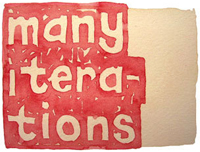
Have your Say, Workshop and more
1001 NIGHTS CAST News: THE THREE-QUARTER MARK; YOUR SAY; MOVING TIMEZONES; LONDON WORKSHOP.
THE THREE-QUARTER MARK: Sometime between tonight's performance (#750) and tomorrow's I will pass the three-quarter mark of the project. Since the two-third mark back in April, I'm very honoured to have performed stories by these new contributors to the project: Jordan Peimer (LA), Peter S. Petralia (London), Catherine Lord (LA), Adrian Heathfield (London), Sara Jane Bailes (Bristol), Karen Christopher (Chicago), Rinne Groff (NYC), Rebecca Schneider (NYC), Tony White (London), Geoffrey Batchen (NYC), Trevor Smith (NYC), Kate McIntosh (Brussels), Michael Grosberg (NYC), Hannah Chiswell (UK), Angela Piccini (Bristol), Lina Saneh (Beirut), Thalia Field (Paris), Alisa Lebow (London), Jane Gleeson-White (Sydney), Robin Bale (London), Branislava Kuburovic (Prague), Lara Pawson (London), Matias Viegener (LA), Kathryn Ryan (Sydney), James Tierney (Portland), Linda Dement (Sydney), Agnes Kocsis (London) and Nicholas Royle (London).
YOUR SAY: There is a new feedback section on the site. It's called Your Say. If you want to make a comment about a story, a performance or the project in general, please Have Your Say. You can choose to have it published on the site or to keep it private. If you want to see the published comments, hit the What You Said button.
MOVING TIMEZONES: The project moves to London on Tuesday July 17. That night, performance # 757 will be webcast at 9.10pm. That is: 10.10pm in Paris, Madrid and Prague 11.10pm in Jerusalem, Beirut and Istanbul 4.10am, July 18 in Perth, Hong Kong and Manila 6.10am, July 18 in Sydney 7.10am, July 18 in Auckland 4.10pm in New York, Toronto and Bogota 1.10pm in Los Angeles
LONDON WORKSHOP: Ten writers from the UK will join Barbara Campbell in London on July 20, 21 and 22 to write a three part story for the project. The writing workshop is part of DIY 4. DIY 4 is a collaboration between the Live Art Development Agency, Artsadmin, and New Work Network, and is being developed with Nuffield Theatre/LANWest, New Work Yorkshire, Fierce Festival, Colchester Arts Centre, The Basement Arts Production South East, and Dance4. DIY 4 is part of Joining the Dots, a Live Art Development Agency initiative supported by the Esmée Fairbairn Foundation and the Calouste Gulbenkian Foundation.
Posted by jo at 02:41 PM | Comments (0)
June 07, 2007
Charade
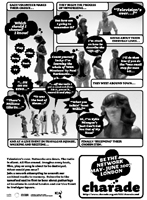
Distributed Performance & Live Event
Charade :: May-June 2007 :: ICA & Trafalgar Square, London, UK :: Television's over. Networks are down. The radio is silent. All files erased. Imagine every book, film, play or song is about to be destroyed. What would you save? Join a network attempting to commit our archived media to memory. Subscribe to the newsfeed and be first to hear about gatherings at locations in central London and our Live Event in Trafalgar Square.
Referencing the final scene of Francois Truffaut's film Fahrenheit 451, Charade imagines a future where our most treasured items from the media are under threat of destruction. When forced to rely on our own memories and bodies for storage and retrieval, how would our relationship to these artifacts change? What new forms of ownership and distribution might emerge?
Volunteers attempt to memorize a chosen piece of music, film, tv programme, play or book; through a process of walking, memorizing, remembering and reciting, they each attempt to 'become' their favourite media asset; over a period of one month they meet at ad hoc gatherings at locations in central London; at a large-scale public event in Trafalgar Square all volunteers congregate to recite their chosen piece while wandering together, en masse – a re-creation of the final scenes of Truffaut's Fahrenheit 451.
Originally commissioned as part of the BBC & Arts Council England's Private View in 2006, Charade is a supported in London by the ICA.
Charade is a new work by Simon Pope and is produced in partnership with Capital Art Projects. [Related]
Posted by jo at 10:47 AM | Comments (0)
April 20, 2007
N3KROZOFT LTD's Aether 9
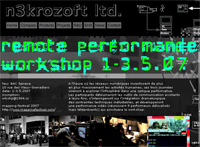
Collaborative Video Performance
the N3KROZOFT LTD media group is pleased to announce the world premiere of the collaborative video performance, Aether 9. Linking nine performers in various remote locations around the globe, this performance will occur on May 3, 2007, 21:00 CET, in the framework of Mapping Festival Geneva, in conclusion to a 3-day workshop directed by N3KROZOFT members.
Conditions of participation: [1] Participating in the workshop : If you wish to follow the workshop in Geneva: plase send an email to wrkshp[at]1904.cc describing briefly your experience and motivations (moderate knowledge and experience of video tools + originality of ideas is expected). Workshop dates are: May 1st-3rd, 14:00-18:00. Workshop location: BAC, Geneva (see below).
[2] Participating as a remote performer: Artists wishing to participate in one of the remaining performance slots: please send an email to remote[at]n3krozoft.com. Requirements for remote performers:
- You need to have access to an imaging device (webcam, miniDV camera) and a computer linked to the internet.
- Sufficient knowledge of video tools + performance is expected, to operate for instance a webcam and upload its images to a server. Server access will be provided.
- Knowledge of Max/msp or Pure Data is an advantage, but not a necessity.
- You are required to be available through skype or similar protocols for instructions and synchronisation during the days prior to the performance (1st-3rd May).
- 100% availability during the performance and at least 1 hour prior to performance is crucial.
Questions and Answers
Q - What will this look like?
A - The basic concept: 9 different locations will be linked during a 60 minute performance. The performance will be projected as a 3x3 grid of videoframes.
Q - When and where will the performance take place?
A - The performance will occur on Thursday 3rd May 2007, 21:00 (9 PM) Central European Time. The location is the BAC (Bâtiment d'Art Contemporain), 10 rue des Vieux-Grenadiers / 28, rue des Bains, Geneva, Switzerland.
Q - Is it possible to watch the performance on the internet?
A - The performance will be visible through the internet. Not directly as a video stream, but as a standalone viewer application, which will be available at http://n3krozoft.com/remote. If you are in charge of a public venue, you are welcome to use the standalone viewer to broadcast to performance to an audience. Click here to find your local performance time: http://tinyurl.com/2rjxhb
Q - Will there be any dogma/ritual imposed on the performers?
A - The content of the performance will be dictated by a formal set of rules, which will be established in part during the first 2 days of the workshop. The significance of time and the subjectivity of human experience in a specific
timeframe will be a crucial element of the performance.
Q - What technology will be used for the transmission of images?
A - To insure the possibility for performers in low-tech situations to participate, the system will be designed for robustness rather than for speed. Since streaming video needs a considerable upload rate, the transmission of images will occur rather through image-by-image upload, allowing participants to use slower transmission lines. The target frame refresh rate will be 5 seconds, similar to the transmission rate of the videophone devices in use during the 1990's. At the main performance venue, buffered playback will occur at much faster or slower framerates, depending on the performer's actions.
Posted by jo at 10:33 AM | Comments (0)
April 15, 2007
Turbulence Commission: The Simultaneous Translator

ONLINE Performance Today
Turbulence Commission: The Simultaneous Translator by John Roach and Willy Whip [Requires Windows OS] LIVE PERFORMANCE: Sunday April 15; 12:00 PM EST to 3:00 PM EST [Mac users can listen via the player of their choice].
"The Simultaneous Translator" (SimTrans) is a Windows based audio interface that enables anyone to load audio streams and manipulate them in real time on the Internet. SimTrans makes the delays and fluctuations of the Internet visible and audible. The Internet becomes your collaborator as you create your mix, and the instability you usually try to avoid becomes a tool for creation. Distance and delay are manifest within the interface numerically and as a series of sliding heads; there is also a link to Google Earth where you can watch the dynamic flight of data travel between yourself and the audio source.
“SimTrans” is a 2007 commission of New Radio and Performing Arts, Inc., (aka Ether-Ore) for its Turbulence web site. It was made possible with funding from the Murray G. and Beatrice H. Sherman Charitable Trust.
THE PERFORMANCE: "The Simultaneous Translator" grew out of the artists’ live networked performance project "Simultaneous Translation," in which the delays of the internet are used to dynamically effect the live performances of geographically distant artists.
The upcoming performance will take place from 12:00 PM EST to 3:00 PM EST on Sunday April 15. Log on via http://turbulence.org/Works/simtrans.
Participants: Greg Davis (USA), Kenneth Goldsmith (USA), John Hudak (USA), Keyman (France), Lawrence Li (China), Mice69 (France), Miguel Ramos (Spain), Joe Reinsel (USA), John Roach (USA) and Willy Whip (France).
BIOGRAPHIES
JOHN ROACH doesn't consider himself an installation artist, a sound artist, or a sculptor, but prefers to think of himself as a nomad, touching down in whatever place is most hospitable to his ideas. Recent projects have been an installation at the 2B Gallery in Budapest, Hungary; a collaborative performance with objects and video at the Saint Stephen Museum in Szekesfehervar, Hungary; and a web video project called Sweet Music. He continues to work with Willy Whip on their long-standing live networked performance project Simultaneous Translation.
WILLY WHIP is a designer and teacher in hypermedia interactivity. Outside his institutional work he likes to produce mashups that fertilize his own secret garden. This personal research and development leads him on a quest for hybrids: connect this information to that information; grow new contents; release new senses. Recent activity includes projects with the artists Anika Mignotte, Reynald Drouhin, and Du Zhenjun.
Posted by jo at 11:55 AM | Comments (0)
April 10, 2007
Turbulence Commission: The Simultaneous Translator
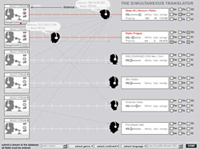
Live Performance on April 15
Turbulence Commission: The Simultaneous Translator by John Roach and Willy Whip [Requires Windows OS] LIVE PERFORMANCE: Sunday April 15; 12:00 PM EST to 3:00 PM EST
The Simultaneous Translator (SimTrans) is a Windows based audio interface that enables anyone to load audio streams and manipulate them in real time on the Internet. SimTrans makes the delays and fluctuations of the Internet visible and audible. The Internet becomes your collaborator as you create your mix, and the instability you usually try to avoid becomes a tool for creation. Distance and delay are manifest within the interface numerically and as a series of sliding heads; there is also a link to Google Earth where you can watch the dynamic flight of data travel between yourself and the audio source.
“SimTrans” is a 2007 commission of New Radio and Performing Arts, Inc., (aka Ether-Ore) for its Turbulence web site. It was made possible with funding from the Murray G. and Beatrice H. Sherman Charitable Trust.
THE PERFORMANCE: The Simultaneous Translator grew out of the artists’ live networked performance project "Simultaneous Translation," in which the delays of the internet are used to dynamically effect the live performances of geographically distant artists.
The performance will take place from 12:00 PM EST to 3:00 PM EST on Sunday April 15. Log on via http://turbulence.org/Works/simtrans.
Participants: Greg Davis (USA), Kenneth Goldsmith (USA), John Hudak (USA), Keyman (France), Lawrence Li (China), Mice69 (France), Miguel Ramos (Spain), Joe Reinsel (USA), John Roach (USA) and Willy Whip (France).
BIOGRAPHIES
JOHN ROACH doesn't consider himself an installation artist, a sound artist, or a sculptor, but prefers to think of himself as a nomad, touching down in whatever place is most hospitable to his ideas. Recent projects have been an installation at the 2B Gallery in Budapest, Hungary; a collaborative performance with objects and video at the Saint Stephen Museum in Szekesfehervar, Hungary; and a web video project called Sweet Music. He continues to work with Willy Whip on their long-standing live networked performance project Simultaneous Translation.
WILLY WHIP is a designer and teacher in hypermedia interactivity. Outside his institutional work he likes to produce mashups that fertilize his own secret garden. This personal research and development leads him on a quest for hybrids: connect this information to that information; grow new contents; release new senses. Recent activity includes projects with the artists Anika Mignotte, Reynald Drouhin, and Du Zhenjun.
Posted by jo at 09:20 AM | Comments (0)
March 21, 2007
Virtual actors take to the stage
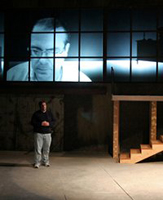
"Beamed" from Florida to Illinois
"Actors working in real time from remote locations have been beamed onto a stage where they performed with live, in-the-flesh actors, US researchers say. The broadband-enabled experience allowed the audience to watch a seamless, 3D performance, according to the University of Central Florida. The technology could mean future theatergoers might attend plays where one or more actors are working outside the venue, even in a different country, or from their own homes. "We are not talking about holograms yet or the kind of imagery that requires funky glasses," says Professor John Shafer, a member of the cast. "[But] what we have done for this production has indeed pushed the envelope significantly. The production is a small historical step forward on several levels."
Shafer was hooked to a receiving and transmitting broadband-connected computer that can pull 130 megabytes of data in an instant. Although he performed in Florida, his body was 'beamed' onto a stage at Bradley University in Illinois, where he performed 'with' live actors there, as well as with actors beamed in from the University of Waterloo in Canada. Both 3D and 2D sets consisting of multiple screens and special-effects lighting that helped to give the impression that all the actors, remote or not, existed in a single space." Continue reading Virtual actors take to the stage by Jennifer Viegas, ABC Australia News In Science. [via]
Posted by jo at 08:41 AM | Comments (0)
March 14, 2007
Franck Ancel's Triptych
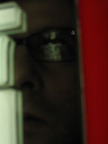
5/5 + 5C + 5G
5/5: In 2004, Franck Ancel completed a triptych on architecture, image and technology by projecting the words "Mobile Wireless Digital" onto the screen of the Montparnasse Tower in Paris. Today, under the title "5/5", he is projecting on the Théâtre de l’Agora à Evry, France his two projects "5C" and "5G", in connection with this line of research.
The trail presented here in the shape of a diptych challenges known and recognized limits, and the outdated boundaries of the past. These documents trace the use of a special form of GPS tracking based on a real experience, that of a separate journey, while also questioning virtuality in the age of world globalisation. Therefore, it is not about abandoning criticism of technological uses to technological uses of criticism. After all, it is through a person's very existence that the temptation to understand the space of his or her time arises, and this forms the focus of this presentation, in which a particular journey becomes an objective creation.
5 Continents (5C): Between 18:00 and 19:04 hours, Paris time, on Saturday 17 December 2005, the first artistic creation from an in-flight passenger plane took place. It was transmitted live over the Internet during a flight from Shanghai to Munich, at an altitude of 30,000 feet and at a speed of over 900 kilometres an hour. This live transmission at "X" moment was the culmination of a series of 5 communications "From Scenography to Planetary Network", for and on 5 Continents.The transmission was posted in real-time on our website, via a wifi satellite link relaying images and sound from the plane. This performance was made possible thanks to Lufthansa's offer to provide FlyNet with Boeing's in-flight online connectivity service, Connexion by Boeing.
This webcast makes a formal nod to the sleeper John Giorno, the poet of "Sleep", a legendary film for the Neo avant-garde art movement made by Andy Warhol in 1963, New York. This time round, a sleeper has left the Asian New York of tomorrow. This world first lasted 64 minutes. In the video recording 64 key words appeared in a combination of 12 interplays on five themes (five continents, colours, senses, elements, years), initiated with an eye to the forthcoming 2010 World Expo in China.
5 Guggenheims (5G): In 2006 we collected data in front of the 5 Guggenheim museums. The traces of this journey echo the possible virtual construction of a space on a planetary scale symbolised by these museums. The shift from a fluid virtual architecture to a constructed reality takes shape in the form of a 3D video animation created by Bryan Bey and a resin model created with 3D prototyping, made in collaboration with the IDO creation company from the elements we had gathered together. 5G is made up of photos and GPSb.
Posted by jo at 11:03 AM | Comments (0)
February 24, 2007
Do It With Others (DIWO): E-Mail-Art at NetBehaviour

A Collaborative Exhibition at HTTP Gallery, London
Hi DIWOists,
The Furtherfield crew has been discussing ways to get the most out of the co-curating session on Sunday when we will discuss and experiment with ways of exhibiting the contributions at HTTP gallery (don't forget the opening is next Thursday).
Other known contributors to this process in the gallery on Sunday are Frederik Lesage and james[at]jwm-art.net, others are welcome. Please check back with the list at 1.30 on Sunday for details of thewebcast and public chat room where you can join the discussion online. Until then you can view a gallery floor plan and tech spec here.
So here is a summary of our considerations, proposals and a number controversies for your feedback!
CONSIDERATIONS:
1) How to Survey the Contributed Materials for the Curation Process: There have been over 600 posts to NetBehaviour since the start of this project and we have 2-5pm on Sunday to review and discuss how to present contributions. The main ways that we have for looking at work is:
- through our mailboxes
- through an index of attachments that can be view browser here
Your Suggestions Please: We would like your suggestions for any other (reasonably straight forward) way to order materials for review.
2) Categories - How to Order and Discuss Materials.
It would be useful to have some broad themes or categories to discuss. Here are a couple of possible categories with examples (and these really are just examples) of what we mean.
- Threads - discussions, exchanges, actions and responses eg Sachiko Hayashi's 'The Other Half',
- Collaborations and remixes eg RandomLab's reblogging and remixing, Michael Szpakowski's remix of Thomson and Craighead's 'Additions' image
- Digital becomes Material eg Sim Gishel has sent a 'Will Work For Food' vehicle, brian[at]netartguy's currency could be laser-printed as actual currency, Other works proposed for print, Other works actually sent to HTTP etc
- Proposals/ Instructions- eg Ant Scott's installation proposal, Glorious Ninth's Love Potions
- Generative/machine Art- eg. Sim Gishel's data-mining, ARN's generative pngs
- Stand alone streams - movies, soundfiles and images eg images by Clive McCarthy, lem urtastic - movies by Lizzie Hughes, Alan Sondheim - mp3s by james[at]jwm-art.net
- Texts eg Janedepain's recent 'Poetic Terrorism and Guerrilla Art in the 21st Century' and technical discussions.
PROPOSALS:
1) We propose that the main projection consists of a Mailbox containing a DIWO archive for searching by gallery visitors. This would be organised into themed directories that would coincide with the categories listed above. PLEASE SUGGEST: more or other categories.
2) We propose that we highlight and exhibit some 5-8 works (made by individuals or collaboratively) in the form of objects, printouts, projections and sound. These would be up for discussion and debate from this point - to be decided on Sunday.
CONTROVERSIES:
1) The question of selection - how do we create an exhibition in a physical space that communicates the DIWO spirit?
- how do we highlight a selection of works?
- how do we stay true to the open principle of including all submissions?
2) Contextualisation
- do some works need contextualising in order to be accessible to gallery visitors eg should some works be displayed with titles, artist, date, materials, description of process etc?
- if so how, and who does it?
3) Is everything that has been posted to NetBehaviour since February 1st considered a submission to DIWO?
- including announcements and reblogging?
4) A number of people have proposed works in private emails to Marc or myself- should these be included under the rules of submission?
Whoever wants to contribute to the curation of this show- share your views here on the list or come along on Sunday ttp://www.http.uk.net/DIWOcurating.shtml
Let's DIWO!
: ))
Ruth [via netbehaviour]
Posted by jo at 12:01 PM | Comments (0)
January 24, 2007
Joe Winter
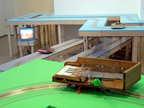
Fantasie no. 1 for Mobile Pianos
Fantasie no. 1 for Mobile Pianos is a kinetic sound and video installation. Five modified toy pianos circulate the gallery on five elevated wooden tracks. Each piano is equipped with small speakers to play amplified sounds picked up from conductive tape on the tracks. Each piano also contains small motors which intermittently spin to strike the toy pianos' tone bars, adding acoustic elements to the overall soundtrack of the work.
The installation also features five video monitors, which display images of five different real landscapes to compliment the abstract landscape of the wooden tracks. As the pianos begin to move around the gallery, these video landscapes become populated by a seemingly infinite stream of mobile pianos.

Distributed Performance
Distributed Performance takes place in multiple sites throughout a single building. Each site, or 'node,' is comprised of installed speakers, wire, various amplifiers, microphones, and a computer. All nodes are interlinked, both by audio cable and via ethernet. Each computer features the same display: an abstracted map of the space and the nodes within it, through which audio materials flow. When visual representations of audio flow within the spatial boundaries of a particular node, it is sonified there. The performer's presense at a particular node will serve to attract audio material to that location and to slowly organize it into rhythmic structures. Simultaneously, the programming may usurp the performer's control and direct the flow of materials elsewhere. The display may then serve as a map--both to the performer and the audience--to direct the flow of the performance from node to node. More >>
Posted by jo at 03:57 PM | Comments (0)
Viroid Flophouse
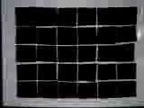
An Exploration of Playable Art
The Viroid Flophouse was an exploration of playable art in an online gaming environment, which incorporated movement, motion tracking, streaming technologies and telematic performance, within the common theme of "virus."
It was a hybrid game/performance environment created by ADaPT (Association for Dance and Performance Telematics) which includes among others Arizona State University (Tempe, Arizona), Nottingham Trent University (Nottingham, UK), Wayne State University (Detroit, Michigan) and Waag Society for Old and New Media (Amsterdam, NL).
The sites functioned as rooms in the "flophouse," in which on-site participants could interact with remote participants.
The ADaPT members involved in this production included a team from Arizona State, spearheaded by John Mitchell, a small team from Waag Society headed by Josephine Dorado, with additional input from Johannes Birringer (Nottingham Trent University).
Previous renditions of the project:
ADaPT had already experimented with one rendition of the project, named the Saira Virous which involved teams from Nottingham Trent University, headed by Johannes Birringer, and Wayne State University, headed by Kelly Gottesman.
Birringer's documentation of the Saira Virous can be viewed at the following urls:
http://art.ntu.ac.uk/performance_research/birringer/lat5.htm
http://art.ntu.ac.uk/performance_research/birringer/lat.htm
http://art.ntu.ac.uk/performance_research/birringer/lat4.htm
That rendition of the project mainly focused on the extension of dance performance telematically within an online gaming infrastructure, via streaming and projected media integrated with live performance.
The introduction of OSC (Open Sound Control protocol) into the gaming structure: In our rendition of the project, the goal was to enhance the interaction by incorporating the sending and receiving of OSC data (Open Sound Control protocol) combined with motion capture, into the scenario.
The incorporation of osc data transmission over a network, in combination with motion capture via softVNS, enabled the sites to communicate the performers’ positions to each other. That data, in turn, could be used to control game events.
The gaming structure: The game structure was developed and was based on the action of the remote and local gamer "sharing" the same space. In other words, the gamer in Arizona and the gamer in Amsterdam had to position themselves in the same virtual gaming space in order to get to the next level. The game was played by Arizona and Amsterdam players in this fashion, with supplementary commentary being streamed in sports commentary style, from Birringer.
Posted by jo at 09:45 AM | Comments (0)
RPM's Remixed
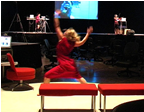
A Virtual Space "Sings"
RPM's Remixed is a telematic, transdisciplinary performance based on remixing Alvin Lucier's RPM's score – integrating dance, video and sound improvisation between artists in New York, Tampa, and San Jose.
Alvin Lucier, a well-known composer of music and sound installations that explore natural phenomena and resonance, is renowned for making spaces "sing." This piece explores the possibilities of using one of his scores to make a virtual space "sing" by using improvisational techniques as well as the natural feedback and delay created by streaming.
Themes exploring isolation, intersection, and madness reverberate through images, body and sound. Dancers and sound artists in San Jose, Tampa, and New York collaborate while realtime processing of the video images is driven partially by the performers’ movements. Motion analysis is sent over the network to trigger aspects of video manipulation, further blurring the lines of authorship and contributing to the impromptu chemistry.
Lucier’s original “RPM’s” score was a tongue-in-cheek take on creating sound based on depressing and releasing the accelerator of an Aston Martin engine. The score itself is a series of nonsensical curvatures and dashes – nonsensical, that is, until a personal interpretation of each written gesture is applied.
Taking this a step further, the cast of RPM’s Remixed deconstructs the score, into dance gestures, violin strokes, guitar riffs, and sound and video mashing. The challenge is not only to collaborate within one’s own medium but to improvise successfully between mediums and within a virtual space. Can the magic of improvisation reach across the ether? [via Rhizome]
Posted by jo at 09:33 AM | Comments (0)
January 09, 2007
Dune & Devil
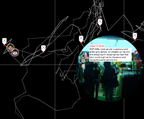
Tracking Vienna + Tokyo through Dune+ Devil
Dune & Devil (2003-present) explores a space- and time-based phenomenon through communicational technoculture. The aggregation of «•» applies different structures like global positioning systems, audiovisual media, mobile technology, tele-communication tools and specialized software, to experience the stereotopographical synchronization of two individuals in different urban situations. We are trying to translate this spatial experiment under the condition of a unique geosocial application to translate this individual, cultural and technological impact in our DIY-habitat. The project produces a sociographic disposition of a mixed reality which can be observed through the interface of dune-n-devil.com.
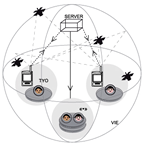
We are using two handheld computers with additionally installed open source java virtual machines (btw, thanx to mr. freebeans/japan for preparing mysaifu!) on a windows mobile operating-system. A specially, for this project, self-developed java application, is used to interconnect the two mobile computers via UMTS/GPRS for communication and navigation. The incoming GPS-data is streamed to a mysql database which collects all data produced (both outputs: Dune/Vienna and Devil/Tokyo). At last, the database provides the flash application for the visualization of the project «•» on the website.
Public space is constantly ehanced with new infrastructures of communication such as GPS, wireless internet, telecommunication protocols, location based services, mediatectures and many more. This modification of reality happens through the new possibilities of information-technologie, interface-culture and interaction. The basic goal of the communication based sychronization-system «•» is tracking digital processes in two different cultural situations (vienna & tokyo) through two different observers (Dune & Devil), and to merge this into one sensation. We are trying to translate this spatial experiment under the condition of a social application in a creative process of constructing new ways in media and art. Dune & Devil will incribe themselves into these connected, synchronized, totally different realities. This change of perspective through individual selection, dependent on the attention and the cross-link of these two realities, explain how space andt time are related to the observer and the system of observing.
Posted by jo at 10:31 AM | Comments (0)
December 12, 2006
NOMUSIC.ORG Festival X

Simultaneous Translation
Simultaneous Translation, an international collaborative web audio project, will participate in the NOMUSIC.ORG Festival X on December 13, 10pm - 11pm EST. Participants for this round are: Greg Davis (USA - Vermont) - live instruments and voice; Kenneth Goldsmith (USA - New York) - words; John Hudak (USA - New York); Lawrence Li (CHINA - Bejing) - English to Chinese translation; Joe Reinsel (USA - Maryland) - Processing; John Roach (USA - Brooklyn) - Spiral Staircase; and Willy Whip (FRANCE - Nantes) - SimTrans Software.
People speak their own languages with little concern about the etymology of the words they speak, or the structural evolution that occured as their language moved geographically, passed from person to person, changing form along the way. Similarly, people trade information on the internet without thinking how the content changes as it passes through multiple users' hands. We rarely think about the geographical aspects of the web and the number of routers that a packet of data must pass through in order to reach its destination. Communication appears instantaneous, the internet seems to defy the common barriers to remote communication such as distance and delay. In reality, the data, invisible to the average user, is still subject to these factors.
Simultaneous Translation explores these limitations of distance and time through the lens of streaming media. Just as language has changed over time and as dialects have evolved as groups of people moved from place to place, so in this project sound is effected by the distances it travels and the time it takes to get there.
Simultaneous Translation is a collaboration in which the strengths and weaknesses of the medium are allowed to become active and shaping ingredients. Fluctuation and indeterminacy are not only inevitable, but desired. Variable stream quality, rebuffering, unexpected dropouts, these are the elements (like bad grammar or slang) that can launch the language into unforseen directions and vibrant neologisms.
The project is designed to be flexible and many of its elements (software, visual components, text, participants) will change as the project moves from host to host.
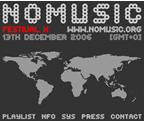
(((NOMUSIC))) wishes to generate improbable duals and gatherings between two participants during one hour time in a web audio performance. We make no storage because we think that Internet is a huge database which conveys already a great amount of dead informations and we don’t want to pollute it further. We are thus in favour of instant access to a selective event. The mechanism of the programming is not automated; it is relayed manually for 24 hours without any interruption by laboiteblanche and Carl.Y, two real human routers who are at the service of continuous audio stream and who endure technical difficulties and give rapid formation on the technologies of streaming to all the participants...
No-music stands between musical negation and anti-bruitism, in a non-silent interstice of audio manifestation. It allows the composer-performer to be his own auditor, in a place where nothing should be heard but just felt as a new entity to observe.
Posted by jo at 02:33 PM | Comments (0)
Oppera Internettikka - Protection et Sécurité
![]()
LIVE internet broadcast!
Intermedia Performance :: Oppera Internettikka - Protection et Sécurité by Annie Abrahams & Igor Stromajer :: Salle Molière, December 15th 2006, 8:30 PM GMT+1 :: Opéra National de Montpellier Languedoc Roussillon, France.
LIVE internet broadcast! English; Français. Please get VLC Media Player or Winamp Media Player or any adequat OGG-stream player ready beforehand.
"Oppera Internettikka - Protection et Sécurité" explores the poetics of a contemporary sound form -- opera as a sound event for the audience in the form of a live internet audio broadcast. In that way it combines the notion of the world wide web communication protocols and classical artspace -- an opera house. Opera is a very strictly coded form of art with a lot of passion, and internet is a lonely place of solitude and intimate communication which is becoming more and more fragile, dangerous and suspicious.

[left: Abrahams, middle: Stromajer, right Kattner]
authors: Annie Abrahams & Igor Stromajer
soundscape: Jan de Weille
live realtime audio streaming & logistics: Clément Charmet
Mutter Courage: Annie Abrahams, artist
Secret Agent: Christine Kattner, opera singer, mezzo-soprano
Big Brother: Igor Stromajer, intimate mobile communicator
Co-produced by bram.org (France), Intima Virtual Base (Slovenia), Association Panoplie (France), 2006. Executive producer: Elisabeth Klimoff (Panoplie Artistic director).
Project supported by The Ministry of Culture and Communication of the Republic of France (DRACLR), The City of Montpellier, le Conseil Régional Languedoc Roussillon, The Ministry of Culture of the Republic of Slovenia, Rhizome.org 2006-2007 Commissions, Languedoc-Roussillon Cinéma.
ANGST ESSEN SEELE AUF
Duration: 53 minutes.
Reservation and information:
Association Panoplie
5, rue Bayard, 34 000 Montpellier, France
+33 (0)4 67 64 64 21
info[at]panoplie.org
Posted by jo at 11:04 AM | Comments (0)
December 06, 2006
JOIN KUNSTRADIO'S
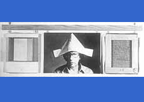
Celebration of Art's Birthday
INVITATION TO JOIN KUNSTRADIO'S CELEBRATION OF ART'S BIRTHDAY 2007! ::Art’s Birthday 2007: Adore and be still ::100 years of radio
Art's Birthday Party is a celebration in memory of Robert Filliou who declared, on January 17 1963, that Art had been born exactly 1,000,000 years ago when someone dropped a dry sponge into a pail of water. After Filliou's death in 1987, some artists began to celebrate Art's Birthday in the spirit of his concept of "The Eternal Network" or "La Fete permanente". The Birthday parties took place in different cities across the world, and artists were asked to bring birthday presents for Art – works that could be shared over the network.
On Christmas 1906, on the other hand, Reginald Aubrey Fessenden undertook the very first radio broadcast of voice and music. Luckily, he had the foresight to time his experiment exactly, its 100th anniversary practically coinciding with the 1,000,044th birthday of Art. We therefore ask you to join Kunstradio's celebration of this stunning fact. We invite you to search your own territories for further firsts in radio history. Premieres of different kinds; the first transmission in stereo, the start of a series of brilliant shows, the first time you listened to the radio, the first time they played 'your' song, the first time you were broadcasting, were on air.
Soundfiles of these broadcasts we ask you to upload to our website.
Feeding on your individual sonic archives and this database of numerous people's special radio moments you can then assemble your own radiophonic versions of our medium's history. These we invite you to stream to our party in Vienna on January 17th, 2007. We will re-mix and further distribute your streams via our live Kunstradio broadcast on the cultural channel of Austrian National Radio Ö1,as well as in our slot on the EBU satellite.
Should you have any questions, please do not hesitate to contact us under kunstradio[at]kunstradio.at
Please feel free to spread the word! This is the party you can bring along as many people as you like!
The short version:
What do we want?
A present. Not for us, for Art's birthday.
Which present?
Your radio's history. Or: Your history of radio.
How?
Streamed, mailed, sent, posted, uploads at
http://kunstradio.at/PROJECTS/AB2007/index.html
Format?
mp3 files, live-streams, images, webcams, ..
When?
January 17th, 2007 from 20:00 - 24:00 CET, 19:00 - 23:00 GMT
Why?
To celebrate.
What?
Art's Birthday.
Posted by jo at 04:34 PM | Comments (0)
November 17, 2006
XpositionREVERSE
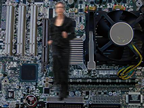
A Modern Gesamtkunstwerk
XpositionREVERSE :: Aarhus/Denmark – Gothenburg/Sweden :: Real-time streaming: web :: November 29 -December 2; 8 p.m.
XpositionREVERSE is a live digital chamber performance about position and identity on and with the Internet. Presented simultaneously in Aarhus and Gothenburg, and streamed on the Internet, XpositionREVERSE s a surrealistic and humorous montage of new text, dance, video, electro acoustic music and streamed bits. A modern Gesamtkunstwerk, placing itself somewhere between installation and the intimate chamber play. Inspired by cabaret, sitcoms and cosy evenings in the sofa.
XpositionREVERSE is a complex creation about being outside and excluded contra to be inside and included. About being in the centre of the events contra being in the periphery. The performance is about the modern man’s need to be "on" and wish for "15 minutes of fame". But do we only exist if we are seen, filmed and are placed in the focus point of the media lens? What defines centre and where is it placed? And what will happen, if focus is moved and periphery and centre is swapping place?
To be another place. Another position. Xposition.
To expose oneself. Exposure. Exposition.
PARTICIPANTS IN AARHUS
Staging, choreography and performer: Annika B. Lewis
Dramatist and performer: Gritt Uldall-Jessen
Interactive media and set design: Signe Klejs
Composer and live music: Anders Krøyer
Video technique and live music: Jens Mønsted
Internet architect and streaming: Jonas Smedegaard
For more information about live location in Aarhus and ticket reservations contact EntréScenen: phone: +45 86 190079 (10 – 16)
Produced by Kassandra Production in collaboration with Atalante in Gothenburg and EntréScenen in Aarhus, with others. Subsidized by The Municipality of Aarhus’ Kulturudviklingspulje, Koda, Dansk Skuespillerforbund and Tuborgfondet, with others.
Posted by jo at 12:34 PM | Comments (0)
October 15, 2006
Turbulence Commission:
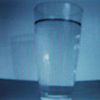
"Nothing Happens - a performance in three acts"
Turbulence Commission: Nothing Happens by Nurit Bar-Shai, Zachary Lieberman and Rich Miller :: Nothing Happens is a networked online performance in which the viewers work together to make a series of objects tip over. The performance consists of three acts, which are centered on staged environments – a high shelf, a cluttered tabletop, and a deserted corner. Each scene contains a central protagonist, respectively: a cardboard box, a clear pint glass full of water, and a wooden chair. In all three acts, web-enabled physical devices controlled by the viewer’s clicks will make these objects tip over.
The three acts will be presented on October 15th, 22nd and 29th at 3rd Ward gallery Brooklyn. Please join the artists for an opening reception Sunday, October 15, 2006 6-8 p.m.
"Nothing Happens" is a 2005 commission of New Radio and Performing Arts, Inc., (aka Ether-Ore) for its Turbulence web site. It was made possible with funding from The Greenwall Foundation. Additional support from 3rd Ward Gallery.
BIOGRAPHIES
NURIT BAR-SHAI'S main interest lies in exploring tensions between the mundane and the uncanny in everyday life. Emanating from her creative roots in fine arts, Bar-Shai employs video and new technologies to explore fundamental questions of presentation and representation, to reframe the familiar and turn audiences into foreigners in their own ontological domains.
ZACHARY LIEBERMAN'S work uses technology in a playful and enigmatic way to explore the nature of communication and the delicate boundary between the visible and the invisible. He creates performances, installations, and on-line works that investigate gestural input, augmentation of the body, and kinetic response.
RICH MILLER is a sculptor and a recent graduate of the Interactive Telecommunications Program at NYU. His creative energies are focused on making electro-mechanical pieces that humor him, as well as designing and fabricating innovative and dynamic children’s museum interactives and furniture. He lives and works in Astoria, NY.
Posted by jo at 02:15 PM | Comments (0)
September 29, 2006
Ping Pong Placard

Paris-Taipeh-Kyoto
September 29 - October 1, 2006 :: Paris, France; Taipeh, Taiwan and Kyoto, Japan
The Paris-Taipeh-Kyoto Ping Pong Placard will take place this week end in an appartment of Paris and in other locations in Taipeh and Kyoto. The Placard consist of a series of one-hour performances & live acts being streamed (through Internet) and performed between Paris, Taipeh and Kyoto. There will also be some events and actions requiring or not requiring physical displacement.
You can find the updated information here. You are warmly welcome to this event, which I hope you will enjoy. If you cannot make it to Paris, Taipeh, Kyoto or Bruxelles, you may either want to check out the other "Listening Placard" (see about page linked below of the FAQ) or create one Listening Room yourself. You can also join us on IRC through the placard website.
Thanks a lot to all the people who started the whole thing, helped throughout, participated, shared the fun, played or are going to play, maintained the positive energy and the creative spirit, forwarded or are going to forward this invitation to whoever might be interested, they know who they are.
See you there.
Philippe
http://xlrmx.org
Placard 2006: Placard is an international electronic music headphone festival featuring many artists from different places, experimenting with sound and music. You can check out more info at the about page. The Paris-Taipeh-Kyoto Ping Pong placard will be held from September 29, 2006 to Oct 1 2006 in Paris, France; Taipeh, Taiwan and Kyoto, Japan. It's free and you can apply to play there.
Posted by jo at 10:57 AM | Comments (0)
September 18, 2006
Connecting Worlds

Creative Possibilities of the Networking Age
09.15-11.26.06 :: Connecting Worlds, the first exhibition after the renewal of NTT InterCommunication Center[ICC] focus on the "communication", with contributions exploring the creative possibilities that emerged out of the new environments of the networking age.
'As the first exhibition since the reopening of ICC, this show raises-from the horizons of art and programming-practical alternative possibilities of various phases of communication that we currently see around us. This exhibition features artwork and projects that take a unique step into contemporary networks, politics, economies, physiology, or urban environments by manipulating sound, games, the Internet, or other media as well as foreseeing artwork created in the past.' Yukiko Shikata, curator
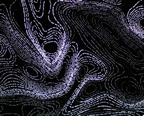
cyclone.soc by Gavin BAILY + Tom CORBY, UK 2005 :: CYCLONE.SOC brings together two contemporary phenomena: (1) severe weather, the project uses weather data that charts the emergence and progress of hurricanes; (2) the polarized nature of debate that occurs in certain online newsgroup forums. The project maps textual conversation taken from the political and religious newsgroups to the isobars of a dynamic, interactive weather visualization of hurricanes - whose complex structures are used to visualize the conversational churn and eddies of the newsgroup conversations.
In staging these interactions as a process of meteorological precipitation, newsgroup conversations "condense" in the works environment as a temporal ambient patterning - a structuring that acts not only as a metonym of difference, but of ideological tensions which mirror the dynamics of social space. CYCLONE.SOC is a navigable environment that gives the user the ability to zoom in or out and skate across and through the cyclonic weather formations in order to read or be immersed in the newsgroup text.
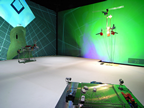
OBJECT B by exonemo, Japan 2006 :: OBJECT B 2006 Yamaguchi Center for Arts and Media (YCAM) YCAM InterLab Installation presenting a modified first-person 3-D shooting game with kinetic objects and a virtual-reality setting. Installed inside the three-dimensional environment created through projections onto all four walls of the exhibition space, are three objects made of keyboards, mice, and other computer parts and electric tools, and a control terminal for players. The robots' (programmed) frequent violent actions trigger automatic commands, according to which the game develops.
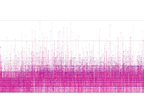
MaSS (Market as Speed Spectra) by MaSS Dev., Japan 2006 :: In e-trade, there are cases in which up to 1,000 "ticks" (contracts made when seller and buyer agree on a price are being counted per second?DThis work extracts log data of daytrade, where instantaneous decisions are being made based on numbers displayed on the computer monitor?Cand transforms the speed and rhythm of such transactions into sound and light. "MaSS" likens the steady high-speed exchange of data in e-banking to a worldwide network of reflex nerves.
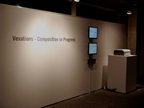
Vexations-c.i.p. (Composition in Progress) by MOHRI Yuko + MIHARA Soichiro, Japan 2005 :: "Vexations - c.i.p.(Composition in Progress)" 2006 transmediale 06, Berlin This work presents "Vexations", an odd piano piece of a single phrase repeated 840 times, originally composed by Erik Satie in the late 19th century, interpreted through an automatic, computer-controlled looping system. While incorporating modifications caused by data of environmental noises recorded with microphones at the venue, the software automatically generates new scores, based on which the piece gradually changes as the performance continues.
Artists include: ambientTV.NET (AT/IN/UK) / Wayne CLEMENTS (UK) / Robert DAVIS + Usman HAQUE (UK) / exonemo (JP) / Peter FISCHLI & David WEISS (CH) / Muntadas (UK/SP) / MaSS Dev. (JP) / MOHRI Yuko + MIHARA Soichirou (JP) / Newtype Technology Lab. (JP) / Dennis OPPENHEIM (UK) / Manuel SAIZ (UK/SP) / TANO Taiga (JP).
Posted by jo at 04:18 PM | Comments (0)
September 12, 2006
Vholoce: Weather Visualiser
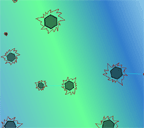
Seeking a Collaborator
Vholoce: Weather Visualiser :: A net artwork merging meteorological science, and digital artwork. Vholoce*: Weather Visualiser uses real-time weather data to create a series of visualizations intended to both artistically interpret weather conditions, and create new methods of understanding weather data. Working with talented programmer Rory Hering, Griffith University lecturer Jason Nelson created the weather visualiser as a prelude to future data visualization projects. Specifically, Jason and Rory are seeking interested parties to collaborate in developing a visualiser for Australian water data.
The weather visualiser lets the user choose cities from Australia, New Zealand, Canada and the United States. Those city’s current weather conditions (numbers representing temperature, humidity, pressure, wind, weather description) are then loaded into five different visualizations: Prose:Poetics, Animated, Molecular, Abstract:Noir, and Video.
*Vholoce is the Native American Creek tribe word for “cloudy”. [via Rhizome Raw]
Posted by jo at 02:59 PM | Comments (0)
September 08, 2006
DANCEPOD 2006

A Sculpture Composed of Simultaneous, Web-Connected Dance Parties
DANCEPOD 2006: On September 9th at 11pm in Portland, 12 am in Guadalajara, 2am in New York City, 3am in Mexico City and 7am in Berlin, dancepod will present an entirely new kind of sculpture. A sculpture composed of simultaneous, web-connected dance parties. The parties, coordinated and developed in conjunction with artists and presenters from each city, will utilize identical dancepod installations. The installations will become the core of a shared physical and virtual experience, supporting streaming video and music as well as live DJ’s, VJ’s, and surprising guest artists. Moving bodies of dancing participants will complete the sculpture.
As part of the Portland Institute of Contemporary Art's (PICA) Time-Based Art (TBA) Festival, in conjunction with PS122, Scene Downtown (Earl Dax), Harkness A/V (Nick Hallett), and technical directors Kraft + Purver, these 4 DANCEPOD sites will be linked by live video starting at 2:00 AM Eastern Standard Time.
NYC DANCEPOD features an eclectic array of New York artists. Join DJs Kevin Graves (Brite Bar) and Van Scott (Patricia Field's Party at element) and dance to visuals artists assembled by Nick Hallett and Harkness A/V, including Chika and Boris. Live performances by John Moran and Saori Tsukada, Sxip Shirey, and Glenn Marla.
Chez Bushwick will be hosting "The Changing of the Garde" starting at 8:00 PM on Saturday. Come early for DANCEPOD and enjoy performances by:
Wanjiru Kamuyu – Spiral
Jim Staley – Solo Trombone
Bruce Nauman - “Abstracting A Shoe (1966)” – Video Art
David Vaughan, Michael Cole, Jonah Bokaer – A John Cage Birthday Reading
Elke Rindfleisch - Untitled
Also... TECHNOPIA Interviews Carla Peterson, Newly-Appointed Artistic Director of DTW.
All this for $5. Come to both the Chez Bushwick and DANCEPOD events for just $10! That's like seeing the early show for FREE! (Regular DANCEPOD admission is $10).
Hosted By
3rd Ward Brooklyn
195 Morgan Ave.
Bushwick, Brooklyn, NY 11206
718.715.4961
www.3rdwardbrooklyn.org
Posted by jo at 05:46 PM | Comments (0)
TANGENT_BURN featuring PLATONIQ
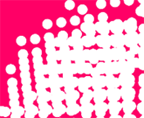
Bringing the Net Down to the Streets
TANGENT_BURN featuring PLATONIQ: This evening V2_Institute for the Unstable Media will be hosting a streamed performative presentation by Barcelona based activist art collective PLATONIQ. If you're not able to make it to V2_ in the flesh, and at the same time catch the opening of this year's 'Wereld van Witte de With' Festival, you're invited to join in on the stream beginning at 20.00 (CEST). The PLATONIQ presentation will be augmented by interventions from local Rotterdam sound and visual artists 'onehertexpressions', Zaplab Creative Television and Meticais.
To join the stream, please go to www.v2.nl, follow the link and have your Realmedia player ready! If you don't have the player, you may download one for free at www.real.com.
Afterwards PLATONIQ'S project BURNSTATION to bring net culture, net music and net radio down to the streets will be active throughout the weekend as part of the Wereld van Witte de Festival. Everyone is invited to partcipate in the BURNSTATION, and upload, listen to, edit and to burn their own sound compilations, the whole process being LEGAL AND FREE OF CHARGE.
more info on PLATONIQ and the BURNSTATION on http://www.platoniq.net
TANGENT_BURN Friday September 08
Rotterdam 20.00
Dublin 19.00
Riga 21.00
Montreal 14.00
Seattle 11.00
Kyoto 03.00 (Saturday)
V2_Institute for the Unstable Media
Stephen Kovats_Program Curator
Eendrachtsstraat 10
3012 XL Rotterdam
The Netherlands
t_ **31 10 750 1519
f_ **31 10 206 7271
e_ kovats@v2.nl
www.v2.nl
TANGENT_BURN featuring PLATONIQ
Friday September 08 @ 20.00 (CEST)
RealMedia stream live via www.v2.nl
www.platoniq.net
Posted by jo at 04:14 PM | Comments (0)
September 06, 2006
See You in Walhalla
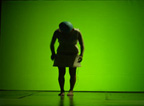
World Premiere of Live Computer Game
[Posted by Yukihiko YOSHIDA] World Premiere of new Live Computer Game "See You in Walhalla" :: September 14, 2006 :: IME Industrial Performing Arts Complex - Athens (Greece) and two other European cities (Sofia and Amsterdam) connected live through the Internet.
The Athens based performance group amorphy.org, with support of the Cultural Center of Kifissia and the EU Culture 2000 Funding Scheme, is proud to present the world premiere of "See you in Walhalla," a distributed live performance game connecting three cities – Amsterdam, Athens and Sofia. This multi-media dance/theatre project, collaboratively created by artists and designers from four different European partner sites in Greece, The Netherlands, Germany and Bulgaria, presents the unusual journey of a video game “avatar” through a haunted urban industrial landscape composed of digital fragments from the spectacle of Europe.
The audience in Athens is invited to witness the exciting premiere of the first live 3D computer game enacted by three dis/located performers simultaneously, with Ermira Goro playing the “avatar” on location in Athens, while Nancy Mauro-Flude and Ivaylo Dimitrov are streamed via web-cams into the game but are located in Amsterdam and Sofia respectively, and watched by local audiences in those cities. At the same time, “See you in Walhalla” can be witnessed live on the Internet, where online players can log on to offer their comments and reactions to the performance/game. The Athens premiere represents the first leg of a European tour scheduled for 2006-2007 seasons.
Description of the new work:
An average man. Slightly obsessive, familiarly lonely. He eats his green apples, rendered phosphorescent in the glow of his computer screen. A new video game, See You in Walhalla – “in this place everyone who is not in jail works for the police.” He creates his avatar. The game’s purpose - to guide this avatar, born as an “empty” shell, through various journeys taking place in an imaginary city-scape morphed out of Amsterdam, Athens and Sofia, with the final goal of rendering the avatar into a more “human being”, capable of surviving the density, danger and psychosis of urban existence, at a time when Europe is undergoing its own nightmares of economic and political integration. Paradoxically, integration in this haunted and visually disturbing game is experienced as a series of physical and psychic dis-sociations. The Player gets more involved with the game, losing a sense of reality and becoming more socially autistic, while his avatar slowly recovers a sensibility for human inter-action which is punished by the pressures and regulations, as well as the hyper-euphoric spectacular image-scapes, of which the urban rhythms of existence are determined.
I am Amalia, if you hurry me I will say I am Molly, I am her, locked up in the big house, desperate, pursued by Rosas’s mazorca, I am Irish, I will say then, I am her and I am also the others, I was the others, I am Hipolita, the gimp, the little cripple, I tottered slightly when I walked, Hipolita, I say to him, and he smiles, Hipolita, with “the gloves on her small hands”, she ran away with the psychopath, the big castrated psychopath who could tell the future on Tarot cards, he had a scar on his groin from here to here.
Three performers inter-connected, a complex web of fantastical events seen from pre-recorded film, live-web cam and audio streams from Amsterdam and Sofia, interactively controlled sound and video based determined by movements of the performer in Athens, and unpredictable site-specific performances in Sofia and Amsterdam – these components compose the 3D live game environment which promises Player and Avatar a life after death (Walhalla).
The protagonist of this game is not an ego-shooter, but a flâneur, a cyber wo-man who discovers herself as an anonymous face in the multitude, but who is free to probe her surroundings for clues and hints that may go unnoticed by the others. The Avatar-wanderer does not abandon herself/himself in the crowd, but actively participates, observes, revolts, and intervenes in her surroundings, and just as she experience her “unbearable lightness of being”, she is nearly killed in an accident.
This theatrical computer game explores the “system” of deadly possibilities that lurk in the entropic cities of late capitalism, amongst the facades of glamour, heroic icons and consumer fetishes which, like a dream, do not exist in reality or can fall apart in a moment, setting fire to the outskirts of our imagination or flooding our delusional consciousness.
* * *
Initial Concept by: Tzeni Argyriou, Ioanna Tsinividi, and Ash Bulayev
Tzeni Argyriou (Concept and Direction); Zoe Chatziantoniou, Ioanna Tsinividi, and Ash Bulayev (Creative Team); Tzeni Argyriou, Zoe Chatziantoniou, Ermira Goro, and Ash Bulayev (Choreography); Ioanna Tsinividi (Video Direction/Editing); Zoe Chatziantoniou and Ash Bulayev (Dramaturgy/Text Composition); Stavros Gasparatos (Music Composition); Arjen Keesmaat and Stoycho Stanchev (System Design/Programming); Paul Verity Smith (Sensor Development); Kostantinos Kipriotakis (Stage Design); Sakis Birbillis (Lighting Design); Despina Makarouni (Costume Design); Nikos Makris (3D Animation); Christopher Brellis (Designer); Lena Kitsopoulou and Ash Bulayev (Voiceovers)
Web interaction design and logistics by: Sher Doruff (Waag/Holland), Johannes Birringer (InteraktionsLabor/Germany), and Galia Dimitrova (InterSpace/Bulgaria)
Performed by: Ermira Goro (Athens), Nancy Mauro-Flude (Amsterdam), and Ivaylo Dimitrov (Sofia)
Production Crew:
Maria Kerasioti (Lead Project Facilitator/ C.C. of Kifissia), Maria Ladaki (Project Coordinator/C.C. of Kifissia), Eleni Katsarou (Project Coordinator & Production Manager/amorphy.org), Galia Dimitrova (Project Coordinator/InterSpace), Johannes Birringer (Project Coordinator/InteraktionsLabor), Floor Van Spaendonck (Project Coordinator/de Waag), Dyonisis Petrouchopoulos (Director of Photography), Katerina Stasinopoulou (Co-Video Editor), Christopher Brellis/antidot (Web-Design/Poster Design), Guy Stefanou (Technical Director)
Logistics:
Date: September 14th, 2006
Time: 21:00 (Athens/Sofia) & 20:00 (Amsterdam)
Locations:
Athens/Greece (IME Industrial Complex, Building 5)
Amsterdam/Netherlands
(Waag Society, Nieuwmarkt Square)
Sofia, Bulgaria
(Red House for Culture & Debate,
15 Ljuben Karavelov Street)
Info: www.amorphy.org/imap
* For press photographs or any other information regarding the show or project, please contact: info[at]amorphy.org
Development History
With funding support of the European Culture 2000 Framework Program, the project development of “See you in Walhalla” began in September 2005, and after extensive filming on location and digital choreography and computer programming workshops in the various partner sites , the new work will be shown as a live networked performance on September 14th, 2006 in Amsterdam, Athens, and Sofia. The collaborative project, implemented through a trans-European network of four participating media art organizations, is dedicated to fostering new and innovative works of art through effective integration of interactive technologies and live performance practices.
Collaborative Network of Co-Organizers
· amorphy.org (Athens, Greece) - www.amorphy.org
amorphy.org is a non-for-profit organization devoted to production of original works of live performance and installation, through constant pursuit of practical investigation fusing media art technologies and live performance practices.
· InteraktionsLabor (Göttelborn, Germany) – www.interaktionslabor.de
InteraktionsLabor, under the direction of Johannes Birringer, is an organization which focuses on research in communications technologies, interactive media, performance and virtual environments.
· InterSpace (Sofia, Bulgaria) – www.i-space.org
InterSpace is a New Media Art Center that works for the establishment of a social attitude to new media art forms, through the development of alternative means and possibilities of artistic expression in new media technologies.
· De Waag (Amsterdam, Holland) – www.waag.org
Waag Society for Old and New Media is a knowledge institute operating on the cutting edge of culture and technology in relation to society, education, government and industry, established in 1994.
· Cultural Center of Kifissia (Athens, Greece) - www.kifissia.gr
C.C. of Kifissia various courses for painting, Greek traditional dancing, theatre, jewelry , photography, batik, mosaic and so on. The municipal cultural centre highly supports and promotes cultural creativity.
Associated Partners
PACT Zollverein - Essen, Goethe Institute, Red House For Culture and Debate, IKS, IME Research Facility, Ipsilon Production Company, Brunel University, i-DAT/University of Plymouth.
ash bulayev/amorphy.org
artistic director
Address:
Alopis 58, Kato Petralona
11853 Athens Greece
email: ash[at]amorphy.org
web: www.amorphy.org
mobile: + 30 6937 20 33 00
work: + 30 210 34 56 341
Posted by jo at 08:18 AM | Comments (0)
IMPLANT
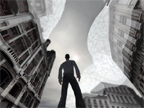
Transmittable Architecture
International premiere of IMPLANT :: A networked virtual world and installation created by Thomas Soetens and Kora Van den Bulcke, Workspace Unlimited :: IMPLANT will take place at the Vooruit Kunstencentrum in Ghent, Belgium, inside the Domzaal and outside on the gallery street window. Simultaneously IMPLANT will be networked with the project EXTENSION a virtual world installation at the Society for Art & Technology in Montreal and DEVMAP a virtual world installation at V2_Institute for the Unstable Media in Rotterdam. The opening event will be live streamed from the Vooruit and can be followed at the SAT and V2_Institute in the networked virtual world installations!
About the work: Text by Wayne Ashley, Independant Curator, New York :: Workspace Unlimited's new work IMPLANT is both an electronically networked interactive virtual world and an installation physically situated in the magnificent Art Nouveau building of Vooruit, a performance venue in the center of Ghent. Founding members artist Thomas Soetens and architect Kora Van den Bulcke create a digital 3D version of the entire building and its surrounding environs which users can access and navigate on computers from inside Vooruit and simultaneously from the Society for Art and Technology in Montreal, and V2_ Institute for the Unstable Media in Rotterdam. In this way Soetens and Van den Bulcke exercise their most compelling gesture: re-imagining Vooruit as transmittable architecture, an ongoing and revisable place that does not adhere to our ordinary understanding of physics, nor to the continuities of space and time.
Once logged into IMPLANT, visitors navigate through two co-existing architectures: a sumptuous simulation of the real Vooruit, a large complex maze of theater spaces, cafes, meeting rooms, and offices which can be traversed in much the same way we move through physical space--walking upstairs, through doors, down corridors, around corners, inside and out. And a hidden hyperlinked architecture that emerges as users interact with the simulation's various walls and ceilings. This secondary architecture is a malleable, almost liquid space that is contingent and constantly in flux-portals that transport us immediately to continuously shifting destinations within Vooruit according to the position of the visitor; virtual cameras that allow us to secretly follow other visitors and project their journeys and activities onto walls in front of us; the ability to walk through the projection and find ourselves together with them in the same space.
Outside on the real street, passersby will peer into Vooruit's glass lobby only to see a projected simulation of the same lobby seamlessly integrated within Vooruit's facade. Instead of seeing the usual theatergoers purchasing tickets and socializing with friends, viewers will observe the goings-on of avatars, graphical representations of actual people in Vooruit co-mingling and exploring the same simulated space with their counterparts from Montreal and Rotterdam. A web cam outside Vooruit captures the scene on the street, projecting the performances of everyday life back into the virtual world for those inside Vooruit, V2_ and SAT to witness. The effect is dizzying as the borders between inside and outside the virtual world become unclear, and who is performing for whom confused.
The longer visitors explore IMPLANT, the more layers they encounter. Embedded throughout the virtual world and triggered at various moments users encounter video and sound documentation from a recent online symposium called Breaking the Game. The symposium brought together an international group of competing theorists and practitioners to build, debate and reflect on virtual worlds, computer gaming, immersive technologies, and new possibilities for artistic practice and experience.
Workspace Unlimited is interested in breaking down oppositions between practice and theory, interior and exterior, imagination and perception, seeing and being. Soetens and Van den Bulcke seek to explore creative ways of making virtual worlds that are simultaneously intellectual, poetic, and hallucinatory.
Events:
V2_Institute, Eendrachtsstraat 12, Rotterdam, the Netherlands :: Sept. 15 at 17:00 V2_ Ground floor: Lecture by Thomas Soetens and Kora Van den Bulcke streamed in the virtual world installation.
Society for Art & Technology, 1195 Saint-Laurent, Montreal, Canada ::
Sept. 15 at 11:00 am (local time Montreal) Ground floor: Lecture by Thomas Soetens and Kora Van den Bulcke streamed the virtual world installation. :: Sept. 15 - 16 - 17 Ground floor: Exhibition of the interactive virtual world installation.
Workspace Unlimited website: www.workspace-unlimited.org
IMPLANT credits: Artistic direction and creation: Thomas Soetens and Kora Van den Bulcke; OpenGL programming: Patrick Bergeron; Quake 3 programming: Matt McChesney; Modeling and character design: Jason Dovey; Network setup: Simon Piette, Brecht Vermeulen (IBBT), Thomas Bouve; Modeling and character design: Jason Dovey; Communications: Stoffel Debuysere; Copywriting: Wayne Ashley, independant Curator.
Posted by jo at 08:05 AM | Comments (0)
August 30, 2006
NETWORKED_PERFORMANCE
![]()
Joburg-Derby-London & You
The Premises Gallery at The Johannesburg Civic Theatre invites you to join us for a Red Bull and some live online performance: NETWORKED_PERFORMANCE VisitorsStudio performance Joburg-Derby-London live at The Premises and online at http://www.visitorsstudio.org.
A live-online collaborative performance by Nathaniel Stern, Marc Garrett and Ruth Catlow. And open laptop mixing by audiences and invited local artists at the Premises Gallery (Johannesburg), HTTP (London) and Q Arts (Derby).
EVENT: Saturday 2nd September, 16:30 – 19:00 (SA time)
Getting started and uploading at The Premises: 16h00 (SA time)
Live scheduled performance: 17h00- 17h30 (SA time) and 16h00 - 16h30 (UK time) by Nathaniel Stern, Marc Garrett and Ruth Catlow
Open collaborative mix: 17h30 (SA time) and 16h30 (UK time) Everyone welcome to join!
![]()
About VisitorsStudio: an online place for real-time, multi-user mixing, collaborative creation, many to many dialogue and networked performance and play. VisitorsStudio is a Furtherfield project @ http://www.visitorsstudio.org. VisitorsStudio is included in the Game/Play networked touring exhibition. A collaboration between Q-Arts, Derby and HTTP, London. Please see www.game-play.org.uk for further information.
How to PARTICIPATE
First, get the latest flash player on your computer. South Africans wishing to participate can bring their laptops (with ethernet cables) or content to The Premises a bit early, and upload content on our open network via their own machine or one of ours. Or, upload anywhere, anytime - you can even mix with us from Cape Town. If you want to be part of the VS performance by nathaniel, be sure to name your files beginning with SA_, and then an idea of what it is he would be including in the mix. If you want to play on your own, supply names for your files that you will remember. File types supported are jpg, png, mp3, flv and swf files, as long as they are under 200k.
More info, and to play: http://www.visitorsstudio.org
SPONSORED BY:
http://furtherfield.org
Art & Technology, Johannesburg, Co-directed by nathaniel stern and Prof Christo Doherty
Red Bull South Africa
the trinity session
The Premises at the Johannesburg Civic Theatre
The Premises at the Johannesburg Civic Theatre
Loveday Street, Braamfontein, Johannesburg, South Africa
+27 (0) 11 877 6859
thepremises[at]onair.co.za
Gallery Hours -
Tuesday - Saturday
10h00 - 17h00
office[at]onair.co.za
Directors -
Stephen Hobbs
+27 (0) 11 403 8358
sh[at]onair.co.za
Marcus Neustetter
+27 (0) 11 339 2785
mn[at]onair.co.za
Posted by jo at 01:25 PM | Comments (0)
August 28, 2006
SHIRLEY BASSEY GETS MIXED UP
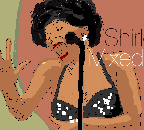
A Collaborative Biography
Shirley Bassey Mixed Up is a collaborative biography: an illustrated biography of the legendary diva, where the reader helps to 'mix' the illustrations online, using Internet searches. The biography was inspired by an incident on a TV awards show last year, where Bassey was publically humiliated. I felt sad to see this happen, and wanted to know more about what led up to this. All illustrations are built on-the-fly from live Yahoo searches. By specifying different searches and playing with the customisation options, the reader creates the illustrations themselves. This is a traditional (linear) 14-page story built on top of a generative composition tool, that uses Internet search data as its input.
The work can be described as a networked narrative, as a story partly created by networked data. Adding unexpected and uncontrolled elements to the story influences and changes the presentation, how it's experienced and what we take away from it. This shapes the story, changing fact into fiction, sometimes disrupting the story. As the networked elements are dynamic and largely unpredictable, every version of the biography is unique. Your version of the story is packaged into booklet form, for you to print and keep.
About Dave Miller: Dave Miller experiments with illustrated stories and networked media. More of his work can be seen here. [Related]
Posted by jo at 09:16 AM | Comments (0)
August 17, 2006
LOCUS SONUS
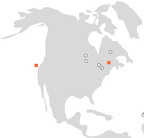
DUPLEX PERFORMANCE
THE THING invites your face and body and voice to 11 Harrison Street, ground floor storefront gallery, RIVERFAWN, for the Manhattan interface of THE THING.residency: LOCUS SONUS DUPLEX PERFORMANCE. This is a special performance that will be live from the Roebling Bridge on the Delaware River and from the RIVERFAWN Gallery in New York City. You will be part of the performance! :: 6pm –10pm Thursday August 24th :: 11 Harrison Street, ground floor* :: New York City.
Locus Sonus has constructed for this performance 2 IP webcams/parabolic microphones with which they can hunt for sounds in and around the venue streaming them simultaneously to the remote location. In each location laptop performers capture and remix the audio from the mic and video projectors show what the mobile microphones are capturing. Both mixes are played in both locations, the musicians responding to their remote counterparts. The Roebling Bridge will be set up on both sides of the river (the audience will be on the bridge). The idea being that we can use the local distance to reflect the remote distance. On the Manhattan side, the performance will take place in the RIVERFAWN Gallery where they will also use the wire/stream interface as an instrument to mix and control during the presentation. Live sounds from around the world (from the locusonus open web mics project) will also be used as raw material for the concerts.
Locus Sonus will be in residence between the 15th and the 29th of August in the USA with two installations and a duplex performance between them. The two locations will be at the DIGIT Festival, Delaware Valley Arts Alliance & Roebling Bridge Environmental Arts and at the RIVERFAWN Gallery in New York City.
DATES: The Installation at the Delaware Valley Arts Alliance opens on Saturday, August 19th and runs until August 25th. The performance Duplex Roebling Bridge/Manhattan will take place Thursday, August 24th at RIVERFAWN Gallery, 11 Harrison Street in New York City. There will also be a physical installation/interface on view from August 22nd to the 27th, 12-6pm at RIVERFAWN Gallery.
For more information: http://nujus.net/~locusonus/site/index_e.html
Audio streams: http://nujus.net/~locusonus/site/documentation/allstreams/index_e.html
ABOUT LOCUS SONUS
Locus Sonus is a research group specialized in audio art (École Supérieure d'Art d'Aix-en-Provence, École Nationale Supérieure d'Art de Nice Villa Arson). Our objective is to experiment and evaluate the innovative and transdisciplinary nature of audio art forms in a lab-type context. We are are also concerned with the communal, collective or multi-user aspects inherent to many emerging audio practices and which necessitate working as a group. Two main thematics define this research - audio in it's relation to space and networked audio systems. The "Lab" proposes a process combining practical artistic experimentation and critical evaluation in a group context. The Locus Sonus Lab is currently focusing on a process which revolves around the use of multiple audio streams. The streams which are basically open-mic continually upload chosen soundscapes or sound environments, as playable material. The way in which we work with other people to set up and maintain the streams is part of the methodology, indeed the technology provides the basis to construct a human network.
*Directions: by subway take 1 train to Franklin Street. Walk one block west on Franklin to Hudson and cross the street. Walk 1 block south to Harrison and turn right. 11 Harrison street is in the middle of the block on the south side of the street, By car: From uptown Take West Street to Vestry. Make a left on Vestry. Go two blocks make a right on Greenwich Street. Go two traffic lights , make a left on Harrison street. From downtown take West Street to Harrison street. Make a right on Harrison and go 1 block.
Posted by jo at 09:25 AM | Comments (0)
August 11, 2006
Global Web Jam
![]()
Call for Solidarity
Saturday, August 12, 2006, 15:00 - 19:00 PM CEST [--> 16:00 - 20:00 EEST] ::
http://beirut.streamtime.org :: http://streamtime.org :: Live audio/video streaming transmission from Waag Society in Amsterdam, in direct connection with Beirut and surrounding localities. The event was initiated by Streamtime, a web support campaign for Iraqi bloggers.
After one month of violence and carnage, this Global Web Jam brings together live interviews and conversations, video clips, cartoons and blog blurbs, soundscapes, DJs and VJs, a lively mix of information, art, protest, party and reflection. We feature the voices, images stories, reports and initiatives from Lebanon and beyond, with participation of activists, artists, bloggers, journalists, musicians and many others.
This is a call for an immediate end to the violence and destruction, in defiance of war, and in search for solidarity.
With contributions and participation of: Wahid el-Solh, Mounira el-Solh, Sonya Knox, Naeem Mohaiemen, Kanj Hamadi, Jim Quilty, Randa Mirza, Mazen Kerbaj, Raed Yassin, Charbel Haber, Nathalie Fallaha, Henri Gemayel, Fadi Tufayli, Tariq Shadid, Peter Speetjens, Chalaan Charif, Martin Siepermann, Arjan El Fassed, Ruud Huurman, Kadir van Lohuizen, Thomas Burkhalter and Anna Trechsel, Beirut DC, Tarek Atoui and many others.
This Global Web Jam is an initiative of Jo van der Spek, Geert Lovink and Cecile Landman (from Streamtime), Nat Muller, Paul Keller and Denis Jaromil Rojo in Amsterdam; and Tarek Atoui and Rawya el-Chab in Beirut.
info: http://beirut.streamtime.org | mail: beirut[at]dischosting.nl
This project is supported by Waag Society, Novib (Dutch Oxfam) and X-Y
Solidarity Fund.
Posted by jo at 08:57 AM | Comments (0)
July 31, 2006
Locus Sonus Audio Streaming Project
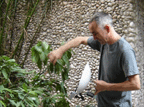
OPEN CALL
August 2006 :: This is a call from the French based Audio in art research group Locus Sonus to participate in their streamed soundscapes open web-mike project. Open an ogg audio stream from your home or garden (no pre-recorded playlists please) and become a remote member of the Locus Sonus orchestra.
Locus Sonus is a research group specialized in audio art (École Supérieure d'Art d'Aix-en-Provence, École Nationale Supérieure d'Art de Nice Villa Arson). Its objective is to experiment and evaluate the innovative and transdisciplinary nature of audio art forms in a lab-type context. It is also concerned with in the communal, collective or multi-user aspects inherent in many emerging audio practices and which necessitate working as a group. Two main thematics define this research - audio in it's relation to space and networked audio systems.
To participate in this project, contact support[at]locusonus.org :: to listen to the streams already available click here :: to download a PD patch and start streaming click here :: to see video documentation of our previous presentations and to find out more about Locus Sonus in general, click here.
NEXT PUBLIC EVENTS
Presentations start from 15th to 30th of August in various performance and installation situations, starting with DIGIT Delaware Delaware Valley Arts Alliance & Roebling Bridge Environmental Arts and LMCC (Lower Manhattan Cultural Council) in partnership with THE THING Inc. (New York) with the support of Étant Donnés, The French-American Fund for Contemporary Art.
Presentations continue in the fall with an installation during the Arborescence festival in Aix-en-Provence, France, and an installation performance at GMEM, Marseille France.
Festival DIGIT: http://www.artsalliancesite.org/programs/digit_06.html
LMCC: http://www.lmcc.net/
THE THING: http://bbs.thing.net/
Arborescence: http://www.arborescence.org/rubrique.php3?id_rubrique=3
GMEM: http://www.gmem.org/
TECHNICAL DOC
To Start Streaming You will Need :
* a PC or Mac dedicated to the stream (an old 450 MHz machine should do).
* a sound card recognized by your operating system.
* a microphone ($3 radioshack mike is fine).
* streaming software (we propose that you download our PD patch and run it using PureData that way you can customize your stream (for OSX, Windows and Linux). We recommend that you use this Hans Christoph Steiner's extended version which includes the necessary ogg vorbis libraries.
* a high speed internet connection and a network router.
We obtained the good results using the Dyne:bolic Linux distribution. The advantage being thats it's a liveCD (so you don't have to install the system) and that PD and all the necessary externals are already installed. You might run into difficulties if the system doesn't recognize the PCs built in sound card in which case the easiest option is to find an old soundblaster card and disactivate the built-in card in the bios.
It's important for us to get a wide range of soundscapes and social situations, remember that urban sound is pretty similar around the western world so you might want to chose to place your microphone so as to capture interesting or unique aspects of your environment and also to listen to the other current streams to caracterize yours.
We are also finding that in most circumstances it is preferable to customize the patch, sometimes a little filtering is all thats needed (as for example: port.ogg) but we've also built a sampling patch which records and plays back recent sound events continually updating its database (as for example: cap15.ogg).
Listen to the current streams.
Posted by jo at 10:56 AM | Comments (0)
July 21, 2006
BUMP…
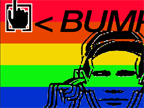
Reinstates the Virtual World with an Offline Voice
Artist Jaygo Bloom has been commissioned by folly, a media arts organisation based in Lancaster, to develop the sound work BUMP… for this year’s Futuresonic festival, in partnership with Manchester based digital signage organisation Pixel Inspiration. Futuresonic is the UK’s leading electronic and media arts festival, and takes place in Manchester in July 2006. According to Jaygo Bloom, the commissioned artist, "As computer technology becomes more sophisticated, the technology itself will fade into the background of human activities, becoming far less intrusive than is the case today."
Jaygo Bloom suspects the invisible, therefore he seeks to reverse the need for this technological transparency. BUMP… reinstates the virtual world with an offline voice. BUMP… is an online project that translates an online keystroke into an actual real time and physical event. BUMP… will reinstate the presence of this technological intervention over its environment via the quick shot, rapidfire, 8bit sounds emanating out of its location based folly sound modules located throughout participating venues of Futuresonic 2006. BUMP… presents an interesting view of networked interaction and social performance.
Jaygo Bloom concludes, "By attaching a physical connection to things we perceive as virtual, we can begin to make the intangible tangible."
Jaygo Bloom is a UK based multimedia artist whose practice includes audio visual installation, game hacking, film making and physical computing. Over the past year he has been developing a wide variety of new online and offline projects ranging from his globally aware interactive games console ‘Tao Joystick’ to his 8bit latino percussion interface ‘Marrackattack’. Working independently and also as part of the Glasgow based audio visual team 'Pointless Creations'. Popular for his public interventions, blue screens and old sports car, other successful projects have included Glasgow International05, Pixelache05, Recontres Paris/Berlin, and Pong.Mythos.
Posted by jo at 04:27 PM | Comments (0)
July 19, 2006
Intimacy and In.yer.face
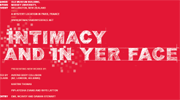
Blurring Online and Physical Performative Space
Intimacy and In.yer.face (July 20th, 8 p.m. (NZ time)) is a live performance / installation event and remix project, featuring an interdisciplinary selection of local and international artists, operating in the nexus between art and technology. Our conception of site is fragmented when agents participate from spatially dispersed locations, and when the boundaries between online and physical performative space are blurred. Intimacy and In.yer.face explores this fragmentation, the endless and cyclical encoding and decoding of information that occurs in the interface between humans and machines.
Curated by Daniel Agnihotri-Clark, Intimacy and In.yer.face commences with a one-night event featuring simultaneous live performances and interactive installations, linked by real-time streaming of audio and video signals which will be broadcast over the internet. The event will feature new works by the globally dispersed cyberformance troupe Avatar Body Collision (New Zealand, London, Helsinki), the interdisciplinary artist Kartini Thomas (Wellington), aerialists / actors Pipi-Ayesha Evans and Rhys Latton (Wellington), and audio / video artists Emil McAvoy and Damian Stewart (Wellington).
The performance/installation event will take place on July 20th in the former Dominion Museum Building, Wellington (8 p.m. NZ time), at a mystery location in Paris (10 a.m. FR time), and everywhere else via http://www.intimacyandinyerface.net. Intimacy and In.yer.face is truly a simultaneously local and global event, pushing the understandings of site and indeterminate modes of performance practice in the interface with technology. Intimacy and In.Yer.Face follows last year's Indeterminacy and Interface - the first of performance event curated by Daniel. These projects form a significant component of his on-going doctoral research at the Massey University School of Fine Arts.
Following the performance / installation event, an open call for remix will expand the role of the audience, facilitating active participation and dialogue. Audio and video files will be available for download from the website. This remixed material will then be collated into a limited edition DVD release.
For full information about the project and the artists involved please see
http://www.intimacyandinyerface.net
Intimacy and In.yer.face
July 20th, 8 p.m. (NZ time)
Old Museum Building, Buckle St, Wellington, New Zealand
and Mystery Location, Paris
and http://www.intimacyandinyerface.net
Online Soiree
http://www.intimacyandinyerface.net
10 a.m. - 12 noon NZ time/ 10 p.m. - 12 a.m. FR time
Artist/Curator talk
School of Fine Arts seminar room, Block 2, Level C, via Gate C, Wallace St.
12.15 p.m.
For further information, images or to arrange an interview with the participants please contact: Louise Menzies, on tel: 04 801 2794 x6197, email: L.C.Menzies[at]massey.ac.nz. or Aaron Kreilser on tel: 04 8012794 x6341, email: A.P.Kreisler[at]massey.ac.nz.
Posted by jo at 02:33 PM | Comments (0)
July 12, 2006
Guerrilla Net Ballet Performance: Ballettikka Internettikka:
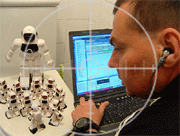
VolksNetBallet
Guerrilla Net Ballet Performance: Ballettikka Internettikka: VolksNetBallet by Igor Stromajer & Brane Zorman :: People's Internet Ballet furtively performed at -- and secretly broadcasted (as six one-minute live streaming videos) from -- the Basement Toilet in Volksbühne at Rosa-Luxemburg Square in Berlin, Germany; # Latitude: 52.31.36.84 N, Longitude: 13.24.43.02 E, Terrain Elevation: 41 m on Sunday, July 9th 2006 at 9 PM GMT+1 (Berlin/Paris local time). "Stromajer and Zorman manipulated a semi-automatic flying cow and eleven robots dancing an internet ballet, MC Brane conducted an MP3 orchestra!"
VolksNetBallet was broadcast in the form of six one-minute streaming videos, almost live, with only two minutes delay. It means that the visitors could see and hear in six steps what had just happened only two minutes earlier during the VolksNetBallet in Volksbühne Basement Toilet. All six videos were edited live in-camera, using only STOP and REC functions, then immediately converted to Real Media files using Real Producer, and finally, transferred to the server for viewing.
Ballettikka Internettikka is an ongoing artistic study of the internet guerrilla performance. After invading The Bolsh.oi Theatre in Moscow (March 2002), La S.cala in Milan (November 2004) and The National Theatre in Belgrade (October 2005), Stromajer and Zorman performed a new guerrilla net ballet, this time in the men's toilet in the basement of Volksbühne Berlin. The artists utilized low-tech mobile and wireless equipment for the invasion and live broadcast: a public unprotected wireless internet connection point (wLAN), available for free at the Rosa-Luxemburg Square in Berlin (ID: Helmut22; signal strength in the basement of Volksbühne: 2/5), free RealProducer (version 11.0) and Live LE software for streaming video and audio live manipulation. Ballettikka Internettikka: VolksNetBallet took place on the very same evening and at the very same time as another huge people's festivity -- the final match of the World Soccer Cup 2006, which also took place in Germany.
Dancing a wireless people's internet ballet in Volksbühne Berlin represented a big conceptual and strategic challenge to the Intima Virtual Base and all the collaborators, therefore, the preparations were taken seriously, safety measures were calculated, and the previous experiences from the Bolsh.oi Theatre in Moscow, La S.cala in Milan and The National Theatre in Belgrade were very welcome.
Note: Volksbühne Berlin did not voluntarily co-operate in the project, but was selected based on the conceptual strategy of the project. The management of the Volksbühne Berlin was not a co-producer of this project and did not co-operate in the process of its realization.
Posted by jo at 06:13 PM | Comments (0)
July 03, 2006
Music 4100 Computers

Call for 100 Online Performers
Sean Kerr's first performance of M4100 is going to happen on July 9th, 12:00, NZ time at the Govett Brewster Gallery, New Plymouth, New Zealand. M4100 requires 100 online performers to create the event. Using a Flash multi-user server, all 100 online performers work together to creat an sonic and visual event that is live mixed by Sean Kerr, at the Govett Brewster Gallery auditorium.
If you are interested in participating in this event, please email your details to Sean Kerr [s.kerr at auckland.ac.nz] M4100 is coinciding with the exhibition 'what color does sound make?' and the sound performance event sound/bodies @ the Govett Brewster Gallery. M4100 is a 2005-2006 Rhizome.org commission.
Posted by jo at 05:21 PM | Comments (0)
Digital Art Weeks 2006
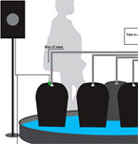
Symposium + Installations
Digital Art Weeks :: Symposium :: Artworks including:
The Waterbell Project--by Etsuko Maesaki--is a sound installation based on the Japanese 'Suikinkutsu'. Suikinkutsu ("Water Harp") is a unique feature of Japanese gardens. It consists of a large earthen jar with a hole in the bottom. This jar is buried upside down into the ground next to a water basin. When the waterdrops seep from above into the jar, they make a sound somewhat similar to what you would hear in an underground cave. The Waterbell Project consists of five vessels standing in a basin. A tube directs drops of water to the top of each of these vessels. When they drip into the water inside the vessels a sound can be heard. The frequency of the drops and the amount of water in the basin is controlled by a computer. At the same time this computer gathers realtime data from the internet: The price of oil in Japan and the temperature of the ocean. The frequency of the waterdrops dripping into the vessels corresponds with the temperature of the ocean, the water in the basin raises and drops with the price of oil, hence changing the quality of the sound made by the drops.
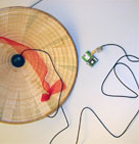
CHINA GATES by Art Clay, Dennis Majoe, & The China Gates Workshop-Ensemble: The early experiments of Charles Ives's father with marching bands crossing at intersections and his son's adoption of it, proves that interest in exploring mobility has fascinated even before electronic devices. As with Ive's marching band polytonality, we also have the opportunity using modern technologies from the Walkman to the Wearable not only interact with local surroundings like Ives, but for the first time also on a world wide level. Global networking systems such as GPS amoungst others have created a ubiquitous environments in which we can now make art in. China Gates is a work for GPS Wrist conductors and tuned gongs for an ensemble. The work addresses the concept of audience in public space through the possibilities of the GPS Wrist Conductor and an acoustic concept of music making in public space. Anyone interested in joining the workshop is welcome. It is open free of charge to those interested. The performance will be held regardless of whether conditions at Platzspitz and will be performed by a group of artists and musicians who took part in the DAW06 Mobile Music Workshop.
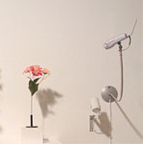
Motion Still Life 1--by Will Pappenheimer--extends the artistic tradition of the picturesque and spatial object arrangement into the domain of the Internet. A live Web camera frames a physical still life scene with vase, flowers and still life objects. Through its counterpart website, aesthetic controls allow internet viewers from anywhere to adjust the composition telematically in the distant space of the gallery. The Internet user is the surrogate artist. The time and space of the scene is ever-changing and accessible for the moment that becomes the still life. Exhibition visitors are able to see virtual participants configuring the still life through object movement, blinking LEDs connected with online activity, and multi-colored lighting for night time or alternative illumination. The mechanism is constructed from a self-contained network pan and tilt surveillance camera which has been disassembled and reconfigured for a more friendly gesture.
Posted by jo at 04:53 PM | Comments (0)
June 30, 2006
Suite Soil Digital Media

Two New Commissioned Audio Works
Concert, June 30, 2006, 8:00 p.m.: A live stream of the June 30th concert is available at this link under SPIKED.
Guy van Belle (Bratislava): "slashtops": The concert program "slashtops" consists of real time manipulations with sound transforming light to sound and sound to light in three parts to investigate the relationship between sound and image, audio art and the visual, a persistent tension in the arts for generations. The first part of the program is a trilogy of arrangements between synthetic and real sounds the source material and inspiration based on recordings made in Quebec based on the movement of the artbots that comprise 'thoughts go by air'. A second source of audio content comes from Munich based on sounds from the city environment and a third from Bratislava, around Zlaty Piesky (an industrial - recreational - commercial area). The second component of the program is based on a translation of light into sound using the computer as an instrument. The third part of the program is a concert version of the installation TICS, which is a translation of light into sound and back to light, with a score based on the novel 'istanbul' by the Turkish writer Orhan Pamuk (2006).
Biography: Guy Van Belle (working and living on the road and in Bratislava) has been prominently involved in the use and development of media for artistic purposes since 1990. Since 2000 xgz has been working under the name of the collective digital band mxHz.org (machine cent'red humanz), creating collaborative performances, concerts, workshops, exhibitions and unexpected experimental/abstract art projects. MxHz.org is co-organizer of the umbrella organisation okno, a non-profit technological art organisation situated in Brussels.
MxHz.org are currently developing 2 sets of autonomously communicating heliumbots. The title of the project is "thoughts go by air". Performances were set up in Brussels, Den Hague, and New York. The current new generation is being developed in Brussels (http://okno.be) and Berlin. A special focus for mxHz.org is on Balkan/Central/Eastern Europa to work towards a new sustainable kind of collaborative projects. A recent ongoing work - 2WR or two-way-radios - is a net-remake of John Cage's Imaginary Landscapes #4 (for 12 radios and 24 performers) based on some historical texts by innovative radio artists. The project started in Prague during the FM@dia conference 2004 and was recently set up as a networked installation at Skolska Prague. With Akihiro Kubota he started the Society of Algorithm in 2001, working on netbased music performances. They participate in festivals and connected concerts. Since 2005 open workshops were added and a residency exchange between Europe and Japan to expand the concept. Recently, they contributed to the Berlin Sonambiente Exhibition.
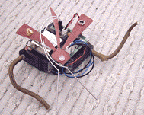
June 30 - July 29, 2006 - Installation: Peter Courtemanche's (Vancouver): "Preying Insect Robots", Opening reception Friday, June 30. Work created for the commission series, "Living with artificial beings" for Soil Digital Media Suite. Preying Insect Robots c. 2006 by Absolute Value of Noise.
Preying Insect Robots is a set of autonomous creatures that move about and communicate using a wireless Internet connection. These robots are modeled after an imaginary jade-green preying mantis - a mechanical creature that is described in the "Martian Chronicles" (by Ray Bradbury). The robots are adaptable to both indoor and outdoor environments - galleries, sidewalks, parks, and performance spaces. They engage in solo and choreographed group activities. The sound of their motors, motion and engagement creates an eerie soundtrack. The piece has a number of manifestations including an installation, a public intervention (performance), a web-presence, and an audio CD based on the sounds of the robots. As the robots wander, they transmit poetry to the Internet - creating montages of found text from a number of science fiction stories, including Feersum Endjinn (1994) and Excession (1996) by Iain M. Banks; The Martian Chronicles (1946 - 1958) by Ray Bradbury; Autofac (1955), Do Androids Dream of Electric Sheep (1968), and The Electric Ant by Philip K. Dick; Mortal Engines (1972 - 1976) by Stanislaw Lem; and For a Breath I Tarry (1966) by Roger Zelazny.
To hear the poetry created by the preying insect bots, go to this link;
http://www.soilmedia.org/preying/
Biography: Peter Courtemanche is a contemporary sound and installation artist from Vancouver. He is the Director and Curator of the Western Front's Media Arts Program - which supports the production and dissemination of experimental audio and electronic art. He has worked extensively in radio-art and electronic/interactive interventions. His art works often have a literary basis - inspired by narrative texts and the history of specific installation sites. As a curator, collaborator and producer he has worked with many established and emerging artists in the production and installation of video, audio, and computer/electronic based art.
Events take place at Neutral Ground
1856 Scarth Street, Regina, Saskatchewan
Curated by Brenda Cleniuk
For funding support, we thank the Canada Council for the Arts, the Saskatchewan Arts Board, Sask Lotteries Trust, the City of Regina and the Department of Canadian Heritage
Posted by jo at 04:42 PM | Comments (0)
June 23, 2006
Smoke Signals

Writing Space and Memory Clouds
June 24, 2006 at 9:28 p.m. (GMT): Smoke Signals--by Minimaforms--is based on one of the oldest forms of communication in recorded history dating back over 5,000 years. The project works as a hybrid system that explores the dynamic and spatial capacities of smoke and light in relation to contemporary mobile SMS technologies of messaging today. Smoke Signals examines a dynamic real-time interaction that writes space. Smoke and light setup the condition for developing a typographic ambient / responsive environment.
Participants are invited to communicate with the project by sending SMS messages to one of two smoke signals located at the event. Remote participants can send messages through our Real-Time Virtual Interface located at memorycloud.com
Minimaforms was founded in 2002 by brothers Stephen and Theodore Spyropoulos as an experimental design practice that explores design that provokes and facilitates new means of communication. Also see www.fasterthansound.com.
Posted by jo at 03:17 PM | Comments (0)
June 21, 2006
1001 nights cast
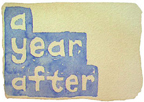
Northern Solstice Marks One Year Duration
1001 nights cast is one year old today, the northern summer solstice. To mark the occasion Barbara Campbell, the artist, invited Anne Brennan to co-write the story, as she and Campbell did the very first story.
Each morning Barbara reads newspaper reports covering events in the Middle East. She selects a prompt word or phrase that leaps from the page with generative potential. She renders the prompt in watercolour and posts it to the site.
Last year's prompt "the challenge of healing"; the prompt source was The Associated Press, 'Opposition wins vote in Lebanon', International Herald Tribune online, 21/06/05. Today's prompt was "a year after"; the prompt source: Ewen MacAskill and Simon Tisdall, 'A year on, Ahmadinejad's popularity is soaring', Guardian Unlimited, 21/06/06.
At the beginning of each webcast Barbara reveals the performance number stamped onto an individually-crafted tongue stud.
Posted by jo at 03:31 PM | Comments (0)
June 14, 2006
SpacePlace

Art in the Age of Orbitization - Gotchi Universe
SpacePlace is in Net vernacular, a 'Mashup,' a collection of data configured by Philip Pocock that is based on Web2.0 applications and strategies and that contains information from different spheres of artistic production relating to notions of orbit. The database of the project comprises contents from fields such as fine art, architecture, science fiction, film, music, digital arts or media. Currently, more than 400 entries on Orbit Art, ranging from, for example, projects by artists such as Marina Abramovic, Nam June Paik, Woody Vasulka or Arthur Woods, can be accessed in this constantly growing data pool, open to all SpacePlace member entries.
Both via the project's website and via mobile phones, users can navigate the database or upload texts and images to this universe and thus collectively create its contents and structure.
The ZKMax functions as display and space of interaction as the current status of the SpacePlace project is made visible and audible on two large projections screens: One screen serves as a forum for interaction offering the possibility to explore the data pool as well as to add new information via many mobile phones with free public access Bluetooth protocol. The second projection syncs with selections made by the public on the first projection, and plays them as an «Audio Wobble Movie:» images and video 'wobbling' fluidly to the sound of incoming RSS newsfeeds from webblogs and Net sources concerning science and art in outer space.
The soundtrack, the result of text-to-speech synthesis of online information, is narrated by an artificial computer-generated voice, over an added track of the 'sounds of space,' a radio feed that 'listens' to what scientists are studying with radio telescopes in real time. This audio controls the generation and spacial distortion of still photo and video sequences retrieved from the data pool by guests in ZKMax. The visitors experience the terrestrial simulation of an orbital artwork. This Bluetooth interface is local to ZKMax, yet simulates a sort of 'ground station' of inquiry into Space Art by guests acting as orbitants.
Posted by jo at 05:41 PM | Comments (0)
June 08, 2006
Furthernoise.org presents
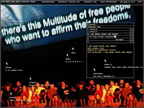
Month Of Sunday's Live A/V Net Performances
Furthernoise.org - Month Of Sunday's Live A/V Net Performances, Visitors Studio, 11th June 2006. Visitors Studio is an online place for real-time, multi-user mixing, collaborative creation, many to many dialogue and networked performance and play. Chat with other users while you upload and mix your sounds, images and movies in real-time.
16.00 -16.45 hrs Paul Wilson & James Smith: For this next Month of Sundays performance Paul Wilson and James Smith are mixing an audio / visual 'typography of place' where field recordings are combined with reprocessed images and sounds made in the extreme environment of former weapons testing lab at Orford Ness. They have collaborated on a range of projects which centre around techniques of sonic typography: using linguistic and alphabetic processes and systems to convert images, places and words into sound.
Recent projects have included a commission for The Wire magazine where the publication's covers of 2005 were reprocessed into a twelve-minute audio mix, and two installations for the upcoming 'Paintwork' exhibition at the Praxis Hagen gallery, Berlin where The Fall's '27 Points' album cover has been translated into both sound and (moving) image.
16.45 - 18.00 - Open Mix: Everyone is welcome to join this Open Mix which is one big A/V collaboration including contributions from online viewers in a host locations & time zones. For anyone who wants to contribute to this mix, media files must be a maximum of 200k and can be mp3, swf, flv & jpg formats. All mixes will be recorded to be featured in the next issue.
Log into file mixing studio - http://www.visitorsstudio.org
Links:
Paul Wilson - www.n-spaces.net
James Smith - www.3L-project.co.uk
Vistors Studio (VS) - http://www.visitorsstudio.org/about_vs.html
Credits - http://www.visitorsstudio.org/about_vs.html#credits
Posted by jo at 02:18 PM | Comments (0)
June 05, 2006
When Ghosts Will Die
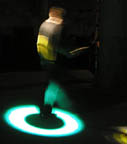
Stories Stitched Together "on the fly"
When Ghosts Will Die, a performance-installation that utilizes multi-sensory elements such as sound, video, light, and text controlled by motion-tracking technology, tells the story about the dangers of nuclear proliferation. Inspired by the play, "Copenhagen", by Michael Frayn, it explores the use of non-linguistic elements in the service of making poetry and telling stories. The artists and programmers involved on the project include Steve Gibson, Dene Grigar, Will Bauer, Jim Andrews, and John Barber.
"When Ghosts Will Die" involves one-two performers and envisions the space as a 3D grid simultaneously within a central computer and a physical performance space. The performers move through this environment and evoke the multi-sensory elements with hand-held tracking devices and in so doing interact with these elements through three potential phases of nuclear proliferation: 1) Disharmony, 2) Destruction, and 3) Disintegration. These three phases are intended to evoke the first nuclear explosion, the "Trinity" test in New Mexico on July 16, 1945, that took place just weeks before the nuclear bombs exploded over Hiroshima and Nagasaki, Japan.
Using the tracking device, the performers can move through the space choosing the element they wish to utilize for telling the story. In this way, the story takes on a rhapsodic quality: it is literally stitched together "on the fly" and changes wtih each telling. The mood of the space is designed to match the phase that the performers reach. Disharmony, for example, offers slightly discordant sounds that increasingly give way to cacophony, as well as video footage representing growing belligerence. Destruction sees the dropping of the bombs and corresponding sounds of buildings falling into rubble. The final phase, Disintegration, takes performers to the motif of the work: that the destruction derived from these weapons will be so complete that even "ghosts will die," an allusion to Michael Frayn's "Copenhagen" that sits at the heart of this project.
The story is meant to shock those participating into a deeper awareness of the horrors of nuclear warfare. Politically speaking, the work's message – that the development and deployment of weapons of mass destruction not only test a country's power but also its humanity – speaks to artists' "responsibility to envision alternative futures... and shape the way people think, live, and interact" (Edward Shanken). [via]
Posted by jo at 12:31 PM | Comments (0)
Live Performance

hymn[two]
On Tuesday June 6, 2006 at 9:00pm new media artist Jason Sloan will perform the next work in the hymns series of telematic performance works. hymn[two] will be broadcast live on the web. The hymn series will conclude later this summer with hymn[three] which will also be broadcast live on the web.
Leading up to the event jason will occasionly be online in his studio testing the equipment so feel free to check out the feed. if you just see an "x" broken image icon or grey box, don't panic, the camera is just offline. Jason is planning more live telematic actions summer. Be sure to check out the web site for more information.
Posted by jo at 10:59 AM | Comments (0)
June 01, 2006
ELIZABETH LEISTER
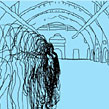
EVERY BODY IS EVERYWHERE AND NOWHERE
Every Body is Everywhere and Nowhere combines performance and technology in an immersive video installation. This new project continues Elizabeth Leister's themes of transformation and control in relation to the body. Leister's performative investigation is informed by a history of body-based performance art, including, Ana Mendieta's "Silhueta Series", "Push Ups", by Vito Acconci and "Up To and Including Her Limits" by Carolee Schneemann. Like the aforementioned, Leister uses video images of body imprints and line drawings, actual and animated, to study the physical and virtual body in space.
What occurs when the body is transformed through our use of technology? The amalgamation of video, performance and drawing in Leister's project links the traditional to the technological and emphasizes the physical impact of our bodies on the world we live in with one another. Our body language, sense of touch, corporeal presence and physical movement through space become invisible as we interact via machines. What is lost? What is gained?
Leister will perform a drawing to define her own physical borders within a specific moment in time and space. This drawing will be made each day for the duration of the exhibit in Leister's Los Angeles studio and transmitted through live-feed via web-cam, into The Morris Gallery in Philadelphia. The traditionally intimate space of performance will expand as the body of the artist is projected across space and time. Made up of shifting light and pixels traveling through cyberspace, the body becomes expansive and limitless.
A second video shows a collage of the imprints left behind by Leister's family and friends: a snow angel, footprints in the sand, a sweater tossed to the ground. A third projection of an animated drawing outlines, frame by frame, a body moving through space. Like the drawing created in the performance, lines are built up to define a path of movement, then reverse and erase.
A computerized voice expresses a desire to be everywhere and nowhere, everyone and no one while a second audio track, taken from Leister's writings, is an overlay of a human voice whispering as if she were light and breath in an unnamed space.
Finally, the video projections will be installed in relation to a set of mirrors to create a kaleidoscope of images that will reflect the body of the viewer. Through live-feed performance, drawing and video the project will juxtapose the physical body and the immateriality of the virtual body.
The exhibition in the Morris Gallery at the Pennsylvania Academy of Fine Arts opens on June 10th and runs through August 20th. The installation, which will open with a free reception June 9 from 6 to 8 p.m., is curated by Alex Baker, the Academy's Curator of Contemporary Art.
Museum hours are Tuesday through Saturday, 10 a.m. to 5 p.m., and Sunday, 11 a.m. to 5 p.m. The Academy is located at 118-128 N. Broad Street in Philadelphia, two blocks north of City Hall. Regular admission is $7 adults, $6 seniors and students with ID, $5 children / youth ages 5-18, free for members and children under age 5.
Elizabeth Leister received an M.F.A. in sculpture from the Milton Avery Graduate School of the Arts at Bard College and a B.F.A. from the Tyler School of Art. In Philadelphia, her work has been exhibited at the Philadelphia Museum of Art and Nexus Foundation for Today's Art. Her work has also been shown at the Delaware Museum of Art, the North Dakota Museum of Art, Art in General and P.S. 122 in New York, and the Kellogg Art Gallery at California State Polytechnic University, Pomona, among others. She has received awards from the Pennsylvania Council on the Arts and the Leeway Foundation.
Posted by jo at 11:06 AM | Comments (0)
May 23, 2006
Ursula Endlicher
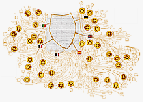
Website Portrait Performances
Ursula Endlicher's Website Portrait Performances (WPPs) consist of graphical visualizations of the hyper-links of a particular website which illustrate the link structure two levels down into it. How the website is written in HTML will define how the links are displayed in the graphic. The grammar of one medium (HTML) is applied to another (graphic).
Furthermore these visualizations are read as so-called "dance notations". Each link is performed depending on how the individual node is defined in the graphic. If a link shows seventy sub-links (HTML) for example, the performance ("dance") will consist of seventy movements. Finally, each link selected by the user also simultaneously displays the real-time URL of the according page of the specific website on a secondary monitor (installation) or window (web).

The "www.whitehouse.gov" Website Portrait Performance exists as interactive installation with "mouse-chair", projection, secondary monitor and real-time web-feed. It also has a web-based version. Other web-based projects in this series are "www.vatican.va" and "www.morexoptimo.com".
Website Portrait Performances are another manifestation of my ongoing interest and research in translating the Web's grammar into other mediums, in this case by superimposing the link structure of a website onto a graphical representation and performances. With the interactive mouse-chair I developed an interface that engages the whole body; a navigation device which expresses my ongoing longing for alternative human-machine communication interfaces.
Posted by jo at 04:54 PM | Comments (0)
Golden Nica in Net Vision
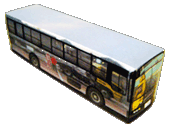
The Road Movie
And the Golden Nica in Net Vision, awarded by Prix Ars Electronica 2006, goes to...The Road Movie, by exonemo (JP), what might be called a mobile installation that originated in conjunction with a live project entitled MobLab in which young Japanese and German artists undertook encounters with art and communication during a journey by bus through Japan. While the group was traveling through a wide variety of landscapes, the webcam mounted on the bus produced five images of the surroundings every five minutes. The image files were uploaded to the Internet in the form of a piece of origami art. Anyone who wants to can print out this origami and create his own road movie with folded busses. Far-off locations are suddenly to be found right in ones own living room.
Posted by jo at 01:47 PM | Comments (0)
Paul DeMarinis

The Messenger Delivers a Golden Nica
The Messenger (1998) by Paul DeMarinis has been awarded the Golden Nica for Interactive Art by Prix Ars Electronica 2006. In The Messenger, email messages received over the internet are displayed letter by letter on three alphabetic telegraph receivers: a large array of 26 talking washbasins, each intoning a letter of the alphabet in Spanish; a chorus line of 26 dancing skeletons and a series of 26 electrolytic jars with metal electrodes in the form of the letters A to Z that oscillate and bubble when electricity is passed through them. Movie.
"The Messenger is an internet-driven installation based on early proposals for the electrical telegraph, in particular those made by the Catalan scientist Francisco Salvá. As in many of my works I examine the metaphors encoded within technology, especially lost or orphaned technologies and try to trace their origins, speculating on the way that mechanisms are the repositories of larger unspoken conceptions and dreams. In The Messenger I take the telegraph as a point of departure from which to examine the relationship between electricity and democracy, and how electrical telecommunication technologies have participated in our solidarity and in our isolation, in our equality and our oppression, in the richness of our experience and the uncertainty of our lives." -- Paul DeMarinis
Paul DeMarinis has been working as an electronic media artist since 1971 and has created numerous performance works, sound and computer installations and interactive electronic inventions. He has performed internationally, at The Kitchen, Festival d'Automne a Paris, Het Apollohuis in Holland and at Ars Electronica in Linz and created music for Merce Cunningham Dance Co. His interactive audio artworks have been shown at the I.C.C. in Tokyo, Bravin Post Lee Gallery in New York and The Museum of Modern Art in San Francisco. He has been an Artist-in-Residence at The Exploratorium and at Xerox PARC and has received major awards and fellowships in both Visual Arts and Music from The National Endowment for the Arts, N.Y.F.A., N.Y.S.C.A., the John Simon Guggenheim Foundation, the Rockefeller Foundation New Media Award and the D.A.A.D. Berlin Artist Fellowship.
Much of his work involves speech processed and synthesized by computers, available on the Lovely Music Ltd. compact disc "Music as a Second Language", and the Apollohuis CD "A Listener's Companion" Major installation works include "The Edison Effect" that uses optics and computers to make new sounds by scanning ancient phonograph records with lasers, "Gray Matter" that uses the interaction of body and electricity to make music, and "The Messenger" and "Firebirds" that examine the myths of electrical communication. Public artworks include large scale interactive installations at Park Tower Hall in Tokyo, at the 1996 Olympics in Atlanta and Expo 1998 in Lisbon and an interactive audio environment at the Ft. Lauderdale International Airport in 2003.
Posted by jo at 01:36 PM | Comments (0)
May 21, 2006
Turbulence Spotlight:
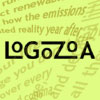
Logozoa by Robert Kendall
Words change everything. We create poems and stories to free the world from itself, to reveal the many feral faces of life. But ironically these liberating words are usually imprisoned on the page or computer screen. Out in the "real" world of day-to-day activity, we use words more crassly. We put labels and signs on things to tame them—identify, categorize, explain, instruct, proclaim ownership. What if instead the labels could liberate the everyday world from the literal, proclaim rather than cover up the mysteries? What if they could become Logozoa—textual organisms that infest the literal with metaphor and give impetuous life and breath to meaning?
Lo•go•zo•a n [fr. Gk logos word + zoia animals] (2005) 1 : word animals: textual organisms 2 : a phylum or subkingdom of linguistic entities that are represented in almost every kind of habitat and include aphorisms, anti-aphorisms, maxims, minims, neokoans, sayings, left-unsaids, proverbialisms, poemlets, microtales, instant fables, and other varieties of conceptual riffs
Find out what happens when you let word animals roam your daily life. Download Logozoa, print them onto your own stickers, and let them loose in your home or neighborhood. Visit the Logozoo to see photos of Logozoa in their natural habitat. To help ensure that these unique creatures do not go the way of so many once-endangered, now-extinct species, photograph your Logozoa and send them to the Logozoo. Explore the Soothcircuit, a unique colony of Logozoa that responds to your questions with insights and prognostications.
BIOGRAPHY
Robert Kendall has been writing electronic poetry since 1990. He is the author of the book-length hypertext poem "A Life Set for Two" (Eastgate Systems) and other electronic works published at BBC Online, Iowa Review Web, Cortland Review, Eastgate Hypertext Reading Room, Cauldron & Net, and other Web sites. His electronic poetry has been exhibited at many venues in the United States, Europe, South America, Asia, and Australia, and he has given interactive readings of his work in many cities. Kendal's printed book of poetry, "A Wandering City," was awarded the Cleveland State University Poetry Center Prize, and he has received a New Jersey State Council on the Arts Fellowship, a New Forms Regional Grant, and other awards. He has taught electronic poetry and fiction for the New School University's online program since 1995. Kendall runs the literary Web site "Word Circuits" and the ELO's "Electronic Literature Directory," and is co-developer of "Word Circuits Connection Muse," a hypertext tool for poets and fiction writers. He has written many articles about electronic literature for national publications, such as Poets & Writers Magazine, and he lectures frequently on the topic.
Posted by jo at 12:16 PM | Comments (0)
May 19, 2006
IP Collage

Distinguishes Participation from Interactivity
IP Collage--by Abram Stern (aka aphid)--is a participative net art piece in which the numbers of each visitor's IP address are added to an image. The four 8-bit numbers that make up the address are recontextualized into php's shape functions in the order they are required: x,y,w,h (x,y coordinate pair & width/height) as well as color: r,g,b,a (red, green, blue, alpha) to create a rectangle of a specific color (& transparency) at a specific location. Viewing the piece changes it permanently.
Generally, 'surfing the net' is thought of as a unidirectional process - one navigates information which comes from the server to the user. However, this is not the case. Every time a user visits a page the web browser transmits information - an IP address, information about the browser (make, model, version number, operating system), and referrer information (what was clicked on to get to the current page). This exchange happens unconsciously and the information provided is often aggregated for commercial marketing purposes.
IP Collage is an attempt to explore this exchange which lies beneath all web content and to use it as the basis for a productive relationship. In exchange for their IP address a user is presented with an image they may save to their local drive, print and/or exhibit.
IP Collage is also an attempt to break participation from interactivity. The piece is participative in the sense that the user directs the aesthetic of the piece, yet it manifests as a static PNG image; it is only interactive in as much as the browser provides interactivity - as it does to all images (much in the same way most video is only as interactive as a VCR & further establishing the dominant aesthetic of interactivity as navigation).
I have compiled a video archaeology of this piece, compressing the first year of its activity into one hour. Each frame of video represents roughly 4 minutes 33 seconds (a synchronistic testament to John Cage) of time between May 13 02002 and may 13 02003. It is currently in DVD and mpeg-4 formats, and I'm still trying to decide how to make it available as I am somewhat ambivalent about transforming a participative piece into a static video record. Feel free to get in touch if you'd like to see it. source code, as usual, is also available upon request.
Posted by jo at 11:45 AM | Comments (0)
Departure & Arrival

Harbour Land/Head/Sketches
As part of the Week of the Sea (20-28 May 2006) on the Dutch island Ameland, foundation Archipel builds for the fourth time a virtual island. This year’s theme is Harbour Land. Harbour Land is a multimedia exploration around the theme "Departure & Arrival."
Media Art Friesland organises two sub-projects for Harbour Land: HARBOUR HEAD and HARBOUR SKETCHES. From 22nd – 26th of May 2006 new material is updated daily at the websites. HARBOUR HEAD will be built via ‘content management systems’ (CMS). The purpose of this project is to generate content with audiovisual recordings and photo’s via experiment with CMS. Ideas and limits of the technique will be searched for, translated by CMS. Random, selected or through association, symbolic or artefacts web collages will arise.
Media artist Michiel Koelink (1972) was invited to be the artistic leader of this project. Jeroen Deen (Noordelijke Hogeschool Leeuwarden) will be in charge of the technique.
The team ‘image & sound beachcombers” exists of the artists José M. Biscaya (Portugal 1973), Sun Ha Borger (1980), Gebrand Burger (1979), Sannah den Engelsen (1979), Henrike Gootjes (1979) and students of the Noordelijke Hogeschool Leeuwarden.
Richard de Boer (1978) is a freelance writer and researcher and will report on a daily basis from Ameland via a blog.
Jeroen Deen is the leader of the project.
For more information contact:
Habour Land: Curator Archipel , Timo Mank - Hollum Ameland 0519 55 44 05 timo[at]archipel.nu.
HABOUR HEAD & HABOUR SKETCHES: Artistic director Foundation Media Art Friesland: Nadine Bors, 06-42670733, info[at]mediaartfriesland.nl.
SPONSORS & PARTNERS:
Provincie Friesland, Gemeente Ameland, Noordelijke Hogeschool Leeuwarden, VVV Ameland, Kabel Noord, Wagenborg Passagiersdienst, Stichting Amelander Musea, Hotel Stay Okay Ameland, Hotel Pension Ambla Ameland.
Nadine Bors
artistiek directeur/ artistic director
stichting/ Foundation Media Art Friesland
www.mediaartfriesland.nl
info[at]mediaartfriesland.nl
F.D Nieuwenhuisstraat 53
8862 WC Harlingen
0031 517 43 40 33
Posted by jo at 11:26 AM | Comments (0)
333 of 1001 nights cast
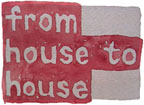
Call for Writers
1001 nights cast has just passed the one-third mark. Performance number 333 with a story by Victoria Spence was performed May 19, 2006.
...1001 nights cast travels back to the northern hemisphere on June 11. I'll be based in Madrid, Granada and London for three months, making a special effort to coax both old and new European writers into the pool. Be aware that writing deadlines and performance times will therefore change in relation to wherever you are and my new, later, sunset times. I will miss my Australian audiences who probably won't feel like getting out of their winter beds at 4am to tune in, but I fully expect them all to keep writing. We might have to say farewell to the west coast of north and south america for that period. Don't worry, they'll be back.
If you've been thinking of writing or know someone who might like to write me a story, please make contact with me at this email address...: barbara[at]1001.net.au" -- Barbara Campbell
Posted by jo at 11:07 AM | Comments (0)
SOLAR RADIO STATION

Sounds of the Universe
SOLAR RADIO STATION, a project by RIXC, Center for New Media Culture, Riga (LV) and r a d i o q u a l i a (NZ / AUS / GB / NL); PHOENIX Halle Dortmund; May 20 - July 16, 2006; Opening: Friday, May 20, 2006, 18:00.
In this (live) installation one can listen to the sounds of the universe originating from various sources. They have been collected by the artists' group r a d i o q u a l i a (Honor Harger, Adam Hyde) in cooperation with RIXC, Center for New Media Culture, Riga. The recordings are coming from various radio telescopes. Additionally, during two days, there will be live feeds from the VIRAC radio astronomy telescope in Irbene (Latvia) which will be acoustically re-worked and interpreted live by the experimental musicians Clausthome (Latvia). VIRAC is the largest radio telescope worldwide (with a dish diameter of 32 meters) accessible for civilian use - thanks to RIXC's continued efforts. During the cold war the KGB used the radio telescope for tapping into NATO's and other military networks.
The installation “Solar Radio Station" consists of three parts. r a d i o q u a l i a's computer and sound installation “solar listening_station" is the first part. It contains recordings and live streams of radio waves from space, especially from the sun. The second part “Spectrosphere" also contains signals originating from the VIRAC radio telescope, this time modulated via electronic instruments and interpreted visually. Here, Clausthome and VJ Ratniks present the results of their live performance from May 20 + 21 at PHOENIX Halle until July 16, 2006. The third part consists of a comprehensive video documentation of the VIRAC telescope by RIXC. Additionally, on a large scale poster the existing frequency spectrum is visualized and its current use is explained.
LIVE INSTALLATION: Sat + Sun, May 20 + 21, 2006, 19:00 - 21:00; The Riga based group Clausthome and VJ Martins Ratniks (F5/RIXC) will perform live in the Solar Radio Station. The live audio stream from the VIRAC radio telescope in Irbene, carrying data from the sun and from space, will be electronically enhanced by Clausthome and interpreted visually by VJ Martins Ratniks.
LINKS
www.museumamostwall.dortmund.de
www.hmkv.de
www.rixc.lv
www.radio-astronomy.net
www.virac.lv
A project by RIXC, Center for New Media Culture, Riga (LV) and r a d i o q u a l i a (NZ / AUS / GB / NL).
RIXC (LV) - Raitis Smits, Rasa Smite, Martins Ratniks, Davis Bojars r a d i o q u a l i a (NZ/AUS/NL/GB) - Adam Hyde, Honor Harger Clausthome (LV) - Lauris Vorslavs, Girts Radzins
In the framework of the exhibition "mit allem rechnen. Medienkunst aus Estland, Lettland und Litauen / face the unexpected. Media art from Estonia, Latvia and Lithuania" - a cooperation between Hartware MedienKunstVerein and Museum am Ostwall, Dortmund/Germany.
SUPPORTED BY: Kulturbuero Stadt Dortmund, 38. internationale kulturtage der stadt dortmund / scene: estland lettland litauen in nrw, Kunststiftung NRW, Der Ministerpraesident des Landes Nordrhein-Westfalen, Kultusministerium der Republik Estland, Kultusministerium der Republik Lettland, Kultusministerium der Republik Litauen, Botschaft der Republik Litauen in der Bundesrepublik Deutschland, Lietuvos Institutas, dortmund-project, LEG, PHOENIX, Medion, Coolibri (Medienpartner).
VENUE: Hartware MedienKunstVerein at PHOENIX Halle Dortmund, Rombergstr. / Ecke Hochofenstr. (no postal address!) Dortmund-Hoerde, Germany.
ADMISSION: PHOENIX Halle: 4 Euro, reduced 2 Euro (incl. admission to the exhibition "Glamour and Globalization") Kombiticket Museum am Ostwall and PHOENIX Halle: 6 Euro, reduced 3 Euro (incl. admission to the exhibition "Glamour and Globalization")
HOW TO GET THERE http://www.hmkv.de/dyn/e_contact_roaddescription/
CONTACT
Hartware MedienKunstVerein
Guentherstraße 65
D - 44143 Dortmund
Germany
Tel: ++49 - 231 - 823 106
www.hmkv.de
Posted by jo at 10:51 AM | Comments (0)
Pall Thayer
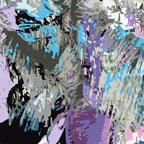
On Everything
On Everything generates a real-time audio/visual presentation of everything by appropriating material being shared by the worldwide public in the form of shared images and diaries. The source material is endless, thus the work goes on forever. Material is synthesized, mixed and, ultimately, abstracted, to allow for varied interpretation. "On Everything" knows nothing of the content of these materials. It reflects everything while reflecting on nothing. That is up to the viewer.
You will be asked to "trust" an application. The application in question is a Java based Mp3 player that allows a live Mp3 stream to be played through a web page. Please click "trust" to enjoy the art work. [blogged by poster on post.thing.net]
Posted by jo at 10:11 AM | Comments (0)
May 10, 2006
Blind Love
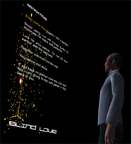
Extensions via Virtual World of Art
In Blind Love (click on Art), two visitors must find each other before they can find the way out of a pitch-black labyrinth. Each is armed with a weapon that shoots luminous particles. The particles explode on the walls and cascade into the corners, revealing the skeletal outline of the labyrinth's architecture. The two visitors must use the light emitted by their weapons to find one another, but-in an inversion of normal game logic-must not hit and kill each other if they hope to win. Like lovers, the visitors must blindly trust each other in order to survive, and must approach one another despite the danger.
Blind Love is one of the art works created for EXTENSION (click on Virtual World of Art, Extensions/SAT), a virtual architectural intervention that explores the potential of digital architecture to reveal and transform urban, cultural, and spatial identities. EXTENSION was created for the SAT in Montreal, one of North America's leading centres for new media. Visitors entering EXTENSION through the SAT terminals find themselves in a virtual space that mirrors their actual physical surroundings.

As they move through the environment, they cross from reality into virtuality, and from simulation into representation. Within the virtual environment, the existing building of the SAT has been recreated as a realistic 3D model. This simulation is transformed and reconfigured with the addition of a vast, zeppelin-shaped structure affixed to the roof. From inside this glass-encased space, visitors have a panoramic view of a virtual Montreal, where the city itself has been reconstructed with a poetic blend of realism and utopian fiction. Visitors to this near-real space discover experimental artworks in the halls and rooms of the virtual environment, and layered in other dimensions accessible through portals that brings the viewer into dedicated art installations. Anchoring virtual experience in real space, EXTENSION blurs the boundaries between imagination and perception. Grounded in the real but not limited to the realistic, EXTENSION is a reflection of the concepts and visions each of us forms about spaces and places.
EXTENSION is one of three nodes of the Virtual World of Art.

As technologically mediated experiences the Internet, games, cinema, television occupy ever more of our time and energy, it becomes increasingly vital that we create alternative spaces and environments for experience within these borderless territories of information and communication. Virtual World of Art invokes, manipulates and transforms the vocabulary and logic of game culture to create artistic engaging spaces which awaken aesthetic, emotional, social and intellectual responses radically different from those engendered by contemporary mass media. The project explores a variety of significant problems that cultural institutions committed to artistic practice within a networked electronic environment continue to face: how to create esthetically compelling and emotional online experiences, how to link physical and data spaces together, and how to effectively enable human communication and exchange in a physical space where local and remote visitors and performers can communicate virtually through technologies and computer interfaces.
Virtual World of Art investigates the artistic possibilities of immersive game technology and proposes new models for experiencing architectural and public spaces, sociability, and cultural production. Grounded in reality but not limited to realism, Virtual World of Art forms a dynamic, socially relevant, independent alternative to the existing art world, enabling artist to emancipate and develop a critical view of the future and meaning of contemporary art.
Virtual World of Art is the title for a series of new media art projects which subvert and reconfigure multi player game technology to create a network of artistic virtual environments. Each of these virtual environments called nodes, containing digital artworks and virtual art installations, is associated both conceptually and thematically with a specific site, arts centre or a public event where the project is presented on a long-term basis. These virtual environments are connected together by the internet forming a new kind of enlarged social and experiential public space for artistic expression and social exchange.
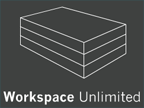
VWA will connect at least 3 locations or nodes in order to function as a complete project. Each node explores a different notion of hybrid between physical and virtual public space. Visitors will be able to interact through terminals installed at the nodes or at any public space in the world that has a high-speed internet connection.
Virtual World of Art is a project of Workspace Unlimited.
Posted by jo at 10:57 AM | Comments (0)
May 09, 2006
We Feel Fine + Lovelines
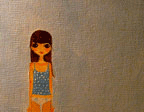
Explorations of Emotions and Desires
Since August 2005, We Feel Fine, An Exploration of Human Emotion, in Six Movements, has been harvesting human feelings from a large number of weblogs. Every few minutes, the system searches the world's newly posted blog entries for occurrences of the phrases "I feel" and "I am feeling". When it finds such a phrase, it records the full sentence, up to the period, and identifies the "feeling" expressed in that sentence (e.g. sad, happy, depressed, etc.). Because blogs are structured in largely standard ways, the age, gender, and geographical location of the author can often be extracted and saved along with the sentence, as can the local weather conditions at the time the sentence was written. All of this information is saved.
The result is a database of several million human feelings, increasing by 15,000 - 20,000 new feelings per day...At its core, We Feel Fine--by Jonathan Harris & Sepandar Kamvar--is an artwork authored by everyone. It will grow and change as we grow and change, reflecting what's on our blogs, what's in our hearts, what's in our minds. We hope it makes the world seem a little smaller, and we hope it helps people see beauty in the everyday ups and downs of life.
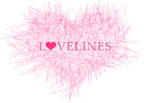
Through large scale blog analysis, Lovelines--also by Jonathan Harris & Sepandar Kamvar-- illuminates the topography of the emotional landscape between love and hate, as experienced by countless normal humans keeping personal online journals.
Using a data collection engine created for We Feel Fine, Lovelines examines thousands of blogs every few minutes to find expressions of love and hate, posted by all manner of people. When it can, Lovelines identifies and saves the age, gender, and geographical location of the person who wrote the post, and then presents that information along with the post. The entries range from frivolous to profound, offering a glimpse into the hearts and minds of people blogging about their wants and needs.
Lovelines presents a stark white screen, bounded on the bottom by a slider running from “Love” to “Hate”, with a draggable heart that becomes scratched out to the point of illegibility as the heart approaches “Hate”. As the slider is pulled through Love, Like, Want, Indifference, Dislike, and Hate, words and pictures appear above to represent the chosen state of desire or despair.
Constructed entirely from found artifacts – words and pictures posted to blogs – Lovelines draws its identity from a world of strangers, brought together by shared degrees of desire.
Posted by jo at 11:35 AM | Comments (0)
May 07, 2006
Turbulence Spotlight:
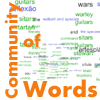
Community of Words
The Community of Words--by Silvia Laurentiz and Martha CC Gabriel--is a 3D environment governed by the Theory of Emergence. Users are invited to add their own words thereby becoming part of the community of words; they can navigate the environment and observe the actions of others. Words already present in the space influence participants who may create new texts in response to them. Characteristics such as language or culture form completely different communities and, subsequently, the words that emerge within them. [Needs Flash plugin, screen resolution 1024 x 768, click on Set Up for browser settings]
BIOGRAPHIES
SILVIA LAURENTIZ: Professor in the department of Fine Arts at the School of Communication and Arts, University of São Paulo, Laurentiz holds a PhD in Communication and Semiotics and a Masters Degree in Multimedia. She is also a graphics and multimedia designer; an artist who works in virtual reality, multimedia and web art; an art and new technologies researcher; and a speaker at art and technology conferences.
MARTHA CARRER CRUZ GABRIEL: An engineer with postgraduate studies in Marketing and Graphic Design, Gabriel's Masters Degree in Art & Technology is in progress at the University of São Paulo. Web/MM artist, professor at the Business School and Digital Design Program of the Universidade Anhembi Morumbi, and director of technology at New Media Developers (NMD), Gabriel is the winner of 11 Internet Best Awards from 1998 to 2005 and a highly acclaimed speaker.
For more information about Turbulence, please visit http://turbulence.org
Posted by jo at 10:17 AM | Comments (0)
May 05, 2006
Turbulence Commission:
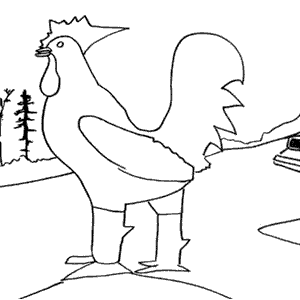
HRRAAGHP-TING!
HRRAAGHP-TING!--by Olen Hsu, Dana Karwas and Steven Lam--is an Internet/video collaboration that connects image and sound filenames available on the web to create an infinite chain of associations. Extruded in real time, and in a linear format, they collapse the Internet’s spatial organization into a single screen to create a cinematic experience. Each time "HRRAAGHP-TING!" is used, it generates an entirely different set of visual, aural and linguistic relationships. This Cagean play with chance destabilizes the intent and authorship implicit in the communication of information; perverts intellectual property through rampant decontextualization; and defies the expectations of the viewer through live reorganization.
"HRRAAGHP-TING!" is a 2006 commission of New Radio and Performing Arts, Inc. (aka Ether-Ore) for its Turbulence web site. It was made possible with funding from The Greenwall Foundation.
BIOGRAPHIES
OLEN HSU constructs installations in porcelain, paper and algorithmically composed sound, converging new media, tactile forms and works for acoustic instruments. He received his BA in Art History and Music from Yale University, a BFA in Ceramics from the Kansas City Art Institute, and an MFA in Sculpture from The School of the Art Institute of Chicago. A fellowship from the Dedalus Foundation brought him to New York where he participated in the Artist in the Marketplace Program at The Bronx Museum of the Arts, the Harvestworks Digital Media Arts Center Artist-in-Residence Program for New Music, and the BCAT/Rotunda Gallery New Media Artist Residency. Hsu is the recipient of grants from the New York State Council on the Arts, the National Endowment for the Humanities, the Joan Mitchell Foundation and the John Michael Kohler Arts Center. His recent work has been shown at The Bronx Museum of the Arts, the InterSpace New Media Arts Center in Sofia, Bulgaria, and James Nicholson Gallery in New York. The artist currently lives and works in New York City.
DANA KARWAS received a baccalaureate degree in Architecture from the University of Kansas and holds a Masters in Interactive Telecommunications from NYU’s Tisch School of the Arts. She is the co-founder of Gorilla Kingdom, a multimedia production company based in NYC. Her main interest lies in transforming and redefining social spaces through the medium of technology. Her work is rooted in architecture and extends to the edges of social and cultural dimensions. She has taught workshops on interactive mobile technology and the connections between architecture and the visual and sonic arts at the Harvestworks Digital Media Arts Center, NYC.
STEVEN LAM is interested in revealing how information becomes distributed, internalized, and performed. His practice is of glitches and reversals, re-enunciation, redubbing, recasting, and appropriation. He employs humor and a DIY sensibility to investigate contemporary issues dealing with institutional and media critique and the relationship of aesthetics with politics. Lam has exhibited at the Bronx Museum of Art, NY; Eyebeam, NY; LEF Embodied Technologies show at Art Interactive, Boston, MA; Silverlake Film Festival, Los Angeles, CA; Diverseworks, TX; The Windtunnel at Art Center College of Art and Design, CA.; Aljira: Center for Contemporary Art, NJ as well premiering video/choreographic work for various performance venues. He received his BA in Art History and Art from Trinity University, and a MFA from the University of California, Irvine.
Posted by jo at 12:15 PM | Comments (0)
Call for Participation
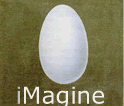
iMagine
iMagine--by Les Liens Invisibles--is a ludic reflection about mainstream imaginary; iMagine wants to be a ludic reflection about overwhelming and overflowing images, it is based on the collaborative mechanics of the Net and freely inspired by René Magritte's works.
The logos of our symbolic system, manipulated and controlled by an élite and not by the whole community, are defined by processes and choices based on marketing techniques and determined by the need to make profit. Symbols, or, as Barthes calls them, logotechnics, that derive from this logical process impose a one-way relationship with the imaginary sphere of every individual, whose only role becomes that of consuming the cultural element through the good/medium that conveys the message. The symbolic relations crystallize the chain of meaning that constitutes the base of the whole system.
iMagine is an image search engine based on a double action:
1. De-automatization > this mechanism allows users to regain a symbol that belongs to the collective media imaginary and to put it in a database, with some information related (TItle, Category, Keywords), so that it will be possible to create a new cultural context for a well-known symbol. The name iMagine comes from the imaginative effort that the user must do when he/she records his/her image;
2. Search > the search allows users to look for images in the database. The recording action allows the change of the mechanism of query/result of the search engine, that will provide only image with a new context, depending on the user's query. The gap between the expected result and the actual one is the starting point to build up new meanings and new correlations based on the new images produced.
Posted by jo at 10:14 AM | Comments (0)
May 02, 2006
TechnoTexts

CTheory Live
Another installment in the newly launched CTheory Live interview series, N. Katherine Hayles, Professor of Literature and Media, UCLA, reflects on her three books: My Mother Was a Computer, Writing Machines, and How We Became Posthuman.
This interview is a rich, dense conversation in which Katherine Hayles provides the overall context and common threads that led to the three books. From her perspective, there was no interpretive history of cybernetics. She cites her interest in reintroducing embodiment into the discourse and trace the implications for subjectivity regarding the notion of information as disembodied.
Posted by michelle at 11:07 PM | Comments (0)
April 27, 2006
Corposcópio
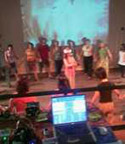
Circle dancing meets mobile technologies
Corposcopio is an experimental collaborative performance that associates circle dance and mobile technologies. The purpose of the interactive performance is to stimulate, simultaneously, the perception of the media in contemporary reality and the collective body emergence. Corposcopio departs from the experience of circle dance, a very ancient group activity, present in different cultures in the world, and aggregates real time image manipulation, software art, VJ, and remix aesthetics.
The transparent, ubiquitous and pervasive presence of computer systems in contemporary spaces is a quotidian fact. Nevertheless, the emergence of digital communities demonstrated the power of human factor in the disruptive use of technologies. Human beings are social beings. Our depart point is to bring an ancient practice, the circle dance, to the scenery of real time image manipulation, ubiquitous computing and mixed reality. The performance itself deals with co-creation development and uncertainty. Each performance has peculiar characteristics hence it is an open system, open to receive the group interaction and participation.
The circle is probably the oldest known dance formation. Ancient circle dances movements are cultural manifestations present in different countries around the world, including Greece, African, Eastern European, Irish Celtic, Catalan, South American, Central American and North American. They have a great power of community integration. The experience stimulates an extended consciousness, a simultaneously perception of the individual body and the collective body. Our hypothesis is that each group will catalyze the emergence of an embodied consciousness of our mediated situation in a different way. As Bernhard Wosien, one of the pioneer researchers on circle dance, has said, dance is a path to totality. In Wosien's view, circle dance has deep ritual characteristics and evokes a tremendous collective enthusiasm. In Corposcopio experience, we observed a great vibration produced by the group movement in harmony with the music. In Brazil, there is a lot of amazing circle dance and one of the most popular is called “ciranda”, whose movements are inspired by sea waves. Ciranda is performed by hundreds of people and some participants fall into trance.
The music has a fundamental role in Corposcopio project. The songs have been chosen by Andrea Leoncine and Andrea Soares, based on their research on folk music and Brazilian music. Dudu Tsuda has created new versions of traditional and folkloric songs, introducing unexpected accords and transformations on form. Tsuda's compositions are open systems that dialogue with enthusiasm and energy with the participants of the circle.
Corposcopio Project comprehends three different systems: the technological, the musical and the interactive arena, that is the place for the circle dance. The technological system is composed by systems of input and output. Two computers receive the images sent by mobile and unmovable devices. Wi-fi cameras, allocated in the dancers' bodies and cell phones transmit the images from the movable point of view. Three fixed cameras, situated around the circle and another one hanged on the ceiling provide the images from the unmoving angle. The camera situated on the ceiling transmits a design that reassembles different and dynamic mandalic patterns. The images received are manipulated in real time using Randox, software developed by Nacho Duran. The projection of images follows a script that has different levels and narrative elements.
Biography of the author
Lucia Leão is an interdisciplinary artist that has been leading researches in art and new technologies since 1989. She obtained her Bachelor of Arts degree in 1984, her MA and Ph D degrees in Communication and Semiotics: Information Technology from PUC - SP Catholic University in 1997 and 2001. Lucia Leão was Postdoctoral Fellow in Arts, in UNICAMP, Campinas, São Paulo, Brazil, from 2001 to 2005.
Leão's research is based on the hypothesis that the ancient studies of myths, labyrinths and rituals could help us to better understand and deeper interact with our contemporary mixed spaces. Her interest in the relationship between labyrinths and cyberspace led her to publish three books on this subject: "The labyrinth of hypermedia: architecture and navigation on cyberspace" (1999), “The labyrinth aesthetics” (2002), and “Interlab labyrinths of contemporary thought”(editor, 2002). She also published another books and collections. Her present research articulates the concept of nomadic wired bodies and ancient circle dances.
Lucia Leão is currently professor at PUC-SP and SENAC University, where she coordinates Cyberculture Research Group. Her articles and projects are available at www.lucialeao.pro.br
Corposcopio team
Lucia Leão
Artistic concept/direction
Nacho Duran
Software development and live image editing (VJ)
Rodrigo Gontijo
Live image editing (VJ)
Fernando Velázquez
System development and live image editing (VJ)
Andrea Leoncini
Choreographic project of circular sacred dances
Andrea Soares
Choreographic project of Brazilian circular dances
Dudu Tsuda
Musical creation
Gisele Fink
Percussion
Leonora Fink
Production
Posted by luis at 12:50 PM | Comments (0)
April 25, 2006
Quoth

NetJamming with Ominiscient Interpreter
Quoth is a dynamic interactive fiction system, in which authoring is done from a player's perspective, from within the running work. Quoth draws upon the concepts of pervasive anthropomorphisation, executable natural language, and revisionist narrative. The major use of Quoth so far has been for musical livecoding.
In traditional interactive fiction, the player speaks to an ominiscient interpreter. There may be dialogue with "non-player characters", but it is mediated by the interpreter. In Quoth the player is always speaking directly to some item in the universe. The traditional omniscient interpreter is represented by the universe itself. This allows for each item in the universe to have a different vocabulary, or even a different "interpreter" altogether. It also provides the player with more fluid interaction with each item...
Posted by jo at 08:14 AM | Comments (0)
April 05, 2006
Charade
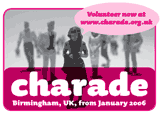
human RAM
In Charade, artist Simon Pope outlines a scenario where data, stored in peer-to-peer networked computer systems - under threat from hacks, crashes, viruses and legal constraint - takes flight back into the human body. Participants, engaged through a local publicity campaign, workshops and a large-scale live event, become part of a distributed performance of walking and memorizing.
Volunteers attempt to memorize a chosen piece of music, film, tv programme, play or book; through a process of walking, memorizing, remembering and reciting, they each attempt to 'become' their favourite 'media asset'; support is given to them through a series of theatre workshops and website; a number of volunteers record their progress as 'video diaries', made available online; at a large-scale public event all volunteers congregate to recite their chosen piece while wandering together, en masse – a re-creation of the final scenes of Truffaut's Fahrenheit 451.
Posted by michelle at 02:05 PM | Comments (0)
March 15, 2006
Turbulence Commission: "Oil Standard" by Michael Mandiberg

Adding Functional Absurdity to the Mix
Oil Standard is a web browser plug-in that converts all prices from U.S. Dollars into the equivalent value in barrels of crude oil. When you load a web page, the script seamlessly inserts converted prices into the page. As the cost of oil fluctuates on the commodities exchange, prices rise and fall in real-time.
Seeing the cost in oil of a new iPod on Amazon.com, or the balance in your bank account is startling. More than just a play on the concept of the 'Gold Standard,' or the old 'Standard Oil' company, this is a glimpse into the moment when oil will replace (or already replaced) gold as the standard by which we trade all other goods and currencies.
The script is written in Greasemonkey, an official extension for Mozilla Firefox that allows the user to change the look, content, or function of a webpage, by writing client side DHTML into a page. Greasemonkey has primarily been used for very functional tasks: nytimes.com ad blockers, eBay.com auto-sign-in scripts, etc. "Oil Standard" adds some functional absurdity to the mix.
Requires Mozilla Firefox and Greasemonkey script (follow download instructions on site).
"Oil Standard" is a 2006 commission of New Radio and Performing Arts, Inc. (aka Ether-Ore) for its Turbulence web site. It was made possible with funding from the Jerome Foundation and New York City Department of Cultural Affairs.
BIOGRAPHY
Michael Mandiberg is a conceptual artist, computer programmer and rogue economist who uses the internet, video and performance to explore subjectivity, labor, and commerce. His current work delves into creative appropriations of outsourcing, artistic uses of open API web platforms, and the global dependence on oil. In 2001 he distributed perfect copies of copies on AfterSherrieLevine.com, and put all of his possessions up for sale on Shop Mandiberg. His work has been exhibited at such venues as the New Museum for Contemporary Art, New York City; Ars Electronica Linz, Austria; and the ZKM in Karlsruhe, Germany. An Assistant Professor at The College of Staten Island/CUNY, Michael lives in, and rides his purple bicycle around Brooklyn.
Posted by jo at 07:55 AM | Comments (0)
Turbulence Commission: "Knitoscope Testimonies" by Cat Mazza
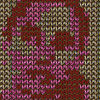
Testimonies Against Sweatshop Labor
Knitoscope Testimonies is the first web based video using "Knitoscope" software, a program that translates digital video into a knitted animation; it imports streaming video, lowers the resolution, and then generates a stitch that correspondes with the pixel's color. Knitoscope is a moving image offshoot of microRevolt’s freeware knitPro. The title "Knitoscope" is based on Edison’s early animation technology the kinetoscope, which was a "coin operated peep show machine…watched through a magnifying lens." The "Testimonies" in this piece are from various professionals who work against sweatshop labor: Erica Zeitlin works in legislative policy change in Los Angeles; Roian Atwood develops new business models at "American Apparel"; Eric Frumin is the Director of Health and Sanitation for UNITE HERE; and Jim Keady is the founder of "Educating for Justice." More Testimonies will be uploaded during the weekend of the Sweat Free Communities Conference (April 7-9, 2006) in Minneapolis, MN. [To view testimonies at 180x120 ratio, pop-ups must be enabled. Requires Flash Player.]
"Knitoscope Testimonies" is a 2006 commission of New Radio and Performing Arts, Inc. (aka Ether-Ore) for its Turbulence web site. It was made possible with funding from the Jerome Foundation.
BIOGRAPHY
Cat Mazza is an artist who lives in New York. She is the founder of microRevolt which is responsible for a series of art projects that combine knitting, machines, and digital social networks to educate about the sweatshop crisis. microRevolt projects have exhibited as part of the 2005 Performa Biennial in NYC, Futuresonic in Manchester UK, FILE in São Paulo and received a “Digital Communities” award at Ars Electronica. The work has been reviewed in MIT Press, the Eyebeam Journal, Knit Knit, Financial Times Deuschland, and Bust Magazine. Mazza received her BFA from Carnegie Mellon University and MFA from Rensselaer Polytechnic Institute.
Posted by jo at 07:45 AM | Comments (0)
March 03, 2006
Taking The Time For A Walk
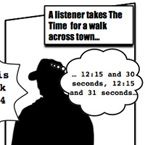
Between Performer and Radio Time
This project is an adaptation of Time Server which was first performed for the Foundry's Late Late Breakfast Show, broadcast in London on Resonance 104.4FM between midday and 1pm on July 22.
The work entailed Simon Pope walking from the NTP (network time protocol) server at University of London Computer Centre in Guilford Place, London, to the Foundry in Old Street, London, 'taking the time' and delivering it to the radio show from where it was broadcast live on FM radio. The aim of the work was to investigate the interaction between 'clock time' and 'circadian time', using radio broadcast's conventional standardized time as a gauge.
In Taking The Time For A Walk--by Simon Pope in collaboration with The Foundry--a radio broadcast of 'clock time' is 'returned' to the Foundry's radio show. Simon Pope will walk from the line of the meridian as it intersects London, 'talking the time' with him as he goes; this 'time', as moderated by the 'body clock' and movement of the performer, then becomes the standard time that the radio station uses in its radio broadcast. [a NODE.London event]
Posted by jo at 10:56 AM | Comments (0)
VisitorsStudio
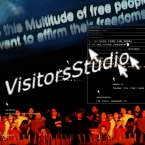
Version2
A project by Marc Garrett (director, creative), Neil Jenkins (director, creative & tech), Ruth Catlow (director, creative) and Furtherfield in collaboration with Arts Council England (London) (funder).
VisitorsStudio is an open, multi-user, online arena for creative 'many-to-many' dialogue and networked performance. Through simple and accessible facilities, the web-based interface allows users to collage and manipulate their own and others’ audio-visual files, and to imaginatively recontextualise existing media. VisitorsStudio provides a platform for explorations of collective creativity for both established artists and those excluded from traditional art structures, for reasons of geography or social circumstance.
In March 2006, Furtherfield will launch VisitorsStudio Version2, which incorporates new artistic tools and community building facilities, allowing users to schedule and promote their own performance programmes. These can be recorded, archived, downloaded and redistributed as screensavers. 25th-26th March "VisitorsStudio" @ Idea Store, Chrisp Street [a NODE.London event]
Participants upload content, image and sound files (JPG, MP3, SWF) to a shared database, responding to each other’s compositions in real time. Individuals can also chat with each other and are identified within the online space by their own dancing-cursors.
VisitorsStudio is a Furtherfield project collaboratively developed by artists, programmers, critics and curators, with significant contributions by audiences new to net art, and members of online art and technology forums. This platform continues to grow organically in response to their participation.
Posted by jo at 10:01 AM | Comments (0)
February 27, 2006
UpStage

Indigenous Maniacs
The next UpStage open walk-thru on Wednesday, 1 March, will include a short performance by participants of the recent UpStage workshop at the Computing Women's Congress in Hamilton, NZ.
The performance is called "Indigenous Maniacs" and was inspired by material presented at the congress, including Liz Bryce's MFA Master's project "Becoming Indigenous: an impossible necessity". Liz's work explores concepts inherited by Pakeha (white) New Zealanders through the desires of their colonial ancestors, and speculates on the paradox - to "become" indigenous. "Indigenous Maniacs" was created during 4 3-hour workshop sessions, and when it was presented at the conference we were all in the same room together - so it will be a new challenge to perform it with everyone in different locations, some on dial-up, and no physically present audience.
We'll meet in the Introduction Stage at the following times, then proceed to the Indigenous Maniacs stage: USA California: 12am; USA New York: 3am; UK: 8am; Western Europe: 9am; Finland: 10am; Australia NSW: 7pm; NZ: 9pm. For other local times, check http://www.worldtimeserver.com/.
Point your browser at http://upstage.org.nz:8081/stages/presentation; there's no need to log in for the performance (in fact we'd prefer it if you didn't), but if you'd like to log in and play afterwards, please email me for a log-in.
UpStage is a web-based venue for live performance; in this creative online environment, multiple players in remote locations work together to compile avatars, images, text, speech and web cams for real-time digital story-telling.
Helen Varley Jamieson: creative catalyst helen[at]creative-catalyst.com http://www.creative-catalyst.com; http://www.avatarbodycollision.org; http://www.writerfind.com/hjamieson.htm
Posted by jo at 12:12 PM | Comments (0)
February 18, 2006
The Fibreculture Journal, Issue 7
![]()
Distributed Aesthetics
Distributed Aesthetics edited by Lisa Gye, Anna Munster and Ingrid Richardson--Abstracts: ...and Beyond: Anticipating Distributed Aesthetics by Darren Tofts; Theses on Distributed Aesthetics. Or, What a Network is Not by Anna Munster & Geert Lovink; Sharing Styles: New Media, Creative Communities and the Evidence of an Open Source Design Movement by Greg Turner-Rahman; Excerpts From ‘Portrait Of The VJ’ by Mark Amerika; Multiple Perspectives/Multiple Readings by Simon Biggs; Beyond the Museum Walls: Situating Art in Virtual Space (Polemic Overlay and Three Movements) by Vince Dzekian; Reshaping Spectatorship: Immersive and Distributed Aesthetics by Edwina Bartlem; Entropy And Digital Installation by Susan Ballard; Intimate Transactions: The Evolution of an Ecosophical Networked Practice by Keith Armstrong.
Finding new terminology for emerging art and cultural practices or for media and technological constellations is bound to be contentious. On lists, blogs and during face-to-face forums and conferences we continue to debate what the term new media entails, let alone whether this provides an umbrella for wearable computing, smart materials, mobile phone movies or bioart. It is clear that computational culture is drifting, fragmenting and laterally expanding: terminals are no longer dedicated; cultural producers are now recurrent and mobile multi-taskers; art is online, on the street, on a screen and coming at you from a million different places, now.
Rather than try to define the terminology or taxonomy of distributed art theories and practices we have proposed instead a descriptor for the ‘aesthesia’ of contemporary networked encounters. Distributed aesthetics, then, concerns experiences that are sensed, lived and produced in more than one place and time. This might equally be a sketch of reconsiderations of the operations of cultural memory or of phenomena such as endurance performances. But what we propose, through gathering together the disparate pieces in this fibreculture journal issue, is that techno-social networks are crucially constitutive of this distributed aesthesia. In various ways, all the texts here take up the mode through which ‘the network’ – the juncture and disjunction of here and there, you and I, social and individuated – functions as the crucial operand in dispersing and contouring perception, art practice and aesthetics.
It would be unwise, however, to assign distributed aesthetics the role of the ‘new’ new media. As Darren Tofts cogently demonstrates in his analysis of the burgeoning Australian media arts scene of the late 1970s and 1980s, certain network formations pre-date the current raft of theorisation. By re-visiting work from the 1980s by artists such as Philip Brophy and the band Tsk-Tsk-Tsk, which included street stencil art, live performances, video events and gallery shows, Tofts invites us to unpack media art as a temporally staggered and distributed event. The importance of drawing our attention to these pre-figurations of networked aesthetics lies in both highlighting the rich and remediated history of media arts and in sobering the frenzy around the fad for relational aesthetics doing the global rounds of art galleries and conferences. Like the Flash mobbing that arises form current distributed media, these earlier media art events depended upon a participatory audience prepared to facilitate information about the works’ distributed times and places. Geert Lovink and Anna Munster, on the other hand, discern a particular aesthetic dominating contemporary imaginings of the network, which they title ‘the will to network mapping’. In a series of speculative propositions that seek to move towards a social rather than formal aesthetics, Lovink and Munster prise this image of the network as an ever-growing euphoric entity to be charted via links and nodes away from biologistic and organisational metaphors. Instead, they suggest, networks are human constructions and their ‘aesthesia’ must come to terms with all too human experiences of frustration, boredom and labour that comprise life lived in and with distributed media.
From an altogether different perspective, Greg Turner-Rahman empirically explores the practices of resource, knowledge and skill sharing among online design communities that amount to a literal distribution of aesthetics. He offers us a different version of design practice, which is often only considered from the point of view of its corporate environment where the one-way transmission of brief from client to designer holds sway. Instead, Turner-Rahman compares an imaginative if more marginal set of designers who are operating in ‘open-source’ mode. Yet this is not an essay that is simply celebratory of the ‘network way’ again. We are invited to think through the felt tension of changes in design culture as it attempts to straddle both entrenched corporate and emerging online modes of production.
One of the most satisfying aspects of working on this issue of the fibreculture journal has been the response we have received from artists to the meshwork of issues covered by distributed media, art and practice. Satisfying because these responses tend to experiment with how to do distribution rather than worrying about the finer details of what it should comprise. In the extracts from ‘Portrait of the VJ’, Mark Amerika splices the cut and paste rhythms of computerised text with the slide and sampling of distributed audiovisual performance that characterise the art of VJjing. The VJ is a provocateur whose improvisational and hybridised practice recombines traditional art forms such as film with experimental writing, electronica and video, software and net art. In his own VJ art Amerika explores and performs the complex agency of images and sounds, often on-the-fly and comprised from a palimpsest of memories, perceptions, experimental digital effects, and geophysical and virtual networks. Such ‘visual hypertextuality’ is also a feature of Simon Biggs’ distributed and shared environments. In Babel, Biggs confounds the conventional geometry of vision – typically represented by an inverted triangle where the apex equates to the singular eye of the Cartesian subject – by creating a multi-user remote networking system so that what we see simultaneously includes the multiple perspectives of other viewers at dispersed physical and online locations. The installation Parallax also challenges the supposedly homologous relation between vision and self by creating a collective and interactive visual experience, effectively interspersing the behaviour of virtual objects in the screen with the multiple movements of inter-actors within the installation space. Keith Armstrong’s Intimate Transactions provides us with another practice-led contribution to research on the felt disjunction of networks/artworks. Armstrong’s essay is valuable in that it demonstrates that aesthetically working through the design of embodies and networked interfaces can also produce a theoretical and practical framework for artists. He names this ‘ecosophical’ – a thinking through of artist, interface, participant and artwork as a mutable ecology that produces change and difference for all nodes and interrelations.
If artists are busy distributing the event and object that we might once have called an art work, how are audiences and institutions reacting to and even re-constituting themselves as part of net-art-works? Although we may have heard quite a lot about the ubiquity of audience and the disappearance of the gallery with respect to online art, nevertheless exhibitions, installations and institutions stubbornly remain in all their localisation. Yet as Vince Dzekian points out, art galleries are increasingly both virtualised (their Web presence often producing entirely different aesthetic and cultural modes of engagement) and their infrastructure digitised. What, then, does this mean for the site-specificity of such institutions? Rather than take an online gallery as exemplary of such forces of distribution, Dzekian gives us a detailed polemic that brings distributed aesthetics into contact with the National Gallery of Victoria. Here we get a sense of the ways in which an institution wrestles with the experience of being dispersed between informatic and physical space and how its curatorial practices might negotiate this tension.
Of course as denizens of new media art we are already familiar with the splitting and conjoining of ‘the virtual’ and ‘the physical’ through analysis of virtual reality art work throughout the 1990s. In her article ‘Reshaping Spectatorship: Immersive and Distributed Aesthetics’ Edwina Bartlem challenges the notion that immersive VR or VE art and distributed or networked art are of a different experiential or perceptual order. Both immersive and distributed aesthetics, she argues, provide the conditions for a mediated yet fully engaging telepresence, which can effectively shift our understanding of art spectatorship from passive to performative mode and transform how we interpret and experience community, the human-technology relation and our own corporeality and consciousness. Susan Ballard is also concerned with a thorn in the side of new media theory, albeit a somewhat older one – entropy. Resonating with a problem that is of concern for other authors in this issue – namely, the transmission model of distributing signal – Ballard argues that entropy is not the downside to information being pushed around a space. Rather than the decay of signal, art that harnesses the material forces of leakage and dispersal might actually constitute a kind of networked experience. In examining the ways in which participants, computers, installed spaces and networks inhabit some recent art exhibited in New Zealand, Ballard suggests that fragmentation assists the pieces to materialize in their exhibition space.
What is insightful about the particularity of these analyses from Dzekian, Bartlem, Ballard and Armstrong is that they dig for frayed and uncharted elements of networked media, art and culture instead of lauding the technical as a necessary ‘connector’ of experience. Overall – and as is fitting for this issue’s theme – there seems to be no formal system, no set of objects and no one technology that can serve to ground a distributed aesthetics. But there are certainly enough shifts and cracks occurring to suggest that however we inhabit and imagine networks this habitat and this imaginary have by now thoroughly permeated and reshaped contemporary experience.
The editors would like to thank the many anonymous referees who helped with their insightful comments in their reports and for their time. In addition we would like to thank the authors for their patience in putting this issue together. Thanks also to Andrew Murphie for his skill and patience as executive editor.
Lisa Gye
Anna Munster
Ingrid Richardson
December 2005
Posted by jo at 11:28 AM | Comments (0)
February 15, 2006
UpStage
![]()
Indigenous Maniacs
This week I'm teaching an UpStage workshop at the Computing Women's Congress at Waikato and have a small but highly talented group of students who have progressed so rapidly that we're going to give a little performance on Thursday, February 16 at 12.45pm New Zealand time entitled "Indigenous Maniacs". Check here or here for your local time.
To join the performance, simply go to http://upstage.org.nz:8081/stages/indidgenous">.
Helen Varley Jamieson: creative catalyst helen[at]creative-catalyst.com http://www.creative-catalyst.com http://www.avatarbodycollision.org
http://www.writerfind.com/hjamieson.htm
Posted by jo at 07:40 AM | Comments (0)
February 10, 2006
Human Browser's
![]()
First Female Browser
Human Browser is a series of wireless Internet performances based on a Wi-Fi Google hack. Thanks to its headset, the actor hears a text-to-speech audio that comes directly from the Internet in real-time. The actor repeats the text as he hears it. The textual flow is actually fetched by a program (set up on a Wi-Fi laptop) that hijacks Google, diverting it from its utilitarian functions. Depending on the context in which the actor is, keywords are sent to the program and used as search strings in Google (thanks to a Wi-Fi PDA) so that the content of the textual flow is always related to the context.
Feb. 2, 2006: Manon Kahle has become the first Female Browser. During four days, the visitors of the Transmediale festival in Berlin have fallen beneath her spell. Extract 1 - Extract 2 - Extract 3 - Extract 4 - Extract 5 - Extract 6. You can also watch here the "guided tour" of the exhibition by Human Browser. On the video you can see works by Simon Penny, the Yes Men and Simon Möller. Videocamera: Valérie Pavia / Florence Pélissier; The video was broadcast on the website of the french newspaper Libération. [via WiFi-ArT]
Posted by jo at 06:55 PM | Comments (0)
February 09, 2006
Emotional Traffic

THE MECHANICS OF EMOTION
Playing instruments is the common lot of music. Playing with emotions is the common lot of politics and entertainment. Considering the Net as the World nervous system. Scanning the Web, we can get a real time image of the state of mind of the World. Starting from that data, we build up the dynamic maps of the emotions of the planet.
Emotional Traffic is a music/Internet on stage performance in which the emotions of the World are considered as music instruments. We (Jean-Baptiste Barrière and Maurice Benayoun) play the maps of the emotions extracted in real time from the Net. On stage a big screen that displays the mixing of the maps of different emotions. The maps are built in real time, with words, bigger or smaller according to the feed back from the Web. The words are coming one after another so that the increasing density of terms makes the sound more complex. Different lines scans the screen and the map of mixed emotions at a speed controlled by the directors in the big hall space.
5 smaller screens, like Kakemonos, display the projection of 5 seperate maps of emotions, presented like globes, from FEAR to SATISFACTION. A meridian line turns around each sphere, scanning the map, building the sound out of the map of the emotion considered as a musical score. The directors control the speed, the frequency, timbre and the texture of sounds.
A camera analyses the moves of the audience. One sound layer coming from the reading of the maps is a rhythmic component. This component becomes stronger when the audience move is higher and he rythmic component is lower when the audience is static. This feed back loop help the directors to create a reactive music that will capture the audience attention. In response the principle gives the audience, by playing with the feed back, a possible control of the system (move/rhythm loop).
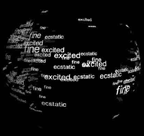
World Emotional Mapping: It is now easy, thanks to any existing search engine running on the Web, to build a semantic map of any concept. Not even trying to understand what is behind a single use of one word, we know now how many times a word is used in correlation with another. For our purpose we track the words in correlation with locations. According to the number of occurrences, the original keyword is located on the map with the appropriate size.
The cartography of the emotions consists on automatically building the map of the emotions over the World. Though, the keyword "stress" is used in association with thousands of city, region and country names in order to get the resulting number of hits form an Internet search engine. This operation is done again and again so that we get a perfect representation of how a word describing an emotion is related, on the English speaking Web, to locations.
The WEM (World Emotional Mapping) is not neither a scientific representation nor an objective portrait of the World emotions but it shows how the digital mass medias monitor the World. One should notice that continents like Africa seem not to have any emotion. In fact, it is only not present on the Web at the right scale according to the actual population. [via information aesthetics]
Posted by jo at 11:57 AM | Comments (0)
February 07, 2006
un_wiki
Democracy or Oligarchy
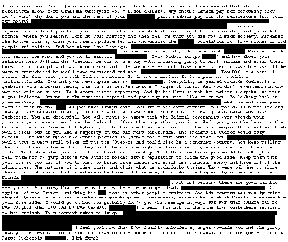
un_wiki, by Wayne Clements, gets quotes from Wikipedia the free encyclopedia’s Deletion Log: http://en.wikipedia.org/w/index.php?title=Special:Log&type=delete. The Deletion Log is a list of all the pages that have abused Wiki's democratic remit; it is the last stop on the way to destruction. It has small amounts of the offending texts. Clements uses a Perl script to get them and throw away the rest.
un_wiki explores the antagonism between formal democracy (anyone may edit a page) and actual oligarchy (sysadmins may delete or revert a page). [via Loreto Martin]
Posted by jo at 08:50 AM | Comments (0)
February 03, 2006
Aurora Live
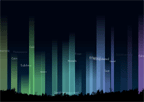
Conjuring the Northern Lights
We invite you to participate in the Aurora Live online project on February 5, 2006; Time: 2:30 pm - 5:30 pm GMT+2 / 7:30 am -10:30 am EST (Time varies by geographic time zone, please confirm your regional start time).
Aurora Live is part of The Aurora Feast Public Art Project, a collaborative exhibition currently featured at Heureka the Finnish Science Centre in Vanta, Finland. Aurora Live is an interactive, real-time, web-based visualization of personal and cross-cultural interpretations of the Northern Lights (Aurora) phenomenon. In a single word, what does Aurora conjure in you? Is it a feeling, a sensation? An image, a vision? A memory, a thought? A place or a dream? Tell us!
On Sunday, February 5, 2005, your one-word descriptions of the northern lights can be submitted globally, on location, and in various languages. Send us your Aurora word via SMS or web-form on the Aurora Feast website. Your interpretive words are passed through our database, onto a web-accessible site. Our interactive program will integrate your singular word contribution and enlighten it within the transformative display of the Aurora Live site.
Send us a little Aurora energy in one word, and we'll infuse it into our Aurora big picture. Please submit your word ON SUNDAY, FEBRUARY 5 via our website or Submit your word via SMS messages to: +358-50-4316621. We hope to hear from you!
The Aurora Live Collaborative Team: Nina Czegledy, Daniel Barber, Seken Chung, Trevor Haldenby, Chris Hession, Deborah Hession, Greg Judelman, Duncan Kushnir, Caitlin O'Donovan
Posted by jo at 09:16 AM | Comments (0)
February 02, 2006
Transmediale 06: Maurice Benayoun
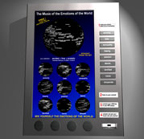
Emotion Vending Machine 2006
Also at Transmediale 06: Maurice Benayoun's Emotion Vending Machine--The mechanics of the world’s emotions evolve in the zone where economics and politics converge, in the world of product placement. Through its concept of artistic merchandizing, the Emotion Vending Machine deals with the production of emotions in an ironic way. The Machine takes Internet data as a global pool of emotions. Users can select up to three emotions from a list of nine emotional states, including hate, desire, or despair. The emotions are represented by 3D-maps of word clusters, extracted from the web and generated in realtime.
These maps show the emotions of the world as they are present on the web at that moment, mapped onto the actual position of major cities on the globe, a mix which can also be read like a music score. The musical interpretation deciphers the cities and their emotional polarity to produce a specific musical result by adapting rhythm, coloration and evolution to the selection of the emotional states made by the user. After listening to the personal result through the integrated speakers, users can plug in their USB stick or MP3 player to load their emotional sound remix.
Music: Jean-Baptiste Barrière; Software: Birgit Lichtenegger, Artem Baguinsky, Marloes de Valk (V2); Production: CITU, Paris.
Posted by jo at 03:32 PM | Comments (0)
System for Multiple Compositions on a Theme
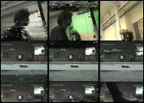
Co-Authors/Users, Separated/Distributed, Across Space/Places
System for Multiple Compositions on a Theme--by Garrett Lynch--is a series of videos shot and edited on analog equipment in 1995 for the sole purpose of experimenting with editing video to create audio compositions. Rather than the norm of composing a video, the image, into a sequence, here the audio was composed and the accompanying image became incidental, secondary. The re-presentation of the video experiments on the internet not alone document and expose them to a wider audience than the original analog cassettes but also serves as a means to progress the early video experiments as a website experiment.
The network provides a means to reconfigure the way the work is viewed by changing the artist's (sole author of the art work) relationship with his audience. The artist, rather than defining a narrative, defines a framework for the art to work within. Experimentation with methods of sending, retrieving and presenting information on the internet, such as the use of html forms and server side scripting allows him to this time construct a system for controlling / viewing the art work rather than an art work that is simply to be viewed. The spectacle of cinema and its audience is replaced by individual user's, separated and distributed across many spaces / places, each as co-author's / contributor's with the artist to their viewing and interpretation of his work.
The composition creation interface on the website, allows users to actively participate in the composition of the experiments and experience an approximation of the act of originally editing these experiments by the artist. It consists of a grid of nine positions, three across and three down, where any position on the grid can be occupied by any of the nine videos any number of times. This gives a possible 2318107019760 combinations, where...
18 + 182 + 183 + 184 + 185 + 186 + 187 + 188 = 2318107019760
Videos can be given a parameter to loop, loop back and forth (palindrome) or not loop. Lag, download speed on the internet, as well as video duration is used as a means to offset how the videos will sound / display within the website creating an overlap that is never quite the same.
Reviewed in neural by Valentina Culatti:
The combines, from Duchamp to Raushenberg, have always been an inspirational form of expression for audio visual digital art. However the word 'composition' has different meanings: it is the combining of distinct parts or elements to form a whole; it is the art or act of composing a musical or literary work; it is also a synonym of short essay. With 'System for Multiple Compositions on a Theme' Garrett Lynch (aka asquare.org) tries to synthesize all these meanings in one project. The artwork is a series of videos shot and edited on analog equipment in 1995 for the sole purpose of experimenting with editing video to create audio compositions. After ten years the shot material has been re-presented on the web using an interface that allow users to take part in the composition choosing among 9x9 options for combining the available clips. Repetition and dislocation, made easy by javascript, are the tools to experiment non linear narration and author-users interaction. However video leads audio on the web. And this is a weak point of the project because keeping an inverted relation would have been an original element in an artwork that, even if inspired by artists like Peter Horvath or Christan Marclay, doesn't have the same innovative value.
Posted by jo at 02:50 PM | Comments (0)
February 01, 2006
Beatriz da Costa
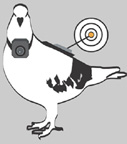
Pigeons that Blog
PigeonBlog--currently being developed by Beatriz da Costa--provides an alternative participatory way to environmental air pollution data gathering. It equips Urban Homing Pigeons with GPS enabled electronic air pollution sensing devices, capable of sending location based air pollution data as well as images to an online Mapping/Blogging Environment in real time....PigeonBlog uses a combination of Siemens’ XT 56 miniature GPS/GSM unit, an electronic automotive CO and NOx sensing unit and the Atmel AVR microprocessor. Detailed tech and datasheet information is forthcoming on this site.
However, in addition to being used for PigeonBlog, Cina Hazegh is currently working on broadening this platform towards a more general Open Source Hardware cell phone project....Pigeons releases will occur once a day throughout the duration of the festival on the ISEA premises. Release location: ClockTower in San Jose. The first release will take place during the opening ceremony of the festival on tuesday evening. Additional “White Dove” releases are planned at strategic high pollutant areas within the San Jose region. Exact locations are to be determined. [blogged by nicolas on pasta and vinegar] Related: Urban Eyes
Posted by jo at 09:29 AM | Comments (0)
January 25, 2006
Oppera Internettikka Bollywooddikka

Retro-Bollywood Code Arias with MP3 Orchestra
Oppera Internettikka Bollywooddikka (low-tech IT e-Bollywood) by Igor Stromajer & Brane Zorman. LIVE internet broadcast from New Delhi. Oppera Internettikka is a series of low-tech internet opera art projects begun in 1998 to explore a combination of classical opera tactics and strategies, together with singing source code, Java scripts and applets. Igor Stromajer will sing HTML (Hyper Text Markup Language) and Java (Java Scripts and Applets) source codes in Retro-Bollywood style, and Brane Zorman Vs BeitThroN will operating an MP3 orchestra live from New Delhi, India.
Location: India International Centre New Delhi, India; Saturday, January 28th, 2006 from 7:15 PM to 8 PM local New Delhi time (Standard Time +05:30 UTC) = from 14:45 to 15:30 Berlin/Paris time. Check exact current local time in India: Advice: please re-check www.intima.org/oppera/oib on January 28th in the morning, for the exact starting time of live broadcast - it may vary due to unexpected circumstances (+/- 1 hour) !!!
It will be performed live in the India International Centre in New Delhi, in the frame of CeC & CaC - The Carnival of e-Creativity & Change-agents Conclave, presented by The Academy of Electronic Arts, and broadcasted live on the internet. CeC - The Carnival of e-Creativity is organized by the producer, curator and director Shankar Barua.
I. Stromajer and B. Zorman will be singing, composing and manipulating HTML source code of the www.bollywood.com website, as it was written on August 15th (2005), Indian Independence Day. # www.bollywood.com is a registered domain of K.C.Varshney.
Produced by Intima Virtual Base - Institute for Contemporary Arts, Slovenia, 2006 - in collaboration with Cona. Special thanks to Bojana Kunst and Irena Pivka.
Project supported by The Ministry of Culture of the Republic of Slovenia.
[] [] []
"Le Pavarotti du HTML" - Le Slovene Stromajer crée des opéras en code web - par Marie Lechner (Le vendredi 2 février 2001, Libération Paris, France).
"But beware: Igor Stromajer is also singing the theory of the Internet!" (Inke Arns; Leonardo Electronic Almanach, Volume 8, N.1, MIT Press 2000).
"It all started in 1999 when Igor Stromajer earned the peculiar nickname, the Pavarotti of the Internet, for singing his Oppera Teorettikka Internettikka, a transcoding of the HTML into song." (Rossitza Daskalova, CIAC Electronic Art Magazine, Montreal, Canada, N.15, August 2002).
[] [] []
In January 1996 Intima Virtual Base created its first net art project, entitled 0.HTML. The project was awarded Third prize at Extension 1997, Hamburger Kunsthalle, Germany (jury: Dr. Uwe M. Schneede, Rainer Wörtmann, Dellbrügge & de Moll, Valie Export, Dr. Dieter Daniels).
Intima Virtual Base 1996-2006: Ten Years of Net Intimacy http://www.intima.org/00110001_00110000
Celebrating ten years of net intimacy, Intima Virtual Base is producing a new internet opera - Oppera Internettikka Bollywooddikka.
http://www.intima.org/oppera/oib
[] [] []
Live Internet Video&Audio Broadcasting:
Oppera Internettikka Bollywooddikka will be broadcast live from New Delhi via internet, using a free MakeTV website service, developed by AI.
Instructions:
1) check the exact current local time in India (January 28th, 2006 at 7:15 PM UTC/GMT +05:30)
2) go to MakeTV
3) accept the terms
4) select Oppera Internettikka Bollywooddikka by the producer "tvintima"
5) watch: enlarge/reduce the video size or go fullscreen
6) archived file will be available immediately after broadcast
Intima Virtual Base
[ the low-tech solution for tactical emotional art ] http://www.intima.org; 3[at]intima[dot]org
t: +386 41 703291
Posted by jo at 09:14 AM | Comments (0)
January 15, 2006
Chironomy
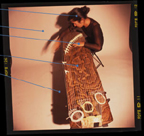
A Wiencouver Internet Performance
Western Front (Vancouver) and Kunstradio ORF (Vienna) present Chironomy: A Wiencouver Internet Performance (a prelude to Art's Birthday). Conceived by Miya Masaoka; Sunday, January 15, 2006 (5 pm Eastern Standard Time; 2 pm Pacific Standard Time; 11 pm Central European Time).
In Vancouver: Miya Masaoka (koto, laser koto, laptop), François Houle,(clarinet, laptop, lectronics), and Giorgio Magnanensi (electronics); In Vienna: Klaus Filip (laptop) and Burkhard Stangl (guitars, electronics). Both video and audio streams can be accessed here.
Chironomy is a project conceived by Miya Masaoka, (koto, laptop, LaserKoto, video) with François Houle (Clarinet, laptop, electronics) and Giorgio Magnanensi (electronics) in Vancouver and Klaus Filip (tube, lloopp software) and Burkhard Stangl (guitars and electronicdevices) in Vienna. This audio and video streaming project uses musicians performing remotely on different continents. Interactivity, improvisation,gestural communication and text are explored within the context of network culture, desire, expectation and alienation. Disembodied sound sources, unpredictable visual and rhythmic time delays, unintended synchronicity and other artifacts of streaming will be exploited.
from Vancouver: Webcam | mp3 Audio Stream http://lists.front.bc.ca/stream.php | from Vienna | mp3 Audio Stream at http://stream.sil.at:7562/listen.pls| Webcam. Concert in the Grande Luxe Western Front, 303 East, 8th Ave, Vancouver - 604-876-9343 Sunday, January 15 - Doors open 1:30 pm - Live stream 2 pm PST (11 pmCET in Vienna) Tickets $10/$5 at the door. FREE for Western Front members.
Miya Masaoka - musician, composer, sound-artist - has created works for Koto, laser interfaces, field recordings, laptop and video and written scores for ensembles, chamber orchestras and mixed choirs. In her pieces she has investigated the sound and movement of insects, as well as the physiological response of plants, the human brain and her own body. Within these varied contexts her performance work investigates the interactive, collaborative aspects of sound, improvisation, nature and society.
Masaoka's work has been presented in Japan, Canada, Europe, Eastern Europe and she has toured to India six times. Venues include V2 in Rotterdam, Cybertheater in Brussels, Elektronisch Festival in Groningen, the Cleveland Performance Art Festival, The Electronik Body Festival in Bratislava, Slovakia, Radio Bremen, Germany, Festival of Lights, Hyberadad, India, and the London Musicians Collective.
Posted by jo at 12:24 PM | Comments (0)
January 12, 2006
1001 nights cast
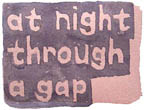
Marina Warner, Performance #206
"I'm honoured and excited to announce that the well-known mythographer and novelist, Marina Warner, has written an enchanting story for tonight's performance #206 of 1001 nights cast. The prompt today is: 'at night through a gap'. Marina has spun a tale within her own tale - a tale heard at night, under a full moon that effects all around her and encourages a traveller to tell of her flight from war in the Middle East.
Marina is based in London, where I first met her in 1995. She has written and lectured extensively on myths and fairytales through titles including Fantastic Metamorphoses, Other Worlds : Ways of Telling the Self (Vintage 2004); From the Beast to the Blonde (Chatto & Windus 1994); Monuments and Maidens (Picador 1987) and in 2003 the introduction to the Folio Society edition of The 1001 Nights..." Barbara Campbell [Related 1, 2]
Posted by jo at 10:04 AM | Comments (0)
January 11, 2006
No Animals Were Hurt

Chain of Communication Reveals Story
No Animals Were Hurt is Peter Brinson's short film about Alan Turing. The more views the film receives, the closer it gets to telling the logician's story. The picture plays too quickly while the sound plays at normal speed, but with each visitor the picture slows. After enough visitors, the sound and picture will play at equal speeds, allowing the story to finish.
Each unique visitor unlocks one frame, out of the total 5000. Currently, after 406 visitors, the film is 9% its proper length. If a computer returns to the site, it may view the movie, but does not unlock an additional frame. This film does contain blank (black) frames. The film can only become longer if you tell a friend. [via Regine on we-make-money-not-art]
Posted by jo at 08:35 AM | Comments (0)
January 09, 2006
The Palace at 4 AM
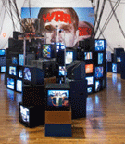
Wartime Voyeurism
New York artist Jon Kessler's recent video installations have focused on contemporary politics, representations of war, and the pleasures and problems of surveillance. His most immersive work to date, The Palace at 4 AM, is a room-sized anthill of flashing monitors, spider webs of cable, and an arsenal of rotating video cameras installed at P.S.1. Contemporary Art Center. The cameras are trained on free-standing images taken from footage of the war and political events. Like Hollywood miniatures, each briefly creates a false reality before the camera jerks away to focus on a different scene. Kessler also perforates the images, allowing flashes of the real gallery to penetrate his virtual war. Through the holes, people watching the monitors catch glimpses of other visitors between the dizzying presentations of politicians and explosions. This produces the giddy paranoia of watching and being watched, but the surveillance doesn't end in Kessler's closed-circuit. Until the show closes on February 6th, two of the cameras are streaming live to the internet. Tune in during P.S.1 gallery hours to watch bewildered visitors explore the installation--while they revel in being watched. - Bill Hanley, Net Art News, Rhizome.
Posted by jo at 10:46 AM | Comments (0)
December 14, 2005
Franck Ancel: Web Connexion
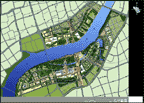
Live Webcast: Lufthansa 727
LIVE WEBCAST on X: - the vision movement in real time from here 2010 / mouvement d'une vision en temps réel d'ici 2010 - December 17, 2005: web connexion from Shanghai to Munich from 18h00 to 19h04 GMT on flight Lufthansa 727 * 2005 TXT 5 PDF on "SPN" http://franck-ancel.com: - SPN from Scenography to Planetary Network / SRP de la Scénographie au Réseau Planétaire. SRP Introduction
SPN for urban screens :-( Amsterdam
SPN to refresh :-) Banff
SPN for e-performance and plug-ins :-| Sydney
SPN to Polieri ;-) Marrakech
*SPN for 2010 :-)) Shanghai
Posted by jo at 10:33 AM | Comments (0)
BOULDER - SCOTTSDALE - SYDNEY - WWW

24 HOUR COUNT: "a blog jam"
The 24 Hour Count is a multi-media blog band made up of Colorado artists Mark Amerika, Rick Silva, and Nathaniel Wojtalik. For this newly commissioned 24-hour online blog performance, the artists will use a variety of media including the Internet, mobile phones, digital video and photo cameras, mini-disk recorders, musical instruments, and many computer software programs to improvisationally remix, interpret, and respond to current events while filtering their "digital readings" through the prism of Count Lautréamont's "Songs of Maldoror," a classic French text written in the 19th century and whom the Surrealists adopted as the progenitor of their significant 20th century movement.
Sponsored by the Scottsdale Museum of Contemporary Art, the Alt-X Online Network, and the TECHNE lab at the University of Colorado at Boulder, the artists performing this distributed multi-media blog performance will be located in three different locations: Sydney, Australia, Boulder, Colorado, and Scottsdale, Arizona.
The event starts December 17th at 14:00 MST/Arizona; 16:00 EST; 21:00 London; 22:00 Berlin; December 18th, 08:00 Sydney.
For 24 hours straight, the three distributed artists will use the same blogging website as the virtual location for their ongoing multi-media jam session. The performance will coincide with the opening of the SOUTHWEST.net:Techno show in Scottsdale, and a living archive of the blog jam site will remain online both in the gallery through May 14, 2006, and on the web throughout the duration of the exhibition and beyond.
Posted by jo at 10:08 AM | Comments (0)
December 08, 2005
Mendi+Keith live audio stream, December 10
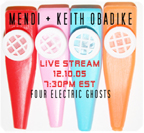
Four Electric Ghosts
Please listen in as Mendi+Keith Obadike present songs and stories from their new work Four Electric Ghosts, created in collaboration with students in the Princeton Atelier. Inspired by Amos Tutuola’s 1954 novel My Life in the Bush of Ghosts and Pac-Man (the videogame created by Toru Iwatani in 1980), Four Electric Ghosts considers the question, "What does it mean to be invaded by an innocent?" The performance will be streamed live from Princeton University on Saturday, December 10th at 7:30pm. You can catch the stream here.
Conceived and directed by Toni Morrison, the Princeton Atelier convenes guest artists to collaborate with students in creating new works performed or exhibited on campus.
Mendi+Keith Obadike are interdisciplinary artists whose music, live art, and conceptual Internet artworks have been exhibited internationally.Their album The Sour Thunder was released on Bridge Records. Their writing and art projects have been featured in the film Take These Chains, in periodicals (including Art Journal, Artthrob, Meridians, Black Arts Quarterly, and Tema Celeste), and in the anthology Sound Unbound:Sampling Digital Arts and Culture (MIT Press, edited by Paul D. Miller). Their work generated much discussion online and offline when they offered Keith's blackness for sale on eBay in 2001. In 2002 Mendi+Keith premiered their Internet opera The Sour Thunder which was the first new media work commissioned by the Yale Cabaret and they launched The Interaction of Coloreds (commissioned by the Whitney Museum of American Art). In 2003 Keith was sound designer and composer for Anna Deavere Smith’s play Twilight: Los Angeles 1992 at the Lincoln Center Institute, and Mendi's poetry was featured at the Studio Museum in Harlem in response to an exhibition of visual artist Gary Simmons’ work. Also in 2003 they launched The Pink of Stealth, an Internet/ DVD surround sound work commissioned by the New York African Film Festival and Electronic Arts Intermix and The Sour Thunder was broadcast internationally from 104.1 fm in Berlin. Their upcoming projects include a new installation and album entitled TaRonda Who Wore White Gloves supported by a Rockefeller Media Arts Fellowship and an Internet opera entitled Four Electric Ghosts, for Toni Morrison’s Atelier at Princeton University in 2005. Most recently, Keith was awarded a Connecticut Critics’ Circle Award for his sound design work at the Yale Repertory Theater and Mendi's new book Armor and Flesh (Lotus Press) won the Naomi Long Madgett Poetry Award. Keith received a BA in Art from North Carolina Central University and an MFA in Sound Design from Yale University. Mendi received a BA in English from Spelman College and a PhD in Literature from Duke University.
Posted by jo at 04:31 PM | Comments (0)
December 05, 2005
Baby Love

Drive Me Drive Me Crazy
Baby Love situates human and its baby clones in a perpetual spin of fairground teacup ride. Tea and sympathy, love and ME-motion. Love songs, uploaded by the public and transmitted via 802.11 wireless network by the public are coded as ME-data in the cloned locker babies. Revolt against mirrored self, the clone babies reprocess the networked ME-data during the joy teacup ride. By taking a teacup ride with the babies, the ME-data are retrieved, played back, shuffled, and jumbled. A gentle ride turned fast spin, the data jams and jammed, we are left to sort out the ME with the babies in the storming teacups. The crash would eventually happen. Upon the carsh when the teacups bump into each other, the clone babies exchange ME data and broadcast the remix on the web. Shu Lea Cheang's installation is at the Palais de Tokyo in Paris from Dec. 8 through January 8, 2006.
Project Background: The Locker Baby project, first conceived in 2001, consists of 3 installation plans : baby play, baby love, and baby work. The first installment, baby play, was commissioned and exhibited at NTT[ICC]( InterCommunication Center ), in Tokyo in 2001. The Locker Baby project recalls Ryu MurakamI's noted novel Coin Locker Babies (1980) in which two boys abandoned at birth in one square foot metal boxes grew up haunted with the sound of human heart beats, those of their birth mothers. The updated version of locker baby proposes a fictional scenario set in year 2030. The DPT (DollyPolly Transgency) clones locker babies with genes extracted from deep sea pearls harvested off Okinawa Island . Coin lockers situated in busy Tokyo train stations are the breeding grounds for underworld test tube locker babies. The biobot locker babies are the clone generation of our scifi fantasia reality, entrusted to receive, store, transmit and negotiate human memory and emotion. Locker baby holds the key to unlock a networked inter-sphere of ME (Memory-Emotion ) data. [via Regine on we-make-money-not-art]
Posted by jo at 01:16 PM | Comments (0)
The Project for Urban Intimacy
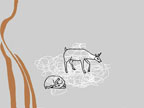
Transgressing Rationality and Efficiency
The Project for Urban Intimacy--by Krista Connerly--offers projects that transgress and counter the rationality and efficiency that infect our cities. Many of these projects seek to alter your daily encounters: moving them past the brief, efficient, and cordial towards the poetic, delayed, or absurd.
The Urban Parlour Games are a set of updated Victorian parlour games. Like the original games they are based off of (and for the most part - carry the same name as) they encourage more intimate forms of interaction. From the Urban Games website you are able to download materials that will let you take these games "to the streets".
Transitory Contact is a collective representation of the intercourse and exchange that takes place, often unnoticed, as we travel innocently to and from work. This piece uses the internet to gather and distribute these stories of contact in order to create a growing collective map. On the website, the user scrolls over a different city area bus maps to read about the encounters that took place along the corresponding bus lines. Additionally, the user is encouraged to deposit their own accounts on the web site so that they can become part of this collective document. The end result is the creation of a secret social map that can be laid over our everyday physical one.
Sleep is a viewer built performance using one's self and a sleeping computer. Your computer accompanies you as you drift off to sleep. Its noises intermix with yours, lulling you and sending transmissions to you.
Solfataras is an on-line collaborative play. Scenes are proposed through photos, a printed manual, and user input to a website. Participants may go online to view instructions and meeting times and places left by myself or other participants. Likewise, there is an on-line forum for individuals to create their own scenes. These can be acted out independently or be extended as invitations to myself and others. [blogged on stunned]
Posted by jo at 01:01 PM | Comments (0)
November 17, 2005
WJ-s Web Performances Tonight
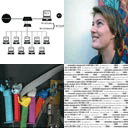
Agnès de Cayeux, Anne Laforet & KRN
Centre Pompidou, Paris, Les Plasticiens du Web, Thursday, November 17th 2005; Salle de cinema 2 / 7pm / 3 euros / Metro Rambuteau.
WJ-s is a software and a flexible, high speed connexion public device for web performances which allows actors of the Internet--sound and image artists, netartists, bloggers, graphic designers, flashers, programmers, curators, hacktivists, newmedia theorists, pioneers and web mutants--to play live with the full scope of contents available in the wideness of the Web.
Agnès de Cayeux, Anne Laforet & KRN endlessly explore and experiment with the changing and fluctuating territories of the Internet. They subjectively articulate its intimate contours and zones. With "WJs", the artists play with the erotic and heated atmosphere of video chat rooms, with the world of artistic algorithms and computer art, and with an exacting choice of plastic, sensitive, aesthetic and narrative works in the realm of webart.
Agnès de Cayeux, network artist, conception and programming of network interfaces and tools. Research on distance relations and network interactions.
Anne Laforet is a specialist of net art, particularly on preservation, researcher, co-organizer of conferences and public discussions, soundartist.
KRN, network artist, curator, moderator, artistic and cultural event organiser, researcher into the relations between interactivity and desire, art and technology. Technical expertise: development of web sites and interfaces.
WJ-s/ystem : the whole technical device
WJ-s/oftware : the software part of WJ-s/ystem
WJ-s/erver : the device server
WJ-s/tudio : the computer used as a webdeck to control the WJ-s/tations
WJ-s/pring : a network of laptops that controls the WJ-s/tations during the performance
WJ-s/tation : one of the WJ-s/pring laptops (polymedia capture and diffusion)
WJ-s/pace : the venue in which the device is hosted
WJ-s/et : a WJ-s performance
WJ-s/ession : a series of WJ-s/ets
WJs project author, production: Anne Roquigny
Software programming: Stephane Kyles
Technics: Olivier Bernon
Realisation: Marc Bellini
Thanks: Christophe Becker, Thierry Bernard, Nadine Bonnefoi, Ferdinand Corte, Stephane Degoutin, Emilie Fouilloux, Anne Gagnebien, iddem.com, Emmanuel Jamin, Christophe Leclerqc, Sandrine Maricot, Denis Santelli, Sigolene Valax. Partner: ars longa
CONTACT / INFOS anne roquigny ar (at) wj-s.org
Posted by jo at 11:43 AM | Comments (0)
November 10, 2005
Transmute Collective
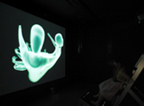
Intimate Transactions Between London and Greece
The Transmute Collective (Keith Armstrong (Dir.), Lisa O'Neill and Guy Webster) and their collaborators announce that Intimate Transactions (a networked interactive artwork) will be next shown simultaneously between the Institute of Contemporary Art, The Mall, London & BIOS (New Synthesis of Urban Culture), Athens, Greece. Date: 12 Nov - Wed 23 Nov 2005; 12 - 8pm UK GMT.
Intimate Transactions is an exciting new form of interactive installation that allows two people in separate spaces to interact simultaneously using their bodies. Each participant uses a physical interface called a Bodyshelf. By gently moving their bodies on this smart furniture they instigate Intimate Transactions, which influence an evolving world created from digital imagery, multichannel sound and tactile feedback.
Intimate Transactions was awarded an Honourable Mention in this year's Prix Ars Electronica in the Interactive Arts Category. Transmute pay tribute to all of the artists, staff and partners involved in making this project possible over the past four years.
Look out for the forthcoming ACID book/dvd, edited by jillian Hamilton: Intimate Transactions: Art, Interaction and Exhibition within Distributed Network Environments. For more details email ITBook[at]embodiedmedia.com
We particularly thank our major partners for this showing: The Australasian CRC For Interaction Design, Arts Queensland, The Institute For contemporary Art, BIOS and the Australia Council New Media Arts Board. Keith and Guy will attend this event courtesy of Arts Queensland, the ICA and BIOS.
This project has been assisted by the Australasian CRC For Interaction Design (ACID), the Australian Government through the Australia Council, its arts funding and advisory body & the Queensland Government through Arts Queensland. Intimate Transactions was developed with support from the Performance Space Headpsace Residency Program.
Posted by jo at 09:06 AM | Comments (0)
November 08, 2005
Bump
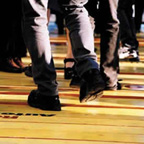
association.creation
Bump--In the project "bump", two wooden bridges in two different cities form the meeting point for large public events. When someone steps on one of these bridges, this person's weight triggers an impulse that is transmitted through a data transmission cable to the wooden bridge in the other city, thus moving the corresponding plank by a few centimeters.
A tactile interface versus the disembodiedness of network worlds.
Two bridges in public space; the inhabitants of one space cannot see the others, but they can sense them and make contact with them. The deformation of space becomes the interface. The interface is called "bump", is ready for the masses to come. Every pressure exerted causes resistance that comes through on the other side. There is a knock from underneath, the slats rise, power transmission via network - "sensations on the move".
"If you move along a city's compact walls, when you least expect it, you see a open and a different city appears. Then, an instant later, it has already vanished. Perhaps everything lies in knowing what words to speak, what actions to perform, and in what order and rhythm." (Italo Calvino)
"bump" creates a in the urban interface, a place where there is no more solid ground under your feet.
A in the urban surface.
"Now there is knocking from below and the boards rise up. Below is another city, reflecting the same irregularity, linked via data transmission line. What is going on there? Undifferentiated mass movements, a stampede of hundreds of feet at rush hour? What about late at night: two or three pairs of feet. A perceptible rhythm. Perhaps a message? Or just a game? We sense the illusion of proximity: directly below the board which raises up, we presume a force which approximates our own.
But there is only the apparatus, the pneumatic piston, the control valve, the sensor. Closeness is only an illusion; the distance is not abolished. The thin pine board is a wall hundreds of kilometers thick. A casual encounter turns into a lasting irritation of the sense of direction: west is below, below is east. How close can we get together?" (Christian Kühn)
A catwalk - 1.5 by 20 meters - is installed in the public space of each city. If a person steps onto this catwalk their weight triggers an impulse which is transferred to the other city by means of a data-line. There a pneumatic piston raises the corresponding board by a few centimeters. At the same time, the principle of the effect can be grasped through a video conference transmission - and visual contact can be made with the "other side."
How close do we wanna get today?
The free-standing bridge on the street refers to something absent: approaching one another, mutually sensing, sensuously experiencing one another. The Internet has brought us all closer together, yet with all our fascination with incorporeal, virtual space, we must not forget the quality of what is missing when we go into the Internet. The world has become larger for "bump" users. Sensing as an elemental experience gives us a feeling for distance and closeness. Collective experience is the prerequisite for common impressions and imprints in a game with an anonymous opposite. Interaction becomes communication.
Sensations on the move
"The spacelessness and the disembodiedness of the virtual world returns to the sensuous, tactile world, which means that crossing the border of an 'abstract' medium creates a new actionist reality that would be unimaginable in a reality without a virtual opposite. This enables an intensification of the perception that was previously mourned as loss. Perhaps a new medium is born with this virtu - reality? "bump" affords the 'virtual world' a new field of action and the sensuous perception of impulses from previously unimaginable networks." (Friedrich Achleitner)
An intelligent urban fixture, accessible
"The telematic arrangement of "bump" is prototypical for intelligent urban fixtures: beyond the specifically local experience in two cities, the interaction and communication of the people in both places through the telematic furnishing are the prerequisite for experiencing telematic simultaneity." (Gerfried Stocker)
The telematic bridge is imprinted with logos from companies that enable Internet communication. "bump" as an image and a part of the commercialized world in which we live, and which we cannot elude. "bump" as a furnishing of a city that you traverse. "bump" has proven itself as a transparent and functional medium. The many people who have enthusiastically stepped on it call it a sensation that awakens associations and creates connections.
bump: to hit or collide with a jolt, ~ into: fig. to meet someone unexpectedly; swelling, lump, bulge; ~ of locality: sense of direction
1998 BUMP: Opening of the Ars Electronica 99 by the mayors of Linz and Budapest on the bridge
ESTABLISHED in 1997 by: Christian Smretschnig, Michael Bieglmayer, Roland Graf, Werner Schmid.
Technical directors: Christian Troger, Elmar Trojer.
From Ars Electronica website.
Posted by jo at 08:20 AM | Comments (0)
November 04, 2005
The Air Around
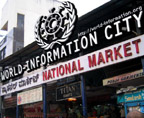
Invitation to Air Your Voice
Rajivan.Ayyappan invites you to contribute to his sound installation--The Air Around--from your geographical location.
"The Air Around is a radio/telephonic installation. It's made of an FM network that receives sounds through telephones—mobile, landline or internet phones—from around the world and integrates them into a soundscape. The installation has a central computer with a list of participants and their phone numbers. It would dial a number, remain open to engage the participant, hang up after a period of time, start another number and so on. These interactions would be transmitted to the The Air Around installation site.
The central theme of The Air Around is this: Access a whole lot of people who are in different locations and time zones through the internet and integrate them, live, into the new context of a synthesized soundscape installation. Our plan is to have a list where as many people are ready to take the call.
Therefore I want you to be in The Air Around's list to receive a call from the installation. What I would like to have from you is a 30 sec to 3 or 4 minutes of sound event that are voiced, played back or performed online by you. There are no rules for what you must do. Strictly no rules. You can just pick up the phone, identify your number or name and behave as if you have a microphone in hand. Your interaction with the call will be one of the sound events in the installation. It will be transmitted at The Air Around site.
The Air Around installation will be active for 3 days, 3:00pm to 6:00pm (India. Standard time zone: UTC/GMT +5:30 hours) starting 14th November and ending on 16th November 2005.
If you are keen tell us the dates & times when it would be possible to call you. The call will be made from the installation, to your land line or mobile. You will not be charged with any phone call rates. It will be paid by The Air Around project. Please mail me for clarifications and planning. I could send you more details regarding the procedure. Love to hear from you." Rajivan.Ayyappan rajivansa[at]hotmail.com
The installation is a part of World-Information City conference, organised by Waag Society (Amsterdam), Institute for New Culture Technologies (Vienna), Sarai CSDS (Delhi), Mahiti and Alternative Law Forum (Bangalore). [Related]
Posted by jo at 10:27 AM | Comments (0)
October 31, 2005
MobLab
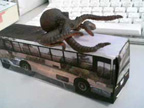
Origami Bus Pattern
For the MobLab [Related] bus adventure (a bus-gallery with on board artists-Mobnauts who challenge conceptions of public space), Kensuke Sembo and Yae Akaiwa from exonemo are filming sceneries from the window of the traveling bus. The Road Movie is made available for visitors to download from the internet.
Downloaded frames from the Web cam, which change every three to five minutes on the Web site, are complete with dotted lines for cutting and folding, and can be printed out and transformed into a paper sculpture of the Moblab bus with windows showing the captured images.
It's a way of bringing public space into private homes and computer cubicles, says Sembo. "We think using paper craft in this way is a sign of other space invading your own space."
Part of the MobLab project, touring Japan, Tuesday 18 October - Sunday 6 November. There's a report on what's going on at MobLab in Asahi and on the MobLab blog. Image. Also by exonemo: Shikakunomukou. [blogged by Regine on we-make-money-not]
Posted by jo at 12:23 PM | Comments (0)
Free Soil's F.R.U.I.T.
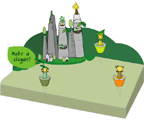
Exploring your City and its Connection to the World via Fruit!
Join an online demonstration. Your words will be part of a two year traveling exhibition. Remember to fill out the survey and add your urban plan dreams!! F.R.U.I.T. takes up the challenge of elevating the ecological knowledge of consumers and encouraging a way of life that is friendly to the environment. We want consumers to be conscious of the entire life of a product, from production to utilization, and not just what they see in the stores. Consumers must be aware that every phase of a product's life influences the environment and ourselves.
Free Soil has produced a run of F.R.U.I.T wrappers, a website, and a traveling installation as part of an initiative to inform people about alternative food systems and local food movements. The wrappers are disseminated throughout the food chain by piggybacking on oranges. Information will be carried through the food system and into the hands of consumers. The wrapper holds information on a variety of aspects concerning food movements, transport and urban farming. Get your daily dose!
Posted by jo at 09:50 AM | Comments (0)
October 28, 2005
SPECFLIC 1.0

Sousveillance Grid + Community Built Display
The Community Built Display enables a group of people with wireless laptops to create a modular, flat-panel, dynamically reconfigurable large-format display. For SPECFLIC, The Outsider Jeremiad will serve as a ringleader of a group of audience members who want to send high-impact visual messages to those on the Inside. Developer: Robert Twomey, UCSD MFA Candidate, Visual Arts; Advisor: Natalie Jeremijenko, Visual Arts Dept., Xdesign Studio.
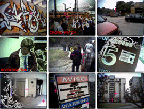
The Sousveillance Grid is a net-based interactive display which processes user-submitted camera phone images and displays them in a grid in a random fashion. Projected to the public SPECFLIC audience, it encourages bystanders to assist in documenting their surroundings with the efficiency and depth that only a populace armed with many, many cameraphones can provide. The display was created with PHP and JavaScript and can be viewed on any web browser. A proliferation of digital recording devices are leading us to a place where privacy will evaporate without any parallel efforts from the State — a community armed with compact, wirelessly-connected recording devices will record and police itself far better than any government could have hoped to. Developer: Andrew Collins, UCSD alum, ICAM’05, Calit2 Undergrad Fellow; Advisor: Adriene Jenik [Related 1, 2]
Posted by jo at 10:01 AM | Comments (0)
October 27, 2005
UpStage! This Week
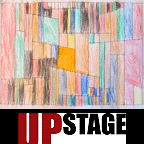
JeanRichard + Open Session
It's a busy week this week in UpStage: on Saturday 29 October we have a live public performance by JeanRichard; and on Wednesday 2 November we have the regular Open Session and walk-through.
LIFE2 performance by JeanRichard: This is the first public performance to be staged in UpStage by a group other than Avatar Body Collision (the creators of UpStage). JeanRichard is a Swiss family of artists who began using UpStage a few months ago, and they love it so much they've already reached the point where they are ready to give their first public performance. [Related]
To join the performance, you don't need to be logged in; just go to http://jeanrichard.ch/Life2/ where there will be a live link to the stage from one hour before the performance time. And the performance time is: 1am California; 4am New York; 9am UK; 10am Switzerland; 11am Finland; 6pm Australia (NSW/Queensland); 9pm New Zealand. See http://www.worldtimeserver.com/ for other local times.
UpStage Open Walk-Through: This session takes place on the first Wednesday of the month and is an opportunity for newcomers to learn about UpStage and for regulars to have an open jam session. To register for the session and request a log-in, email me (helen[at]creative-catalyst.com) - even if you're a regular, please let us know that you're coming.
As usual, we'll begin on the Introduction stage, http://upstage.org.nz:8081/stages/presentation. Depending on numbers, some may go to another stage for improv while newbies learn the basics on the Introduction stage. Those of you who are logging in will do so from http://upstage.org.nz:8081
The times this month are: 1am California; 4am New York; 9am UK; 10am Netherlands; 11am Finland; 7pm Queensland Australia; 8pm NSW Australia; 10pm NZ
See http://www.worldtimeserver.com/ for other local times; please note that European clocks have changed between these two events - if you are in any doubt over the correct time, find your local corresponding time for the Swiss time of 10am for the JeanRichard performance on 29 October, and for the New Zealand time of 10pm for the open session on 2 November.
Posted by jo at 01:33 PM | Comments (0)
WebJam 09
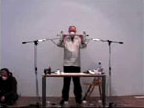
decentred | distributed improvisation
WebJam 09: Saturday 29th October, 8-11pm, Norwich Gallery, UK, FREE ENTRY. Live Webcast Online from 7.30 p.m. (performance starts at 8:00 p.m.). Connect at http://www.n0media.net. Live Sound/ Visual Performances featuring Phil Archer, Andre Bosman, Laura Cannell, Shigeto Wada, Tonesucker, Hermits' Squeal, BabyGrand, Hoofus, Dan Tombs, Tom Simmons, and Liam Wells.
Webcasts require QuickTime Player (version 6+): Download QuickTime Player for free. Directions/Gallery info at http://norwichgallery.co.uk
Posted by jo at 11:17 AM | Comments (0)
October 20, 2005
Franck Ancel

From Scenography to Planetary Network
From Scenography to Planetary Network [SPN]: an entity of creations, publications, conferences, installations and performances presented by Franck Ancel, in question over contemporary time: the last creation of 2005, in real time via wireless web, via satellite, at an altitude of 30000 feet, more than 900 kilometers per hour, to Tokyo or Shanghai, in the year celebrating France in China and the exhibition of Aichi in Japan.
In the continuation of his triptych AIT in France "Architecture - Image - Technology", these communications prepare for further rendez-vous. Ancel now inhabits the planetary space of technology to fall into and under the reality of the imaginary; a World Fair or a World Tour... like the Solarimpulse plane or like the city of Shanghai between the now and 2010.
Running the planet!: Europa - Amsterdam 09.24.05; America - Banff 09.30.05; Africa - coming soon; Oceania - Sydney 12.02.05; Asia - to Tokyo or Shanghai - End of 2005.
Scenography to Planetary Network for Urban Screens
"If the modern extension of cities is being transformed into urban territory due to the impetus of science-technology, then the classic places of artistic performance remain essentially victims of these changes without really being able to incorporate them.
These new technologies are responsible for the emergence of a “City of Bits”. This “City of Bits” that was analysed as “Space, Place, and the Infobahn” only ten years ago by the researcher William J. Mitchell of MIT in his work of the same name. This was the period of the democratisation of the internet, followed by the appearance of VRML, a time in which some believed that this cyberspace was another world, a new continent, or even, for others, a utopia. Its rise was signalled by the use of a global language, the invention of HTML by a scientist from CERN in Switzerland, which allowed us to move from one computer screen to another without any knowledge of the Internet code.
Thus our project “Being = Network” makes its mark in a city by symbolically confronting the arrival of what the internet scholar Howard Rheingold calls the “smart mobs”. I will rapidly summarize this, like the arrival of the third-generation telephone in Europe. It is this journey between the present and the virtual that I am referring to here all too briefly, that determines the time and reasons for my project, at first glance a simple confrontation of art with architecture, at the moment of the emergence of digital screens in the city.
This “Being = Network” action is not an anticipatory step, but rather a phenomenon which closes without being an end in itself the installation of our AIT triptych in France during the past three years, focusing on Architecture, Image, and Technology. A multiple creation which is not linked to the types of city projection of a Rafael Lozano-Hemmer, a Krzysztof Wodiczko, or a Dan Graham.
Without being a designer, artist, or computer scientist, I do not wish to give a too highly specialized talk, in this city of Amsterdam, birthplace of Constant, founder of the Situationist Movement. However, I am convinced that the visual arts now come from places intended to show them in order to deal with life, and vice versa. This is what propels our search outside of art, architecture, and visual arts. The closest concept is a display to be found at the Scenography to Planetary Network.
Let us call to mind the definition of modern scenography given by its founder Jacques Polieri: “all the pictorial, plastic, technical, and theoretical elements that allow the creation of an image, of a bi- or tri-dimensional set piece, or the installation of an action that is spectacular.” Let us now present the context of this “Being = Network” project that is so decisive in our process. This project of the projection on a screen took place in the centre of Paris in a square, which is situated in a locality that has many cinemas, as well as a stream of people via the metro or the train punctuating the streets.
At the middle, the Montparnasse Tower, a hundred metres from the Gare Montparnasse, at the heart of the city, signals its luminous presence in Paris by night and day. Built at the beginning of the 1970s by the architect Roger Saubot, it imposes by its height of more than 200 metres. There are over fifty floors of offices, each of more than 2000 square metres, with a panoramic restaurant for tourists. This is a Montparnasse that has nothing more in common with the international artistic bohemian life of the 1930s, with its artists’ studios and bars.
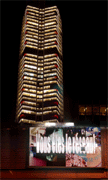
(1) Van Wagner, a world-leading communications company recently installed in France, was one of the first businesses to use large advertising spaces, with still projection, in New York during the 1970s. It now owns the screen at the bottom of the Montparnasse Tower, the only one of its kind in France. But it also has the other two screens in the world, one in London and the other in Los Angeles. This LED screen has a surface area of 38 square metres. Obviously, its location in the French capital, at the crossroads of many different types of networks, is what motivated us to spend more than six months negotiating a partnership with the Van Wagner company, with the aim of completing the project free of charge with their technical support.
Several contacts were naturally made with other businesses linked to the networks, such as RATP, the company that manages the Parisian metro system. This was in the hope of using live images from their CCTV cameras for our screen display. Also, with mobile phone companies, because I propose the appearance of cyber-traceability of mobile telephone chips thanks to software monitoring all movement within the city through cartographic superimposition.
This leads to the possibility for everyone to send live photographic and video captures from a mobile phone using MMS onto each window of the screen display. But none of this contact with these companies led to any results, either positive or negative, though the dialogue remains open for other projects. For the moment, I am not directly dealing with questions about the danger of the mobile phone waves for humans, nor about civil liberties’ with regard to CCTV.
Finally Van Wagner did not allow us to use the screen in real time. We did not therefore have access to the MP4 server broadcasting to the screen and potentially via the network to the two other screens, as I would have liked, to produce a live triptych between Paris-London-Los Angeles. In the end, the entire financing of the project came from a private source, as cultural institutions did not help this scheme.
Unlike the first two parts of the triptych, we were not consequently able to use the software in real time; we use MAX/MSP and JITTER. I came up with a global slogan which would be relevant for this specific context. A proposition of a highly prized poetic “hot spot” within the city which only contained the three words “Mobile Wireless Digital” invoked more than interactivity. The monumental projection at the bottom of the tower lasted for thirty seconds, inserted between other advertising clips, several times a minute for several weeks, until the end of December of last year.
Some video captures were selected from the first triptych projects, three for the Convent project built by Le Courbusier and Xenakis, and three from the Franco-Spanish border. These form windows whose size also has meaning. Each window of these short videos is similar to the typical holiday video captured by a mobile phone. The projection is thus made up of a video-wall corresponding to the windows of the front face of the tower. The video clips are thirty seconds in length, corresponding to the length of the advertising clips; but this is also the maximum time for sending this same video via a mobile phone file format, such as the 3GP, via MMS from one phone to another phone.
Here, whether it is appearing on my own mobile phone as a small image, or on the tower as a large one, there is a fictional connection. Without an audience, since no sign, other than newspapers and radio reporting this action, tells us that we are in front of a work and not of prospective products and/or services. If we were in Asia, the formats would be different but our comments would stay the same.
There are different technical supports depending on the continents. The history of media arts has a more universal history, founded on a re-reading and not only a French philosophical reading, with Deleuze, Virilio, or Baudrillard about the arrival of technology. Moreover, I will speak about these issues next week in Canada in a paper entitled “from Scenography to Planetary Network for refresh 01”, which is also the name of the gathering.
There is also a historical filiation for “Being = Network” with a scenography by Jacques Polieri. From the end of the Second World War, Polieri carried out research on historical avant-garde moments in the visual arts, namely those of exactly eighty years ago this year: the Bauhaus with Schlemmer, Gropius, Moholy-Nagy, Molnar, Weininger, the Paris international exhibition with Kiesler and Prampolini, etc. Polieri never stopped from going into and then beyond projects that were too limited by available resources.
Let us think, for example, of his synopsis using exterior screens at the 1972 Munich Olympic Games. Polieri tries to interconnect between them on a micro-scale: “Electronic images were installed from one end to the other of a “Leisure Street”, in the form of either colour VDUs (all along the street) of projections onto large screens permitting the public to dialogue or to participate in the various games. The five main screens were at the end of the street, together with the video control room situated inside a geodesic dome. Preparatory show.” The electronic gave it telepresence dimensions.
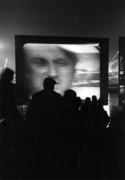
(2) In the meetings that I propose such as “Being = Network”, there can not be an area and a centre which will gain the upper hand, and the same goes for a discipline over a technique. Nor does the image in action simply constitute a performance. It embodies data which can be sound, gestures, an archive, a camera, infinite sources, thanks to digitization: a visualization whose screen is momentarily a performing technical support.
Also, the very existence of this screen in the Parisian space can not be the only grounds for our use of it. It is the context which is virtually projected. It would have been much simpler in a more formal dimension to project somewhere else with total freedom. But I do not want to move the white cube from the gallery, to open a new programme to an audience of contemporary artists, like at the crossroads of Time Square in New York at the beginning of the 1990s.
I am thinking more of an incarnation which, from now on, must no longer just remain within the context reserved for a projection, for it’s not just a projection, but rather of digital data, of finding future areas, like space that is now temporal, for the live broadcasting and recording of our lives. In this way, architecture is no longer the interface for a surface image for our projects, but is valid within a context of watching over emerging issues.
Like the support screens, the urban economy is not the framework of our practice. I am simply looking to determine and be part of the changes that are happening. Using an art without artistic limits, I am not engaging in experimentation but rather in a new way forward, one of widespread interconnection in daily life. So, for each of my designs, a desire to exchange with the professional best is a necessity.
This starts with choosing the site according to the project’s needs as much the same way as its technological items, which is not directly linked to the design or programming. Similarly, the media are no longer mailboxes with images to be re-conceived and re-designed, but are prostheses that are now integrated into our activity and lives.
For example, in our “Global Poetic System” project, which was part of a marathon, we diverted the sporting use of technology towards a digital visual and sound dimension, reconstructable using physical data. I will bring up this necessary conception of new interfaces for these emerging practices in the beginning of December, in a lecture entitled “from Scenography to Network Planetary for e-performance and plug-ins” at the School of Media, Film & Theatre, University of New South Wales, Australia.
To close this “Being = Network”, I would like to share the following anecdote from Bruce Sterling and Richard Kadrey, which is taken from “Dead Media Manifesto”, and which may be found on the Amsterdam internet site “De Balie”. They report the words of Jacqueline Goddarda, a surrealist bohemian figure of 1930s Paris:
“After a day of work, the artists wanted to get away from their studios, and get away from what they were creating. They all met in cafes to argue about this and that, to discuss their work, politics and philosophy… We went to the bar of La Coupole. Bob, the barman, was a terribly nice chap… As there was no telephone in those days everybody used to leave him messages. At the Dome we also had a little place behind the door for messages. The telephone was the death of Montparnasse.”
Our project for third-generation telephones is not necessarily the rebirth of Montparnasse. “You are not the network!” if the projection on the urban screen is your only interrogation. “I am the network!” if you redefine everything with new technology - not only as an urban accessory, but also in the universality of human beings in their future mobile interconnection with the world. While I wait, I am seeking new sensitive places like the Montparnasse Tower in Paris in order to transcribe a new temporality which is now becoming a planetary one." Franck Ancel
(1) Illustration no. 1 “Being = Network”, Paris Montparnasse Tower, photo by Simon Procter, 2004.
(2) Illustration no. 2 “Leisure Street”, Munich Olympic Games, 1972, pp. 42/44/45 “Polieri creator of modern scenography”, Bibliothèque nationale de France, Paris, 2002.
"SPN for urbanscreens05" in Europa and "SPN for refresh!01" in America, these english presentations are now online pdf.
Biography: Born in 1970, France, Franck Ancel works in Paris. He has been probing technology for more than fifteen years. He has traced the development from the avant-gardes artists of the last century to the recent mutations of creation on a planetary scale.He has thus organized and coordinated symposiums, expositions, and performances in cooperation with associations and institutions. The last one was a retrospective on Jacques Polieri, the creator of ”modern scenography,” at the BnF. Since the attacks of 9/11, Franck Ancel has set up an interactive triptych probing “architecture – image – technology” on 20th century heritage sites. In 2002, he put it in the Le Corbusier/Xenakis convent; in 2003 in a classified theater in Catalogne; and in 2004 on the screen of Montparnasse Tower in Paris. Franck Ancel challenges the viewer outside traditional frontiers, by projecting a setting of a network of information on screens. At the same time, he analyzes this technique on a more theoretical level in texts and talk.
Posted by jo at 12:19 PM | Comments (0)
Furthernoise.org + VisitorsStudio
![]()
Live A/V Net Performances
Furthernoise.org presents the 2nd in it's series of live A/V net performances Featuring 2TOMS (France) & John Kannenberg (USA); Sunday 23rd October 2005 16.00-18.00 GMT [Time Zone Converter]: Where: Online; and broadcasting live into the Stills Gallery, where the VisitorsStudio is projected live for 2 months to visiting audiences--23 Cockburns St, Edinburgh, Scotland. Also broadcasting live at the theatre of The Point CDC 11.00 - 13.00 EST--940 Garrison Avenue, Bronx, New York.
Furthernoise.org is hosting a series of monthly live A/V net events and is interested to hear from all audio and visual artists who feel that they could create interesting A/V performances in VisitorsStudio. VisitorsStudio is a live multi-user playground, an audio-visual space for artists and musicians to experiment, jam and perform with a real time, online audience. Please contact roger[at]furthernoise.org for more information.
VISITORSSTUDIO AT STILLS GALLERY, EDINBURGH
VisitorsStudio is currently featured as part of Ricochet, an exhibition at Stills Gallery, Edinburgh 16th October - 18th December 2005. Also including work by Henna Nadeem, Leena Nammari, Chris Dooks, Pamela So.
VisitorsStudio Workshop: Ruth Catlow recently worked with artist Henna Nadeem and young girls (8-13) of Saheliya project at the Stills Gallery, Edinburgh. Marc Garrett joined the sessions working remotely, online from london playing & mixing the live sounds as they uploaded & mixed their own imagery as part of the Stills Ricochet exhibition.
Posted by jo at 11:15 AM | Comments (0)
October 17, 2005
LIFE2[at]SPACE
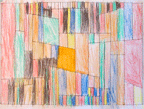
JeanRichard-family, life, art
LIFE2[at]SPACE is a live performance by Family JeanRichard, taking place in UpStage on Saturday 29 October at 10am MEZ. It will feature 3 works of JeanRichard; 4 avatars; 5 props. Check your local time at http://www.worldtimeserver.com. One hour before the performance starts, there will be a live link to the stage from http://jeanrichard.ch/life2.
JeanRichard work as family and show their processes and products on their weblog. The weblog represents the art project itself, but serves also as a gallery where posts are sold online, and we are up to build up a kind of museum (other artists/curators etc show works that are related to JeanRichard). See Baby Blogging.
Posted by jo at 08:43 AM | Comments (0)
October 10, 2005
The Power of the Mind 2
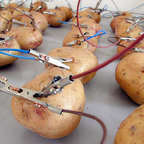
I Hear Denmark Singing
The Power of the Mind 2/I Hear Denmark Singing--by Mogens Jacobsen--takes a song by the Danish Minister for Refugee, Immigration and Integration, Bertel Haarder, as the point of departure for a political comment. An unstable online version of the song is connected to the physical installation that consists of a web server with a transcription of the interview and an electric network of a couple of hundred potatoes (the Danish national food). When the potatoes begin dry out or sprout his stupid song gradually disappears as a sign of fading memory and the text is replaced by heart shaped symbols. See Power of Mind/Memory and TURNTABLISTPC.
Posted by jo at 06:12 PM | Comments (0)
Ballettikka Internettikka:
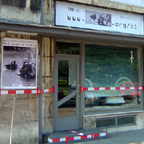
BEO Guerrillikka in Belgrade
Ballettikka Internettikka: BEO Guerrillikka [Bureau NetBallet] by Igor Stromajer & Brane Zorman (Belgrade, Serbia, 2005) (live internet broadcasting); Thursday, Oct 13th, 2005 at 9 PM GMT+1 (Berlin/Paris/Belgrade local time); Duration: 20 minutes (time tolerance: +/-4 minutes); Location X, Belgrade, Serbia; # Latitude: 44.79345 N, Longitude: 20.45340 E, Terrain Elevation: 110 m; Location will be made public on Oct 13th at 8:50 PM GMT+1 (10 minutes before the performance starts; due to security reasons).
Ballettikka Internettikka is an ongoing artistic study of the internet guerrilla performance. After invading the Bolsh.oi Theatre in Moscow (March 2002), and La S.cala in Milan (November 2004), Stromajer and Zorman will perform a new guerrilla net ballet, this time in another theatre house in Belgrade, Serbia.
Live internet broadcasting of the net ballet performance will start on October 13th 2005 at 9 PM GMT+1 and will last 20 minutes (+/- 4 minutes); the location will be made public on Oct 13th at 20:50 GMT+1 (10 minutes before the performance; due to security reasons).
They will enter the office (brain center) of the Artistic Director [location X], here the hardest artistic decisions to run the institution are taking place. The artists will use remote-controlled toy-robots with wireless web cameras.
Watch and listen live to internet guerrilla bureau ballet at http://www.intima.org/bi/beo
(Oct 13th 2005)
Artists will use low-tech mobile and wireless equipment for the invasion and live broadcasting (portable computers, mini digital camera, MP3 audio systems, mobile GPRS telephones etc). A laptop and MiniDV cam, together with Webcam32 (version 6.0) software will be used for broadcasting the video signal (running over Intima Virtual Base FTP server). Another laptop and MP3 player with online interface SHOUTcast (version 1.8.3/win32), will be used for live sound broadcasting (running over Beitthron FTP server). A local GSM mobile phone operator will be used for GPRS mobile internet connection.
Action Timetable / Belgrade, Oct 13th 2005 / GMT+1:
20:55 Equipment check on the parking place in front of [Location X]
20:57 Turning the computers on
20:59 Establishing wireless Internet connection (GSM 900/1800)
21:00 Start of live Internet broadcasting (-2) and final equipment check
21:01 Entering the building of [Location X]; climbing the stairs--3rd Floor (-1)
21:05 Entering the office of the Artistic Director [X] (3rd Floor / left): (0)
starting live bureau net ballet (10 min)
21:15 End of live bureau net ballet: exiting the office; descending the stairs (+1)
21:19 Exiting the building of [Location X]
21:20 Terminating wireless Internet connection at the parking place outside
[Location X] and turning off the computers (+2)
21:22 Taking the taxi to the O3ONE Gallery
Dancing a wireless bureau net-ballet in the office of the Artistic Director location X] represents a big conceptual and strategic challenge to the Intima Virtual Base, therefore the preparations have been taken serious, safety measures have been calculated, and the previous experience from the Bolsh.oi Theatre in Moscow and La S.cala in Milan has been very welcome.
Ballettikka Internettikka: BEO Guerrillikka is supported by Municipality of Belgrade, Ministry of Culture of the Republic of Slovenia, Ministry of Culture of the Republic of Serbia, O3ONE Gallery in Belgrade.
Bureau NetBallet Operators: Igor Stromajer & Brane Zorman
Bureau NetBallet Composer: MC Brane vs. BeitThroN vs. Thronus Sound System
Theoretical Adviser: Bojana Kunst
Curator: Ana Vujanovic
Executive Producer: Jelena Knezevic
Computer Programming: SM NORT
Co-produced by Intima Virtual Base (Slovenia) and TkH Center for the Theory and Practice of Performing arts (Belgrade)
[] [] []
Ballettikka Internettikka was presented in noumerous galleries and museums of contemporary art worldwide (from 2002 to 2005) including Le Centre national d'art et de Culture Georges Pompidou - Musee national d'art moderne in Paris, 15. Stuttgarter Filmwinter in Stuttgart, Centro em Movimento in Lisbon, FILE 03 - electronic language international festival in Sao Paulo, Titanik Gallery in Turku (Finland), P-10 Gallery in Singapore, IMPAKT festival in Utrecht (The Netherlands), Thailand 3rd New Media Arts Festival in Bangkok, Cork Vision Centre - Cork Cultural Capital of Europe 2005 (Ireland) and CEC ArtsLink in New York.
[] [] []
About the authors:
Igor Stromajer
http://www.intima.org
is an mobile intimate communicator. He researches tactical emotional states and traumatic low-tech strategies. He has shown his work at more than a hundred exhibitions in forty-two countries and received a number of awards. His works are included in the permanent collections of the Centre Georges Pompidou, Paris; the Museo Nacional Centro de Arte Reina Sofía, Madrid; Moderna galerija Ljubljana, Slovenia; Computerfinearts Gallery, New York and others.
Brane Zorman
http://www.ljudmila.org/beitthron
is a composer and sound manipulator. Between 1982 and 1986 he was frontman for the Slovene punk group O!KULT. He is a pioneer of Slovene techno scene. Since 1987 he has been composing music for both Slovene and international theatre, dance and multimedia performances and projects. and has made guest appearances throughout Europe. Recently he works with Irena Pivka on a series of audio-visual installations ZONE.
Intima Virtual Base - Institute for Contemporary Arts
Belgrade: +381 64 4200614
Slovenia: +386 41 703291
igloo [at] intima.org
Posted by jo at 11:15 AM | Comments (0)
October 05, 2005
Transactions of CHI:
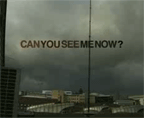
Can You See Me Now?
"We present a study of a mobile mixed reality game called Can You See Me Now? in which online players are chased through a virtual of a city by ‘runners’ (i.e., professional performers equipped with GPS and WiFi technologies) who have to run through the actual city streets in order to catch the players. We present an ethnographic study of the game as it toured through two different cities that draws upon video recordings of online players, runners, technical support crew, and also on system logs of text communication. Our study reveals the diverse ways in which online players experienced the uncertainties inherent in GPS and WiFi, including being mostly unaware of them, but sometimes seeing them as problems, or treating the as a designed feature of the game, and even occasionally exploiting them within gameplay. In contrast, the runners and technical crew were fully aware of these uncertainties and continually battled against them through an ongoing and distributed process of orchestration.
As a result, we encourage designers to deal with such uncertainties as a fundamental characteristic of location-based experiences rather than treating them as exceptions or bugs that might be ironed out in the future. We argue that designers should explicitly consider four potential states of being of a mobile participant – connected and tracked, connected but not tracked, tracked but not connected, and neither connected nor tracked. We then introduce five strategies that might be used to deal with uncertainty in these different states for different kinds of participant: remove it, hide it, manage it, reveal it and exploit it. Finally, we present proposals for new orchestration interfaces that reveal the ‘seams’ in the underlying technical infrastructure by visualizing the recent performance of GPS and WiFi and predicting the likely future performance of GPS." From Can You See Me Now? by Steve Benford, Andy Crabtree, Martin Flintham, Adam Drozd, Rob Anastasi and Mark Paxton + Nick Tandavanitj, Matt Adams and Ju Row-Farr
Posted by jo at 08:30 AM | Comments (0)
September 30, 2005
Here For You
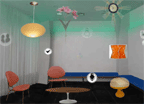
Redirect Surveillance, Control and Distance
Internet participants are invited to participate in a live network performance project opening Friday September 22nd at 7pm online and at the XINDUSTRIA exhibition at CAFKA 05, Kichener, Ontario. Here For You--by Will Pappenheimer--is a prototypical internet controlled space which allows virtual participants to adjust room lighting, see into the space, move objects, time clocks, upload messages and sound from your computer play it for the sound system. The guideline is to redirect surveillance, control and distance into channels of giving for physical visitors in the exhibition space. The exhibition continues through September 30.
This is a large ongoing project with dual physical and virtual levels and the challenges of connectivity and mechanics. It will begin simply develop as the exhibition proceeds.
“Here For You” will create a series of IP controlled conventional and fanciful domestic objects to comprise a network livingspace. Exhibition participants will be invited to relax in a living/domestic space constructed in or modified from available exhibition space. Appliances, both practical and artistic, can be controlled by anyone accessing the Internet from anywhere in the world. . The project hopes to create an environment where telepresence meets presence, remote control meets lifestyle, distance becomes proximity, surveillance becomes community and network becomes living room.
Posted by jo at 09:57 AM | Comments (0)
September 29, 2005
[UpStage]
![]()
Next UpStage Walk-thru, October 7
Kia ora koutou: this is a reminder about the monthly UpStage walkthru's [the next one is next week!]--Wed 5 October: California, USA: 2pm; New York, USA: 5pm; UK: 10pm; Western Europe: 11pm; Finland: 12 midnight; Australia (NSW/QLD): 7am [thurs]; NZ: 10am [thurs]; or check -http://www.timeanddate.com [for your local time].
The format will be newbies in the introduction stage [over view of the tools and tricks in the UpStage performative space]. While other crew will be devising with members of Avatar body Collision [please come to the introduction stage first for directions :)]; To take your place as a player please email colliders[at]avatarbodycollision.org for a login and password. Audience members please proceed to http://upstage.org.nz:8081/stages/presentation.
Posted by jo at 10:05 AM | Comments (0)
September 28, 2005
Zhong Shuo
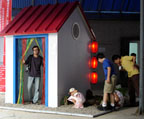
24 Hour Access to China
Zhong Shuo (People Say...) is a sound installation made collaboratively by Australian sound artist Iain Mott, Beijing visual artist Ding Jie and the Chongqing art collective the Li Chuan Group comprising Li Chuan, Li Yong and Ren Qian. The work acts as a system for the collection and telling of stories and focuses on the rapid force of change in China. The exhibition at the Long March Space in the Dashanzi district of Beijing, marks the first stage in what ultimately will be a series of installations connected to each other via the internet. It will consist of up to three individual installations set up in three cities including Beijing, Chongqing and potentially a third location on the route of the Long March.
Stage 1 was launched at the Long March Space, Dashanzi, Chaoyang District, Beijing on 20 August 2005. Stage 2 is currently underway in Chongqing with the Li Chuan Group. The exhibition is to be held in the Chongqing Planning Exhibition Gallery at Chaotianmen Square.
Each installation will pose a question to visitors, asking them to tell a story of their experience of change. In Beijing, Ding Jie's design establishes a gently ironic environment for public interaction. Created in the form of a Chinese garden, a kiosk houses a telephone for contributing stories and an adjoining rock-pool plays host to a small school of goldfish and water-plants. Hidden away in the rocks and shrubs is a loudspeaker, which plays a steady stream of stories that have been automatically recorded and edited by a computer. This sound, in addition to the voices, includes ambient sound recordings collected locally and is edited in the style of radio documentary.
Once the other installations have been established, stories will be shared between sites by way of networking. In this way, visitors will be able to reflect on varying perspectives on change. Each installation will share copies of the stories collected remotely and these will be edited together mixing both dialects and points of view. Additionally, the sounds played by the installations will be streamed to the web as internet radio, giving 24 hour access to Chinese speakers both nationally and internationally. Information on this radio channel will be announced by the Long March Space before the opening.
Posted by jo at 08:48 AM | Comments (0)
Passages
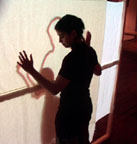
Plato's Cave
Many 'Media spaces' have taken the form of always-on video conferences between selected remote locations. However, users may still perceive a sense of separation because they see each other through wide-angle views captured by cameras mounted at a distance from them. Passages allows passers-by to "touch" the silhouettes of their remote counterparts.
A translucent surface, made of glass and textile is set in two different locations connected with each other via a network. As a passer-by walks in front of this surface, the contour of his/her silhouette is reflected in a style that evokes drawing or sketching.
This silhouette uncovers what is happening at the other location, possibly the silhouette of another person standing there. As the local participant moves, more of the remote scene is exposed.
A specially designed computer vision system enables interaction at a very short distance to the screen surface, to the point that passers-by can actually touch it. This system maintains a near-perfect registration of the participants' bodies to their silhouettes no matter how close they are to the surface. Video. By Joëlle Bitton, Céline Coutrix, Stefan Agamanolis. [blogged by Regine on we-make-money-not]
Posted by jo at 07:35 AM | Comments (0)
September 27, 2005
Balance Seat
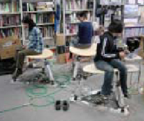
Networked Equilibrium Sharing System
"ABSTRACT: This paper presents a networked system connecting real space, which is shared and operated by three people. We made three pneumatic triple-axis motion platforms as a system to share a “sense of balance” with other people, and examined control methods for this system. Cylinders, which go up and down due to air pressure are used as actuators, and by moving the cylinders up and down while performing position control, the system can make the platform tilt. We considered whether it was possible to represent bodily sensations as symbols when shifting shared work performed in virtual space to real space. For our sensual symbol we chose the sense of balance, being a sense that is common to everyone. We constructed a system enabling users to share the sense of “balance”." From Networked Equilibrium Sharing System "Balance Seat" by Nobuya Suzuki, Takahiro Kobayashi and Hiroshi Yasuda.
Posted by jo at 02:04 PM | Comments (0)
1001 nights cast
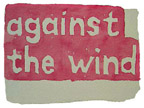
Tune In
As of tomorrow, I'll be into the three digit figures of the 1001 nights cast and also crossing quite a few time zones on my way back to Sydney. Here's some information about the next few performances if you want to keep track of performance times:
# 99 from PARIS on Sept 27 at 19:38 local time
# 100 from Changi Airport, SINGAPORE on Sept 28 at 18:59 local time
# 101 from Changi Airport, SINGAPORE on Sept 29 at 18:58 local time
# 102 from SYDNEY on Sept 30 at 17:57 local time
From then on, sunsets in Sydney will get later and later and on October 30 SOME of Australia, including Sydney, switches to daylight saving. On that day sunset in Sydney will be at 19:21. This is also the date on which much of the northern hemisphere reverts from summer time to standard time.
Please use the time zone converter to calculate your local time in relation to mine on any given day.
Since performance # 50 some great new writers have contributed to the project. The current full list of writers is:
Oskar Backent (just turned 7)
Lionel Bawden
Anne Brennan
Lucy Broome
Barbara Campbell
Deb Cox
Mira Cuturilo
Domenico De Clario
Jai McHenry Derra
Craig Doolan
Nola Farman
David Hagger
David Hansen
Helen Idle
Seth Keen
Alex Keller
Boris Kelly
Declan Kelly
Caroline Lee
Eden Liddelow
Rivka Mayer
Deborah McBride
Robyn McKenzie
Sarah Miller
Ninna Millikin
Ross Murray
John O'Brien
Marian Pastor Roces
Dee Prichard
Greg Pryor
Joseph Rabie
Ian Reilly
Andrew Renton
Neil Roberts
Danielle Roddick
Jade Shum
Ann Stephen
Rob Stephenson
Miriam Taylor
Philip Terry
Paul Threlfall
Helen Townsend
Sophie Townsend
Margaret Trail
Cynthia Troup
Patsy Vizents
Van Waffle
Frazer Ward
Ingrid Wassenaar
Marion White
Diana Wood Conroy
Amelia Young
Ellen Zweig
I cannot thank them enough for the quality and generosity of their writing. Always a pleasure to perform.
Barbara Campbell
http://1001.net.au
Posted by jo at 10:43 AM | Comments (0)
SEDIMENTAL JOURNEY!
10/3 - 7:30PM PDT (10:30PM EDT) Songlines Series, Mills College - Pauline Oliveros with Stuart Dempster perform a SEDIMENTAL JOURNEY! via iCHATav with Pauline in Troy in the iEAR Studio at RPI and Stuart in Seattle at the DX Center, U Washington and the duo appearing on screen in the concert hall on the Songlines Series at Mills College Oakland CA.
This concert is commemorating 50 years of musical friendship between Pauline & Stuart. Other collaborators include June Watanabe-choreography, Scot Gresham-Lancaster-video and networking design, Les Stuck-technical direction. Possibly the concert will be streamed onto the INTERNET as well. Otherwise attendance will be in three places: Oakland, Troy and Seattle. Contact: John Bischoff bischoff[at]mills.edu Songlines Series, "J. Pampin" pampin[at]u.washington.edu-Center for Digital Arts and Experimental Media (DXARTS), University of Washington, Seattle, Pauline Oliveros paulineo[at]deeplistening.org, Arts Department Rensselaer Polytechnic Institute.
Scot Gresham-Lancaster: http://o-art.org/Scot
podcast: http://feeds.feedburner.com/OrchestrateClangMass
blog: http://clangmass.blogspot.com/
Posted by jo at 09:55 AM | Comments (0)
September 19, 2005
OPENSTUDIO
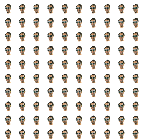
The Creative Economy is Launched
At the AIGA National Design Conference held in Boston this week, the PLW announced our new OPENSTUDIO project. OPENSTUDIO is a system we've been working on for three years now that combines "creativity, collaboration, and capitalism" in an experimental online art exchange system. Our goals are to provide simple, extensible, creative tools for free in an open, web-based environment.
Underlying OPENSTUDIO is a currency system we call the "Burak" (named after the trustworthy Burak himself) that pervades our model of online exchange. If you like a piece created in OPENSTUDIO by a friend, you can buy it with Buraks. You can sell your own as well. What are ownership models of purely digital art? This is one of the important questions we hope to experiment with in OPENSTUDIO. And if people make a few Buraks in the process, that can't be all that bad ...
As of 2AM on September 16, 2005 OPENSTUDIO had its first gasp of air and appears to look like it will make its first step forward next month. Burak, Annie, Kate, Brent, Martini, Amber, Kelly, Isha, Connie, Mariana, and Nikki seeded the AIGA conference on Friday with specially marked cards given out to visitors with "100 Burak" credits for when OPENSTUDIO becomes online to a limited audience. A total of 20,000 Buraks seed the core of the first test of OPENSTUDIO and we are curious how these Buraks will flow within the system. I have 97.20 Buraks myself, how many do you have? [blogged by John Maeda on Simplicity]
Posted by jo at 12:58 PM | Comments (0)
the Space Between the Physical and the Virtual
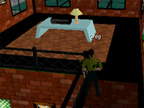
Cognitive Agents in 3D Virtual Worlds
"Abstract: We present an agent-based model of virtual worlds in which the objects in the world have agency, that is, the objects can sense their environment, reason about their goals, and make changes to the environment. The agent-based model has the following reasoning processes: interpretation, hypothesizing, and action activation. This agent model is described and illustrated using a wall agent in a multi-user virtual world. We extend the illustration through a demonstration of a multi-agent world in which many of the objects in the world interactively reason about the use of the world and respond specifically to the people in the world." From Cognitive Agents in 3D Virtual Worlds by ML Maher, JS Gero, G Smith, N Gu, University of Sydney, Australia; International of Design Computing, Vol 6, 2003.
Also: Interfacing Virtual & Physical Spaces through the Body: The C y b e r P R I N T Project

"Abstract: The cyberPRINT is a fully immersive, interactive virtual environment that is being generated in real time based on physiological data readings of a human body. In other words, the cyberPRINT is based on creating interfaces between physical and digital spaces and between biology and information technologies. The cyberPRINT is also an event, wherein a performer is connected to the cyberPRINT generator to create a self-sustaining feedback mechanism. Although the use of the body to electronically drive music and media events is not new, most of these works have paid little or no attention to the potential of interactive 3D virtual environments. Nor have they been so technologically advanced, interdisciplinary intensive (involving Architecture, Choreography, Modern Dance, Music, Bioengineering, Medicine and Computer Science), or architecturally focused as the cyberPRINT.
This project covers a wide and fertile territory that goes from the very technical and design oriented to the very theoretical and interdisciplinary. This paper is intended to (1) expand what has been already published about this project (Bermudez et al 2000a) and (2) establish potential areas for discussion before and after the performance."
1. Introduction: Why a Live Performance?
This paper provides background for the live performance of the cyberPRINT, a real time, physiologic data-driven virtual architecture developed by an interdisciplinary team led by two architects during the past 5 years. The reason for this live performance and demonstration is simple. It is only through performance that we can show the true nature of the cyberPRINT. Such demonstration will also provide empirical proof of the theoretical claims and technological details already published elsewhere (Bermudez et al 2000a). In addition, this version of the cyberPRINT will add some novelties occurred since then (such as a new virtual world, data-driven music in real time, a navigational data-globe). Images of a live performance are shown in Figure 1. [via]
Posted by jo at 11:38 AM | Comments (0)
September 16, 2005
Wind Array Cascade Machine
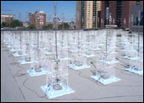
Si(g)n(e)
"Wind Array Cascade Machine (WACM)--by Steve Heimbecker--is a device that captures the wind's direction and movement and then streams the resulting data on the Web and uses them for installation projects. Thanks to the 64 motion sensors forming a grid of 8 units by 8 units, the system "maps" the wind in an outdoor space. Streamed on the Web, the data from the 64 channels are then processed by a computer program and assigned to installations that translate them into another form.(1)
The system has already spawned an installation, Pod, presented at the Mois Multi 2003 in Quebec City, as well as at the Subtle Technologies conference (2003) at the Interaccess centre in Toronto. During these two presentations, the sensing device was placed on the roof of the Méduse complex in Quebec City, and the data transmitted by the network were used to control a series of corresponding light emitting diodes (LEDs) placed on long vertical rods in an exhibition space.
Installed for a full year (2004-2005) on the roof of the Ex-Centris complex in Montreal, WACM powered the August 2004 Pod presentation at the Kiasma Museum of Contemporary Art in Helsinki, Finland, as part of ISEA 2004, as well as its presentation at Oboro in Montreal in November and December of the same year. The resulting luminous installation evoked a windswept field of wheat, thereby creating a visual analogy to express a natural phenomenon that is hard to perceive.
This system is similar to other devices created by artists integrating natural elements (for example, the wind and sun) into kinetic art. Yet Pod differs from this work in that the wind isn't used for its energy potential but rather because it describes a space by occupying and modifying it. Such projects are motivated by a fascination for natural phenomena, a desire to incorporate them into the creative process in order to link us to nature in technological contexts that sometimes exclude us and tend to distance us from our own organic condition.
In addition, Heimbecker is working on the project Si(g)n(e), a sound installation using the same system. To carry out this project, the artist is designing a sine wave generator with 64 channels, which will be controlled by a programming environment linked to a corresponding multi-channel sound system. The technology is being developed within a residency in cybernetic art at Vidéographe thanks to a program funded by the Foundation (2). Si(g)n(e) harks back to the many sound portraits of outdoor spaces produced by Heimbecker in the past." --S.P. © 2004 FDL [via]
Posted by jo at 09:12 AM | Comments (0)
September 13, 2005
MusicGrid:

A Case Study in Broadband Video Collaboration
"ABSTRACT: The technical requirements for widespread deployment of broadband video over the Internet are rapidly being met. But a harder challenge remains: how can video–based technologies promote collaboration and learning?
We present a case study: the MusicGrid Project. Running from 2002 to 2004 with partners in several Canadian and international locations, this modestly funded initiative ran over one hundred successful multi–site education and performance sessions. The rationale, development, and operation of the project are discussed, along with general lessons learned. We believe that our experience and the opportunities and issues identified will be useful to all those interested in large–scale, video–based collaboration projects." From MusicGrid: A Case Study in Broadband Video Collaboration by Hassan Masum, Martin Brooks, and John Spence, First Monday, Volume 10, Number 5 — 2 May 2005.
Posted by jo at 09:56 AM | Comments (0)
September 12, 2005
glocalmap.to

Digital Turin for the 2006 Olympics
How do urban dynamics change in the digital era? What tools does technology give us to aid the study and design of the territory? A concrete answer to these questions comes from the project by a Turin group of architects and new media experts. Maurizio Cilli, Carlo Infante, Riccardo Mantelli, Filippo Moncelli, Max Paccagnella and Stefano Ruggeri have created glocalmap.to, a digital map of the Turin Olympic area, developed for the Cultural Olympics in collaboration with TOROC, the Games' organising committee.
Global and local, glocalmap.to is an interactive web platform open to inhabitants and tourists alike; for the 42 days of the Winter Olympics in February and March 2006, they will be asked to say what they think of their city. It works quite simply: those wishing to do so can send a message (sms, mms and e-mails with attachments), which will be stored and displayed at a precise point on the map, visible to all via a number of screens. Apart from the play factor, glocalmap.to is intended to represent an experience of participation in urban planning.
For the future they are considering a vectorial version that will allow architects to place their projects directly on the territory. The aim? To trace a new spontaneous map of Turin that will reveal fresh and unexpected geographies. The presentation of the project is scheduled for 6pm today at the Atrium foundation. The speakers are Giovanni Ferrero, Maurizio Cilli, Stefano Boeri and Paolo Verri coordinated by Carlo Infante. Footnote: The Beach club, Turin's urban beach on the River Po, is celebrating its fifth birthday and hosting an open meeting of the Domus editorial team from 8pm onwards.
Torino, Italy
Glocalmap.to
14.9.2005, h. 18
Atrium, via Pietro Micca 21
14.9.2005, h. 20
Club The Beach, via Murazzi del Po 18
http://www.thebeachtorino.it
Posted by jo at 11:19 AM | Comments (0)
Rondo
Interactive and Intercultural Experience
[Posted by Yukihiko YOSHIDA]: Group Motion and Leni-Basso are currently involved in a collaborative multi-media dance project. This project is funded by the Japan Foundation, Dance Advance, Philadelphia, Arts Midwest, Ohio, The US Japan Friendship Commission, Washington, Indiana University of Pennsylvania and Montgomery County Community College, Pennsylvania, WIDE Project, Research institute for Digital Media and Content, Keio University, Yukihiko YOSHIDA.
Rondo will premiere here in Pennsylvania in September of this year and will hopefully be shown in Tokyo in the Fall of 2006 during the 'Dance Selection' Festival where Group Motion also performed in 2003. During our final production week of Rondo, September 14-19, we are planning to have an Internet2 conference in which we will broadcast a rehearsal of the piece live over the internet and have live discussion and interactive exchange with a group of interested people in Tokyo. It will be a wonderful opportunity for performers, critics, and lovers of dance to be involved in an interactive and intercultural experience that is taking advantage of advanced internet technology in a new way as an educational and informational tool.
There will be a designated facilitator and a translator (tbd) on each side. The translator in Tokyo will be Mikari Suzuki.
Date: September 16, 2005
Starting Time: 6:00 a.m. Philadelphia, 6:00 p.m. Tokyo.
Place: Keio University Mita Campus, East Building 6F GSEC Lab
http://www.gsec.keio.ac.jp/
Supportors: the Japan Foundation , Dance Advance, Philadelphia, Arts Midwest, Ohio, The US Japan Friendship Commission, Washington, Indiana University of Pennsylvania and Montgomery County Community College, Pennsylvania, WIDE Project, Research institute for Digital Media and Content, Keio University, Yukihiko YOSHIDA.
Posted by jo at 11:03 AM | Comments (0)
September 06, 2005
Capturing the Moving Minds

The Connection Between the War Against Terrorism, Economics and Media-Art
Researchers, activists and media-artists meet on the Trans-Siberian train from Moscow to Beijing September 11th - 20th 2005. The conference Capturing the Moving Minds gathers a pack of people--artists, economists, researchers, philosophers, activists--who are interested in the new logic of the economy, the new form of war against terrorism and in the new cooperative modes of creation and resistance, together in a space moving in time. Spatially moving bodies and bodies moving in time (through the different time zones) creates an event, a meeting that not really 'is' but 'is going on'.
Is this project about economics, is it political activity or a work of art? This "boundlessness" or "indeterminacy", which always characterizes the creation of new, is where the energy of the project is coming: The enterprise expresses and exposes itself the "knowledge economy" in which it exists. It is something the orthodox conceptions about work, action, economy and art are unable to grasp. In this organizational experiment everybody is "alone together" like a pack of wolves around a fire having neighbours to the left and to the right but nobody behind their backs exposed to the desert.
There are 50 participants on the train involving well known media-artists, frontline contemporary thinkers and political activists. The project has been invited to participate in the International ARS2006 biennial at Kiasma Museum of Contemporary Art in Helsinki and to arrange an exhibition at the Villa Croce Museo d"arte contemporanea di Genova during summer 2006.
Press Conference and Opening Seminar Wed 7.9., 15:00-19:00, Hemeentie 33 A, 2nd Floor, Helsinki
15:00-15:20 Intro to the project, its themes and methods (Tuula Karjalainen, Jussi Vhmki, KlausHarju)
15:20-15:40 Launching of the mobile documentation (Minna Tarkka, Adam Hyde et al.)
15:40-16:00 Trans-sib as a work of art (Akseli Virtanen, Anna Daneri, Genova)
16:00-17:00 Questions, interviews, refreshments
17:00-19:00 "Aesthetics of Resistance" seminar with Bracha L. Ettinger (Tel Aviv), Pierre Guillet de Monthoux (Stockholm), Jordan Crandall (Los Angeles), Steffen Boehm (London).
Mobicasting brings the event directly for all: The Trans-siberian conference is documented and broadcasted through an audiovisual mobicasting platform to the internet. The documentarists, photographers, artists and researchers produce discussions, ideas, interviews, texts and films along the route. The documentation will be projected in Kiasma during the journey and it will also be available on several international www-channels. The webpages http://www.kiasma.fi/transsiberia will be opened on September 7th. See also http://trans-siberianradio.org
Further info on the conference and the participants: http://www.ephemeraweb.org/conference
Further info on the mobicasting platform: m-cult, Netta Norro +358 40-561-8004
Further info on the opening seminar: Akseli Virtanen +358 400-302010 akseli.virtanen[at]hkkk.fi
The event is organised by Ephemera, Tutkijaliitto, Kiasma, Frame, m-cult, Helsinki School of Economics and the Chydenius Institute.
Posted by jo at 12:06 PM | Comments (0)
TeleMurals
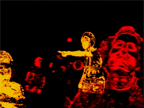
Blending [Distributed] Participating spaces
Telemurals is an audio-video connection where a communication space is created by breaking apart the pixels and speach of the participants at each end and reassembling them abstractly. The initial setup is straightforward. Two disjoint spaces are connected with an audio-video wall. Video and audio from each space is captured. The two images are then rendered, blended together, and projected onto the wall of their respective space. The difference between Telemurals and traditional media space connections are the image and audio transformations that evolve as people communicate through the system and the blending of the participating spaces.
Participation is required for this communication space to work. To reinforce a sense of involvement, we provide the system with some intelligence to modify its space according to certain movements and speech inflections. First, the image is rendered non-photorealstically. Second, words spoken in both spaces are captured, converted to text, and rendered on the screen in blocks left to fade away over time. The immediate feedback of seeing one’s spoken word alter the window lets them know they are adding to and affecting the shared environent. More complicated image manipulations are affected by changes in pitch and volume of the voice.
Much research has been conducted on the benefits and limitations of adding video to an audio communication channel. One of our goals here is to see how using non-photoreastic images influences conversation. Adding video to a communication channel improves the capacity for showing understanding, attention, forecasting responses, and expressing attitudes. A simple nodding of the head can express agreement or disagreement in a conversation. Gestures can convey concepts that aren’t easily expressed in words; they can express non-rational emotions, non-verbal experiences.
Yet these cues are not always properly transmitted. There may be dropped frames, audio glitches. Lack of synchronicity between image and audio can influence perceptions and trust of the speaker at the other end. Other challenges include equipment placement. For example camera placement has long been a reason for ambiguous eye gaze in audio-video links. A large camera offset gives the impression that the person you are speaking to is constantly looking elsewhere.
With Telemurals, we are creating an environment where rendered video maintains subtle cues of expression such as posture and hand motion, yet also enhances other cues. For example, changes in voice volume and pitch may be represented in the graphics of the rendered video. Audio conveys the speach inflections in conversation by altering parameters of the rendering. By adding another layer of abstraction into the video stream, we can enhance cues in a manner that is not possible in straight video streams.
Abstracting the faces is of big concern in the rendering. It builds on the intrigue of how one would appear if transplanted into this filtered space. Caricature and cartooning are such types of abstractions. There are elements of curiousity, humor, and surprise when seeing a caricature yet there is enough resemblance to make a personal connection.
The creation of an abstract environment in Telemurals has some similarities to virtual spaces in online worlds. Examples of fantasy environments for conversation can already be seen in online graphical communities. One essentially puts on a mask and enters an electronic communication space. This element of mediation removes many of the social barriers by allowing one to safely enter a stimulating world. Just as this lack of concrete identity may aid in suddenly and continually confronting new people in virtual environments, it may help in our physical-virtual hybrid. It has the added benefit of mitigating the perception of offset eye gaze and the effects of unsynchronized audio and video.
In this project, the abstraction of person, setting, and feedback provide the social catalyst for the experience. This new wall created by filtering creates an ice-breaker, a common ground for interaction, and a object for experimentation. How will one communicate in this abstracted space? How will their behavior affect their appearance and the appearance of the setting? How different is communication using photorealistic vs. non-photorealistic video? The goal here is to create a new styles of movement and speach interaction by providing a common language across the two spaces.
The first Tele-mural installation will connect two MIT graduate dormitories, Ashdown and Sidney-Pacific. The Tele-mural in Ashdown is located in the lower level in the common reacreation room. In Sidney-Pacific, the Tele-mural will be placed near the main entrance. This connection came about as the under-construction Sidney-Pacific dormitory committee was looking to put public art in its public areas and create spaces to encourage students to gather. Ashdown, the oldest graduate dormitory on campus was similarly undergoing renovations to create public spaces for social gatherings and the two dormitories were open to the idea of linking the older dormitory to the newer one. The sites within the dorms were chosen because they have high levels of traffic, are openly public , and because a large video wall aesthetically blends into the space.
Posted by jo at 10:52 AM | Comments (0)
September 02, 2005
NOTE TO SELF
Skin Problems
"...Tomorrow night, artist Mary Coble will subject herself to a marathon tattoo session that could make a career Marine wince. Beginning at 6 p.m. and likely continuing until dawn the next day, a tattoo artist will etch 400 names into the artist's back, legs and arms. And we're all invited to watch. The 26-year-old Washingtonian's show at Conner Contemporary Art is a rare opportunity to see performance art locally -- not to mention the chance to witness an artist literally spill blood for her cause and craft. It's open to the public from 6 to 8 p.m., and viewable for its duration via a live Webcast." From An Artist Pricks Her Skin and Our Conscience Over Hate Crimes, by Jessica Dawson, Special to The Washington Post, Thursday, September 1, 2005; Page C01. [via Rhizome]
Posted by jo at 03:25 PM | Comments (0)
Unusual Encounters

Chance Encounters
Unusual Encounters is a three-part, web-based art project in which Jean Paul Gaultier has had the pleasure of participating and which is a mixture of creative sophistication and the latest technology, unique in the world, viewable at this address. Designed by the film director David Mileikowsky, under the artistic direction of Jean Paul Gaultier, the Unusual Encounters site proposes 3 original modules, offering 3 unique meeting experiences:
On September 9th, an on-line artistic improvisation will be organised for 500 trendsetters around the world and we have the pleasure of inviting you to take part in this exclusive venue. On that day, "Zhang will meet Veng" and for the first time ever, the unusual encounter between two unrivalled virtuosos, Maxim Vengerov and Zhan Yimou, the Russian and the Chinese, the violinist and the film director: two meteors of the Modern Arts will be brought together online in a live artistic performance, somewhere between China and Germany. Some 9000 km apart, the amazing duo will perform on-line, in unison. The first showing is scheduled for September 9th, at 12:00 exactly (Paris time).
You might also like to try Tango Painting, available as of today! For the first time ever, this multi-user graphic application allows user pairs to simultaneously draw up, from a distance and in an entertaining way, multimedia forms, regardless of their skill level. Their work can then be complemented by creations from artists such as Jean Paul Gaultier and Jean-Baptise Mondino, then shared with others on the web.
Finally, on September 10th, The Perfume Alchemist will be presented in an on-line world premiere. This visionary manga by Alain Escalle (director) tells a story of a child, a little prince of the streets, in a high-rise megalopolis, who decides to create the perfume of his dreams. Thanks to "Manga Maker", an on-line video editing platform, every user can participate in the adaptation of the course of the story and then pass the modified story on to his/her soul mate. An extract of this manga is available here.
Posted by jo at 10:25 AM | Comments (0)
September 01, 2005
Six Degrees of Smoking

The Secret Lives of Lost Lighters
Have you ever wondered what happens to your cigarette lighter when you lend it to someone and don't get it back? Six Degrees of Smoking is a global artistic collaboration to delve into the secret lives of lost lighters. Lighters are handed out or posted to those who wish to be involved. The recipient then photographs themselves smoking a cigarette and submits it via MMS or email. He then passes the lighter on to a fellow smoker (either a friend or a stranger) and the process is repeated. Each lighter is numbered and so they can be tracked on their travels. [Remember Traces of Fire?]
Posted by jo at 05:11 PM | Comments (0)
A Furthernoise.org Real-time Event

The Point @ Furthernoise's Visitors Studio
Welcome to a collaborative event between The Point Community Development Corporation, based in New York and Furthernoise.org who are based in the UK. The first invited guest Chris Vine will be mixing live from Londrina, Paraná, Brazil. The second guest Mark Francombe will be mixing live from his home in Oslo.
Those in New York can visit the centre in the Bronx, and those who are not in New York around that time can also visit the Visitors Studio, event live online, via the Internet. Physical event: Live Broadcast in the Theatre of The Point Community Development Corporation, Hunts Point, The Bronx, New York.
Date & Times:
Sunday 4th September. 4 - 6pm BST. from 11 am to 1pm.
Time Zone Converter: http://worldtimeserver.com
Visitors Studio: http://www.furtherstudio.org/live
The event will last for 2 hours with the individual performances lasting 45 minutes each. Chris and Mark will also be available online afterwards to chat about their work with others using the 'Visitors Studio' chat faciltiy. The studio will then be re-set, open again for everyone to mix collaboratively.
Chris Vine - 4 to 4.45 pm
Mark Francombe - 4.45 to 5.30 pm
Open mixing for all to close event.
Residents of New York can watch the event broadcast live in Theatre of The Point Community Development Corporation Hunts Point, The Bronx, New York from 11 am to 1pm.
[[[Warning the event may contain strobe lighting effects]]]
Information about the 2 guest artists:
Chris Vine - Associated with the 'Downtempo' jazz scenes in New York and Washington DC during the 1980's working with composers such as multi-instrumentalist Elliott Sharp & drummer Bobby Previte and then guitarist with Ted Miltons UK cult punk jazz group Blurt during the 90's, Chris Vine is an innovative musician, composer and artist. He is also a founding member of the Canton Opera Company which collages baroque arias with abstract soundscapes and is currently touring Brazil performing a live score with dance theatre company Verve Companhia de Dança. He will be mixing live from his home in Londrina, Paraná, Brazil.
Mark Francombe - is a composer, performer and artist with a well heeled reputation for experimental electronic and improvised music. A founding member and guitarist of the 1980's UK indie band Cranes he recorded and toured extensively throughout Europe before moving to Norway in 1997. He composes & performs with modified, heavily treated, baritone guitar and releases his music through small independent CDR labels including his own Synch Non Synch label. His recent album Ear, Nose & Throat is released through Oslo based Synesthetic Recordings and is featured in the current edition of Furthernoise where he also contributes as a reviewer. He will be mixing live from his home in Oslo.
enquiries: roger[at]furthernoise.org
http://www.furthernoise.org
Info about Visitors Studio.
Posted by jo at 11:23 AM | Comments (0)
UpStage
![]()
Open Session & Improv: September 7
The next open session in UpStage will take place on Wednesday, September 7 at the times below. This time we will divide into two groups, with a beginners' session happening on the Introduction stage while those who've already learned the basics will go to another stage to improvise a short performance for an hour. In the second hour, we will invite everyone to watch and interact with the
performance.
Wednesday 7 September: California: 2am; New York: 5am; UK: 10am; Western Europe: 11am; Finland: 12 noon; Australia (NSW/QLD): 7pm; Aotearoa NZ: 9pm. Check http://www.worldtimeserver.com/ for your local times. If you want to come and learn, email me for a log-in. come to http://upstage.org.nz:8081/ to log in, then follow the link in the top right hand corner to the Introduction stage.
If you want to come & improvise a performance, you still need to email me (in case we run into double-ups with guest log-ins) & we'll also meet at the introduction stage, then move to another stage to work. I'm proposing the theme of "water" as a starting point (given recent floods in Europe & the global problem of the growing lack of fresh water in the world) so you can think about backdrops & avatars that relate to that theme. If you upload any graphics, assign them to the Virtual Tourist stage & we'll use this one for the improv.
If you'd just like to come to watch the performance, you don't need to log in. Come to the Introduction stage towards the end of the first hour of the session, & when the performers are ready you will be led through to another stage.
Any questions, email me, & i hope to see you next week.
helen varley jamieson: helen[at]creative-catalyst.com
http://www.creative-catalyst.com
Posted by jo at 11:06 AM | Comments (0)
August 31, 2005
Plug
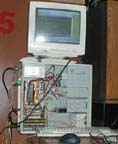
Global Headphone Festival
[Though it looks to be quite dysfunctional, this sucker sends the streaming Plug signal around the globe [Photo: Keith Axline].] "...In some ways Plug, held here Saturday, is just what you'd expect from a music fest: rotating performances in front of a live audience, socializing and plenty of beer. But the headphones (bring your own) replace a traditional concert's amplified speakers, and much of the socializing happens over a computer terminal linked to an IRC chat room, populated by members of the global audience listening to the performances over the internet...
The 13 hours of performances represented San Francisco's turn at the global le placard headphone festival, which hits cities all over the world, including London, Montreal, Paris, Brussels and Nagoya, Japan. Each city hosts a headphone party for a given period, in this case one day, before handing off the feed to the next location. Theoretically, this continues for 97 days in the hopes of providing one nonstop experience, though there are gaps in the schedule." From Fest Rocks With BYO Headphones by Keith Axline, Wired.
Posted by jo at 11:40 AM | Comments (0)
Repercussion.org

Virtual Instruments for Live Performance
Repercussion.org is a collection of on-screen virtual instruments designed for live performance and online user exploration. Rhythms and musical phrases can be dynamically composed and altered based on the arrangement of objects on the screen.
The collection is a showcase for the visual representation of freely-formed musical compositions. The project aims to be engaging enough to encourage the viewer to experiment, while being sophisticated enough to allow for a great deal of variation in the sound being created. The actual musical compositions are generated in real-time from a library of pre-recorded midi-based sounds, employing algorithms to map the on-screen graphics to characteristics of the sound arrangement such as pitch, tempo and volume.
The graphics were designed with a wide audience in mind, such that the concepts represented are accessible to a viewer regardless of his level of musical training, while at the same time matching the artist's idea of a basic kit of musical instruments for “jamming”: some drums, some melodies, a way to create chords, strings, etc. To be available to the largest online audience, Macromedia Flash was chosen as the medium. The piece is a work in progress that will be updated and customized. [blogged on media·teletipos]
Posted by jo at 11:19 AM | Comments (0)
MINDPLAY:

Extended deadline for submissions
MINDPLAY is a one day conference on the social, intellectual and experiential dimensions of play and interaction in digital media environments. The conference focuses on mindful and playful relationships with digital media environments including mobile and ubiquitous media, new cinema, gameplay, wired performance spaces and networked communities. We encourage submissions of papers, practice-led research, poster presentations, demonstrations and installations. Selected papers may be published in a special issue of the journal Digital Creativity. Conference date: Friday January 20th 2006; Extended deadline for abstracts: Friday 30th September.
Posted by jo at 10:30 AM | Comments (0)
August 30, 2005
TeleSon: Invention#8 by Chris Brown

Networked reacTables
TeleSon: Invention#8 is composed for four musicians playing two networked "reacTables", one each in Barcelona and in Linz, Austria (ICMC2005). The reacTable is a new electronic music instrument developed at the Music Technology Group in Barcelona by a research team headed by Sergi Jorda. Brown explains: 'I have interfaced my own synthesis engine, written in SuperCollider3, to the reacTable's visual and gestural interface, thus composing my own synthesis environment with its own rhythmic and tonal character. Like the other works in my "Inventions" series (recorded on Pogus CD "Talking Drum"), this piece involves polyrhythms, computer networks, and improvisation. Like "Invention #5" (1999), it also involves musicians collaborating at great physical distance from each other'. See Sounding the Net: Interview with Chris Brown by Peter Traub.
Chris Brown, composer, pianist, and electronic musician, creates music for acoustic instruments with interactive electronics, for computer networks, and for improvising ensembles. Recent recordings of his music are available on Tzadik, "ROGUE WAVE" (2005) and "LAVA" (1992); and on Pogus, "TALKING DRUM" (2001). He has also performed and recorded extensively with "The Hub", "Room", and the "Glenn Spearman Double Trio". As a pianist he has recorded music by Henry Cowell, Luc Ferrari, and John Coltrane; as an electronic musician, he has collaborated with John Zorn and Wadada Leo Smith. He teaches electronic music at Mills College in Oakland, where he is Co-Director of the Center for Contemporary Music (CCM).
Posted by jo at 11:24 AM | Comments (0)
Activated Spaces + Crawling through Network Cable
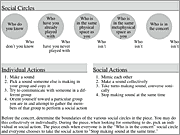
Sounding Jesse Pearlman Karlsberg
"Abstract: Successful political sound art comes in a variety of forms. Interactive sound art can upend entrenched social relations around the consumption of media. Work articulating obscured spacial or social power dynamics can provoke deep thought and discussion. Work incorporating explicit documentary material can dovetail successfully with social movements, enlivening events, and serving as a mechanism for fundraising, awareness raising, or mobilization. These different tracks can be employed, singly, or in combination to make effective political art work for a variety of settings. This thesis follows one sound artists' path through the multiplicity of potentially rewarding approaches to creating artwork with political and social themes." From Activated Spaces by Jesse Pearlman Karlsberg.
Crawling through Network Cable is a framework for group improvisation, exploring the social conditions of live distance collaboration. Musicians and video artists are in two remote locations, connected by networked computers running iChat AV or other videoconferencing software. The performers improvise responding to other performers in their own location and the remote location, paying special attention to the features of improvising with physically remote collaborators.
As source material, performers in Crawling through Network Cable should start with the physical infrastructure that connects the two locations: copper network cable, projectors, computers, routers, firewalls.
Crawling through Network Cable was composed by Jesse Pearlman Karlsberg. Musical performance at Rensselaer by Nik Kanter (keyboards), Pauline Oliveros (concertina, harmonica, goat hooves), Jesse Pearlman Karlsberg (laptop). Musical performance at Wesleyan by Dave Kadden (oboe), Angela Opell (clarinet), Anne Rhodes (voice). Live video by Kathy High and Caterina De Re at Rensselaer and Will Swofford at Wesleyan.
A score for structured improvisation for video artists and musicians in two locations, connected by networked computers running videoconferencing software. View the performance score (PDF). Audio and video from Crawling through Network Cable will be posted in Fall 2005.
Posted by jo at 09:22 AM | Comments (0)
August 27, 2005
Parasite + Parallel Worlds
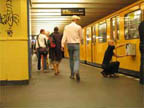
Mobile Movies
Parasite--by Frédéric Eyl, Gunnar Green and Richard The--is part of the Moving Canvas series; it investigates the visual and symbolical importance of trains in an urban context and the possibility of exploiting them as brief communicative moments.
Affordable mobile video-projections could be used to re-conquer public space often only reduced to graffiti and streetart. The tunnels of a subway-system bear something mystic—most people usually have never made a step inside any of those tunnels. Parasite is a projection-system that can be attached to subways and other trains. Using the speed of the vehicle as parameter for the projected content, the projection starts with the train moving inside a tunnel.
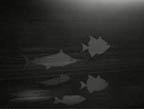
All along their journey, travellers see images mysteriously appearing through the train windows: words, aquatic animals, etc. Confusing the routine of your train-travelling-journey, your habits and perception Parallel Worlds allows you a glimpse into a different world full of surrealist imagery.
Don't miss the video. [blogged by Regine on we-make-money-not]
Posted by jo at 10:25 AM | Comments (0)
wave_scan

Allegorical Mapping of the Liminal
wave_scan, by Brad Todd, is composed of an ELF (extremely low frequency) sensor, an antenna and a projection of a video database of water filmed over the past 15 years in different countries.
The system is centred around the ELF sensor. In paranormal research these electric and magnetic fields are also monitored by people searching for ghosts and other inexplicable phenomena: "cold spots" and other signs of paranormal activity reported by persons who think they are seeing phantoms are in fact closely tied to these EMF fields.
The ELF sensor is attached to an old TV antenna and is transmitting to a computer. Any detection of weak fluctuations of frequencies near the antenna results in the direct manipulation of a soundscape which is generated using a sine wave and white noise to create synthetic oceanic sounds. Any readings are also translated as clicks and pops, thereby creating a minimialist audio environment which gives audible evidence of a "presence" in the space.
Besides, the image slowly works itself from full chroma to blank, depending on the number of "hits" in the space. This sense of effacing the work and rendering the image into a ghostly and finally invisible screen closes a circuit or cycle of the works "life", in an allegorical mapping of our anxiety concerning the unseen or liminal... [blogged by Regine on we-make-money-not]
Posted by jo at 09:15 AM | Comments (0)
August 25, 2005
StarChild + FlatWorld

Data Sonification
Data sonification has been viewed as a tool with great potential for studying complex sets of scientific data. Sonification can provide the researcher with the ability to perceive variations and trends that are invisible to more established data analysis techniques. However, few have explored the potential artistic applications of sonification. In 1996, Jarrell Pair worked with Alec Robinson to se Matlab and Csound to prototype software to transduce data from various sources such as images, temperature, and light intensity into aesthetically pleasing audio. We used this work to develop the audio effects for StarChild. Using Csound and a custom C program, astronomical data from the Shoemaker Levy-9 comet collision was used as input to create audio for portions of StarChild. Additionally, images of the collisions with Jupiter were transduced into audio effects using Hyperupic, an application running on a NeXT computer. 440k MP3 file (low sample rate) taken from the sample files created from the comet collision.
From July 1995 through June 1996, Pair was extensively involved in the technical development of StarChild, a multimedia opera. The opera was composed and produced by Audio Research Team director, James Oliverio. Alec Robinson and Pair created sound effects for the opera using data sonification methods we had developed as part of an ongoing team project. He was also involved in the installation, testing and evaluation of the eight channel audio steering system used in the opera.
The StarChild production team included visual futurist Syd Mead (designer for the films Blade Runner, Aliens, Tron, and Star Trek: The Motion Picture ), the internationally recognized lighting designer Lloyd Sobel, animator Steve Walker, and scientists and engineers from across the Georgia Tech Campus. Students met and worked with the guest artists in workshops, lectures, and in the production of the opera itself. An internet MBone broadcast of StarChild took place on June 5th, 1996. Two live performances followed on June 6th and 7th.

FlatWorld: The Mixed Reality Simulation Space
Since 2001, Pair has overseen the design and development of the FlatWorld project at the University of Southern California's Institute for Creative Technologies (ICT).
FlatWorld is a mixed reality simulation environment merging cinematic stagecraft techniques with immersive media technology. Current virtual environments have severe limitations that have restricted their use. For example, users are often required to wear bulky head mounted displays that restrict a person’s freedom to physically move as they would in the real world. Furthermore, a person cannot touch or feel objects in the virtual world.
This project addresses these issues by developing an approach to virtual reality simulation which allows individuals to walk and run freely among simulated rooms, buildings, and streets.
Posted by jo at 10:33 AM | Comments (0)
Radio_Copernicus@Warsaw_Autumn 2005

World Premiere + Open Studio
Radio_Copernicus@Warsaw_Autumn 2005: After the prelude in Stralsund Radio_Copernicus - the German-Polish Artist Radio- is broadcasting for another month in co-operation with Warsaw Autumn 2005, the 48th International Festival of Contemporary Music: September 01-30, 2005 live-stream; September 16-30, 2005 on air: Warsaw FM 92.4.
With its ambitious programme Radio_Copernicus creates a broad discourse and context regarding Warsaw Autumn 2005 - to focus on innovative media concepts and art and culture of the electronic age. Besides regular reports and discussions on Warsaw Autumn the broadcast of Radio_Copernicus-commissioned works is a highlight of the programme: six up-and-coming artists are invited for the world premiere of their productions - Duo Merzouga, Anne Koenig, Michal Jacaszek, Emiter/Aszyn, Group Two, Underwater Agents. Almost daily from 10 pm to midnight Radio_Copernicus - broadcast-studio in Warsaw will be committed completely - as an "Open Studio" - to the artists and their visions of radio.
Further on-air stations of Radio_Copernicus:
Dis_Positionen, Academy of the Arts, Berlin - November 2005
International Radio Art Symposium, Wroclaw - December 2005
Radio_Copernicus is broadcasting permanently and world-wide as an
Internet-live-steam until 31 December 2005 on www.radio copernicus.org.
Further information can be found in Polish, German and English here:
Studio Radio_Copernicus
University of the Arts Berlin
Postfach 120544
D-10595 Berlin
Tel. +49 30 3185-2482
Fax +49 30 3185-2530
Email info@radio-copernicus.org
http://www.radio-copernicus.org
Posted by jo at 07:33 AM | Comments (0)
August 24, 2005
Appendix2
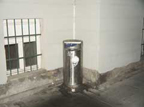
Activated by Passers-by
Appendix2--by Tanja Vujinovic and Zvonka Simcic--features an alternative state of urban landscape. The multimedia exhibition consists of short video works and interactive, computer based works displayed in the Kresija Gallery (Ljubljana, Slovenia) and interventions in the soundscape of the center of Ljubljana.
Small scale mechanisms (automata), made of sensors react to movement and small broadcasting units are hidden at several locations in the center of the city. Sounds are activated by passers-by and intervene into the structure of the town soundscape.
The sensors are attached to the garbage bins and passers-by are then blessed with sounds of Chinese market and rickshaw drivers, laundry machine and parody ads for perfume. Well, I should write "the sensors WERE atached" as they've just been stolen. Fortunately, the rest of the exhibition is still up and running till August 28. [blogged by Regine on we-make-money-not]
Posted by jo at 10:30 AM | Comments (0)
August 16, 2005
MAY YOU LIVE IN INTERESTING TIMES
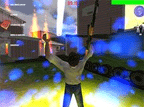
Exploring Digital Technologies in the Context of Public/Shared Spheres
MAY YOU LIVE IN INTERESTING TIMES is Cardiff’s inaugural festival of creative technology - a three-day programme of events being held across the capital. The festival is being developed between Chapter and Bloc (Creative Technology Wales) and includes a two-day conference, new commissions, residencies, screenings, and artists’ projects in public sites across the city.
Artists are increasingly engaged with or inspired by digital technology - exploring consumer and communication technologies such as the worldwide web, mobile networks, file sharing, and computer gaming. Because digital technology is a participatory medium with global reach, artists tend to explore digital technology in the context of public and shared spheres. Often digital art is situated somewhere between public art and street culture where the technology itself is used as a ‘site’ for the production and presentation of art works. Although digital technology is often claimed to go beyond physical limitations, engagement with technology is always embedded in real spaces, whether this is explored from a user or network perspective.
Artists include: Blast Theory, Anri Sala, Grennan & Sperandio, TJ Wilcox, Jen Southern & Jen Hamilton, Scanner, Sarah Morris, Michelle Teran, Eddo Stern, Stefhan Caddick, Nina Pope & Karen Guthrie, Tim Davies, Rosalind Nashashibi, Tenant Spin, Andy Fung, Paddy Jolley, Mircea Cantor, STAR Radio, Valérie Jouve, Chris Evans, Mike Mills, Artstation, and many more.
Conference day 1: 28 October - Locative media and emplacement Speakers include: Prof Michael Corris, Head of Art & Photography, University of Newport; Claire Doherty, Director, Situations; Nina Pope, artist; Heath Bunting, artist; Giles Lane, Proboscis; Steve Benford, Professor in Collaborative Computing, University of Nottingham; Dr Sarah Green, Social Anthropologist, University of Manchester; Jen Southern & Jen Hamilton, artists.
Conference day 2: 29 October - Gaming Speakers include: Ju Row Farr, artist, Blast Theory; Stuart Nolan, researcher; Christopher Sperandio, artist; Eddo Stern, artist; David Surman, Lecturer in Computer Games Design, University of Newport; Alex Mayhew & Emma Westecott, Games Producers & Directors.
Conference Prices: £50 per day / £90 weekend ticket – organisations; £30 / £50 – early bird booking before 7 October £20 per day / £30 weekend ticket – individuals /concs; £15 / £25 – early bird booking before 7 Oct Party, The Point, Cardiff, 29 Oct, 8pm: Special Guests Scanner, Michelle Teran, Proober Glombat, Cymbient, Christopher Rees DJs.
The site will feature live streaming, artists’ projects, downloads, full biographies and images, conference booking and travel details, press section and the chance to receive regular updates on festival activity.
For further information about the programme and conference please contact: Gordon Dalton, Festival Coordinator: gordon@mayyouliveininterestingtimes.org 44 (0) 29 2031 1059 / 0779 234 1654
The festival is a Cardiff 2005 event and is presented with the support of: Cardiff County Council, Millennium Commission, the Arts Council of Wales, WDA, Cywaith Cymru . Artworks Wales, BBCi, Creative Mwldan, Millennium Stadium, Mute, G39, The Big Sleep, Elfen, Zenith Media, UWN, National Museums and Galleries of Wales, Sequence, Coolpants, Ping Wales, Oriel Mostyn and @Wales. http://www.bloc.org.uk/cgi-bin/showbig.cgi?id=55
Posted by jo at 09:51 AM | Comments (0)
August 08, 2005
Peekaboom
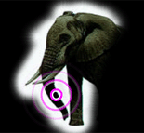
Peeking and Booming: Teaching Computers to See
Peekaboom Basics: you and a random partner take turns "peeking" and "booming." While one of you is peeking, the other is booming. The booming player (Boom) gets an image along with a word related to the image, and the peeking player (Peek) gets no image (see Figure below). Booming consists of clicking parts of the image; when Boom clicks a part of the image, it is revealed to Peek. The object of the game is for Peek to type the word associated to the image -- from their perspective, the game consists of a slowly revealing image, which has to be named. From Boom's perspective, the game consists of clicking on areas of the image so that Peek can guess the word associated to it. Once Peek guesses the correct word, the two of you move on to the next image and switch roles.
You and your partner should go through as many images as you can in 4 minutes. Every time Peek guesses the right word, both of you get a certain number of points. You can also choose to pass, or opt out, on difficult images. If you click the pass button, a message is generated on your partner's screen; you cannot pass on an image until both of you have hit the pass button. Boom can see all of Peek's guesses and can indicate whether they are "hot" or "cold."
Pings: In order to help Peek, Boom can also "ping," or point to, an area of the image. Pings tell Peek that the word is related to that particular area. In the Figure to the left, for instance, Boom has already revealed enough of the image for Peek to see that it is an elephant, but Boom still needs to point to the trunk, since the associated word is "trunk" and not "elephant."
Hints: Boom can also help Peek by giving hints about the word in question: does it refer to a noun in the image, to a noun related to the image, to a verb, or to text appearing in the image? Using the hint buttons gives you extra points. [via smartmobs]
Posted by jo at 09:49 AM | Comments (0)
August 05, 2005
Air Vent: Call for Participation

The Relationship Between Sound and its Source
AIR VENT is a project that takes natural sounds out of their specific location, the sounds of peoples personal spaces [via mobile telephone] & places them live via radio senders or the internet into new contexts, into diverse locations, into both similar & contrasting environments.
The work stems from ideas based on the relationship between sound & the sound source; natural rhythms & patterns in everyday sound [background noise, dialogue, etc]; the fine line, & often friction between natural & synthetic sound in connection to space; audio & visual perception.
Air Vent is radio/telephonic project by k donovan for Radio LoRa in Zürich that will start on 1st august at 00:00 & end on 10th august at midnight. Five minute snippets of sound will be transmitted hourly for those 10 days, both pre-recorded & live via mobile/landline/internet phones from around the world. The idea is to take the background sound from a specific space & relocate it (mainly live) into other new, similar & contrasting environments through radio.
If you are interested in sharing the sound from your space live, you are gladly invited to participate by registering online & providing dates & times when it would be possible to call the studio in zürich, or connect via internet phone. You will then be contacted (via sms or email) with a confirmation.
Pre-recorded sound files (preferably recorded with a telephone, but other ways are also acceptable) of environmental/field recordings can be sent to:
spezialprogramm@lora.ch (mp3's) or by snail mail (be quick!) to: AIR VENT, Alternatives Lokalradio Zürich, Postfach 1036, CH-8026 Zürich, Switzerland.
Please include a short introduction about the place and time at the start of the recording.
Queries & questions? Contact: kdonovan_uk[at]yahoo.co.uk
Things to acknowledge: For live calls, don't forget time differences! The concerns of this project are the 'natural' background noises that are specific to a certain space/time/situation.. therefore, participants are asked to simply use their phone to transmit their given environment through sound, rather than to perform or contrive something for the listeners. And by the same token, pre-recorded pieces that have not be edited/layered/effected would be preferred.
Posted by jo at 10:20 AM | Comments (0)
August 04, 2005
EA's m/M
Six Hour Continuous INSTALLATION-PERFORMANCE
EA's m/M: [1] As computers keep offering us the ability to play with numbers in increasingly complex ways, our perception of proportional relationships is being exponentially challenged. We begin to realize our involvement in a ubiquitous hyper-game where reality fades into its own representation. [2] Even time is no longer regarded as an absolute parameter to which safely anchor ourselves. With the realization of these, ever-shifting dynamics comes the desire to take on an active role and to start interacting with the idea of relative magnitude, and with the way in which we perceive proportions. Microphones and amplifiers, optical lenses and projectors are some of the instruments that make it possible for us to monitor, analyze and redefine ourselves within our environment. Such technical tools, as well as philosophical hypotheses, are abundant and allow us a wide range of exploratory possibilities.
This exploration is the scope of m/M, EA's installation/performance in Williamsburg's Galeria Galou and its surroundings. During six hours, sounds and images will be collected from near and far, processed and re-presented in our first attempt to formally engage with the fluctuating interface that lies between the micro-bound and the macro-bound. An empirical test bench equipped with various electronic devices will be installed inside the snug space of the gallery. Its function will be to collect and process the sensorial information and to send it back to the outside world - the gallery's bare industrial surroundings and further on, eventually reaching EA member Andre Goncalves who will participate to the event via Internet connection from Lisbon, Portugal. Guest sound artist Brendan Murray, visiting from Boston, will provide yet another "outside perspective" to be internalized in the performance. Rather than a specific sound or an image, EA's piece will be constituted by the whole machine/environment. m/M is the whole functional apparatus designed to create dimensional loops and to attempt a short-circuiting of the conceptual extremities of inward and outward subjective planes. Passers-by will be attracted to the core of the performance space, and encouraged to participate in this empirical and expansive process.
EA is Gill Arno, Richard Garet, Andy Graydon, Andre Goncalves (performing from Portugal via internet), Brendan Murray (special guest from Boston) and Gil Sanson.
Galeria Galou: 237 Kent Ave. (bet. North 1st and Grand), Williamsburg, Brooklyn, NY 11211. Take the L train to Bedford - about 5 minutes walk from the train. Tel: 718-486-3730
Posted by jo at 12:14 PM | Comments (0)
August 01, 2005
R*Emote Mirror
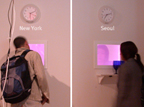
Hole in Space Update
R*Emote Mirror--by Yeonju Shim--is a pair of networked interactive lighting installations that creates communication between isolated people in urban cities and their loved ones who live far away. The telepresence installation re-creates feelings of togetherness and physically connected interaction between distances and spaces, allowing each person to interact through the expression of his or her movement. r*Emote Mirror has two functions: one is a mirror, and the other is interactive color lighting. Each r*Emote Mirror will have an initialized color representing the user, and trigger the movement of the person with different colors. When two persons stand at the same position in front of their installations, r*Emote mirror makes them see color changing and blending of their individual colors.
If you are living in Seoul and are close to the mirror, you can see your own shape on the panel in red light. At the same time, your friend living in new york can see your red color on his or her panel at home. if your friend is close to the panel, s/he can see his or her own body shape as blue light. If you are both in front of each mirror, the overlapping of color will hopefully evoke feeling of togetherness. For instance, if red overlaps with blue, it makes purple. [blogged by Regine on we-make-money-not]
Posted by jo at 11:35 AM | Comments (0)
July 30, 2005
Why Bother
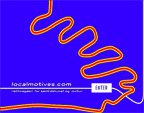
Live Video Streaming from Artists' Studios
During the autumn of 2005, Localmotives will be organizing a project which aims to stream live video imagery from several artists' working spaces (aka «studios»). The project is named Why Bother and will be produced in collaboration with i/o/lab and Atelier Nord. The video streams will be part of localmotives' 11th themed publication. The publication is titled 1:1 and will be physically manifested at Rogaland Art Centre (Rogaland Kunstsenter) from the 15th of September to the 27th of November.
We would like to get in touch with artists who already enjoy a high bandwidth connection to the internet, and would like to participate in Why Bother. You don't need to know a lot about video streaming. We will provide the technical assistance to make things work.
There are no million euro cheques to win here, but on the other hand you won't have to behave like an ass. We expect you to do the things you'd usually be doing, and you don't have to be in front of the camera all the time. It doesn't matter whether your working space is a desk, a corner of your livingroom or a good old studio.
We hope to gather participants from a geographic area as possible. The live streams from the various studios will be displayed in steady rotation on monitors in the exhibition room at Rogaland Art Centre.
Interested? Get in touch with: Geir Egil Bergjord, geiregil[at]localmotives.com (+47 51 89 33 39/+47 922 27 616) or Kevin Foust, kevin[at]iolab.no (+47 412 97 293)
_http://www.localmotives.com_
_http://www.iolab.no_
_http://www.anart.no_
Posted by jo at 09:21 AM | Comments (0)
July 28, 2005
Human Scale Chess Game
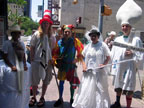
We Call Your Moves
Join the eighth Human Scale Chess Game in Oakland on Saturday, August 06. The organizers need 32 volunteers with working cellphones to play the roles of the chess pieces. Sign up now by email to select the role you will play. To participate, you will need a working cellphone and a couple of free hours on Saturday August 06. Costuming is strongly encouraged; the campier, the better.
SMS simulcasting and webcasting will likely be used during the Oakland game and there will be an afterparty. Check the site for updates as more details become available. Human Scale Chess is a project of Glowlab contributor Sharilyn Neidhardt. [via Glowlab]
Posted by jo at 04:44 PM | Comments (0)
July 26, 2005
3 x 3
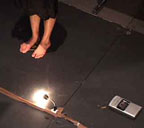
Looped
3 x 3--by Gemma Shusterman: the project looks at the fundamental relationship between audience and performer by putting the audience in the active role as collaborator rather than simply the passive role of observer. The performer becomes a conduit for a structure created by the audience. The audience in turn is given active involvement in creating their own experience and becomes engaged in an exchange with other audience members controlling the course of the piece.
The project consists of a web interface which allows the audience member to enter coordinates that map to the performer's space. These coordinates are then sent to a microcontroller (using the cockroach microcontroller) which controls the power supplied to the selected portions of the space. It is then the performer's job to find a way to move from one section of the space to another in improvisational form. The subsequent performance is then broadcast back to the site via webcam. video documentation. full video from live performance on 12.08.2004.
Posted by jo at 09:05 AM | Comments (0)
July 19, 2005
Artphone at PROG:ME
For the first edition of prog:ME, the new media festival in Rio de Janeiro (Brazil), Susana Mendes Silva has developed a new version of Artphone, this time using Skype. [related]
Posted by jo at 07:09 AM | Comments (0)
July 18, 2005
Talkaoke

Streamed, Spontaneous Chat with Real People!
Talkaoke consists of a doughnut shaped mobile table, hosted by a man in the middle with a microphone. Up to twelve people can sit around the table. Talkaoke is an active means of participation that is totally dependent on the context in which it is performed. There is no fixed agenda or expected outcome. Conversations are recorded for the on-line archive and can be webcast live. The people speak at Talkaoke.
Talkaoke is the brainchild of artist Michael (Mikey) Weinkove. Mikey had been working on video installations and live pieces constucting real and fictitious conversations. These were shown in UK and European galleries. In January 1997 Mikey was invited to create a one off performance at the Hydra Club, a live art club in London's East End. Mikey created Talkaoke, which was a scaled down version of a performance called "It's your shout!"
This was a previous performance with 100 invited people attending a forum with audience driven subjects and discussion. The Talkaoke format was so popular that it soon became a regular feature at Hydra.
In 1998 Talkaoke became part of the Duckie crew at their then upmarket Friday night West End club, Duckie Dancehall, where Denise joins the Talkaoke crew. Talkaoke became part of the furniture there too, and by spring Talkaoke had chewed the fat at a few of london's more leftfield clubs. In August Talkaoke did it's first festival gig at Summer Rites, a gay and lesbian festival in Brockwell Park. It was crazy stuff.
chat is the new rock n' roll
By the end of the year the Talkaoke team had given up fighting the deafening noise, late nights and intoxication of the clubs and began experimenting with a series of Talkaoke-with-accompanying-DJ-type events. The first was in winter '98 with a shortlived sunday residency at the Bug Bar, then in 99 at the Shoreditch Electricity Showrooms and the Crowbar. '99 saw Talkaoke at a number of underground parties too.
Although Talkaoke has had a website since '98 it was only when James Stevens of Radiospace witnessed Talkaoke at a party that the webcasting potential of Talkaoke was realised. The first Talkaoke streamed live by Radiospace was in April 2000 from Coffee@ Brick Lane. Webcasting rapidly became a successful Talkaoke feature. Talkaoke was invited by the Pleasance Theatre to perform at the Edinburgh Fringe Festival, where all the gigs were webcast.
like a chat room but in real life
This was the beginning of the format we see in public Talkaokes today with many behind the scenes technical developments: 2 mics, speakers in a battery powered table, video projection, web streaming, Djs providing background music. Talkaoke is seen mostly at festivals and the studio sunday sessions but who knows where we will be invited next?
Posted by jo at 08:45 AM | Comments (0)
July 15, 2005
Art_room
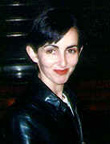
"An Artist in the Chat Room" by Luís Silva
"In 2002, Susana Mendes Silva (1972) put up, for Free Manifesta, the Artphone project, a cell phone mediated performance in which everyone could contact the artist, through her personal cell phone number, and discuss contemporary art related subjects. The slogan she used when advertising the project was revealing of what her purpose was: “Don’t be afraid to ask everything you always wanted to know about contemporary art”. Everything one has always wanted to know about contemporary art was available, only one phone call away. The artist exposed herself. Not only was she completely available for anyone who called but also assumed she could answer any question addressed to her.
In 2005, three years later, the cell phone was replaced. Instead of just being available, of waiting a phone call, the artist became more dynamic, active. She replaced the cell phone by an online video chat room and created Art_room, an online performance where anyone could meet the artist and, once again, ask her everything they wanted to now about contemporary art.
Besides the notorious change of environment and, consequently, the kind of relationships established, the artist also worked the engagement of those assisting or participating in the performance. It was mandatory to have an internet connection, to know the implicit rules of online chatting and to download different plug-ins that allowed the access and interaction in such an environment.
The performance was announced by email and happened in predefined schedules during the month of June. The goal was to put together, in the same place, the typical users of such chat rooms and people more familiarised with the contemporary art discourse. The development of the action taking place was let to chance and it would be completely dependent on the public and the artist’s interactions. Only one person other than the usual chatters of the chosen room showed up. The performance started and the artist introduced herself and told people to ask her questions about art. People in the chat room didn’t quite understand the objective of her behaviour and started to act aggressively towards her. As she repeatedly stated she was doing a performance and she wanted people to ask her questions about art, aggressiveness escalated and she was invited to leave the chat room, since her presence wasn’t welcome there.
The following day the artist repeated the performance in the same chat room. Everyone in the room were regular users and they were mostly present at the previous day actions. The artist continued her activity, seen as unwelcome and undesirable by some of the members of the room. Later on, the room monitor shut down her webcam and finally banned her from the monitored area, known as friends and family.
The Art_room project thus exceeded the artist’s initial expectations. Even though largely depending on the establishment of social relations, and on the contingencies that rule them, such reactions were never planned or accounted as a possibility. Yet, a closer look at the processes explored and undermined by the artist let us see how predictable the reactions obtained during the two days of performance are.
Silva, with this project, is working in two different areas, both able to induce attitudes and behaviours similar to those witnessed. The notion of community is central to Art_room. There is a group of individuals sharing the same interests and gathered in a specific online space, considered by themselves their reunion space. It’s by sharing that space with each other that they feel as part of that community. The artist, by introducing herself in that chat room has crossed the community’s border separating the outside world from that group of people. Not only has she crossed the border, thus invading that space and assuming herself as an outsider, she also acted in a way that made that difference even more visible, by showing the impossibility of conversion, of becoming part of the community and sharing a common discourse. She acted in a disruptive manner, disturbing the regular functioning of the social structure crystallized in that video chat room.
But besides assuming her otherness, and thus being irreducible to the group, Silva was questioning the group’s beliefs about what art is. Assuming her behaviour as an artistic project not only is she clashing against a traditional, objectual, almost commodified vision of the artistic object, she is also affirming that a disturbing, parasitic, undesirable activity, may be considered art. She confronts them with something they don’t see as such, and never will. The debate wasn’t centred in what were the artist’s initial plans, but in justifying and legitimizing her behaviour, inappropriate to the community as a valid artistic practice. The artist will never become a member of this community so as its elements will never share with her the same vision of the artistic phenomenon.
We have here two events, that can be thought as the ever present dichotomy between the self and the other and that, in this particular case, will inexorably result in a difference without any possibility of being resolved. There is only one possible way . The community regains the state of equilibrium, by eliminating the destabilizing element, the artist and her behaviour.
A technologically mediated performance working as a human relations laboratory. An extremely interesting exercise that happened live, in front of our eyes. What is the difference between online and offline? Is the online world a public space open to dialogue and to equal participation for all? Where is the emancipating utopia of cyberspace? The artist knows how to answer to those questions." [posted by Luís Silva on Source Code]
Art_room Instructions:
1. please enter http://www.webcamnow.com/videochat/ or http://webcamnow.com/fs5/. You will probably need to install the free software.
2. in webcam communities please select friends and family
3. choose webcam art_room
4. start
5. schedule: 02-06-05 and 03-06-05 (15:00-18:00h gmt); 04-06-05 (11:00-13:00h gmt); from the 6th of June every monday from 22:00 to 23:00h.
Posted by jo at 01:32 PM | Comments (0)
July 12, 2005
48 Hour Wake
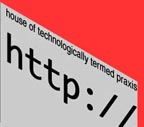
The Era of Post Autonomy
In a one off event which begins at 12 midnight Friday 22nd July and ends at Midnight Sunday 24th July, David Goldenberg and guests will take part in a continuous 48 hour wake at HTTP gallery. During this time they will stay awake while on-site inside HTTP gallery to dream, relax, take part in discussions and share ideas with a community who enter into the project.
The 48 hour wake examines how it is possible to disengage from any mindset that one inherits, along with the tradition and residues of a Euro centric art practice, before going on to develop new ways of thinking, thinking about the future of art and society, entry into the era of Post Autonomy. The event is to be web cast so that it will be seen simultaneously at a venue in Norwich gallery as part of the East Open International - along with facilities that will allow the opportunity for a wide range of persons to take part in the discussions via Voice-Over IP.
The project develops a work staged last year for the STRUKTUR show at artist: network in New York.
Address of http://
House of technologically termed praxis
Unit A2,
Arena Business Centre,
71 Ashfield Rd,
London N4 lNY
Tube Manor House
Buses: 341, 141
Train: Harringey Green lanes
Car: Free car parking facilities
Contact: Phone: 020 88022827
http://www.furtherfield.org
info[at]http.uk.net
David Goldenberg – david.postautonomy[at]hotmail.co.uk
Posted by jo at 10:47 AM | Comments (0)
July 11, 2005
Touching of the Touch

Screens, Streaming, Viruses, and Performance
"The notion that is often inextricably linked to the concept of performance is one of extension: one thinks of the performing body as extended by certain technologies, and these technologies can vary widely in their nature...The body—in Stenslie’s project the body’s erogenous zones in particular—becomes extended, since the touching of one’s own suit allows for a tactile communication with another user who is wearing a similar technology. One may also conceive of the performing body as extended by a musical instrument; this is seen as a kind of transferring of the body onto the instrument, with which one communicates to the world: a voicing of one’s body; a body drawn out of itself..." From The Touching of the Touch—Performance as Itching and Scratching a Quasi-Incestuous Object by Franziska Schroeder, Extensions, Mediated Bodies: Locating Corporeality in a Pixelated World.
Also: The Intensity of Dance: Body, Movement and Sensation across the Screen by Stamatia Portanova; The Virtual Artaud: Computer Virus as Performance Art by Jason Farman; and Streaming the Performer’s Body: An Interview with Downstream by Jason Farman.
Posted by jo at 11:16 AM | Comments (0)
July 08, 2005
1001 nights cast
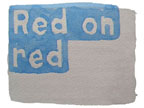
A Durational Performance
In 1001 nights cast, Barbara Campbell performs a short text-based work for 1001 consecutive nights. The performance--begun on 21 June 2005--is relayed as a live webcast to anyone, anywhere, who is logged on to http://1001.net.au at the appointed time, that is, sunset at the artist's location.
1001 nights cast is a project generated by the forces of that great compendium of Arabian tales, The 1001 Nights also known as The Arabian Nights. The project explores the theatrics of the voiced story, the need for framing devices, the strategies for survival, the allure of the Middle East and its contrasting realities. Submit a story. View the archives.
Posted by jo at 04:18 PM | Comments (0)
July 05, 2005
a_mirror

Continuous Portraiture
a_mirror--by Limiteazero--is an installation comprised of a glass mirror, which reflects both in a physical and virtual way. It explores the present at different reading levels, including a continuous flow from present to past. Standing in front of the mirror, an image gets physically reflected in it; then a graphically modified image softly appears as a second level of reality, a sort of interpretation of the real image. The piece is wirelessly connected to the internet: lightly touching the small metal disc in the center of the mirror, the current image on the screen is grabbed and uploaded on a specific url on the internet.
Posted by jo at 09:59 AM | Comments (0)
June 28, 2005
Step + Repeat: Pittsburgh Cycle
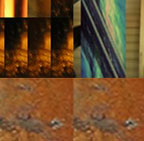
Shifting Technologies and Economies
Step + Repeat: Pittsburgh Cycle--by Carlos Rosas and Robert Dansby--Call for Participation: Submit your images of Pittsburgh. Your images will be entered into the image database and be included in the participatory tile sequence projected in the Palmer Museum and viewable on the Internet via live webcast. For more information on this project, to submit images and to view the live broadcast visit the project web site.
Abstract: A live audio and video based piece using networked media. Based on digital “step and repeat” cycles: a loose metaphor, the Pittsburgh iteration uses video and audio samples recorded in Pittsburgh, PA, and the surrounding western Pennsylvania area –with touchpoints including Primanti’s, the Strip, the Southside, East Liberty, the Northside, Beaver Falls, Jones & McLaughlin, the Monongahela Incline and Pittsburgh’s three rivers.
Divided into into six primary segments and a seventh segment including material contributed by viewers to be filtered through a digital randomizer, step and repeat: Pittsburgh cycle maps entrance into an urban environment via incline railway, transit through the city, reflections of the community’s industrial past, particularly steel, and the transformation of city and countryside as the industrial economic base shifts and nature again takes hold of old worksites. In the last two segments the viewer leaves the city, again on incline railway, and watches as the evening paints the city as a visually appealing study of water and reflection.
Concept and Development:
With a nod toward Allen Sekula’s work: specifically “Fish Story.” This piece chronicles (in a documentary fashion) the ironies, displacements, shifting values, economies and systems: the transformation of an American city as an industrial and economic center shifting from steel to telecom, and the reclamation of areas of the city and countryside dedicated to old economies/technology by both nature and the population at large - a population with new needs but retaining a core identity.
The “Step and Repeat” cycles are variable and highly dynamic works performed live with laptops or in automated modules prepared for web or installation on site. The media resources are mixed, filtered, and emitted via live performance software…deriving image, video, qtvr, audio, and net streams from databases and databanks resident on local and networked laptops and servers.
Posted by jo at 12:21 PM | Comments (0)
PitchWeb
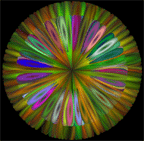
Jam this Wednesday
PitchWeb jam this Wednesday, June 29, from 6-8 pm EDT. The occasion is a book release party Routledge is giving for William Duckworth's "Virtual Music: How the Web Got Wired for Sound." They'll be playing as DJ Tamara and the Laptops. The plan is to make the party a "virtual" experience: the party goers have been invited to bring their laptops, and Nora will be weaving the online band into Tamara's house mix and a webcast.
Hope you can join them online at http://www.pitchweb.net/. All you have to do is click, sign on, join a group, and play along. As with the 12-hour May-Day PitchWeb jam, Wednesday's session will also become source material for the yearlong Deep Time: Songs for Servers project that we're beginning later this year.

About the Book
· Must-reading for all interested in the world of web-based music
· Highlights diverse artists from John Cage to Moby to Scanner
· Includes unique CD sampler highlighting the composers and works discussed in the book
Virtual Music: How the Web Got Wired for Sound is a personal story of how one composer has created new music on the web, a history of interactive music, and a guide for aspiring musicians who want to harness the new creative opportunities offered by web composing.
For Bill Duckworth, the journey began in 1996 when he developed the idea for an interactive webcast, named "Cathedral," which was developed over a period of 5 years. On its completion, "Cathedral" won numerous awards, including the ASCAP/Deems Taylor Award for composition, and has already inspired further experimentation.
But this is more than the story of one composer or one piece of music. The book traces the development of interactive music through the 20th century from Erik Satie through John Cage, Brian Eno, Moby, and Scanner. The technology itself is described as it has inspired experimentation by artists, including composers who have developed new ways to involve the audience in their music, plus possibilities for the non-musically trained to "play the Web." Challenges facing the web composer-from copyright issues to commercialization-are analyzed with new solutions suggested.
Virtual Music is a fascinating story that will appeal to fans of new music, creators, performers, and anyone interested in how technology is transforming the arts.
Posted by jo at 08:45 AM | Comments (0)
June 17, 2005
The Head

A Wearable Sculpture
The Head is a wearable sculpture with a connection to the internet and a public access via sms. The sculpture contains "an eye" (a camera lens) and a camera phone which captures images and sounds in certain intervals. People can send the Head sculpture an SMS to which the sculpture responds by capturing an image and recording a short soundfile. This image and the sound are sent back to the SMS-sender. They are also uploaded to a website with date and time of the capture accompanied with the sent sms-message.
The Head will be adopted and carried around by people and its "vision and hearing" is both automated and triggered by public to collect memories on the way. It will be also set (by the artist) to be adopted by people in professions which generally have "a view" on the society: police officer, politician, tourist guide, teacher, etc. Author: Laura Beloff (one of the developers of the Seven Mile Boots.) [blogged by Regine on near near future]
Posted by jo at 10:01 AM | Comments (0)
Internet Theatre Fest
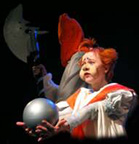
Cross-Cultural Artistic Expression
Last October, Moscow’s Interstudio presented the First Interactive Theatre Festival. Seven Russian companies – performing in four locations and a variety of theatrical traditions – participated in this groundbreaking event. Productions were streamed live from Moscow, Perm, St. Petersburg, and Komsomolsk-na-Amure to the Interstudio site, and viewed by over 2000 users from more than fifty countries.
Featured in the festival were: Pyotr Fomenko Atelier (Moscow) performing THE FAMILY BLISS, The Shadow Theatre (Moscow) performing MISANTHROPE / RAIN AFTER THE FLOOD, Elena Kamburova Music and Poetry Theatre (Moscow) performing P. S. REVERIES..., Evgeny Panfilov Ballet (Perm) performing EIGHT RUSSIAN SONGS / BOLERO, Helicon Opera (Moscow) performing LULU, KnAM Theatre (Komsomolsk-na-Amure) performing REINSTATEMENT OF DADAISM, and The Comic Trust (St. Petersburg) performing THE WHITE SIDE STORY.
Following the final production of WHITE SIDE STORY, audience members from Moscow, St. Petersburg, and New York participated in a discussion forum conducted via web conference. Participants shared their visions for cross-cultural artistic expression, and their hopes for future streamed performance festivals. Though this fledgling effort weathered many technical difficulties, viewers voiced enthusiastic agreement about its tremendous potential.
The festival organizers had tried to anticipate bandwidth problems by asking viewers to register in advance, but on the first day of the festival, the website was swamped, and finally overwhelmed by high demand.
Viewers were offered a choice of three video streams, one with sound, which could also be viewed simultaneously. Audience members in New York, watching a wall-sized projected image, had a detailed view of the performances, although some viewers were distracted by the lack of synchronicity between the three video streams. Some audience members also expressed their desire for a view of the live audience, and a look at the theater space – two things that might have helped them get a feel for the live performance experience.
At the same time, New York viewers were excited by the unique opportunity to experience an unfamiliar theatrical style. Most felt they understood the Russian shows -in spite of the language barrier and technological limitations - and talked about how the Russian work could influence their own artistic work.
The Russian performers also seemed excited by the new possibilities explored in the festival. One company – from a small Russian town – had never dreamed they would be able to reach such a large international audience. Directors and performers had many ideas about ways to improve the web-streamed experience, including rehearsing camera operators and designing staging for the camera as well as the live audience.
Theatre-Web hopes to put these ideas into practice in future festivals. [via Digital Performance]
Posted by jo at 08:16 AM | Comments (0)
June 08, 2005
La Fura Dels Baus
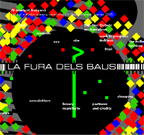
DIGITAL THEATER
Digital theater is the addition of actors and 0 and 1 bits, moving in the net. Actors in digital theater may interact from different times and places… The actions of two actors in two different times and places coincide in the network of infinite times and virtual spaces. On the 21st century, genetist conception of theater (from the generation to the birth of the scene) will be replaced by an organization of interactive and intercultural activities.
Digital theater refers to a binary language connecting the organic with the inorganic, the material with the virtual, the actor in the flesh with the avatar, the present audience with the internet users, the physical stage with the cyberspace.
The digital theater of La Fura dels Baus allows interaction on stages inside and outside the net, inventing new hypermedia interfaces. Hypertext and its protocols create a new kind of narration, closer to thoughts or dreams, generating an inner theater where dreams become (virtual) reality.
Internet is the realization of a collective thought, organic and chaotic, that has been developed with no defined hierarchy. Digital theater multiplies in thousands of representations where cybertheater fans may display images of their own subjectivity, within shared virtual worlds.
Will digital theater perpetuate Phallocracy? Will Vaginocracy eventually win? Or will both join in perfect harmony 0-1?
In digital theater, the absolute abstraction coexists with the return to the body, that may have a sadomasochist dimension —as well as a sensual, angelical, or orgiastic dimension; or perhaps a mixture of all of them.
By definition, theatrical act involves an excess, a surplus of performance. It’s the pleasure of showing and being shown. An identification flow is established between the actor and the audience. How does this identification work in digital theater? How does a hand fit into a glove? As an extension of oneself? With the integration in the net?
Digital technology makes the old dream of transcending the human body possible. Thus, cyberspace may be inhabited by bodies with a new representational envelope, between subjectivity and materiality.
We have to leave our own skin to penetrate into a common perceptual reference. The roles of the actor, the author and the audience tend to merge.
Digital culture does not belong to a reproduction technology anymore, but to an immediate production. While photography spoke in the past “it was like this”, by freezing an instant, digital image speaks in the present “it is like this”, joining the live act, the theater, the here and now.
Digital theater allows the image to mutate, from one configuration to another, actual and virtual, placing it in different stages: an icon of synthesis which will always remain HUMAN. [via]
Posted by jo at 02:12 PM | Comments (0)
SKINT STREAM
![]()
Pilot Broadcast Tonight!
Skint Stream is a network which will connect audiences and cultural spaces previously separated by economic, geographic and political factors. The use of streaming technology over existing infrastructure allows us to start a conversation between spaces separated by different types of distance.
Skint Stream consists of: • Container Project - Clarendon (Jamaica) • Sound Kitchen Studio/MMC - Johannesburg (South Africa) • Nostalgie Ya Mboka - London (UK) • Cue Music at Southend YMCA - Southend (UK) • Regent Park Focus - Toronto (Canada). You can listen to the pilot stream live on 8 June 2005 from 6pm-11pm GMT (that's 7pm-12am BST), which is: • 8pm - 1am (in Johannesburg) • 1pm - 6pm (in Kingston) • 7pm - midnight BST (in London and Southend) • 2pm - 7pm (in Toronto). (See Listen for full schedule). Skint Stream is an ICA Cape Town, Mongrel and r a d i o q u a l i a project.
Posted by jo at 01:39 PM | Comments (0)
June 07, 2005
Interfacing/Radiotopia/KeyWorx
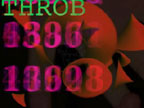
Translocal Exchanges
Interfacing/Radiotopia/KeyWorx consists of one space that has no images and has only sound, and one space that has no sound and only images. They are connected both physically and via the Internet.
SPACE 1: [Radiotopia] Walk into a theatre and enter an audio space with no images. Artists from all over the world are asked to send in audio material to fill up a database. Behind every sound is an idea, a world of words and definitions. The one big experience with Radiotopia is the peaceful confrontation of all the world's sounds, audio artists, concepts, sights and sometimes ideologies. In the Scapino theatre, the sound is mixed live by musicians and resent as an audio stream.
SPACE 2: [KeyWorx] Walk out of the theatre, down a narrow hallway and enter a space filled with images. Three artists sitting in the space, are connected with three artists in New York City. Three translocally linked pairs, three simultaneous and connected performances.
Behind every sound is an idea, a world of words and definitions. In the KeyWorx space, one listens to the world of words within the audio–spoken words, ideas, emotions, memories–and translates that world into actual text.
Inspired by a Surrealist game 'Parallel Stories', a word sent by performer or public from a mobile phone in response to the audio appears simultaneously in all three performances. Each performance pair responds to this foreign text input sent via 'sms' by creating a visual story around it. Three parallel translocal exchanges within one physical space (a room in New York, the V2 bookstore) are connected by the same word yet are unique in the visual interpretation of it. The performance is improvised and created collaboratively in real-time.
These compositions are projected onto the screens throughout the V2 space.
Want to know how we put this performance together? Follow the process log.
Credits: Concept KeyWorx Space: Isabelle Jenniches and Michelle Teran with Sher Doruff • KeyWorx performers: Isabelle Jenniches, Arjen Keesmaat, Lodewijk Loos, Eric Redlinger, Michelle Teran, Dan Vatsky
• Radiotopia project created by: Rupert Huber, August Black and Norbert Math KeyWprx project created by: Waag Society for Old and New Media.
Posted by jo at 11:57 AM | Comments (0)
June 06, 2005
Intimate Transactions
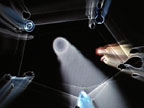
Sensory Intimacy Across Time and Space
Intimate Transactions--by The Transmute Collective--is a new type of interactive installation that allows two people located in separate spaces to interact simultaneously using only their bodies. Each participant uses a physical interface called a ‘Bodyshelf’. By gently moving their bodies on this ‘smart furniture’ they instigate ‘Intimate Transactions’, which influence an evolving ‘world’ created from digital imagery, multichannel sound and tactile feedback. This shared experience allows each participant to gradually develop a form of sensory intimacy with the other, despite the fact that they are geographically separated and cannot physically see or hear each other. As this highly immersive experience evolves, each participant begins to sense their part in a complex web of relations that connect them, and everything else within the work. In this way a subtle, indirect form of collaboration develops via an increasing sense of intimacy between sites.
Participants may choose to act in different ways as they begin to understand how their actions affect everything within the environment AND the other Participant. Hence the work focuses participants upon understanding influences and relationships within the work's ecologies.
Intimate Transactions was awarded an Honorary Mention in the 2005 Prix Ars Electronica Competition. It will next be shown in Sept 2005 at the Ars Electronic Festival, Austria and in October 2005 at the Institute of Contemporary Arts, London.
Posted by jo at 11:03 AM | Comments (0)
June 02, 2005
( ( ( N O M U S I C ) ) ) A R E N A I I

Open Call to Net Audio Players
-< 48 Players on Dual Play >-< 24h Continuous Net Audio Festival >-< Audio Live Performing only via Internet >-< Creative Commons Audio License - No Archivz >-< Stream Live Audio/Low & High >-
Stream Start: October 12 (00h00/00:00am); Stream End: October 12, 2005 (23h59/11:59pm) [GMT+0 Greenwich Time]. Join Now the ( ( ( N O M U S I C ) ) ) Deadline: September 21; Final playlist: September 28, 2005
(((NOMUSIC))) is a free platform for audio diffusion via Internet dedicated to Players. Interventions come from two simultaneous countries and follow each other in a regular manner at the rate of two peoples per hour. The development of this Network is aimed at promoting experimentation and creation.
The contributions are disseminated from different countries with two simutlaneous participants being allocated one hour in sequence, dispatched on the channel left for the Player 1 and the channel right for the Player2 , re-creating a unique stream and stereo.
(((NOMUSIC))) co-ordinates the interface for these different geographical point without any interruption, moving the audience during 24 hours from one country to the other, without jet-lag. No audio data is kept, the aim being to favour live performance throught the different stream technique in simple, multi or co-stream. The axis of development is not to constitute one dead data basis on hard disk, but to be determinedly a movement on the web where each author becomes an available data and a geophysical site that constitutes a visible tie thus during one terrestrial complete revolution foxglove.
Posted by jo at 07:18 AM | Comments (0)
May 27, 2005
UpStage Open Walk-Through
![]()
Next Session: June 1/2
The next open session in UpStage will happen on Wednesday, June 1 (or Thursday, June 2 depending on time zones) at the following times: 2pm June 1 California; 5pm New York; 10pm UK; 11pm Western Europe; 12 midnight Finland; 7am June 2 Sydney; 9am June 2 NZ
Check http://www.worldtimeserver.com for your local time. If you want to join us as an audience member, come directly to: http://upstage.org.nz:8081/stages/presentation.
If you want to log in and play, email me first for a username and password, then go to: http://upstage.org.nz:8081 and log in.
Posted by jo at 07:00 AM | Comments (0)
May 18, 2005
The Touchy Internet
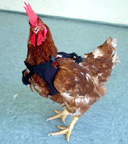
Eggheads Invent Tele-Petting
"Researchers have developed a cybernetic system to allow physical interaction over the internet. The system allows touching and feeling of animals or other humans in real time, but it's first being tried out on -- chickens. Built by a wacky group of researchers at the Mixed Reality Lab at the National University of Singapore, the Touchy Internet works as follows: You walk into your office, where a hollow, chicken-shaped doll sits on a mechanical positioning table close to your computer. The doll whirs to life as soon as you switch on the system, duplicating the motion of a real chicken in the backyard whose movements are being captured by a webcam. Fondling the doll translates into touching the real fowl." Continue reading Eggheads Invent Tele-Petting by Lakshmi Sandhana, Wired, May 17, 2005.
Posted by jo at 08:05 AM | Comments (0)
May 17, 2005
Distributed Immersive Performance
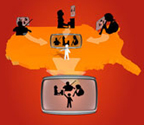
Real-time, Multi-Site Performance
The Integrated Media System Center (University of Southern California) is working on the architecture, technology and experimental applications of a real-time, multi-site, distributed, interactive and collaborative environment called Distributed Immersive Performance (DIP). The objective of DIP is to develop the technology for live, interactive musical performances in which the participants - subsets of musicians, the conductor and the audience - are in different physical locations and are interconnected by very high fidelity multichannel audio and video links. DIP is a specific realization of broader immersive technology - the creation of the complete aural and visual ambience that places a person or a group of people in a virtual space where they can experience events occurring at a remote site or communicate naturally regardless of their location.
Posted by jo at 10:03 AM | Comments (0)
May 13, 2005
Visual Identity and Virtual Community

From Avatars to Webcams
"Introduction: Identity plays an inherent role in defining our social interactions. In face-to-face communication, many physical cues exist with which to convey our identity and our intentions. In the realm of computer-mediated communication, identity becomes a much more ambiguous conception. Traditional platforms for online interaction are largely defined by language and text, stripping away many of the visual cues that we are used to. What are the ways in which visual identities are manifested online? This paper will explore some key issues related to visual identity in virtual communities, with a focus on avatars and webcams, and how traditional notions of identity may be transformed by these emerging modes of online representation." From Visual Identity and Virtual Community by Karyn Y. Lu, Atopia: Polylogic E-Zine.
Posted by jo at 03:44 PM | Comments (0)
May 05, 2005
LIVE FROM PARADISE
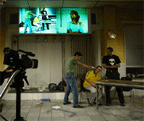
Three Venues, Four Performances
Nine people in three different cities perform together in one single production. An empty shop in Birmingham, a disused church in Colchester, a former courtroom in London merge to become a fourth imaginary space. Three audiences, one in each city, witness the performance simultaneously.
Live from Paradise is a global internet project that breaks new ground in live performance. The show takes place in three different locations which are linked by video streaming to create a simultaneous combined performance, telling a story that uses cinematic language to create a fourth imaginary space. In each place the audience witnesses a live performance and a large-screen video projections from the other two venues. The resulting single narrative is like a report transmitted from somewhere metaphysical – live from paradise. SATURDAY 21 MAY to SATURDAY 4 JUNE [no performance on 23 May] at 7:30pm
Station House Opera’s Live from Paradise is a co-production with De Daders, Amsterdam and premiered in October 2004 performed simultaneously in three apartments across the city. In 2006, Live from Paradise will be presented in three cities in Europe and finally at three locations on three different continents.
LONDON
The Courtroom
Toynbee Studios
28, Commercial Street
London E1 6AB
Box Office: 07952 769633
http://www.stationhouseopera.com
COLCHESTER
Presented by Colchester Arts Centre
ST. Martins Church
West Stockwell
Colchester CO1
Box Office: 01206500900
http://www.colchesterartscentre.com
BIRMINGHAM
Presented by Fierce
Level 3
The Mailbox, Wharf Side
Birmingham B1 1 XL
Box Office: 08707301234
http://www.fierce.info
Live from Paradise is produced by artsadmin Funded by Arts Council of England
Contact Judith Knight email: judith[at]artsdmin.co.uk
tel: +44 (0) 20 7247 5102 fax: +44 (0) 20 7247 5103
Artsadmin, Toynbee Studios, 28 Commercial Street, London E1 6AB
http://www.artsadmin.co.uk
http://www.stationhouseopera.com
Posted by jo at 09:48 AM | Comments (0)
April 29, 2005
Demotic

Pertaining to the Everyday
Demotic--by Antoinette LaFarge + Robert Allen--is a performance work about American Memory, a single character whose many voices are woven together into a complex texture of language, sound, and music. It is an improvisation among different kinds of performers and different modes of reality, involving sound artists, a theater actor, and a group of Internet-based performers who improvise with text. As an ensemble work in which actors, avatars, and musicians find the music within a wide range of online voices, it is a kind of covert national anthem.
Demotic premiered at the Beall Center for Art and Technology, Irvine, CA, on July 29, 30, and 31, 2004. It was broadcast by KUCI 88.9 FM in Irvine on July 31, 2004, and all three performances were webcast live by UCI and Location One gallery, New York via RealMedia streaming audio.
Posted by jo at 07:45 AM | Comments (0)
April 28, 2005
The Passion of Henry
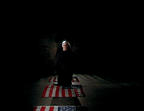
"Power is the Ultimate Aphrodisiac" - Henry Kissinger
Jerry Snell proudly presents his new collective creation: The Passion of Henry, an industrial performance event denouncing over 40 years of international terror. The result of a research and creation residency at SAT, The Passion of Henry will be presented April 28 & 30 at 8pm. Artist, director and composer for dance, theatre, cinema and circus, Jerry Snell’s new collective creation fuses all these elements, collaborating not only with artists from Canada but also from China, Vietnam, Japan, Netherlands, Belgium and Chile. The Passion of Henry excavates the mind of Henry Kissinger, mythical icon of international hypocrisy of the American political society.
Integrating 5 video screens and mixed with archive materials, live music and performed on stage by actor Pascal Dabe from Belgium, The Passion of Henry presents a sarcastic and cruel reflection of our contemporary world. Henry Kissinger: Nobel Peace Prize recipient, mass murderer, anti-Christ or playboy?
Participants include: Pascal Dabe (actor), Michel F. Côté (composer), Lorne Brass, Thien Vu Dang, Martin Laporte, Yasuko Tadokoro (film and video), Pascale Montpetit, Kurt Chen, Goos Meeuwsen and Alacanté de Chilé (virtual performance),
Posted by jo at 07:47 PM | Comments (0)
UpStage
![]()
Next Two Sessions
The next open session in UpStage will happen on Wednesday 4 May, and we're doing two sessions again, so pick the time that works best for you:
First Session: 5am New York; 9am UK; 11am Western Europe; 12 noon Finland; 9pm NZ. Second Session: 4pm New York; 8pm UK; 10pm Western Europe; 11pm Finland; 8am Thursday 5th NZ.
Check http://www.worldtimeserver.com for your local time. If you want to join us as an audience member, come directly to: http://upstage.org.nz:8081/stages/presentation.
If you want to log in and play, email me first for a username and password, then go to: http://upstage.org.nz:8081 and log in.
Posted by jo at 07:16 AM | Comments (0)
April 26, 2005
Video Conferencing Software as a Performance Medium

Is There No There There?
"ABSTRACT: This paper surveys past performances in which the author collaborated with several other dancers, musicians, and media artists to present synchronized co-located performances at two or more sites. This work grew out of the author's participation in the landmark computer music ensemble, "the HUB". Each of the various performances were made possible by an evolving array of video conferencing hardware and software. These will be discussed. The problems and interesting side effects presented by latency and dropouts are a unique part of this performance practice. Leveraging the concepts of shared space, video and audio feedback generate evolving forms created by the combinations of the space, sounds and movements of the participants. The ubiquity of broadband Internet connections and the integration and constant improvement of video conferencing software in modern operating systems, makes this unique mode of performance and essential area of research and development in new media performance." From Video Conferencing Software as a Performance Medium by Scot Gresham-Lancaster.
Posted by jo at 10:31 AM | Comments (0)
The HUB

One Instrument, Many Parts
The HUB, a group of composer/performers, were among the first to practice network music. The Hub is a computer network band. Six individual composer/performers connect separate computer-controlled music synthesizers into a network. Individual composers design pieces for the network, in most cases just specifying the nature of the data which is to be exchanged between players in the piece, but leaving implementation details to the individual players, and leaving the actual sequence of music to the emergent behavior of the network.
Each player writes a computer program which make musical decisions in keeping with the character of the piece, in response to messages from the other computers in the network and control actions of the player himself. The result is a kind of enhanced improvisation, wherein players and computers share the responsibility for the music's evolution, with no one able to determine the exact outcome, but everyone having influence in setting the direction.
The Javanese think of their gamelan orchestras as being one musical instrument with many parts; this is probably also a good way to think of The Hub ensemble, with all its many computers and synthesizers interconnected to form one complex musical instrument. In essence, each piece is a reconfiguration of this network into a new instrument. (Perkis)
The Hub, formed in 1984 in and around San Francisco, by Tim Perkis, John Bischoff, Scot Gresham-Lancaster, Phil Stone, Chris Brown, and Mark Trayle, used a network approach to improvisation, where each player controlled an aspect of the same compostion.
Posted by jo at 09:30 AM | Comments (0)
April 25, 2005
Geometries of Power
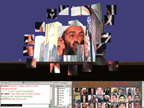
Online Multi-User Event between Boston and Munich
Tamiko Thiel is developing a theory of dramatic structure for virtual reality that merges concepts of structured experience from music theory, drama and urban planning together with the possibilities for user engagement and immersion provided by first-person interactivity. On May 1, 2005, Thiel will present her project Geometries of Power, a multi-user online 3D world that uses the interactive characteristics of space, geometry and sound to question concepts of power and control. Shared event VRML technology enables participants to collaboratively create a 3D visual environment in real time.
You may visit either of the two sites, the Goethe-Institut Boston/USA, or programangels/Lothringer13, Munich/Germany, or you can enjoy the experience in the privacy of your own Internet connection!
To participate on your own you need a WindowsXP PC (sorry, MACs don't work), a good Internet connection and to install the blaxxun VRML-Browser. For more information: Information: +1 617 262 6050 or beeke.tower[at]boston.goethe.org
Geometries of Power was developed during a workshop at the Bauhaus-University in Weimar, Germany.
Tamiko Thiel is an American visual artist of mixed Japanese and German heritage living in Germany who explores social and cultural uses of virtual reality. She has a B.S. in product design engineering from Stanford University, an M.S. in human-machine interface engineering from MIT and a Diploma in Applied Graphics from the Academy of Fine Arts in Munich. She lectures internationally on the creation of meaning in art and of dramatic experience in time-based and interactive media. Thiel is currently a Research Fellow at the Center for Advanced Visual Studies (CAVS) at the Massachusetts Institute for Technology.
Posted by jo at 07:36 AM | Comments (0)
April 20, 2005
d>Art.O5
![]()
Distributed Art
d>Art.O5 is the eighth edition of dLux media arts acclaimed annual showcase of recent Australian and International single channel, short experimental digital film and video, web and sound art. Under the sub-title "Distributed Art" d>Art.O5 will both focus on art forms that have an inherently distributed nature (web art, mobile phone art) and investigate new methods for distribution of digital art. (podcasting, BitTorrent, Bluetooth etc.).
d>Art.O5 will consist of an exhibition of sound, web, and mobile phone art and a screening program of experimental film and video art. The exhibition will take place at the Sydney Opera House Exhibition Hall in August/September 2005. The screening program will be presented during this same period.
dLux media arts is now calling for works for the following categories of d>Art.O5:
- d>Art.O5 Screen: Open to Australian citizens or permanent residents only
- d>Art.O5 Sound: Open to Australian and International artists
- d>Art.O5 Web: Open to Australian and International artists
During the exhibition the sound and mobile phone art will be available for distribution to the private devices (mp3 players, mobile phones) of the visitors. After the exhibition period, the sound and screen works will be distributed online through podcasting and BitTorrent, respectively. The web works will be presented in an online gallery on the dLux media arts website. All distribution will be under a Creative Commons Attribution-NonCommercial-NoDerivs License.
The call for entries closes on June 15th. Any entries not completed by this date will not be accepted. Entrants will be notified of the selection results by July 1st.
For more information and to make a submission to d>Art.O5, please visit http://www.dlux.org.au/dart05
Posted by jo at 09:38 AM | Comments (0)
April 19, 2005
Intimate Transactions
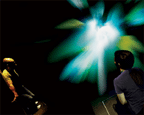
Embodied Experience For Two people in Two Locations
Keith Armstrong and the Transmute Collective invite you to book your own personal 1/2hr slot for the Australian Premiere of Intimate Transactions, a groundbreaking embodied, interactive experience for two people in two networked locations. Members of the public can experience Intimate Transactions for one week at QUT Creative Industries Precinct Brisbane and ACMI Melbourne commencing April 25 (details below).
The two participants will enter a space at each location that is equipped with a touch sensitive physical interface called a Bodyshelf, embedded with sensors that detect body movement and shifting of body weight. Before getting onto the Bodyshelf, each participant puts on a wearable device that passes gentle vibrations into their stomachs, enabling them to sense vibrations of different frequencies and intensities.
Each body movement influences an evolving world created from digital imagery and multi-channel sound, allowing the participants' bodies to become aware of the other's movements, despite the fact that they are geographically separated and cannot actually see or hear each other. Intimate Transactions is an ambitious new work from the renowned Australian Transmute Collective and collaborators, a group of internationally recognised media artists, performers, sound artists, programmers, scientists and furniture/interface designer.
The Melbourne/Brisbane event will be the Australian premiere of the work, following its international premiere at the New Territories International National Review of Live Art in Glasgow in February. ACMI Senior Curator Alessio Cavallaro said, "Intimate Transactions is an ingenious work that exemplifies both the fascinating developments in interactive moving image arts in Australia, and ACMI's leading role in introducing such innovative projects to broader audiences. Significantly, Intimate Transactions also demonstrates the importance
of ACMI's partnerships with artists and research centres to extend the creative application of new technologies and delivery systems."
The work has been developed in collaboration with the Australasian CRC for Interaction Design (ACID), QUT Creative Industries Research and Applications Centre (CIRAC), the RMIT Spatial Information Architecture Lab, and the Australian Centre for the Moving Image, Melbourne. Intimate Transactions will be presented simultaneously between the Queensland University of Technology Creative Industries Precinct, Brisbane, and ACMI, Melbourne. It is a featured work of the Australian Innovation Festival.
Dates: 25 April - 1 May 2005
Time: Mon 25th : 12pm=965.30pm,
Tues 26th =96 Sun 1st 10am=965.30pm
Admission Free - BUT Bookings Essential - Book your own personal 1/2hr slot at each venue.
Locations:
In Brisbane @ The block, Creative Industries Precinct, Cnr of Kelvin Grove Rd and Musk Ave, Kelvin Grove, Brisbane
FOR BOOKING ph. 07 3864 5495 e: kb.harding @ qut.edu.au
In Melbourne Screen Pit, Ground Floor, Australian Centre for the Moving Image at Federation Square, Flinders St, Melbourne
FOR BOOKING ph. 03 8663 2574
Posted by jo at 09:48 AM | Comments (0)
April 16, 2005
prayingproject
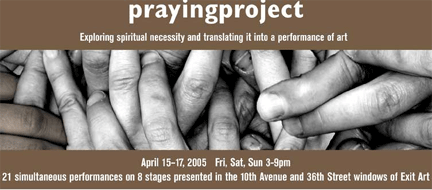
LIVE STREAMING - *praying project*
EXIT ART: April 15 - 17, Fri Sat Sun 3 - 9pm
Go to website then click on gray box below left that says: *Live Streaming prayingproject*
Posted by jo at 11:33 AM | Comments (0)
Global Pong
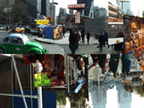
A Networked Babelogue Between Four Cities
Global Pong was a live dialogue on urbanism comparing local observations in New York City, Mexico City, Shanghai and Berlin, mediated through text fragments translated on-line into four languages. Texts were read live by a native speaker in its original language, cycled through four online translators projected as giant text banners, and then spoken again. Meanings shifted similar to a game of telephone ("teléfono descompuesto", "stille post"), and the four speakers added comments in their native language on each passing paragraph with keywords added into the translation cycle. Readers in this organic exchange of ideas included Vito Acconci, Andrés Oriard, Fu Xinian and Kai Vöckler.
Accompanying the texts were live video and sound components emanating from the four locations. Ralske created a visual interpretation/video collage from live webcam feeds. Composers in the four cities remotely contributed to a live ambient sound performance in which music files were passed along in an exquisite corpse style and "translated" similar to the textual work.
Posted by jo at 10:51 AM | Comments (0)
April 01, 2005
Video-matic.nl

Mix Your Own
Video-matic.nl is an interactive video installation by Olga Mink. The projection is visible from both inside and outside the building. Interactivity is a crucial part of this installation, and is accomplished via the Internet or a touch-screen located in the main hall. The 'spectator' is invited to create a VJ-mix that is uploaded to the server in Sint Oedenrode. An automated video database ensures an ongoing supply of images, which makes this installation a dynamic piece of work evolving over time. There is a real synergy between image, light and the environment. [via Rhizome]
Olga Mink (Visual.Girlbot.Facility) is active as an artist in the Netherlands. She obtained her MFA at the Sandberg institute (Amsterdam). Next to art-projects she is a video-performance artist. Faster than the speed of light she takes the audience to unexplored areas, and shows them her abstract visual landscapes and rhythmic image-architecture.
The technical part of the installation is realized by Jilt van Moorst (NL). Jilt Van Moorst is a software-developer and graduated from the HKU (Art, Media & Technology). He also performs as Robotfunk and developed a VJ-tool called 'Flowmotion'. This sophisticated piece of software is used by VJ's allover the world.
Posted by jo at 08:27 AM | Comments (0)
trans-mute

Filling in the Blanks
"Performance artist Daniela Sneppova’s text trans-mute has been published in the online journal ephemera as an interactive reading/translating experience. The following introduces the essay of her process oriented experiment - showing an understanding of the performative in general as an active communicative process...
"This textual representation moves between the inspiration – the triggers that led to the creation of the performance – and a description of what the audience participated in. The blacked out, missing text performs a number of functions. It refers to the acts of censorship by many Eastern European countries before the fall of Communism: Censors frequently obscured words or phrases in personal correspondence sent between nations, families and friends. [blogged by mo--ka on mind_ _the GAP*? ]
The missing text also seeks to reproduce the gaps and silences of translation. It is difficult to discern what is left out of a translation. We take for granted that what is missing from a translated text. However, I am interested in the cumulative effects of these ‘minor’ absences. Thus the invisibility of absence is something that is explored in the on-line project. The on-line project offers a different kind of text with which the user must actively engage; an environment of sound and images that responds to mouse movements and clicks. The blacked out text is meant to remind readers of the on-line dimension of this project. Readers will always make connections when reading any text; in this article that process is exaggerated, encouraging readers to ‘fill in the blanks.’"
This on-line version of trans-mute is an integration of a text translation and a digital translation of a performance that took place in Barcelona, 2002.
Posted by jo at 07:11 AM | Comments (0)
March 30, 2005
Phonic Frequencies:
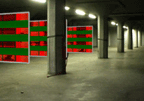
Shaping Networked Realities
ABSTRACT: The paper introduces a networked multi-user installation and interactive mixed reality environment that combines the fields of interactive art, telecommunication and streaming technologies. Phonic Frequencies is an audiovisual data space whose appearance can be altered via networked communication devices. Visitors are active agents and participate in shaping spaces as they control audiovisual data with their telephones.
Linking the physical space to the digital network space, Phonic Frequencies opens a hybrid reality for distributed sound exchange and visual communication, blurring the boundaries between verbal communication and digital information. The work attempts to break the conventional communication cycle of bidirectional dialogue and to consider the meaning of in- and output from a different perspective." From Phonic Frequencies: Shaping Networked Realities by Tamas Szakal, Christoph Groenegress, Wolfgang Strauss, Predrag Peranovic (c) 2003
Posted by jo at 07:40 AM | Comments (0)
March 29, 2005
Switch Interview with Victoria Vesna
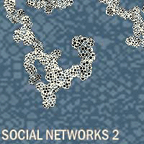
Extending Our Influence Beyond Our Local Spaces
"Inna Razumova: The Web is an ephemeral, virtual medium that is associated with the mobility, manipulability, and transformation of data. Web is also one of this culture's primary places for a fetishization of the body. (spy cams, pornography, dating networks, avatar-based chat rooms, etc.). In your opinion, why is a medium that functions mostly through disembodiment so fascinated with the idea of body?
Victoria Vesna: It is because our bodies do not only consist of embodied, physical parts and our minds are not separate from our bodies and we are not separate identities. I do not consider this an opposition (idea of body/disembodiement), but a return to learning that we have etheric bodies, and can make telepathic connections to others on the other side of the planet. It is very empowering to have a sense of connection to someone who shares your ideas, whatever they may be, and feel a physical sensation in relation to this...The Internet provides a space for exploring our many identities, and experimenting with ideas of extending our influence beyond our local spaces." From Interview with Victoria Vesna by Inna Razumova, May 15 2001, Switch, Issue 16.
Posted by jo at 02:11 PM | Comments (0)
Liquid Gold
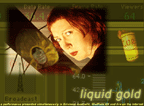
An Artery of Liveness
Liquid Gold--by the Transmute Collective--was a live performance event that spanned the globe, using the Internet to link several sites and audiences into one entire 'net-worked' performance. It consisted of several intensely quirky performances, accurately coordinated across multiple time zones. Liquid Gold demonstrated a new kind of net-work, using the Internet as the artery that spreads a new performance experience of networked 'liveness' across the world.
Liquid Gold brought together filmmakers, artists, musicians, network specialists and writers to make a new work of live art both in real space and throughout the global electro-o-sphere. It employed a custom built chat server ('idea animator'), running in the physical live venues and on all Internet located audience's browsers. This allowed writers in both Australia and England to describe what they saw locally in their own performance venue - putting back some of the 'liveness' lost through the lo-fi images and sounds the web currently allows.
Liquid Gold used its novel approaches to present one woman's journey of reconciliation - a trip that will allow her to reconcile the ghosts of her chequered past and travel towards the new futures that her vivid imagination are now making possible.
Performer Lisa O’ Neill, in the persona of adventurer and strong woman 'Ling Change', was filmed live on video as she traveled throughout the stunning internal landscapes of the Brisbane Powerhouse Centre for the Live Arts, an old industrial site now converted into a major arts complex.
Her journey proceeded from the depths of the 'turbine room' and finished in the dramatically patterned glass of the main atrium.
Video imagery of this journey was streamed live across the Internet to Site Gallery, Sheffield, England. There an assembled audience watched as Keith Armstrong directed the work, mixing the Australian streamed vision with further performance vision and audio, unfolding a bizarre narrative which developed in real time between the live and pre-edited footage.
The two steams of video (From Brisbane, Australia and Sheffield, England) were projected upon adjacent screens in both the physical spaces, with the audiences 'editing' their own performance from these two images.
The work was webcast live for online audiences and incorporated a custom interactive chat facility, called an 'idea animator'.
LIVE WEB CAST: The live webcast showed prerecorded footage of the main character ('Ling Change', performed by Lisa O'Neill) traveling through animated landscapes mixed live with the images from the live performance in Brisbane. This mix was undertaken by the show's artistic director Keith Armstrong in Sheffield. All original sound for the show was composed by Guy Webster.
These dual narratives showed Ling's journeys in some past time, and now in the present, as she moved through strange industrial landscapes. (filmed live in the striking industrial interiors of the Brisbane Powerhouse). Hence audiences were asked to construct the narrative online, as the characters' actions shifted from virtual to actual architectures"
Online viewers with high specification machines and plenty of bandwidth could enjoy the luxury of participating in both the video stream and interactive chat dialogue, whilst also surfing background information. The video stream was kept as minimal as possible to avoid excluding other users on slower computer systems.
IDEA ANIMATOR: The 'liveness' of this work, particularly for the web-based audiences, was enhanced by a idea/animator/custom chat server which allowed two writers, situated both in Brisbane and Sheffield, to comment in real time upon their impressions of the performance as they saw it evolving in their respective venue.
The writers at each physical venue referenced performers, imagery, audience, environment and global communication. Remote viewers, and those present at each venue, watched the writers words appear in real time on their screens alongside the performance imagery. Throughout this poetic dialogue key words/ideas were extracted from each writer's texts and became animated upon a large projection screen.
This idea animator software, designed and constructed by Gavin Sade, allowed keywords and ideas to float onto the screen and animate.
When online users logged in their presence was seen by all those also logged via the Internet along with those audiences present at the two live venues. Online users could participate by selecting words already animating on the screen by clicking upon them... this caused the ideas/words to regroup and grow according to the online audience interactions. [Related]
Posted by jo at 12:17 PM | Comments (0)
March 25, 2005
Eliza Redux

A Robot Who Talks Too Much
Eliza Redux--by Adrianne Wortzel--is an interactive telerobotic web site providing a space for text-to-speech and oral discourse, acting out, and playfulness in the virtual environment of a psychoanalyst's waiting room and inner office. Video and audio of a real physical robot is streamed to the web reactive to visitor text input. Issues of control and lack of control become paramount for the user. Wortzel is implementing ways to bring Weizenbaum's original 1966 ELIZA program into the 21st century.
Wortzel is seeking a computer science professional or student in the New York City area who can lend his/her skills to an internet-broadcast robotic art installation. She is looking for a developer to facilitate communication between clients running flash applications, a server database, and an extremely talkative robot.
Job Requirements:
- SKILLED DEVELOPER in jsp, flash, xml.
- Be able to learn a pre-existing set of commands from the robot control interface.
Ideally, you will also
- Have understanding of database retrieval & modification
- Patiently explain technology needed to execute high-level art ideas
- Be willing to troubleshoot & debug until things work right, everything from web-cams to multiple socket connections.
Job length: Immediate start, completion deadline -end of May.
You will receive at the very least a $500 stipend, and experience/credit in a robotic art installation bound for gallery showing. An article about the project is coming out in the June issue of the prestigious Journal: Leonardo. Plus, you'll get to work in a tech-decked paradise lab with fun people and an even more fun humanoid robot. Even if you don't have all the skills outlined above, we're very interested in hearing from people who are enthusiastic & quick at learning. To apply, contact Prof. Adrianne Wortzel at muse(at)cooper.edu or cell: 646-567-9648
Posted by jo at 01:19 PM | Comments (0)
March 24, 2005
John D. Mitchell + ADaPT
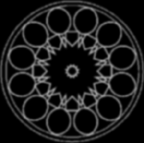
Expanding Sensory and Creative Experiences
John D. Mitchell is a multi-disciplinary composer, educator and researcher committed to using technology for expanding sensory and creative experiences in the arts and education. He has worked with artists from around the world to design and realize projects ranging from multimedia dance archives to interactive multi-site distributed performances.
ADaPT, initiated in December 1999, was the brain child of Mitchell while working under the auspices of the Institute for Studies in the Arts at Arizona State University. ADaPT originally included researchers and information technology specialists from five institutions: Arizona State University, The Ohio State University, The University of California, Irvine, The University of Utah, and The University of Wisconsin, Madison. Over the years ADaPT has expanded to include partners in other countries on four continents.
In 1987, Mitchell and choreographer Gary Lund created Movement Initiated Sound Events (MISE), one of the earliest dance works to use a personal computer and optical sensors for creating a completely interactive, performer driven sound score. Over the next three-years Mitchell and Lund produced several dance-driven, interactive multimedia works for the stage, often collaborating with visual artists and live musicians.
Upon joining Arizona State University in 1990 Mitchell became a founding member of the Institute for Studies in the Arts. At the Institute, Mitchell was instrumental in pioneering the development of the Intelligent Stage – both as a concept and a facility – where he continued to work for the next ten years as a composer, director and interactive media designer. Mitchell has collaborated with numerous artists to create performance works that have been staged throughout United States and abroad.
Mitchell currently directs the graduate emphasis in Dance and Technology and teaches interdisciplinary media and telematics courses in the Department of Dance at Arizona State University. See Using Human Movement to Control Activities in Theatrical Environments by Robb E. Lovell and John D. Mitchell.
Posted by jo at 12:56 PM | Comments (0)
Blast Theory presents Can You See Me Now?
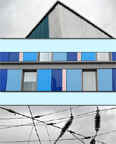
Join the Hunt
Played online and in the streets, BAFTA-nominated Blast Theory challenge you to a game of cat and mouse around a virtual map of Cambridge. Log on using the public terminals situated in the Junction's new café bar or play online at canyouseemenow and be dropped in at a random location from where you must avoid capture by the Blast Theory 'runners'.
Eavesdrop on your pursuers' conversations and swap tactics with other players as Blast Theory (as real actors positioned on the real streets of Cambridge) hunt down your virtual presence with the aid of handheld computers and GPS technology. FREE to play. April 1st-3rd 2-5pm; April 6th-8th April 4-7pm at The Junction, Cambridge.
Artists' Workshop: April 6th 1-4pm; £5/£4 concessions
The player is a key feature in all Blast Theory's work. This afternoon workshop will look at how the audience engages directly with an artwork, in dialogue with other 'players' and the artists.
Using the player as a focus, participants will respond creatively to site/space, game structure and forms of media/communication technologies to inform and stimulate their own media and performance practice. Finally all participants are welcome behind the scenes at 4pm to look at the hardware, software and performance preparation of 'Can You See Me Now?' Blast Theory's award-winning interactive game, presented by the Junction.
Suitable for artists looking to expand their understanding on new performance technologies, participants should come prepared to move, draw and talk.
To book a place call the Junction box office on 01223 511511 or visit in person at The Junction, 2 Clifton Way, Cambridge, CB1 7GX. [via DAN]
Posted by jo at 11:42 AM | Comments (0)
March 22, 2005
LF:TK Experiments in Telematic Dancing
[CLICK ON IMAGE: You'll need Quicktime to view this movie] Experiments in Connected Social Spaces - LF:TK - Kinetic Live Art through the Internet.
Posted by jo at 07:38 AM | Comments (0)
March 21, 2005
THREE CITIES
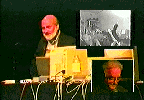
MULTIMEDIA TELE-CONCERT
Featuring Morton Subotnick, David Rosenboom, Steina Vasulka with Leo Smith and J.B. Floyd. The three part evening began with a performance by Morton Subotnick, in New York, who played the Yamaha Disklavier in Santa Monica using finger controlled midi triggers. The second part of the evening was a bi-coastal tele-collaborative concert between David Rosenboom, Dean of the CalArts School of Music in Santa Monica, and pianist B. Floyd and trumpet player Leo Smith in New York City. In each city there were two Disklavier pianos, the one played by the local artist, the second one playing the notes activated by the pianist in the other city. The third part of the evening featured Seina Vasulka in Santa Fe playing a MIDI violin which controller laser videodisk players in both New York and Santa Monica.
As she played her violin in Santa Fe she controlled and selected sections of the videodisk showing her playing the same piece 20 years earlier. Also during the course of the evening we took the Santa Monica and New York audiences through a tour of Netscape-based World Wide Web sites on the Internet and discussed the implications of performing artists disseminating their work and working together through this medium. This is an example of many years of collaboration between ECI, Mort Subotnik, David Rosenboom, Mark Coniligo, and CalArts. This collaboration continues with the hope of showcasing at least one "State-Of-The-Art Tele-collaborative Music Performance a year working with the leading avant-garde musicians of our time. See additional Electronic Cafe projects from 1984-1998 here.
Posted by jo at 07:37 AM | Comments (0)
March 18, 2005
Postdigital Remix Culture and Online Performance
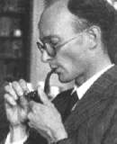
The Ends of Performance
"Peggy Phelan writes on the intersection between knowledge and the medium of the Internet in her introduction to The Ends of Performance [Phelan and Lane, eds. 1997]. Reading and thinking about some of her ideas there started me on a trajectory of thought about performance in cyberspace which has culminated in this website.
The electronic paradigm as an epistemic event represents something more than a new way to transmit information; it redefines knowledge itself into that which can be sent and transmitted… Performance studies, precisely because it has struggled so rigorously with the perils of preservation and the treacheries of transmission, is alert to the Net's potential to flatten and screen that which we might want most to remember, to love, to learn [Phelan and Lane, eds. 1997, p. 8].
On the surface, Phelan's point here seems valid -- many important performative dimensions of human communication are lost in network transmission. Eye contact and body language, for example, are not readable through email, and listening to a webcast is clearly not the same experience as being at a live concert." Continue reading >> [from Postdigital Remix Culture and Online Performance by John von Seggern]
Posted by jo at 05:56 PM | Comments (0)
March 15, 2005
IN Network

Sleep Webcast
April 15, 2005: From their bedtime at 11PM in Los Angeles, and 2AM in New York, until they wake eight hours later, the artists Michael Mandiberg and Julia Steinmetz will sleep together on the phone. Separated by three time zones and 3000 miles, they curl up in the same sonic space. Connected via cell phone, they will hear the sound of each other breathing, tossing and turning, snoring, etc. This audio will be webcast in real-time as they sleep.
IN Network Sleep Webcast Schedule:
Tuesday, April 15th, roughly 11PM PST to Wednesday, April 16th, roughly 7:30AM PST; Wednesday, April 16th, roughly 9PM PST to Thurs, April 17th, roughly 5:30AM PST; Tuesday, April 22nd, roughly 11PM PST to Wednesday, April 23rd, roughly 7:30AM PST; Wednesday, April 23rd, roughly 9PM PST to Thurs, April 24th, roughly 5:30AM PST
This sleep webcast is part of IN Network their month long extended cell phone life-art performance about distance, communication, intimacy, telepresence, and living together while apart. In August 2004 Michael moved to New York; Julia remained in Los Angeles, postponing her move until the end of April because of commitments to her job and her collaborative art practice. Faced with most of a year apart, one of the things they did was switch both of their cell phones to a provider with free "IN Network" service.
Michael and Julia started out having normal conversations, giving each other updates about their days, and sending cameraphone pictures back and forth, etc. As they switched to using hands-free microphones, they began using the phone differently. What began as a pragmatic attempt to make their relationship last the separation through good communication, turned into something less about communication and more about intimacy and presence through technology, and sharing sonic-virtual space.
During the month of March the artists are presenting this cell-phone life-art performance via a Photo Moblog and Podcast on Turbulence.org. In addition to these webcasts, the IN Network site will host a Podcast of recordings of their phone conversations, and all of their text and picture messages.
IN Network Sleep Webcast:
http://turbulence.org:8080/ramgen/encoder/mandiberg.rm
Free Real Player (Required for webcast):
http://www.real.com
IN Network Website
http://turbulence.org/works/innetwork
IN Network Podcast (RSS 2.0 Feed)
http://turbulence.org/works/innetwork/mp3/rss.xml
Contact Info
juliasteinmetz -at- yahoo -dot- com
michael -at- mandiberg -dot- com
IN Network is a 2005 commission of New Radio and Performing Arts, (aka Ether-Ore) for its Turbulence web site. It was made possible with funding from the Jerome Foundation.
Posted by jo at 01:05 PM | Comments (0)
March 14, 2005
MARCEL
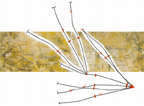
Interactive Network
MARCEL is a permanent broadband interactive network and web site dedicated to experimentation and research across the fields of art, science, education, technology and industry.
The network is made up of research centres, media labs, museums, arts organisations and arts practitioners who facilitate research, projects and collaborations which make use of high bandwidth networks - looking towards a future where fully interactive, virtual online experiences are as commonplace and user-friendly as today's relatively static internet.
Jerome Turner is the new researcher for the MARCEL Resources database, which will provide information on MARCEL related fields, events, projects and developments. If you would like to be included in the database, or suggest relevant material, go to MARCEL to find out more or email jerometurner(at)dsl.pipex.com
Posted by jo at 05:30 PM | Comments (0)
300 Square Mile Recording Studio

Teleconcert
In 300 Square Mile Recording Studio, Stanford University's student Mariachi Ensemble performed in a live, distributed recording session as part of the Fall AES Meeting in San Francsico. Three sites in the Bay Area (map) were connected for this professional audio "teleconcert" collaboration. The audio signals were transported with extremely low latency using research software and regional internet (CENIC).
Three musicians in each of the three sites performed together for a Halloween session on October 31, 2004. The main stage was at Genentech Hall on the new UCSF campus, and the two other trios were located at UCB (CNM) and Stanford (CCRMA). 300 Square Mile Recording Studio was a co-production of Chris Chafe, Jason Bryant and the SoundWIRE group at CCRMA.
Posted by jo at 07:19 AM | Comments (0)
March 10, 2005
Co-Opticon
![]()
Democratic Optics
The Co-Opticon (a.k.a. the ShareCam) is a machine for democratic optics, allowing a network of participants to cooperatively control the viewpoint of a shared video camera. The co-opticon combines a networked robotic video camera with a graphical user interface that allows many internet-based viewers to share simultaneous control of the camera by specifying desired viewing frames. Algorithms compute the optimal camera frame based on all requests, and position the camera accordingly.
Posted by jo at 05:38 PM | Comments (0)
March 02, 2005
YellowArrow at DiVA
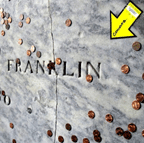
Art in Motion
Digital and Video Art Fair [DiVA] kicks off with an opening after party on March 10th that will definitely be an event in itself. The party will feature special performances by YellowArrow. Attendees are invited to participate in the art in motion. In addition to YellowArrow stickers’ distribution and projections displaying the content of the YellowArrow Global Gallery, mobile YellowArrows will point out a series of live micro performances staged throughout the party and announced via TXT messaging.
DiVA is the first art fair in the United States dedicated exclusively to digital and video art. DiVA will serve as an international destination for collectors, art dealers, museums, curators, and artists. Around forty galleries willfeature the diverse and innovative work of new media artists exploring and pushing the digital envelope. Digitally created work is a dynamic platform of expression in contemporary art that includes film and video, animation, photography, printmaking, sculpture, painting, architecture, and performance.
The YellowArrow is a global public art project that merges graffiti and sticker culture with wireless media, creating an interactive forum for people to leave and discover messages pointing out what counts in their environment.
Participants place arrows to draw attention to different locations and objects -- a favorite view of the city, an odd fire hydrant, the local bar. Each arrow has a unique code, and by sending a text-message (SMS) from your mobile phone to 1.646.270.5537 in the format "+code your message" you associate a short text with your arrow -- messages can range from literary quotations to personal commentaries to game-like prompts to action.
When another person encounters the arrow, he or she sends "code" to 1.646.270.5537 and immediately receives the message associated with it on their mobile phone. Through this location-based exchange of text-messages, the YellowArrow becomes a symbol for the unique characteristics, personal histories, and hidden secrets that live within our everyday spaces. And it's not just places, it's people: YellowArrow TXTshirts are individually coded just like the stickers.
YellowArrow text-messaging is currently compatible with all phones and service providers in the US as well as internationally with those networks under the GSM standard. The website, YellowArrow.org, allows participants to annotate their arrows with photos and maps and is the online gallery of YellowArrows placed throughout the world -- visit to order arrow stickers and tshirts and see announcements about new events and features.
Posted by jo at 11:16 AM | Comments (0)
March 01, 2005
IN Network

Living Together While Apart
IN Network--by Michael Mandiberg and Julia Steinmetz--is an extended cell phone life-art performance about distance, communication, intimacy, telepresence, and living together while apart. Faced with the prospect of a long-distance relationship when Michael moved from Los Angeles to New York in August 2004, the two artists got their frequent flyer numbers handy, and switched both of their cell phones to a provider with free "IN Network" service.
During the month of March the artists will present this cell-phone life-art performance via a photo moblog and podcasts of their phone conversations. There will also be several live webcasts of audio of the artists sleeping together on their cellphones. They will route all of their text and picture messages through the IN Network website. If you'd prefer, you can have installments of the performance sent directly to you via their Podcast. How to Podcast?.
"IN Network" is a 2005 commission of New Radio and Performing Arts, (aka Ether-Ore) for its Turbulence web site. It was made possible with funding from the Jerome Foundation.
BIOGRAPHIES
MICHAEL MANDIBERG is a new media artist who uses the internet, video and performance to explore subjectivity, labor, and commerce. His projects include "Bush Poll," a statistical survey of the 170 George Bushes of the United States, 2004; the DVD exhibition "First Person" in collaboration with Carla Herrera-Prats and Anne-Julie Raccoursier, 2003; and "The Exchange Program," a collaborative performance, 2002. Mandiberg has exhibited at Ars Electronica Center, Linz, Austria; ZKM in Karlsruhe, Germany; Transmediale Festival, Berlin; Tirana Biennale, Albania, and C-Level, Los Angeles. His work has been reviewed in The New York Times, The Chicago Tribune, The Berliner Zeitung, Wired, and a new survey "Internet Art" published by Thames and Hudson World of Art. Mandiberg is Assistant Professor in the Department of Media Culture, at the College of Staten Island/CUNY. URL: http://www.mandiberg.com/; Contact: michael -at- mandiberg -dot- com
JULIA STEINMETZ is a founding member and co-director of the Toxic Titties, a Los Angeles based collective working in performance, video, photography, and new media. Their work has been performed at such venues as Museum On Contemporary Art, Seattle, REDCAT at the Walt Disney Concert Hall, Out Fest Film Festival Los Angeles, LA Freewaves festival and the Hammer Museum in Los Angeles. Titties have performed in events such as the "Intersectional Feminisms" conference at UC Riverside, CA and at "Outside Field: International Performance Festival" at Ex-Teresa Arte Actual, Mexico City, "Cyberfem Spirit," at Edith Russ Site for New Media, Oldenberg, Germany and at Schnitt Ausstellungsraum, Cologne. Their work has been written about in Tema Celeste, the Los Angeles Times, the LA Weekly, Mexico City's La Reforma, Black Book Magazine, and Kolner Stadtanzeiger. Toxic Titties performance documents and design work have appeared in "Gendered Geographies," edited by Kaucyila Brooke, and "SITE, Schinitt Austellungsraum" published by Krefeld, Germany. Their work in collaboration with Austrian artist Dorit Margrieter was recently featured at MUMOK in Vienna. Contact: juliasteinmetz -at- yahoo -dot- com
Posted by jo at 11:53 AM | Comments (1)
Internet2:
Orchestrating the End of the Internet?
"Anyone who wonders how the Internet will die will find one possible scenario in the recent decision by the Internet2 consortium to bring Hollywood into the design process for our next-generation Internet.
Hollywood is on a roll. In a fraction of the time that it took the music industry to emasculate Napster, the Motion Picture Association of America has managed to shut down the highest profile file-sharing sites (Suprnova and LokiTorrent) and begun to sue its own share of college students. More importantly, the MPAA recently persuaded Congress to legislate something their fellow lobbyists in the music industry never managed to achieve: a copyright control device in every player. By this July, every DVD player and TiVo box will sniff for a "broadcast flag" that prevents it from copying digital TV broadcasts. This hardware intervention effectively destroys even the possibility of fair use, since artists and educators cannot transform, parody, or criticize what they cannot record. [via Rhizome]
The Electronic Frontier Foundation is mounting a noble campaign to grandfather a compliant tuner before the legislation takes effect [1]--but in the meantime the MPAA has set its sights on its next acquisition: the ultra-high bandwidth Internet2, which runs on the 10 gigabit per second Abilene backbone:
"We've been working with Internet2 for a while to explore ways we can take advantage of delivering content at these extremely high speeds, and basically manage illegitimate content distribution at the same time," said Chris Russell, the MPAA's vice president of Internet standards and technology. "Those would go hand in hand." [2]
To judge from the statements of Internet2 bigwigs, their technologists have already capitulated before the battle has even begun:
"This wraps together the broad interest we have in working with our members and potential members on advanced content delivery," said Internet2 Vice President Gary Bachula. "Obviously we're interested in making sure that's legal and safe." [2]
The presentations I've seen to date from the Internet2 consortium, from music classes taught by "master" conductors [3] to biometric and authentication applications for "managing identity" [4], suggest that Internet2 is a broadcast organization in network clothing. While it's doubtful that everyone at work on Internet2 shares this vision, the consortium's choice to "collaborate" with the MPAA could give media conglomerates a chokehold on the 21st-century Internet.
The stated goal of this collaboration--to investigate new business models for streaming movies--sounds reasonable until you read that Internet2 is already capable of transmitting a DVD movie from Switzerland to Tokyo in under 5 seconds. (Cut to Jack Valenti choking on a bagel as he reads this in the morning paper. [5])
No Hollywood exec is going to sanction a business model that lets Joe User download a movie onto a hard drive faster than the time it takes to launch his Web browser. Forget streaming video on demand. Hell, that isn't even enough time to watch a BMW ad.
The technology behind Internet2 *breaks* anything remotely resembling a broadcast business model, which is why the MPAA will do its best to disarm the technology by installing Digital Rights Management directly in its routers to stop interesting content from ever getting into the pipeline.
Now, the idea of "intelligent routers" may sound appealing to the average Congressperson, but the technologists of Internet2 should know better. Internet 1 was able to adapt so quickly to new uses--from email to the Web to IM--because its routers are fundamentally *dumb*. As engineer David Reed and others argued in the late 1970s [6], an indiscriminate "end-to-end" network would allow its users to hook up ever faster and more capable computers to its endpoints, without locking out uses that the network's architects could not have foreseen. Broadway was built for horse-drawn carriages, but since then its level pavement and wide footprint has accommodated Model Ts and Toyotas--precisely because its architecture was not optimized for carriages. Even companies like Disney and Microsoft have publicly recognized the importance of e2e to technological innovation. [7]
Yet David Reed already smelled a threat to the e2e paradigm back in 2000, citing among other threats Hollywood's interest in streaming movies. In "The End of the End-To-End Argument?," Reed imagined uses that could not be foreseen by intelligent routers, including "collaborative creative spaces":
"With broadband networks we are reaching the point where 'pickup' creation is possible--where a group of people can create and work in a 'shared workspace' that lets them communicate and interact in a rich environment where each participant can observe and use the work of others, just as if they were in the same physical space." [8]
Reed's description of emergent collaborations bubbling across the network like so many games of pickup basketball is a world apart from the stuffy master classes of the Internet2 consortium. But it reads a lot like Internet2's stepsister, the MARCEL network of Access Grid communities [9]. If the "official" Internet2 consortium is a symphony orchestra in tails, the MARCEL network is a makeshift performance troupe. Internet2 has 200 university and corporate sponsors; MARCEL has a motley crew of artsy scientists, network performers, and Jitter jocks. Internet2 uses stable high-bandwidth videoconferencing for the privileged participants and netcast for everyone else; MARCEL uses the rickety Access Grid platform, which permits all users to participate at the same level.
As MARCEL's Don Foresta has suggested, "efficient use of network resources" will be the argument marshalled by the media conglomerates against creative re-purposing of Internet2, just as the phrase was used justify the commercialization of the airwaves even if it contradicted the physics of electromagnetics. [10] (In Italy fascist apologists vindicated Mussolini by boasting that the trains ran on time.) Again, Reed saw this coming:
"The architects who would make the network intelligent are structuring the network as if the dominant rich media communications will be fixed bandwidth, isochronous streams, either broadcast from a central 'television station' or point-to-point between a pair of end users. These isochronous streams are implicitly (by the design of the network's 'smart' architecture) granted privileges that less isochronous streams are denied--priority for network resources." [8]
Privileges and networks don't make good bedfellows. For all its talk of community and access, Internet2 seems to be offering a backwards-thinking hierarchic model of culture, a sort of Great Performances meets Reality TV. To be sure, MARCEL has experimented with broadcast models as well, featuring gigs by luminaries such as fractal mathematician Benoit Mandelbrot and Max/MSP inventor Miller Puckette. But these admirable cameos don't reveal MARCEL's true potential; that happens when three students from different continents suddenly realize they are in the same Access Grid "room," and begin trading Max patches or holding pen-and-paper sketches up to the videocamera. In these quotidian, pickup collaborations--as in the beguiling video-composite performances Net Touch and Net Hope organized by Tim Jackson's Synthops lab in Toronto [11]--high-bandwidth networks prove they can be even *more* reciprocal than low-bandwidth networks. [12].
While MARCEL has for some time seemed a promising platform for the interchange of ideas and networked art, only recently have I come to realize that it can also serve a valuable tactical function. Like the EFF's efforts to make room for legitimate uses of digital TV recordings, MARCEL's creative community can develop and showcase remixable network performances--both for their own sake as well as to provide empirical evidence for future court cases to defend the value of end-to-end networks. [13] In so doing its members can promote the vision of a vibrant future for the Internet--one that lets us all play onstage instead of admiring the players from the balcony."
Jon Ippolito
NOTES
[1] http://eff.org/broadcastflag/
[2]
http://news.com.com/MPAA+seeks+Internet2+tests%2C+P2P+monitor+role/2100-1026
_3-5458537.html
[3] http://www.nws.edu/NWS_internet2.asp?pg=NWS_internet2.asp
[4] http://www.campus-technology.com/print.asp?ID=10405
[5]http://energycommerce.house.gov/108/Hearings/05122004hearing1265/Valenti1987.htm
[6]
http://www.reed.com/dprframeweb/dprframe.asp?section=paper&fn=endofendtoend.html
[7]
http://www.interesting-people.org/archives/interesting-people/200212/msg0005
3.html
[8]
http://www.reed.com/dprframeweb/dprframe.asp?section=paper&fn=endofendtoend.html
[9] http://newmedia.umaine.edu/marcel/
[10] http://www.newamerica.net/Download_Docs/pdfs/Doc_File_143_1.pdf
[11] http://www.rcc.ryerson.ca/synthops/process.htm
[12] Theorist-gadfly Jean Baudrillard pointed out that reciprocality was the key feature missing from Hans Magnus Enzensberger's definition of emancipatory media.
http://www.calarts.edu/~bookchin/mediatheory/essays/19-baudrillard-03.pdf
[13] Cyberlaw guru Lawrence Lessig laments that a lack of empirical evidence doomed his argument in Eldred v. Ashcroft.
http://www.authorama.com/free-culture-18.html
Posted by jo at 09:12 AM | Comments (3)
February 24, 2005
Liveform Telekinetics [LF:TK]
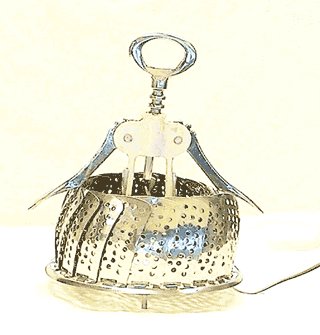
Experiments in Connected Social Spaces
"...Sharing a meal, a walk in the park, weddings, sports, or cafés...are the kind of social activities and rituals we associate with human relationships...What if you could go out for dinner and dancing with friends, even though you're a thousand kilometers away?...(W)ireless Internet "hotspots"...provid(e) the possibility of multi-situated presence, but (are) also placed within a fixed physical location, a social environment rich with familiar objects, rituals and codes of behaviour.
LF:TK takes a playful approach to the ways we might inhabit such a hybrid environment. Furniture, decorations, cutlery, bric-a-brac and cultural debris are reconstructed as networked interfaces that populate surfaces within everyday social spaces. Each object provides a simple function, yet when combined with others helps build a complex arrangement of movement and gesture. Imagine a shared creation, a social ritual, a dance through objects, a table that is played." [Recipe for Corkscrew Man]
Posted by jo at 05:34 PM | Comments (0)
Ku:iyashikei-net

Tear 2 Tear [T2T]
Ku:iyashikei-net by Urico Fujii and Ann Poochareon is a networked crying sculpture that allows people to communicate through the interface of tears, a physical output of human emotional expression that has been overlooked, and never made exchangeable with current communication devices. Two sides, installed at different locations, communicate over the Internet. On Side A, Tear Well allows a sad person to express his/her feeling by pumping a traditional water pump, the water representing her/his tears. The tears are sent over to Side B over the Internet, where teardrop sculptures called KU act as networked surrogates.
As soon as Side B receives the crying signal, KUs start to cry. When a viewer on Side B wipes KUs’ tears, KUs stop crying. At the same time comforting response is sent to the sad person to cheer them up. Read PDF [blogged by regine on near near future]
Posted by jo at 11:36 AM | Comments (0)
The New Performer: Data as Performer and Performance
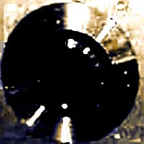
In Pursuit of the Virtual Performer
"The nature of all performance includes the elements of time-based experience and space as "stage". I use the term "stage" as a simple reference point to describe the space in which a performer performs and not as reference to the theatre. The nature of performance in the computer age includes these elements of time and stage as space. A simple definition of performance is : that which is feigned or pretended. It is action. It is speech. It is anything performative. The nature of the performer includes any entity who/which feigns, pretends, acts, and speaks. So, it is natural to include non-human entities, such as robots, cyborgs, and databases in this discussion of performance. Baudrillard might describe performing and the performer as more real than real, so real that they are virtual. "Of course we have a multitude of objective, real proofs, but what does one do with historical reality in a system which itself has become virtual? "(1)
New media's complex nature has influenced the nature of performance to become something many don't consider performance. Anything involving action, interaction, time, and space is performance. Therefore, performing is both real and virtual, becoming more real than real through the very nature of simulation. Performance on and of the net includes everything from virtual actors (interactors) interacting with real actors, Moos, Mud's, Mucks, Games, Chat groups, telepresence, Database as performance. The performer is data. The performer is virtual. The history of virtual performance begins with interaction between the real and hyperreal in time-based experience in a space referred to as the stage." From The New Performer: Data as Performer and Performance by Sheila A. Malone.
Posted by jo at 08:11 AM | Comments (0)
February 23, 2005
Stelarc
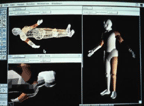
The Body as Host For a Remote Agent
From The Body by Stelarc, Switch Journal #19, 2005:
Movatar: When I started experimenting with involuntary body movements we quickly realized as well as the Body being locally controlled it might be possible with a touch screen interface to control the Body remotely. In fact we did a performance at Telepolis. We constructed a touch screen interface that allowed people in Paris, Helsinki and Amsterdam to access my body in Luxembourg and by touching the muscles on the computer model you could effectively program the choreography of the remote body in Luxembourg. You could do this either by pressing the touch screen or by pasting together from a wide array of gesture icons and then press Play and the physical body would respond in Luxembourg.
I could see the face of the person who was moving me, they could see my evolving body movements or their choreography. The body then became a kind of host for a remote agent. The idea that you could access part of my body from another place and physically actuate it. And in this performance those people in the three cities were able to access and move the Body over a period of three days.
Ping Body: We also used the ping internet protocol in a performance where the Body was moving through internet data. During the performance I would ping 40 global sites. The reverberating signals were measured in miliseconds mapped to the body muscles in a very crude way, but what was effectively happening was that the body was becoming a barometer of internet activity. The moved according to the internet activity from that global site.
Read The Body by Stelarc, Switch Journal #19, 2005
Posted by jo at 02:52 PM | Comments (0)
February 17, 2005
THE A - Z OF INTERACTIVE ARTS
![]()
From Double Gaze to Telenoia
Double Gazing: Just as we see, hear, and feel in ways unknown directly to biological man, we also now live in an environment which increasingly hears, sees and feels us. With computer laser tracking of our retina, the artist's gaze is returned. The walls will indeed have ears, and buildings will speak volumes.
Interactivity: Trivial and non-trivial. The first is a closed system with a finite set of elements. The second is open ended and infinite in its capacity to accommodate new variables.
Telematic Imperative: When there's no more geographical boundaries, territorial aggression is as irrelevant as polarised politics. The only imperative is to connect. Nowadays even the self is permeable.
Telenoia: Computer-mediated, distributed mind-at-large: asynchronous global connectivity. In celebrating telenoia we reject the individualism of the old industrial culture- solitary, anxious, alienated, neurotically private. Telenoia replaces paranoia in the telematic culture.
From THE A - Z OF INTERACTIVE ARTS by Roy Ascott, Leonardo Electronic Almanac, Volume 3, No. 11, November 1995
Posted by jo at 08:35 AM | Comments (0)
From A to D and back again:
![]()
The Emerging Aesthetics of Interactive Art
"...Screen-based 'hypertextual works', 'instrumented physical spaces' and 'mapped virtual and real environments' are three new genres. Another 'dimension' can be added to each of these by the inclusion of fast, wide bandwidth digital communications technologies. We might call this tele-interactivity. There are identifiable sub-genres, in which the interaction is: between people geographically separated; between a person and a machine, geographically separated; or between people geographically separated at a virtual site.
The first we might call 'teleconferencing art'. Paul Sermon has produced provocative works in this vein, such as Telematic Dreaming...A second sub-genre utilises the idea of teleoperation. Eduardo Kac and Ed Bennett's Ornithorinco allows a user to teleoperate a robot (over phone lines) to explore an environment.
More provocatively, Stelarc's recent Fractal Flesh project allows his body to be teleoperated over the net. In both these works some aspect of the user (vision, volition) is extruded over the communication network to 'be' in another place. A third sub-genre (exemplified by Agnes Hegedus' Fruit Machine) allows multiple remote users to cooperate in tasks in a shared virtual environment.
The sudden explosion of networked multimedia (via the World Wide Web) has finally realised the dreams of the pioneer network artist of the mid eighties, (though this realisation has a decidedly commercial cast to it). A recent network project by the Berlin based Art+Com group, T-Vision is on the one hand chillingly panoptical, on the other it demonstrates coordinated global data retrieval in a way that the WWW only hints at. "T-Vision" offers a radical new paradigm of computation. In this work, a user rolls a beach-ball sized trackball, and a globe of the world presented on the screen, rolls correspondingly. This image is made up of a patchwork of satellite and aerial photos. This world can be zoomed. In some cases one can zoom from the entire globe down to a city street in one smooth swoop. In one case, one can zoom into the Art+Com office, and look through a video camera pointing out the window, and see real time video action! "T-Vision" can utilise the entire internet, drawing on dispersed databases for its images, so that the globe is continually updated, even to the extent of real time video, if available..."
From From A to D and back again: the emerging aesthetics of interactive art by Simon Penny, Leonardo Electronic Almanac, Volume 4, No. 4, April 1996.
Posted by jo at 08:30 AM | Comments (0)
February 14, 2005
Troika Ranch

Three by Troika
In Plane (1994) was a duet for a dancer and her video image representation. The dance used the MidiDancer system to allow the performer to control the generation of music, the recall of video images, the theatrical lighting and a the movements of a robotically controlled video projector.
The Electronic Disturbance (1996): Searching for the corporeal within the virtual: a "tri-coastal" dance theater performance. Inspired by the book of the same name by The Critical Art Ensemble, The Electronic Disturbance shows the human body in flux: a body whose contact with other bodies comes more and more often not physically, but electronically. The piece explores the liberating aspects of this "electronic" body, like freedom from time or gravity, as well as the more sinister implications of a body that might be easily manipulated by external forces.
Surfacing (2004) combines dance and media to explore how tiny apocalypses and the grandly commonplace create imaginary surfaces through which we may either emerge or remain held captive. Troika Ranch's Artistic Directors, choreographer Dawn Stoppiello and composer/media artist Mark Coniglio, have created a world where real-time movement is captured by onstage cameras and subsequently trapped inside the surface of the video screen. The interplay of the real and the virtual asks the question, are you on the inside or the outside, and do you have the courage to break through?
Posted by jo at 02:56 PM | Comments (0)
The Resonant Image

Graphic Scores for Performance
Graphic scores are images created to convey instructions for the performance of sound or music without the inclusion of standard musical notation. The Resonant Image, a new two-stage exhibition in the Stasis_Space gallery, will explore the creation and interpretation of graphic scores by contemporary artists. In Stage 01 of the exhibition, a series of new graphic scores by a variety of artists will be displayed for a four month period. During those four months, another set of artists will be asked to create sonic interpretations of these scores. Stage 02 of the exhibition will present the best of these performances as downloadable mp3s.
Posted by jo at 11:48 AM | Comments (0)
February 10, 2005
Dziga Vertov Performance Group
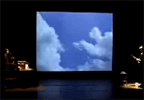
Performance Hybrids
Founded by artist/director Douglas Rosenberg in 1991, Dziga Vertov Performance Group's purpose is to create works bridging numerous disciplines including dance, performance and the visual and media arts. It takes its name from the Russian filmmaker of the early 1900's. DVPG's fundamental mission is to create new and challenging works of art based in the language of performance, dance and media that often combines voice, text, video and projected images. The work of DVPG is concerned with both content and form. The purpose of the work is to engage the audience, other artists and community groups in a dialogue that reaches beyond the usual performer/spectator relationship. In order to do this, we have set out to create a hybrid form of performance that is intended to both engage and challenge, using concepts and images that speak to contemporary and historical issues of human existence.
One of DVPG's many projects is ADaPT, an interdisciplinary association of artists, technologists and scholars from five educational institutions dedicated to research and critical dialogue on performance and media in telematic space.
ADaPT comprises five dance studios in five universities in the USA.:
1. Arizona State University
2. Ohio State University
3. University of California-Irvine
4. University of Utah
5. University of Wisconsin
In Wisconsin, the ADaPT team consists of Douglas Rosenberg (principal investigator), Chris Dowling (telematic technologist) and Jeffrey Gray Miller (technical director).
The objectives of ADaPT are to:
* create a site for telematic collaborative inquiry for the purpose of developing new models of practice and training techniques for the creation of networked dance and performance
* explore embodiment and somatic intelligence through reconceptualization of spirit, body and machine in Internet 2 culture- develop a shared mediated space for investigating performance and creative collaboration through a distributed environment across time zones
* situate research within a larger cultural and political context that acknowledges how mediated performances both frame and are framed by issues such identity, privilege, and access.
Posted by jo at 11:48 AM | Comments (0)
Corpos Informáticos
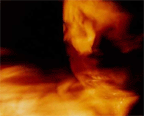
Bodies Re-Dimensioned by Technology
"The research group Corpos Informáticos was created at the University of Brasília (Brazil) by researchers, professors and students from the Visual and the Dramatic Art Courses in 1992. The central concern of this research...is the human body mediated by technologies: the existing human body is daily crossed over by imperceptible or perceptible technical elements from the most tender age; the body of the other is constructed in the same way - the image of other bodies (spectral) also makes us aware of our own – printed, broadcast, distorted, corrected images…one that becomes object of desire, desire of being, desire of becoming, and yet desire of manipulating, of possessing; our bodies and their prostheses – be them means of locomotion, reading, seeing, hearing, or creating – all of them are somehow interactive; finally, bodies constantly re-dimensioned by new technologies, and soon new bodies, new consciences." From Performance Art and Digital Bodies by Maria Beatriz de Medeiros.
See also:
Performative Sites: Intersecting Art, Technology, and the Body
Performance Art in Telepresence: Information and Communication in the World Net of Computers
Performance in Telepresence: the Body in Telepresence
Tenouous Border of the Performance Artistic Language, its Possibilities Within Technological Means
Posted by jo at 08:13 AM | Comments (0)
February 09, 2005
Performance in Plato’s Cave
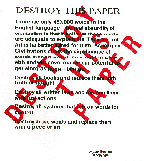
Three Distinct Performances
On Saturday, April 24th, 1999 at 9:24 and 21 seconds, a portion of the Performance in Plato's Cave was transmitted over the internet. In an attempt to follow the Plato’s Cave Performance we have to realize that there are three distinct performances going on simultaneously.
1. The Fake Performance was made to transmit from another location over the Internet in case the equipment failed at the Cleveland Performance Art Festival. The equipment did fail and the fake was transmitted; 2. The Environmental Performance was Alice in Wonderland's tea party adapted to a modern world environment. This also is the Internet Performance; The Non-Performance was a preparation for a conventional performance that would not occur.
To do an Internet Performance you have to get an audience...My goal was to get one viewer...The counter/trackers indicated that at least five people hit the site at the time of the performance.
Posted by jo at 11:43 AM | Comments (0)
PacMan Must Die
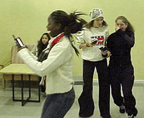
Collaborate or Lose
Students at the Future Applications Lab in Göteborg, Sweden have developed PacMan Must Die, an innovative video game with a playing field distributed across mobile wi-fi-enabled devices belonging to all the players. The game combines dynamics of play in physical places with the world of video games in a new way. To win, players have to cooperate with one another physically. [originally blogged by Sean on Cheesebikini?; reblogged by Sean on Smartmobs.]
Posted by jo at 11:18 AM | Comments (0)
February 08, 2005
Internet Performances as Site-Specific Art

Telematics and Performativity
"The following analysis is driven by the thesis that Internet Performances should be approached through site-specific art and its theory. To approach Internet Performances as a site-specific art is a – both theoretically and historically – promising premise. First, this positions Internet Performances in the 20th century tradition of experiments between both the performing and fine arts on the one hand and media technology on the other hand. Second, the concept of site-specific art emphasises the transformed modes of perception in telematic Internet Performances. These transformed modes of perception are influenced by the Internet’s mediality." From Internet Performances as Site-Specific Art by Julia Glesner published in Body, Space & Technology Journal Volume 3, Number 1.
Posted by jo at 03:04 PM | Comments (0)
February 07, 2005
THE INTERNATIONAL DATABASE OF CORPORATE COMMANDS
![]()
An Imperative Call
The Institute for Infinitely Small Things announced its new research initiative today, THE INTERNATIONAL DATABASE OF CORPORATE COMMANDS (IDCC). This research database is open to submissions of corporate commands from researchers around the world. A Corporate Command is an instruction work, a call to action in the form of an imperative: "Just Do It"; "Turn on the Future"; "Live without Limits"; "Tap into great taste"; "Think different"; "Ride the light"; "Live Like You Mean It."
It is the hypothesis of the Institute for Infinitely Small Things that these commands, largely and consciously ignored by a public over-saturated with advertisements, function at the scale of the infinitely small. Tiny events that do not disturb ones consciousness or disrupt ones identity as "free" agents, these commands seep under the surface of the individual and lay claim to the territory of the Deleuzian Virtual. Desire, memory, and future potentiality become territories for conquest and tactics for social and political control.
By compiling, tabulating, concretizing and enacting these commands in the International Database of Corporate Commands (IDCC), the Institute for Infinitely Small Things seeks to better understand the mechanisms behind this deployment of power and its larger cultural ramifications.
EVENTS & EXPEDITIONS: The Institute for Infinitely Small Things will be using the IDCC to lead a series of public expeditions during the 2005 Boston Cyberarts Festival in April-May. The Institute's temporary laboratory will be situated at Space 200 at 200 State Street in Fanueil Hall. Please check the website for exact times and locations of expeditions.
PARTNERSHIPS: The Institute welcomes requests for Research Partnerships from institutions and individuals engaging with similar questions. The IDCC is licensed under a Creative Commons Attribution-NonCommercial-ShareAlike 2.0 license. We are interested in publishing, syndicating or linking to any research that is relevant to our mission.
ABOUT THE INSTITUTE FOR INFINITELY SMALL THINGS
The Institute for Infinitely Small Things is a research organization dedicated to the creation, collection and documentation of all of the infinitely small things in the world, past, present and future. The Institute's research projects are concerned with creating a critical cartography through which to explore notions of political power, social controls, collective agency and human freedom.
Contact: The Institute for Infinitely Small Things
info @ infinitelysmallthings.net
617-501-2441
Posted by jo at 09:46 AM | Comments (0)
February 04, 2005
Distributed Improvisation

Distributed Improv~Programmed by n0media
Live improvisation connecting sonic artists, musicians and visual artists sited at University of East Anglia (Norwich, UK), International Centre for Music Studies (Newcastle, UK), Kingston (Canada) & Dublin Institute of Technology (Dublin, Ireland) in a series of realtime audio/ visual networked performances. The event can be accessed live online between 8pm & 9.30pm GMT. Performers include; Phil Archer, John Ayers, Andre Bosman, John Bowers, Laura Cannell, Nick Melia, Matt Rogalsky, Alex Sanders, Will Scrimshaw, Tom Simmons, Shigeto Wada and Liam Wells.
The event features four improvisations, each utilising specially created local or remote networks, sharing realtime audio/visual & performance data between performers in spatially remote locations. For more information go to >>
Posted by jo at 09:43 AM | Comments (0)
Breathe On Me
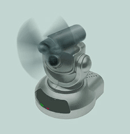
Breath as a Fundamental Form of Communication
Breathe On Me is an installation/internet work consisting of a three-walled space with a number of hybrid fan/webcam devices affixed to the walls. The fan/webcam devices are modified netcams such that Internet users can control the direction of a fan from the remote webcam view combined with pan and tilt controls. Internet users can choose one of the devices in the space, log onto the "FanCam," visually locate visitors in the physical space and then turn on the fan and "breathe" towards the person. Visitors in the physical space are invited to enter a space where they will be remotely seen and will not know who is telepresent. Once seen by internet participants, they will receive an offer of fan "breath" as a fundamental form of communication. Visitors who enter the space are asking to receive a telepresent stranger’s glance and touch in the form of wind. Internet users reach out to physical visitors in the simple offer of moving air.
To visit in telepresence: Links will to the live performance will be available at the live site within 24hrs. Opening Telepresently and in Situ: Friday, February 4, 2005; 8.00-9.30 PM, Pacific Standard Time, Continuing live through February 6; INTERACTIVE FUTURES 05: Technology in the Life World, Victoria, BC @ Open Space Artist-Run Centre
Posted by jo at 09:35 AM | Comments (1)
January 31, 2005
GPS::Tron

Classic Tron, Distributed
GPS::Tron, by Thomas Winkler, combines GPS, Bluetooth and GMS or GPRS with the classic Tron game concept--mobile phone plus computer game.
The players' movements in real space, which are tracked by GPS and transmitted to the phone's display, influence his/her position in the game. Each player is represented by a line that gets longer and longer. But the player's own line is never allowed to cross itself or the opponent's line. Which makes the game harder as time passes. The goal is to drive your opponent into a corner so that he can no longer extend his line without breaking the rules and losing. This is a game for two players who can be geographically distant from one another. [posted by Regine on near near future]
Posted by jo at 10:31 AM | Comments (0)
January 30, 2005
The first session with ADaPT Tokyo
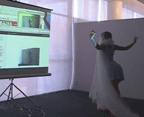
First Big Step in Japanese Dance World
In Japan, there has been few groundwork for media performance for years. However, there is few infrastructure in this field. I have been constructing interdisciplinary dance researchers' network inside Japan and Asia Pacific. I have started working for them since 2004. In the rehearsal of ADaPT Live Event Participating Performance Teams, a test session was held. A Japanese choreographer, Saeko, danced her piece "Veil," and Johannes Birringer and staffs at Nottingham (UK), and Kelly Gottesman at Wayne State University saw her dance image. I believe that it was a first big step in Japanese dance world. Related URLS: LATela: Live Art Telematics Lab: ADaPT also initiated the first transcontinental interface-performance between partners in the West and the Far East by Johannes Birringer; ADaPT Tokyo (Japan). [Posted by Yukihiko YOSHIDA]
Posted by jo at 01:14 PM | Comments (0)
January 27, 2005
Here I come again (Flying Birdman)

Between Sites and Non-Sites
Here I come again (Flying Birdman) was a telematic "earthwork" - an earthwork dance linking five remote sites in the United States with two locations in Brazil. It was based on narratives/dreams and structured spirally as a "Renga" (the old Japanese form of a linked poem) composed of live dance; real-time audio and sound processing, pre-recorded filmic images; still images, and both spoken voice and graphic text communication exchanged by participants during the live performance.
Thematically, the performances delved into "left overs," debris, decomposing sites, dumps, and the idea of re-cycling of landfills: what is returned needs to be transported from one site to another. The dramaturgy for this telematic "earthwork'" envisioned a spiraling dialogue/communication -between sites and "non-sites"- with at least 2 sites dialoguing with each other (video, audio) at any given time during the 10 scenes. The dialogue was passed on and moved around, as in the Renga for of a linked poem. The online viewer was invited to follow the spiral. View movies >>
Posted by jo at 08:56 AM | Comments (0)
January 26, 2005
The Dream Project

Reinforcing the Disparity Between Virtuality and Physicality
In the teleconference performance The Dream Project--by Keith Roberson and Company in Space--performers wearing datasuits control virtual avatars in a shared virtual reality environment. Bridging the gap between multiple locations, these avatars interact with each other. Their interactions explore possibilities beyond the physical body. Choreography of these virtual bodies, based on Quantum and Super-string theory, reinforces the disparity between virtuality and physicality.
Posted by jo at 11:13 AM | Comments (0)
Documenta 6 Satellite Telecast
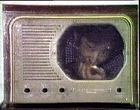
An Homage to Global Communications
Documenta 6 Satellite Telecast, by Joseph Beuys, Douglas Davis, and Nam June Paik; Video; 30 min, color, sound, 1977. Available at Electronic Arts Intermix:
"In 1977, Documenta 6 featured the first live international satellite telecast by artists. Performances by Nam June Paik, German conceptual artist Joseph Beuys, and Douglas Davis were transmitted to over twenty-five countries. Paik and Charlotte Moorman are seen live from Kassel in Fluxus-inspired collaborative performances, including TV Bra, TV Cello, and TV Bed. They fuse music, performance, video and television in an homage to global communications. Also from Kassel, Joseph Beuys presents a direct address to the public, elaborating on his utopian theories of art as "social sculpture," which were crucial to his conceptual project. From Caracas, Venezuela, Davis performs The Last Nine Minutes, a participatory piece in which he addresses the time/space distance between himself and the television viewing audience."
Posted by jo at 11:12 AM | Comments (0)
January 25, 2005
GoingPublik
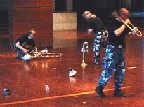
Mobile Multimedia as Mixed Reality
GoingPublik is a sound art work for distributive ensemble and mobile score synthesis. The core idea behind the work is a strategy of mobility by employing a wearable computer system running a software based electronic scoring system. GoingPublik will be performed at Interactive Futures 05 on February 5 from 9:30-10:30 pm. Art Clay will present a lecture "GoingPublik: Mobile Multimedia as Mixed Reality" from 2:30-3:30 PM.
"The core idea in the project is a strategy of mobility and this is accomplished employing a wearable computer system running the software based electronic scoring system as its central element. The program itself basically allows for what might be termed 'composed improvisation' which permits improvisational elements within a compositional structure. This is accomplished by electronically monitoring the performer's physical behaviour during performance. The program then responds by making suggestions to and even demands on the performer to various degrees and at various times.
Since each of the performers is equipped with the same electronic scoring system and because the system revolves around universally shared inputs such as geographical positions obtained via satellites and sensors using the earth's magnetic field, all have a common denominator and are thereby virtually linked. Despite the physical distribution of the performers in space, it is possible to have a commonly shared compositional palette and, at moments of close proximity between performers, to obtain instantaneous synchronized sonic elements. Both aspects needed for creating sonic structure within the work." Read paper >>
Composition Camouflaged: On the Relationship between Interpretation and Improvisation; Interview with Roland Dahinden, Günter Heinz & Thierry Madiot on the World Premiere of GoingPublik by Franziska Martinsen
Posted by jo at 10:05 AM | Comments (0)
In Conversation
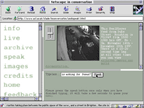
From Street to Chatroom
When live and located, In Conversation provided the means for individuals in the street and on the Internet to engage in a live dialogue with each other. This work by British artist Susan Collins aimed to examine the boundaries and social customs of distinctly different kinds of public spaces - the street and the Internet/chatroom-each with its own established rules of engagement.
Passers-by encountered an animated mouth projected onto the pavement and, through loudspeakers, could hear voices triggered by internet users trying to strike up a conversation. When the pedestrians responded, a concealed microphone and surveillance camera transmitted the responses to the website via a live video stream (webcast). Through the website, online visitors could view the surveillance video and hear the people on the street. They could type messages and send them 'live' to the installation where they were converted into speech and broadcast to the street through loudspeakers.
Posted by jo at 09:08 AM | Comments (0)
January 24, 2005
ASL [v.f.] 1.0

Age, Sex and Location
ASV [v.f.] 1.0 was the first version of the "chatroom plays"--by Vincent Makowski/AmsterdamEditions--performed during the Internet Fiesta and the Irish Museum of Modern Art's Net.art exhibition on March 23rd, 2002.
"The chatroom plays just slightly twist the original purpose of chatrooms. With ASV [v.f.] 1.0 (which in English should rather be ASL for Age, Sex and Location, the most basic self definition given by chatters to those they interact with), I intended to use a chatroom as a theater stage and asked professional actors along with some people having no acting experience to play a role we defined together...(N)one of the actors' cues were pre-written and we had no rehearsal whatsoever. Furthermore, we never met before and (or) during the performance. Our communication only went through e-mails exchanged between the actors and myself.
They were asked to define their own role and we built their character and personality together through e-mail exchanges from then on. No plot was defined prior to the performance: I was not interested in creating a linear fiction but rather a real time remote interaction between the actors. I wanted to push live performers (professional actors) to experiment the sole use of written words, in opposition to their actual physical presence on a stage. The chatroom plays allow me to raise the question of live performance on the internet. The time necessary to type the cues (which varied from one actor to another depending on how fast they could type) generated delays in the answers to specific cues. This succession of unrelated cues could be read as something close to the "cadavre exquis" developed by the surrealists. Even though data was instantly transmitted simultaneously to all the actors' computer screens, the keyboard operating introduced a stretch, a delay preventing real time exchanges to be experienced. This paradoxical man/machine ability and time was, more than the meaning of the cues themselves, at the center of this work."
Posted by jo at 02:57 PM | Comments (0)
January 22, 2005
Project Molly

Light Lunch with Molly
"Project Molly is a series of roaming interactive webcasts captured live using a wearable wireless audio/video acquisition system by artist Nichola Feldman-Kiss. Please interact with Project Molly live for light lunch and conversation via internet relay chat at the Project Molly interface."
Project Molly was a performance art/research innovation; it used a Xybernaut wearable computer with a head-mounted audio video acquisition and display system to stream a live video feed to the internet via wireless connection. The prototype real net video performances interactively linked the remote audience with the real time audience/performers via Project Molly’s personal a/v surveillance and chat interaction. Each consecutive interactive webcast incrementally evolved the project molly interface and knowledge database. Ultimately, the interface tracked project molly's movement through real space and captured streamed video into a data archive that is indexed and searchable by a variety of terms.
Posted by jo at 12:16 PM | Comments (0)
January 20, 2005
Tele-tap

Transparent Borders
"Where are the borders between public and private? Between art and life? Between urbanity and individual? - The project Tele-tap by the Amsterdam women artist group CUT-n-PASTE connected its listeners with a number of personalities active in Amsterdam's nightlife: a member of the Salvation Army, a harbour worker, a musician, a woman strolling through the pubs. Each of these personalities went into his urban environment, in his auditory-communicative hunting ground, lived there his life, played his role, provoked encounters. This was transmitted live by the permanent open mike of their mobile phones. Each of them could be wiretapped by the audience via radio, Internet or at the performance venue. Tele-tap showed how undefinable the borders can become between intimate and public space in a mobile communicating society. The technical »heart« of the project is the Internet, where the mobile phone sound inputs were converted into live audio streams and were audible all over the world. These streams also went on air as radio signals, and were accessible by headphones and loudspeakers at the performance venue itsself. The last time Tele-tap was live aired and live performed was on August 31 and September 1, 2001 on the Dutch radio channel VPRO and at »De Balie«, an Amsterdam cultural center. New technologically and dramaturgically extended versions of the project are in preparation. [via AudioHyperspace]
Posted by jo at 03:19 PM | Comments (0)
January 19, 2005
Transfers
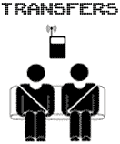
GPS+Video/Audio+You=Mobile Art
Transfers--by Matt Roberts--is a project exploring real-time generation of art and user participation in a mobile environment. Transfers allows a passenger of a taxi to generate a unique piece of art by giving the taxi driver directions. As the taxi moves through the city the passenger experiences a real-time manipulation of live exterior video and audio taken from a camera and microphone mounted in the taxi. The taxi is also equipped with a GPS that feeds an onboard computer data such as speed and direction. This computer is running custom audio/video manipulation software and uses GPS data to make decisions about how the live video/audio feed is manipulated and seen by the passenger. The manipulations of the live feed is displayed on two LCD screens and heard through the cars stereo system. As the user tells the driver where to go the passenger becomes both performer and viewer as they experience a unique piece of art generated by their decisions. The software also records this performance and at the end of the drive the passenger receives a CD with a QuickTime movie file of his or her recorded performance. [via Rhizome] Related >>
Posted by jo at 02:56 PM | Comments (0)
F2T (Free to Talk?)

SMS Rapper Slang
F2T is an interactive musical installation about "argot" and its different contemporary applications. F2T, a creation by artists Frank Plant (United States) and Thomas Charveriat (France), combines sculpture, robotics, hip hop, and SMS messaging to explore the ways technology shapes the development of language, particularly new forms of slang. Viewers interact directly with the artwork by sending it a short text message from their mobile. Once received, the SMS is scanned for frequently used words and, when a match is found, the four elements are activated. The main piece, "Rapper" begins to twist and wave his hand while mouthing a rap based on the message sent, the new lyrics culled from more than 130 different hip hop phrases written by Amsterdam-based lyricist and composer Jim Barnard. The rest of the piece is simultaneously set into motion: "Boom Box" starts flashing and blasting out the song while "Joy Ride" a bouncing low-rider, and "Shake Ass" (looks like it sounds) begins to move, triggered by ambient sound sensors. When the song is finished, a thermal printer spits out a souvenir with the original SMS and the words of the "Rapper." (via Rhizome)
Posted by jo at 02:50 PM | Comments (0)
Location is Everything

Rhizome.org ArtBase Exhibition
Location is Everything--curated by Jillian Mcdonald--explores ways in which artists repurpose mapping as a creative medium; or perhaps it reframes mapping as a procedure that is intrinsically creative. The cartographic forms in these projects are drawn according to, as Mcdonald explains, personal or collective experiences, some informed by external factors like weather data or pop-culture references, and some allowing the map itself or local residents to inform them. These reciprocal actions of forming and informing effect both maps and their makers, suggesting that who? and why? are equally important questions to pose when interpreting a map as simply where?.
Works included in this exhibition are "PdPa" (2003) by Julian Bleecker, Scott Paterson and Marina Zurkow, "[murmur]" (2003) by Shawn Micallef, "Louisiana Walk #14" (1996) by Janet Cardiff, "Atmospherics/Weather Works" (2003) by Andrea Polli, "GPS Drawing" (2000) by Jeremy Wood, "Hlemmur in C" (2004) by Pall Thayer, "Survey Field" (2003) by Germaine Koh, and "Infrasonic Soundscape" (2001) by Hidekazu Minami.
Posted by jo at 12:03 PM | Comments (0)
January 18, 2005
Tap
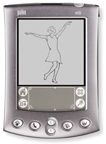
A Metaphor for Networked Communication
Tap--by James Buckhouse in collaboration with Holly Brubach--is a virtual dance school for animated characters that exist on the Internet and can be downloaded to individual users’ Personal Digital Assistants (PDAs) and desktops. Users can choose animated dancers (a male or female) at the Tap website. The dancer takes on a life of its own, practicing, learning from other dancers, and giving recitals. Users do not have to be present during the lessons--the animated characters can be "dropped off" and left to practice for an unlimited time. Dancers can practice at home, as a screen saver on the user's desktop. Their learned routines can be performed for other users.
These performances take place on individual users' PDAs. Dances are downloaded from users' desktops or beaming stations to their PDAs, where they can be performed as well as "beamed" to other PDA users. The dance contains a record of what it took to learn a particular routine. Individual steps from a dance can be incorporated into new dances, and users can encourage their character to continue working with certain moves. Also, two users can let their characters teach each other to dance.
Tap treats digital data not as perfectly reproducible packets of information, but as seeds for new ideas that spread and evolve. As an artwork that relies on exchange, learning processes, and community, Tap becomes a metaphor of networked communication itself. As digital data, tap dance is modular and re-mixable. The similarities between data and the dance routines point to the question of how we think about art through the cultural filter of technology.
Posted by jo at 06:15 AM | Comments (0)
January 17, 2005
Mutsugoto/Pillow Talk
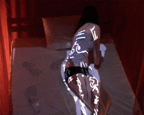
A Body-Drawing Communicator for Distant Partners
Mutsugoto--by Tomoko Hayashi, Stefan Agamanolis, and Ciaran McGrath--is an intimate communication device placed in the bedroom environment. Instead of exchanging e-mail or SMS messages using generic interfaces in business-like venues, Mutsugoto allows distant partners to communicate through the language of touch as expressed on the canvas of the human body. A specialized computer vision and projection system allows users to write or draw on their own bodies while laying in bed. Drawings made by one partner are transmitted to and revealed on the body of the remote partner. [via medialab europe]
Posted by jo at 10:15 AM | Comments (0)
Grafedia
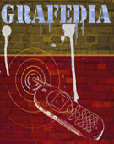
GraffiTML
Keyboards often eclipse pens as the writing tool of necessity. As computers continue to gain precedence in our lives, we fill a graveyard with lost penmanships and John Hancocks of decreasing legibility. John Geraci combines the personal imprint of handwriting with the connective possibilities of the Internet in his newly released project Grafedia, developed at NYU's Interactive Telecommunications Program. Elaborating on themes explored in neighbornode--a wireless, localized bulletin network Geraci built in 2004--Grafedia turns the city of New York into a potential webpage. An author can write, draw, even tattoo, a hyperlink onto a public space in the form: my_original_thought@grafedia.net. The author also uploads media corresponding to or enhancing to the location, like an original photograph, to the Grafedia site. Passers who encounter a link can 'click' it by sending a text message to my_original_thought@grafedia.net. In turn, Grafedia beams the author's hidden media back to the inquiring wireless device. Since Grafedia's annotative marks are not anonymous but in fact scrawled by the hands of their authors, viewers are able to follow particular people and stories. And the cherry on top my original photograph? It's a lot fun. - Alyssa Wright, Rhizome's Net Art News.
Posted by jo at 09:38 AM | Comments (0)
January 14, 2005
Permanent Creation
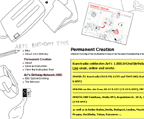
Art's Birthday 2005
This year's Art's Birthday celebrations in Vienna stand under the motto Permanent Creation and will - as in previous years - take place as a networked project with partner nodes around the world joining in and contributing to the broadcast special. For the first time, also the Ars Acustica group of the European Broadcasting Union (EBU) will participate in the Art's Birthday special and send acoustic contributions and sound samples serving also as source material for new pieces via satellite, thus expanding the global network by national broadcasting companies in Baden - Baden, Berlin, Madrid, Moscow, Oslo, Prag, Stockholm and Vienna.
In Vienna, the artist groups alien productions and IFTAF - Institute for Transacoustic Research will perform and jam with the partners of the network and will stage miniature performances due to instructions either submitted by the audience or from a collection of action instructions. For these performances, there will be a range of props available in the studio and each of the short acoustic actions will be performed within a fixed setting: a white table equipped with various (analogue) tools.
You can add your instruction for Permanent Creation to an on-line pool, which is the base material for the miniature performances. Furthermore, listeners of Kunstradio as well as artist collegues are invited to come to the studio and join in the action.
on air: OE1 Kunstradio (FM, SW, MW) - 21:00 - 23:00 GMT
on line: http://kunstradio.at
on site: Funkhaus, Studio 3, Argentinierstr. 30a, A - 1040 Vienna
The History of Art's Birthday
WIENCOUVER 2000
"In 1980, when the modern Fax machine was still an exotic promise and computers either massive mainframes or playthings for the hobbyist, artists in Vancouver and Vienna were collaborating on the first of the projects known as Wiencouver. WIENCOUVER 2000 is not a nostalgic look at the early years of Art+Telcomm but an exploration of the new technology available for artists working in the field as we approach the new millenium."
"Art's Birthday Party is a celebration in memory of Robert Filliou who declared, on January 17, 1963 that Art had been born exactly 1,000,000 years ago when someone dropped a dry sponge into a pail of water. 10 years later he celebrated Art's 1,000,010th birthday in the Neue Galerie, Aachen.
After Filliou's death in 1987 some artists began to celebrate Art's Birthday with mail-art, fax and slow scan tv events in the spirit of his concept of "The Eternal Network" or "La Fete permanente." The Birthday parties took place in different cities across the world and artists were asked to bring birthday presents for Art. -- works that could be shared over the network.
Art's Birthday Party has never been a formal event but was always organised on an ad hoc basis through the network. Every participating location (and they are different every year) organises its own party - from a few friends in a private studio to a performance evening in a museum, gallery or radio station . The only condition is that each group is able to send and receive birthday presents for Art. Since 1994 this has usually meant using the Internet in one form or other.
Filliou's invention of Art's Birthday is wonderfully absurd and humorous in the typical Fluxus tradition of serious fun. So the global birthday party for art has always tried to be fun while paying homage to Robert Filliou's dream of The Eternal Network." Robert Adrian 2004
Art's Birthday Network
EBU Ars Acustica Special Evening
Posted by jo at 12:26 PM | Comments (0)
January 12, 2005
HopStory
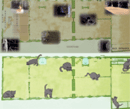
Interactive, Location-based Narrative Distributed in Space and Time
"As computing and communications technologies evolve, there is the potential for new forms of digitally orchestrated interactive narratives to emerge. In this process, balanced attention has to be paid to audience experience, creative constraints, and presence and role of the enabling technology. This paper describes the implementation of HopStory, an interactive, location-based narrative distributed in space and time, which was designed with this balance in mind. In HopStory, cinematic media is housed within wireless sculptures distributed throughout a building. The audience, through physical contact with a sculpture, collects scenes for later viewing. Inspired by the history of the installation space the narrative relates a day in the life of four characters. By binding the story to local time and space and inviting the audience to wander, we amplify the meaning and impact of the HopStory content and introduce an innovative approach to a day-in-the-life story structure." Abstract for Hopstory: an Interactive, Location-based Narrative Distributed in Space and Time by Valentina Nisi, Alison Wood, Glorianna Davenport and Ian Oakley [PDF]
Posted by jo at 02:57 PM | Comments (0)
January 11, 2005
Code Zebra
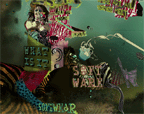
New Artistic Practices Meets Performance Art, Art and Science
Code Zebra is a highly interactive interdisciplinary, performance and software system where art meets science. The performances occur at sites around the world and on the web. CZ induces dialogues and debates between science (with an interest in computer and biological science) and arts (including visual art, design, fashion, architecture). Code Zebra consists of fictional flirtation sessions between an artist and a scientist, actual conversations and debates between the arts and sciences. Code Zebra is built as a scaleable performance series that allow venues to plug and play.
Elements of the development of Code Zebra will be captured in video and Internet streams and form part of a significant archive that will be used in performing the work. Users on the site will experience live events via streamed audio, and at times video. Live events will be publicized through the web site. The project draws from performance theory (art, literature, sociology), discourse theory and grammatology, cross-disciplinary research methods, visualization theory and computer science practice, simulation, new media analysis.
The metaphor of "zebra" is at the core of the project because zebra's stripes are reaction/diffusion patterns; a provocative but resolution based way of describing dialogue. Evolutionary theory uses zebras as a case study, and reaction/diffusion has been at the core of this emerging performance series and at the heart of the operations of computer code. Zebras are the unexpected evolutionary protocol. They stand out in a crowd, but induce nausea in lions, their former predators. Above all zebras survive by moving in camouflaged herds.
Performances will take place in various real and simulated locations. The software of Code Zebra also combines panel discussions and debates, live and on-line, chat, simulated conversations and patterns and visualizations of chat or performance art metaphors using software and fictional performances.
CodeZebra OS (Orifice System) Software
In November and December of 2000, a group of leading artist/software developers, streamed media artists, discourse theorists, chat analysts, computer scientists and programmers gathered in San Francisco, led by Sara Diamond and hosted by the ArtsAlliance. Together, they modeled Code Zebra, a software that will analyze and allow people to author on-line chat, video streams, producing visual patterns that allow users to better understand and symbolize their own position within discussions. The software deploys reaction/diffusion patterns from nature, but permits individuals or groups to have a personalized pattern at any point in time. The design retreat includes some of theworld`s leading thinkers in Internet dialogue analysis, streamed media, and pattern creation. It links to the larger Code Zebra project. The software is capable of analyzing all forms of chat, but will be focused on debates and discussions in art and science as a development phase.
The software provides users with the ability to use visualization patterns to locate themselves within an Internet discussion, review their histories of dialogue, enter a deeply moderated or anarchic space that is designated by topic and/or by mode of chat and feel physically located in this space; monitor other chats simultaneously, use physical links to relate ideas; build a personal pattern icon and a personal tale of chats and Internet dialogues that unfolds as a visually beautiful, navigable, shareable 3D and sound movie.
Fear and self-preservation need to be confronted and transcended in the process of enacting cross-disciplinary exchange. This will be so in the performances and is already a part of the software design process. The performances and the software translate constantly, between the semantic meanings of concepts, people's relationships, into visualization new levels of understanding. The software enables agency (you choose topics and people), but its intelligence constantly suggests new possibilities of idea, related concepts and people for you to connect to. While appearing light, beautiful and playful, this project is in fact serious and viral.
The software development workshop may be a good example of the lock-up technique (referred to later), as the artist placed fifteen top-end researchers and coders in a room with her and several other artists. They came up with the chat visualization software that was a complex melding of computational linguistics, social instincts, and simulations of animal and human physical characteristics and evolutionary logic. First and foremost, they combined an emotional system with the anarchic or unconscious dynamics of Internet interaction. Code Zebra is all about process, allowing a series of lenses on the process of dialogue and creativity. While driven by the vision of one artist, it is highly collaborative and hence high risk, requiring the cooperation of different talents and disciplines for its success.
The user enters each chat or dialogue session by dwelling on the surface of the site and then diving into a familiar or seductive pattern. Once inthe pattern one moves through its moving mass and can stay at any point for dialogue. The software monitors styles of discussion through pattern analysis and can impose patterns on certain kinds of dialogues should these go astray or at least suggest these. Patterns can be used to analyses what people are talking to each other, about what, but most profoundly how they are talking. Character scripts based on the reaction diffusion character team (Code Zebra, Os Zealot, etc.) will arrive in at least text, if not visual form, to moderate discussions or suggest changes of mode (e.g. you have a limit of ten words posting for e.g. and it looks like playful leopard spots). This process of swimming through the topography of the site is called orifice systems (OS).
Each user creates their icon on the site, a moniker for HOW they interact. Each chat sessions produces a pattern that they can capture at any point in time. It forms a ring, or layer attached to their icon. Over time, these layers build to create a personal tale. These are three-dimensional forms that the user can enter, fly through, fly around, pull out layersof for reconsideration. Although highly visual (and eventually sonic), drilling down into these results in precise data base information about whoone has spoken to, about what and in what style (aggressive debate, playful banter, formal panel discussion) at what time. The forms operate as 3D movies, luscious and beckoning. The icons sit on the surface of the site, but at any time, users can share these or revisit these alone or accompanied.
Posted by jo at 06:55 PM | Comments (0)
January 10, 2005
Public Genitals Project
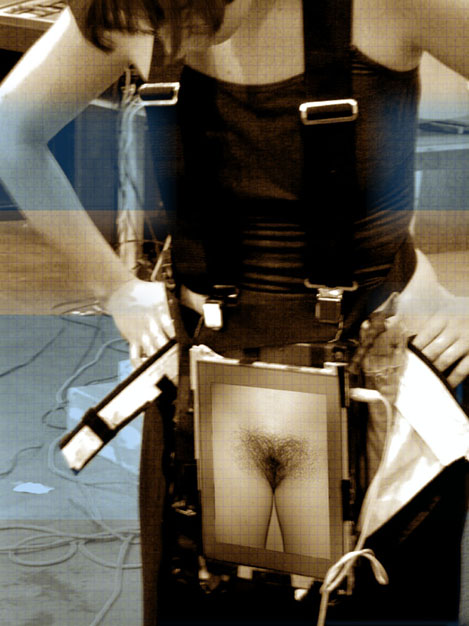
Not Safe for Walks
The Public Genitals Project , by Sandy Stone, playfully questions the boundaries between inside and outside, revealed and hidden, representation and reality.
Each PGP unit consists of a video broadcast receiver, battery pack, two small loudspeakers, and two modified laptop computers worn by a person walking the streets of Austin.
In one version, the person is naked except for the screens, which are attached to suspenders and worn so they cover the genital areas front and back. In the second version the person is fully clothed except for cutouts over the genital areas front and back, within which the two screens are mounted.
In operation, participants worldwide send images of their genital areas via webcams. The images are digitally manipulated according to an algorithm driven by the number of times the words "sex" and "violence" appear on the webpages of CNN, MSNBC, and CBS. The digital manipulation smooths and abstracts the images; the more the terms "sex" and "violence" appears in the media, the more that actual body images recede toward imagined recollections. The images are then broadcast and displayed on the flat screens. Concurrently, the loudspeakers present ethnographically recorded narratives of personal experiences with nudity, shyness, and desire, which are stored as sound files on the computers. The juxtaposition of images and physical body surface is meant to convey the illusion that the viewer is looking through a transparent electronic window at the surface of the wearer's body.
In reality, no actual flesh-and-blood genitalia are directly visible, and no explicit representation of individual genitalia is shown, though it is likely that this distinction may be lost on the naive viewer -- we hope. (Posted by Régine Debatty)
Posted by Regine at 09:19 AM | Comments (0)
January 07, 2005
LifeLine
""...Traditionally, the performing arts is comprised of three components - the performer, the audience, the stage. The performer engages the attention of the audience; the audience observes and responds to the gesture and prose articulated by the performer; the stage provides a formal structure within which the relationship between performer and audience is cultivated and sustained. Separation from the creative process is perpetuated whilst the stage imposes its own criteria upon it." 1.
The hierarchical performance space described above is posited on notions of authorship, in the modern history of cinema and theatre first the writer, then the text and finally the context have all laid claim the authority of meaning. New forms of performance especially interactive forms rely on a more democratic distribution of authorship that occurs when the performance space no longer relies on the separation of author and audience but engenders an integrated space, a space shared by both the performer and the audience that disperses authority." from The Extended Logic of the Interactive Performance Space by Gregor White.
Posted by jo at 05:29 PM | Comments (0)
January 06, 2005
Some time of available human brain
![dtdchd1[1].jpg](http://www.turbulence.org/blog/images/dtdchd1[1].jpg)
Internet installation for television channel
and computer assisted actor
"Some time of available human brain" is a ten to fifteen minute performance conceived by Christophe Bruno.
An actor lies on a psychoanalyst's couch, with a television that broadcasts a TV channel live behind his back. Behind the couch, a person types in key words in relation with what the TV set shows. These key words are sent on a server and thanks to a search engine, a program extracts the textual flood relating to the chosen key words in real-time.
The text is then read by a voice synthetizer and sent to the headset of the actor who says it as soon as he hears it.
The result is a two-voice performance: the voice of television--the spectacle provider--and the voice of the Web, where a fallacious freedom masks the success of the society of control. (Posted by Régine Debatty)
Posted by Regine at 03:57 AM | Comments (0)
January 03, 2005
Record_
![]()
Virtual-Sound-City
Record_ by Alberto Guedea: _pre-recorded audio from computer hardware manipulations [using hardware as musical instruments] processed and de-constructed live, digitally_"For this venue I will be studying the idea of a virtual-sound-city by recording audio pieces, utilizing computer hardware as the only physical 'musical instruments' to produce the recorded sound. These recordings of hardware manipulations will be processed afterwards through various popular music software engines in a series of long length private and public performances which will be webcast in real time, through the Reverie server during January 2005.
The webcast performances will be abstract net-installations of audio and they will be focused primarily on the concept idea rather than on schematic or structured musical compositions. These sound installations and audio investigations will address virtual reality in present times."
Posted by jo at 08:21 AM | Comments (0)
MuSE

Multiple Streaming Engine
MuSE provides the free software community with a user friendly but powerful tool for network audio streaming, making life easier for indypendent free speech online radios.
MuSE is an application for the mixing, encoding, and network streaming of sound: it can mix up to 6 encoded audio bitstreams (from files or network, mp3 or ogg) plus a souncard input signal, the resulting stream can be played locally on the sound card and/or encoded at different bitrates, recorded to harddisk and/or streamed to the net. When sent to a server, the resulting audio can be listened thru the net by a vast number of players available on different operating systems.
To be operated MuSE offers graphical interfaces and a documented commandline interface in the good old unix style. MuSE is free software and it is released open source under the terms of the GNU General Public License.
Posted by jo at 08:07 AM | Comments (0)
December 28, 2004
Confess
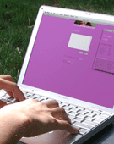
Web of Truth
Begun as a private experiment, New York-based artist Stewart Smith's Confess project soon took on a life of its own by virtue of its own logic: users sign up with anonymous accounts, and are given the opportunity to bare their souls into an internet confessional. In return, they are allowed to view the anonymous confessions of other users. Users can comment (again, anonymously) on what they view, and see the comments of others on their own secrets. The only control that the process has is a rating system; the 'better' one's confessions are rated, 'better' are the confessions one will see, setting up an addictive emotional economy. Sherman has kept the presentation deliberately minimal, giving the site a personality that is both earnest and vaguely unnerving, reflecting the ambiguous feelings provoked by impersonal honesty. The effect of sitting down in front of the screen and being asked to communicate without consequences is strangely powerful, and the results stir interesting thoughts about the fate of sincerity on the web. - Ben Davis, Net Art News, Rhizome, December 20, 2004.
Posted by jo at 09:00 AM | Comments (0)
SEVEN YEARS OF LOVE AS ART
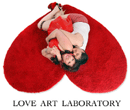
WEDDING #1 WEB CAST
We, Elizabeth M. Stephens and Annie M. Sprinkle will explore love as art for seven years. Each year will be based on a chakra and begin with a wedding. Our first wedding via a live web cast was on Saturday, December 18, 2004.
The theme of the wedding was "security" and the chakra color was RED. We gathered with a few friends and family in a small performance space in Manhattan. Guests collaboratied in the creation of the wedding. (Please forgive us if you didn't get invited to this wedding in the flesh. We had very limited space, and there are 6 more weddings to come, so we would love for you to join us in the future. Next wedding will be in San Francisco.) Look at our web site for more information.
Posted by jo at 07:29 AM | Comments (0)
December 27, 2004
netzwissenschaft
![]()
Emerging Infrastructures of All (Inter)net Research
Dr. Reinhold Grether's network research | netzwissenschaft site maps the "emerging infrastructures of all (inter)net research endeavours. net.science as an anthropology of connectivity is trying to overcome the constraints of specialist method transfers on net matters. the protuberance of technical networks necessitates a professionalization of human net knowledge. neither the isolation of concepts as in basic research nor the encapsulation of processes as in applied sciences will ever be able to adequately describe the complex autopoiesis of networks. net.science is undoubtedly developing into a scienza nuova of its own right."
Check out his Mobile Art and Virtual Performance research areas.
Posted by jo at 04:45 PM | Comments (0)
December 24, 2004
Telematic Dinner Party
![mike_fork[1].jpg](http://www.turbulence.org/blog/images/mike_fork[1].jpg)
A menu of food and electronics
During the experiment that Jeff Mann and Michelle Teran made of the Telematic Dinner Party, conversations between the table guests in Amsterdam and Toronto were mediated by streaming media and networked kinetic objects. So, for example a clinking spoon or glass in Amsterdam could produce a slamming door in Toronto.
The dinner table was turned into a physical platform for networked media supports live video streams, tele-robotic talking fish, gourmet cooking, singing chandelier, Keystroke media mixing, wine-pouring machines, telematic toasts, party games, etc; linking two dining rooms and thirty dinner guests across the ocean in a mediated mechatronic middle-space for social interaction.
Throughout the meal, the guests made toasts and speeches using the sensored and motored wine clinking devices. Everybody played games with food, cutlery, and chef attire to create interesting and coordinated video feed. After the first course, people changed seating arrangements to have access to all telekinetic props and streams distributed across the table. A coordinated storytelling game was played using the audio stream with the guests in Amsterdam. Finally, a punk magician performed for those physically and virtually present. (Posted by Régine Debatty)
Posted by Regine at 02:28 AM | Comments (0)
December 22, 2004
Real Remote Guided
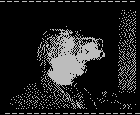
Controlled by web users
Real Remote Guided, by Antonio Lomas, features a subject who is "blinded" while the spectators / speakers on the internet and in the physical space, are able to see what the subject could see in normal circumstances.
GPS and web cam are combined with a laptop linked to the net through telecomunicaton systems (cellular telephony and/or wireless).
On the web page, the web guides see the images from the camera worn by the artist, as well as map images that define his location so that they can send him instructions, guiding him through a space of real intervention. The artist can only see the instructions sent by the users and the map images of the GPS system.
The idea is to represent, in a playful way, how new technological systems can take control. So, spectators are invited to take that control and to manage it. (Posted by Régine Debatty)
Posted by Regine at 03:01 AM | Comments (0)
December 10, 2004
OFFLINE

Net Jamm
Outside the frame of the exhibition and for the opening of Unzipping Codes, the net jamm performance will be led by the members of the group OFFLINE, Brian Mackern, Arcángel Consantini, and Fernando Llanos. They will mix live inputs from the internet provided by themselves or OFFLINE colleagues that will resemble a mixture of DJ and VJ procedures while revealing the unstable nature of digital reality.
OFFLINE is a cross-border global group of artist collaborators working creatively with the Internet and related digital and networked media. The purpose of OFFLINE is to bring together online art practitioners and creative technical consultants for collaborative projects staged at real world locales such as art and music festivals, symposiums, cafeterias, rooftops and city streets. OFFLINE projects will take the form of live performances, installations, and diverse experimental augmented reality displays. OFFLINE is organized via an online mailing list and a central server.
Posted by jo at 09:28 AM | Comments (0)
December 08, 2004
Infrasense
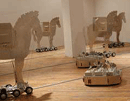
Trojan Horses and Bugs
Worms, back doors, Trojan horses and bugs are some of the better-known terms and metaphors for viral activities on the Internet, on desktops, laptops and in digital research and development labs around the world. The Infrasense project uses the idea of the 'Trojan Horse' and the 'Bug' as two digitally bound elements, which are subsequently produced as physical entities and in turn are partially controlled from the Internet again. The idea is to take concepts from the digital world, render them as physical objects and then return the control of the physical back to the digital landscape of the Internet.
Using 3D figures of bugs and Trojan horses to represent computer viruses, the artists turn the gallery into an interactive game space. Movement of the visitors influences the movement of the bugs and horses but so too does user input from the project website. As the visitor tries to interact with the system in order to access hidden information, questions of control, coordination, and location are raised through the installation. [via near near future]
Posted by jo at 01:25 PM | Comments (0)
Simultaneous Translation - A Networked Collaboration
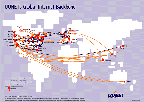
Distance and Time Through the Lens of Streaming Media
Friday December 17 & Sunday January 16, 2004; Madrid, Spain 20:00 (19:00 Greenwich Mean Time. 2PM Eastern Standard Time); Concert and live internet audio stream. Developed by John Roach with Miguel Ramos and Willy Whip Performers: Carlo Giordani, John Hudak, The Same Room Left, James Rouvelle, Mike Rosenthal, John Roach & Miguel Ramos.
Simultaneous Translation is an international networked performance that draws connections between language and the internet. Just as language has changed over time and as dialects have evolved as groups of people moved geographically from place to place, so in this project, live sound will be effected by time and distance. Audio created by the participants in Madrid, the US, Germany and Italy, will be broadcast live on the internet. [Related]
Posted by jo at 11:54 AM | Comments (0)
November 29, 2004
LiveForm:Telekinetics

Intertwined Networks
The Waag Society for Old and New Media has in 2004 commissioned Canadian artists Jeff Mann and Michelle Teran to produce and present the second iteration of the LiveForm:Telekinetics Project. LF:TK involves the creation of a series of site-specific installation/performance works connecting hybrid physical/virtual spaces using streaming media and networked kinetic objects. The commission is part of the Connected! project of Waag Society, a two-year programme of performances, lectures, workshops, installations, and emergent events exploring collaborative networked media and live art.
The LiveForm:Telekinetics project is envisioned as a laboratory that examines the intertwining of social networks and social spaces with their technological counterparts. As a work of art, it challenges and expands the notion of performance, the relationship of the artist and audience, production and exhibition, and ideas of locale and presence. The project creates hybrid installation/performative works, augmented with electronic devices and network systems, to create shared spaces and live social situations. Two-way streaming media such as video, sound, and graphics, are used to connect together physical sites via the Internet. Everyday physical objects within the environments become kinetic communications interfaces, animated with embedded sensors and actuators. In LiveForm:Telekinetics, mediating technologies are human-scale, built into architecture, furniture, decorations, utensils, toys, and the bric-a-brac that we surround ourselves with. Read more.
Posted by jo at 10:22 AM | Comments (1)
November 18, 2004
Séa.nce

Perpetual Emotions
Documentation of the Sea.nce performances on board the ISEA2004 ferry is now available.
Séa.nce is a networked performance which is a 'pataphysical' experiment to investigate networked emotions. It is part of The Perpetual Emotions Project. [Related]
Posted by jo at 01:08 PM | Comments (0)
Johannes Gees
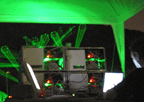
Hello, Hello Again
Recently added to "Showcase"--November 26, 2004 from 10 a.m. to 4:30 p.m.--at the ULTRASOUND festival, Johannes Gees will present and discuss his past and current projects. Gees became known internationally when he presented his interactive text projection, hellomrpresident, during the World Economic Forum in Davos. The piece was also nominated for the Transmediale Award in 2001. It was followed in 2003 by Helloworld, four giant laser text projections connected by internet and mobile phones in Geneva, Rio de Janeiro, Bombay and New York. Communimage--begun in 1999 in an attempt to entertain a visual global dialogue--is an ongoing collaborative art project in which thousands of people have contributed to a growing sea of images.
Gees' work has been shown in galleries and international art shows in Mexico, Brazil, Austria and Switzerland. He lives is Zurich, Switzerland, and is currently working on "Work School Birth Death," a series of text projections in different locations in Switzerland, and a new interactive laser project, "The Fuji San Project" in Japan.
VENUE: The Media Centre, 07 Northumberland St., Huddersfield, HD1 1RL, England; +44 [0]870 990 5007; info @ ultrasound.ws
Posted by jo at 09:33 AM | Comments (0)
November 09, 2004
M.U.S.H.

Hyperkinetic Possibilities
M.U.S.H. (Multi-User Sensorial Hallucination) is an interactive audiovisual space in which two people in different locations (DEAF04 in Rotterdam and STEIM in Amsterdam) are connected to each other by means of telepresence equipment. The user enters a dark, silent room. S/he can use a navigation stick to activate sound and image. This brings the system into a "hyperkinetic" state: there is a chaotic play of sounds, ghostly images flash, shadows appear and disappear...If the user moves the navigation stick back and forth long enough, rapidly and slowly, the image of the person in the other Mush-Room will gradually appear on the large screen.
The users' movements create the opportunity for a virtual meeting between two strangers. M.U.S.H. is based on synchronicity and creates the conditions for the testing of telepathic possibilities. The navigation stick is a wireless movement sensor that registers the changes in the speed at which the viewer moves it. On the basis of this signal the computer changes the "choreography" and the play of sound and image. To be performed at DEAF04: see details below.
Location Amsterdam: STEIM, Achtergracht 19, Amsterdam
Date: 10 - 21 November, 14:00-16:00 hrs and 18:00-20:00 hrs
Reservations: tickets@v2.nl & (010) 750 28 90
Location Rotterdam: DEAF04, Van Nelle Ontwerpfabriek, Van Nelleweg 1, Rotterdam
Date: 10 - 21 November, 14:00-16.00 hrs and 18:00-20:00 hrs
Reservations: tickets@v2.nl & (010) 750 28 90
Posted by jo at 11:12 AM | Comments (0)
October 27, 2004
ArtFutura
![]()
Augmented Reality
ArtFutura's theme this year is Augmented Reality. It's taking place now in Barcelona [October 28th-31st]. The programme includes Howard "Smartmobs" Rheingold, Blast Theory who will perform Can You See Me Now?, the SimpleTEXT performance, Dublin’s MediaLab Europe and Montreal’s SAT will be showcasing installations and developing experimental projects, Richard Marks, creator of EYETOY, Greyworld, Fiona Raby, etc. (via)

Saturday October 30, 2004 - 4PM - 8PM, Live from Barcelona, SAT presents Phéromones, the Art Futura's closing show. Phéromones is a network multichannel audiovisual techno performance regrouping musicians Alain Thibault, Physical Noise Theatre & Champion and VJ jocool , Ladyroll & Le couple in Barcelona as well as Yan Breuleux, Nuclear Ramjet & Johnny Ranger in Montreal.
Pheromones will connect by means of an optical fiber network of Internet 2 (providing data flows of up to 2 Gigabytes per second) the Mercat de les Flors at Barcelona and the head office of the SAT at Montreal in order to share music and images generated on both sides of the world, by means of an experimental technical support: eight audio channels and immersive multi-screens. R&D for clubbing culture.
From October 26 to 30, 2004
A team of 17 artists, researchers and technicians, as members of the Territoires ouverts - TOT - Open Territories consortium initiated by the SAT, are invited by the Art Futura festival to present their work in Barcelona.
Several of the tools developed at SAT, like the nSLAM multichannel audio application and pixelTANGO digital video mixer, will be put at contribution in order to show the know-how and the expertise of the developpers in the fields of IP streaming video and mulitichannel audio, IP telepresence (point-to-point and multi-point) and transmission of immersive audio-visual environments over IP networks.
The Open Territories project aims to foster the emergence of innovative forms of cultural expression by engaging the creativity of a new generation of artists and creators, in whose hands will be placed a host of advanced interface and networking technologies. The TOT project will be able to open the broadband network environment to talented creators who are ideally placed to illustrate broadband's potential as a means of avant-garde cultural expression.
Thursday October 28, 2004 - 10AM - 5PM
Friday October 29, 2004 - 10AM - 5PM
Saturday October 30, 2004 - 10AM - 4PM
SAT invites you and your friends to "cross the Atlantic" and project yourself at the beautiful Mercat de les Flors in Barcelona, site of the Art Futura Festival.
During the three days of the festival, using two Telepresence stations, people at both side of the Atlantic will be able to meet and speak as if they were sitting on the same table, with high audio and video resolution.
To participate and meet the catalan artistic community, Art Futura's visitors and the SAT team in Barcelone, come at the SAT Café each day between 10AM and 5PM (4PM Saturday).
Free entrance
Posted by jo at 02:00 PM | Comments (0)
October 23, 2004
Wirefire

Touch Through the Wires
Wirefire was an online performance and communications environment. The project, by entropy8zuper's Auriea Harvey and Michaël Samyn, utilized technology they developed to faciliate 'touch through the wires', combining chat, sounds, images, animations and live camera streams to form an interactive, improvisational expression that went beyond words. Wirefire is currently available in RANDOM FIRE/REPLAY VIEW only. [Flash 5 plug-in required.]
Wirefire was LIVE online every Thursday night at Midnight to Friday 1am ( Belgian time). Wirefire was meant to be performed and viewed online but non-virtual Wirefire performances were presented in venues such as the Brooklyn Academy of Music, New York; the Walker Arts Center; Minnesota; GMI screen, London; and Passage44, Brussels.
Posted by jo at 06:27 PM | Comments (0)
October 22, 2004
GilbertandGrape

Kiosk Correspondence
We'd like to invite you all to receive exclusive reports of GilbertandGrape's whereabouts at the Rogaland Kunstsenter, Norway and the Vlepo Gallery, NY. The performance can also be partly viewed online. GilbertandGrape will be staked out in a red phone kiosk by the pier on the west coast of Norway between 5pm and 7pm on October 25th, 2004. GilbertandGrape will call the Rogaland Kunstsenter from the phone kiosk every 15 minutes and upload a photograph from this moment to their website.
Kiosk Correspondance is a sub plot of the GilbertandGrape performance Lone Ranging Romance. Between 2004 and 2008 GilbertandGrape and their lone ranger, a 20 kilo stuffed moose head, will travel the coasts of England and Norway in a Volvo Amazon to search out and collect stories from people with an interest in nostalgia, document vague memories, exchange taped music that has romantic significance, and at the end of the day watch the sun set together with the people we've met. For more information on Lone Ranging Romance see our website. Love and Scandal, GilbertandGrape
Posted by jo at 03:53 PM | Comments (0)
October 20, 2004
1 year performance video
Help 1 year performance video
MTAA’s web art project 1 year performance video is a victim of it’s own success. The piece lives on Turbulence.org and it’s causing bandwidth overages. It’s a commission of New Radio and Performing Arts, Inc., (aka Ether-Ore) for its Turbulence web site. They are a not-for-profit arts organization that has been commissioning web and net art projects since the early days of the medium and they simply can’t afford the overage charges.
If you have resources to help us continue to serve this piece on the web please contact T.Whid using the email link on mteww.com/mtaaRR (near bottom of the left nav). If you are considering helping out, check out the piece: 1 year performance video.
mriver adds:
Please, please, please. We’ll behave for once AND we’ll give you a real live MTAA drawing. (9 x 12, ink on Arches watercolor paper) Ooo- la-la.
Originally posted by twhid at MTAA on October 20, 2004.
Posted by jo at 03:15 PM
October 19, 2004
Teri Rueb

Connecting via Fluid Space
"The integration of data space and real space through mobile media and location-based systems brings back into circulation a whole host of communication rituals and interaction styles that engage the body, movement and context-sensitive exchanges. With the increasing ubiquity of wireless and mobile media, space is imagined as a Hertzian soup – a space of flows that defies the clear and fast boundaries of visual space and concrete form, instead emphasizing our connectedness in and through the social body." Continue reading Syncopated space – wireless media shaping human movement and social interaction by Teri Rueb.
As a digital artist, Teri Rueb explores the relationship between sound, space and human movement in location-aware installations and large-scale responsive spaces. She exhibits and lectures widely in international venues and is a professor in the graduate Department of Digital Media at the Rhode Island School of Design (RISD).
Posted by jo at 08:30 AM | Comments (0)
October 15, 2004
City of Heroes
Virtual Memorial
"City of Heroes players memorialize Christopher Reeve: Memorial vigil held by players of the online superhero MMORPG honors passing of the Man of Steel"; by Tim Surette--GameSpot; POSTED: 10/12/04 02:01 PM PST
After the news of the passing of Christopher Reeve hit the airwaves, players of the massively multiplayer online role-playing game City of Heroes gathered together for a memorial for the fallen hero. Players gathered in full hero garb and saluted in tandem in memory of the man best known for playing Superman on the big screen. Reeve, who became a champion of spinal cord research following a paralyzing horse riding accident in 1995, died Monday as a result of heart failure stemming from an infection related to his paralysis. He was 52 years old.
Posted by jo at 12:47 PM | Comments (0)
October 09, 2004
Distance Focale (Focal Distance)

Making the Virtual Real
Focal Distance is a performance cycle device where users are invited to move avatars on a grid. These actions are reproduced in a physical space by a human operator moving objects on a table. Global input provided by participants is considered a material feeding sub-device that produces various media streams. There is an ongoing discussion (in english) about this concept and some resources (images + texts mostly in french) at www.x-arn.org.
Posted by jo at 01:41 PM | Comments (0)
October 08, 2004
Moon Radio

Mooning You 24-7
Moon Radio is now previewing their MyTV prototype, a programme of live, broadcast events that provide an opportunity for artists, producers and the Moon Radio community to plug-in a camera, choose a time and broadcast live to a worldwide audience 24-7.
MyTV will be launched online later in 2004. Until then, these performances will be archived and available for viewing at Moon Radio. Moon Radio webTV is a web streaming channel hosting live broadcasts, an archive of diverse films, documented live events, and an active online community of artists, filmmakers, content producers and regular viewers. It began in 2000 as an audio and video web streaming channel for artists to explore live web streaming technology. The project commissioned artists and hosted live events both online and in arts venues around the UK. Moon Radio webTV has developed to focus on building tools for the Moon Radio community. These include hosted forums, profiles of community members, and text messaging services.
Posted by jo at 09:10 AM | Comments (0)
October 07, 2004
Art's Birthday
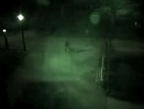
Scrambled Bites
An Experimental Data Visualization for Art's Birthday; Saturday, January 17th, 2004, 8PM- midnight (Visible from the OSU oval while facing Hopkins Hall)
Matthew Lewis and Daniel Jolliffe present their contribution to the Art's Birthday celebration, an annual event to celebrate the presence of art in our lives first proposed in 1963 by French artist Robert Filliou. Taking part in the Scrambled Bites data exchange project, we will work with data fed over the Internet from specially designed sculptures, devices and sensors made by artists in Australia, Japan, Canada and Austria. From Ohio, we will be sending to the other artists data representing activity in front of Hopkins, as well as the number and strength of GPS satellites in orbit over our location. This mass of data sources will be visualized in a video projection visible from the outside of Hopkins. Part visualization, part data modeling experiment, the resultant projection is a composite image of activity across the network and closer to home." Coordinated by the Vancouver-based Western Front artist centre.
Posted by jo at 07:13 PM | Comments (0)
September 30, 2004
1 year performance video (aka samHsiehUpdate)
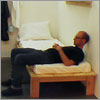
Mimicking Endurance: Who, Me?
"We shall seal images of ourselves in images of our studio, seemingly in solitary confinement inside seemingly identical images of cell-like rooms measuring 10ft x 10ft x 10ft. We seemingly shall not converse, listen to the radio or watch television, until--after you have viewed them for one year--we unseal our images...
"1 year performance video", commissioned by Turbulence, continues MTAA's series of Updates which resound seminal performance art from the 60s and 70s in part by replacing human processes with computer processes. For example, is there meaning in replacing On Kawara's zen-like devotion to his date paintings with an automated script which functions in a similar way?
1 year performance video takes Sam Hsieh's One Year Performance 1978-1979 (aka Cage Piece) and updates it in a number of ways.
First, we've taken the act of living in a cell and transformed it into images of ourselves living in a cell. These video clips are edited dynamically at runtime so that every viewer sees a slightly different cut. The clips are organized according to the clock: if you access the piece in the morning, you see us doing morning things; if you access late at night, you see us sleeping.
Second, we've transferred the onus of a 1 year commitment to the work from the artist to the viewer. The piece will be realized fully only when a viewer runs it for one year. As M.River put it:
"In the work, we mimic endurance without doing the labor. We also know the audience can just close the browser and walk away. No one needs to suffer on this one. The failure is built-in at the front end."
Will a viewer ever complete the work? It's doubtful.
Though the work stands fully on its own, another dimension is added when it's viewed in dialogue with the work that inspired it. The choices made in updating the work we believe speaks to how our society, culture, and the creative process has changed since the original was created.
1 year performance video (aka samHsiehUpdate) by MTAA. A 2004 commission of New Radio and Performing Arts, Inc., (aka Ether-Ore) for its Turbulence web site. It was made possible with funding from the Jerome Foundation.
BIOGRAPHY
MTAA (M.River & T.Whid Art Associates) is a Brooklyn, New York-based conceptual and net art collaboration founded in 1996. Their studies of networked & digital culture & materials; the institutions of art; and the pursuit of the absurd take the form of web sites, videos, installations, sculptures, and photographic prints. Their work has been commissioned by The Alternative Museum, Creative Time, New Radio and Performing Arts, Inc., and The Whitney Museum of American Art and has been exhibited by PS1 Art Center (New York, 2000), The Walker Art Center (Minneapolis, 2000), Eyebeam Atelier (New York, 2002) and Postmasters gallery (New York, 2004).
Posted by jo at 11:35 AM | Comments (1)
September 27, 2004
PsyGeoProvflux
![]()
Investigating Public Space
The PsyGeoProvflux was a two day event investigating how the urban landscape of Providence affects its social and artistic community. Sponsored by PIPS, the Provflux was dedicated to further investigations of contemporary psychogeography and experimental forms of public art. We hoped to create new collaboration between groups and individuals working with and interpreting the urban fabric of Providence. One part conference, and two part experimentation, the Provflux included public space reclamations, maps, 24 hour workshops, and lectures in an effort to discover the unseen in the Renaissance city.
Growing from the efforts of Glowlab in NYC and a larger network of psychogeographers worldwide, the Provflux was initiated after PIPS's participation in the first Conflux in NYC. This year the event has grown, including many more artists and projects deciphering the city in a four day event being held at the same time as the Provflux. We hope the energy generated from both shows can lead to further collaboration between artists and thinkers studying the city.
Posted by jo at 12:55 PM | Comments (1)
September 18, 2004
Chased in Brighton and Barcelona
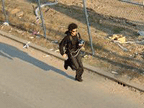
Can You See Me Now?
(from AudioHyperspace of SWR2 RadioART: Hörspiel by Sabine Breitsameter.) Highly recommended: For those who want to experience Blast Theory's live and online game "Can You See Me Now", note the following dates: From 27 September to 1 October 2004, you can take part - corporeal - in Brighton, UK, and from 28 to 31 October 2004, join the game in Barcelona during the "ArtFutura"-festival. Those who cannot make it to these places: It is also fun to join the game online. [more]
Posted by newradio at 10:48 AM | Comments (0)
Rafael Lozano-Hemmer

Relational Architecture
FREQUENCY AND VOLUME consists of between 100 and 800 square metres of projected shadows which allow participants to scan the radio spectrum of the city with their bodies. As a shadow appears it tunes any radio frequency between 150kHz to 1.5GHz based on its position monitored by a video tracking system. The size of the shadow controls the volume gain of the specific audio channel. We can have 16 frequencies tuned simultaneously and the resulting sound environment is a composition controlled by people's movements. This piece investigates the contested radio space in the context of the increased surveillance of the body as an antenna. The system tunes all sorts of signals including air traffic control, short wave radio, cell phones, police, taxi dispatch, pagers and more. View Quicktime Movie or look at more projects.
Posted by jo at 07:02 AM | Comments (0)
September 15, 2004
Elastic Test
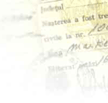
eliminate undesirable foreigners
Immigration authorities around the world need our help!! Use this website to contribute your ideas or proposals for an elastic test that can be devised to eliminate undesirable foreigners.
Immigration Statutes around the world are generally written using vague or abstract notions such as good moral character. It is the messy job of the courts to make such abstractions concrete, to objectively test and measure the moral character of a foreigner, and to eliminate arbitrary or contingent factors from the immigrations process. Join us in doing our part. We will invent, develop and implement numerous elastic tests, which can help the authorities contain and eliminate undesirable foreign bodies. Some of these tests will then be executed on our foreign test subject in a series of live and webcast performances.
Robert Lawrence (UNIMAS, Sarawak, Malaysia and USF, Tampa, Florida) wrote to us about this project on July 22, 2004. He said:
This project from the beginning has had an open door for participation through the web, but currently we are looking for ways to decentralize the project in more significant ways. Some issues related to this on which we are cogitating:
1. Given that our interventions require location-specific collaborations, how can the role of trans-local media, networks or distribution channels be re-imagined?
2. How can the project become less centralized? What are some models of de-centered cooperation we can try to implement – what is the advantage of a distributed network of creators in this case?
3. How might considerations of distribution and re-usability expand the current scope of the work?
4. One of the important aspects of the work is initiating and facilitating new relationships between local communities and structures – is this sustainable?
As we continue to evolve this project and develop ways to ‘turn it loose’ we are very interested in engaging in dialogue, theoretical and practical collaborations, and discovering and developing new models for distance collaboration.
Another of Lawrence's projects Un Message, Evidemment was blogged here.
Lawrence had this to say about it:
"The ‘story’ will be told entirely in the recorded messages that the foreground characters are listening to on their cell phones. These stories will be selected, synthesized and/or adapted from the contributions at this website and other venues. These stories will be gathered in several ways. Whenever the film in progress is shown at festivals, workshops or any other venue people will be asked to contribute storys by phone, sms, email. Participants will be encouraged to engage the performance on any number of levels.
We are also seeking opportunities to workshop the film doing shooting or writing. The “completed” film provides another dimension of the viewer/performer dynamic. At every stage of production, post-production, and presentation the ‘final form’ of the film will be negotiable. It will be shown in a user interactive form on the web, and in ‘concrete,’ though varying, versions in festivals and the usual film art venues – It may not ever appear in the same form twice."
Posted by jo at 08:46 AM | Comments (0)
August 22, 2004
Jane's blog
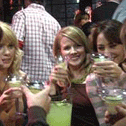
Blogging, for Real?
Hi, I’m Jane and I’m an 18 year old supermodel from the Ukraine. I’m lying, I’m a 28 year old hair stylist from Minnesota...I’m really psyched to share my blog with you guys...and if you have something to share with me, go for it! especially if you have a cute brother or know where to find a great hamburger. xo, J (by the way, I’m not actually real, I’m a fictitious character on the TV series Good Girls Don't. But that won’t stop me from writing to you every day. I mean, every weekday. Cause on weekends I’m in party mode.)
Via "Jonah Peretti and Jane's Blog", 16:26 JST » Blogging about Blogging-Joi's Ito's Diary
Posted by jo at 01:02 PM | Comments (0)
August 19, 2004
Active Ingredient
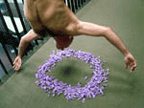
New Moon Radio
Active Ingredient have been creating exciting and innovative projects since 1996. Their work has included: Chemical Garden, “A modular garden built in units containing strange plant life and internet controlled robots”; Ghost Engine, a live online séance; Big Up Yourself, a participatory project working with Galleries of Justice.
Moon Radio, begun in 2000, has hosted many live broadcasts, new films and commissioned projects. All New Moon Radio... marks a new era for the project, reflecting the changing pattern of innovation on the web. Now at the heart of the project is the audience - their web community – interactivity and participation. Using chat rooms, SMS texting, community profiles (…and coming soon artist Blogs) Moon Radio aims to become a space that is alive with debate, activity and new projects, reflecting the audiences needs and desires.
Posted by jo at 11:42 AM | Comments (0)
Bodies in Flight

skinworks
Bodies in Flight make performances with new technologies in cutting edge venues that challenge and re-energize the conventional relationship between audiences and performers, and audiences and place. In skinworks, 2 handles appear in a chatroom; they’re anonymous, they’re anybody, everybody, they’re angels, demons, they’re hermaphrodites; they’re making a new kind of love, mailing valentines into the void. Three performers cruise the web, crashing chatrooms, flipping identities, spinning yarns, beguiling, ensnaring unsuspecting novices, seducing each other, pushing imagination beyond the tech spec.
Posted by jo at 09:25 AM | Comments (0)
August 18, 2004
coffee and avatar, please
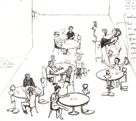
The Chit Chat Club
It will be a real cafe, with real tables, real coffee and pastries...some of the chairs will be regular chairs;... others will be seats for avatars, equipped with monitors and network connections...There are multiple ways to interact ... in the Chit Chat Club. As in an ordinary cafe, people can walk into the physical Chit Chat Club space, order a coffee, sit down and talk with others and people watch. One can also enter the Chit Chat Club remotely through the website and occupy an avatar chair. This action opens a real-time two-way audio and graphical connection between the physical space and the online participant. Finally, a person physically present in the Chit Chat Club space may also occupy an avatar chair.
Sounds fun to me. Check out the website
Posted by newradio at 05:47 PM | Comments (0)
August 17, 2004
Chiasma
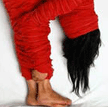
03 Biennial of Performance Art
Chiasma--a seventy-two hour, online performance art exchange--was a collaborative project between three international arts organizations: grunt gallery (Vancouver, Canada), Imperial Slacks (Sydney, Australia) and Folly (Lancaster, UK). Chiasma utilized live web streaming technology to investigate the potential of international exchange and collaboration through the web. Three artists--Rebecca Belmore, Lea Donnan, and Hester Reeve--were commissioned to create a piece of work specifically intended for live web cast. The performance was viewable virtually (as a screen on the web site) as well as remotely in six partner galleries spaces across the world.
Posted by jo at 05:10 PM | Comments (0)
August 12, 2004
SimpleTEXT
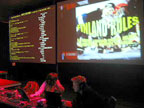
zeitgeist performing
SimpleTEXT is a collaborative audio/visual public performance that relies on audience participation through input from mobile devices such as phones, PDAs or laptops' (from simpletext website). This installation, created by mixing and matching older software projects by Jonah Brucker-Cohen, Tim Redfern and Duncan Murphy, accepts real-time SMSs and text messaging in order to create live music and visuals. The software first parses the text, which dictates the music, then uses these messages to rhythmically drive speech and picture synthesizers (direct from the web using google's image search). Although I've never seen it, my guess is that the most interesting part of this performance would be seeing a dialogue emerge between the piece, the performers, the audience SMSing in the space, and the audience texting from the web. A zeitgesit of ASCII that reiterates.... iterate.... iterative.... (ad nauseum) (Posted by Nathaniel Stern)
Posted by at 02:57 AM | Comments (0)
August 03, 2004
Lag and Flux as Starting Point
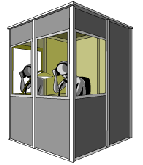
Simultaneous Translation
John Roach is working on a multilocation networked audio performance called Simultaneous Translation which will involve players from USA, Spain, France, Italy and Germany. The first performance is slated for November 2004 in Madrid Spain. Other manifestations are planned for NYC and Trondheim Norway.
"In my first foray into networked performance entitled Negative Space it was the limitations of the streaming media which made the project difficult and exciting. This lag and flux is the starting point of Simultaneous Translation in which the idea of flux and slippage is put in the forefront and is compared to the slippages and mutations of language as it evolves. Another point of comparison is to the delays that occur on the web as data passes from router hop to router hop. In fact traceroute data will be used to manipulate audio streams from the remote participants, making the delay of the internet itself an active player in the project."
Posted by jo at 05:03 PM | Comments (0)
August 02, 2004
Agora Phobia (digitalis)
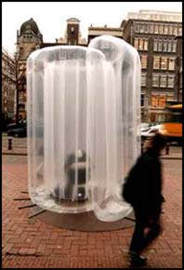
Agora Phobia (digitalis)
by Karen Lancel
Eyebeam presented the U.S. premiere of Agora Phobia (digitalis), a physical and online art project that questions mental images of being (un)safe and isolated. The physical component was installed on the street in front of Eyebeam's Chelsea facility in 2000. Created by Dutch artist Karen Lancel, Agora Phobia Digitalis invites the audience into a semi-transparent, inflatable Isolation Pillar which contains an online computer. Only large enough for one person to enter at a time, participants can feel the crowd outside but can only vaguely see shapes and figures around them. Inside one feels very safe within an intimate space, and at the same time, lacking contact with the outside. Viewers inside the pillar may participate in an internet-dialogue with people living in isolation elsewhere: a prisoner, a nun, a digipersona, a prisoner of war (POW), someone suffering from agoraphobia. The resulting dialogue is published on www.agora-phobia-digitalis.org and is part of an archive of chatsheets, performances, and installations. Agora Phobia Digitalis examines fluctuating notions of security in private and public spaces both physical and virtual.
Posted by michelle at 12:16 PM | Comments (0)
August 01, 2004
Tele-Actor
Hello all:
I am really amazed by the amount of activity on the blog -- looks like we've hit on a potent topic.
One project I want to add to the mix is Ken Goldberg's Tele-Actor , which is now about two years old. People online vote on what they want an actor to do. That actor is equiped with a wearable computer, including cams, mics, etc.
From the website: "The "Tele-Actor" is a skilled human with cameras and microphones connected to a wireless digital network. Live video and audio are broadcast to participants via the Internet or interactive television. Participants not only view, but interact with each other and with the Tele-Actor by voting on what to do next. Our "Spatial Dynamic Voting" (SDV) interface incorporates group dynamics into a variety of online experiences."
It seems to me that many of the pieces mentioned so far not only are networked or distributed in nature, but also utilize non-linear narratives that have not been been predetermined. Coincidence?
Brooke
Posted by at 10:04 PM | Comments (1)
Distributed Opera
The BRAIN OPERA
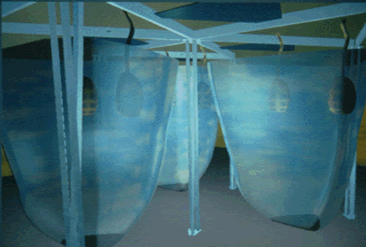
Premiered in 1996, this interactive, musical journey was presented simultaneously in physical and cyber space. A viewer could perform live in the Brain Opera performances via " T h e P a l e t t e," musical instrument. This advanced, multi-user Java applet, was only active during Brain Opera performances. You could also see and hear live video and audio broadcasts of the Brain Opera performances.
The culmination of the Brain Opera experience was the 45-minute Final Performance--a 3-movement composition tied together the project's many musical, visual, and textual strands into a unified tapestry. Three performers shape, select, and interpret precomposed and audience-created elements, using specially-designed hyperinstruments: the Sensor Chair (which translates wireless body movement into sound); the Gesture Wall (a modification of the same instrument from the Mind Forest); and the Digital Baton (which combines pointing, squeezing/selecting, and motion sensing). A large curved screen and multiple projectors allows a constant flow of images to be presented in coordination with the music, illustrating Minsky's words, providing counterpoint to the music, or illuminating the actions of the performers. The audience is also invited to dance on a Sensor Carpet during the Finale, adding sound to the richness and intensity at the end of the work.
Posted by michelle at 04:51 AM
July 31, 2004
Mobile Culture-Scratching
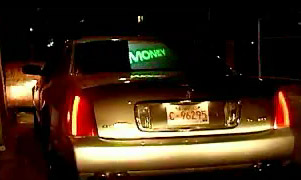
by Julie Andreyev, at New Forms Festival 2003, consists of 3 cars fitted with video projection on the rear windshield. Each car has a theme determined by the character of the car, and by characteristics of the host city where the fleet is mobilized. The choice of cars for the project reflects the specific car culture of the host city expressed through customization and branding.
Mobile Equipment
The cars are set up with equipment to allow for mobile video downloading, and video mixing using data from the car. While the fleet is mobile, videographers in the downtown site are creating videos for projection on the cars. The themes are used as a guide for them to create footage of the activities of a city's inhabitants.
Networked Process
This footage is uploaded by the videographers onto a web server. Then, the footage is downloaded by the cars as they drive by WIFI (wireless internet) download sites. A sound artist records ambient sound using a microphone held outside the window of one of the cars, mixes this, and plays it back using an FM transmitter. Nearby cars can tune into our frequency and hear the audio sampling. Each car is equipped with a sensor and software patch that interprets data from the car.
Software Interface
For example, one sensor reads data from the engine speed. This data causes a kind of 'jittery' effect to be applied to the video. The faster the car revs, the more 'jittery' the video. In this way, not only are the inhabitants of the city portrayed, but also the car is expressed in the video. After the performance, the cars can be driven into a gallery space where they can be set up to project their archive of the evenings' videos.
Mobile Portrait of the City
The goal of this project is to create a mobile portrait of the city through video and audio sampling of real time events. VJ-Fleet relies on current VJ (or video jockey) culture and the hosting city's local car and social culture. For each performance the project is customized and scaled to reflect the particular nature of the host city.
Posted by michelle at 06:37 PM
Historically Locating Distributed Performance
2004.04.05 Helen Thorington, writing about an early conference proposal:
The following are examples of distributed performances:
Finding Time (Jesse Gilbert, 2000). Finding Time linked performers on six continents in a series of live musical events, each an hour’s duration.
World Wide Simultaneous Dance (1998, Laura Knott). The project took place simultaneously in twelve countries.
In both examples the performers played to audiences in their performance spaces and to a worldwide Internet audience by means of especially created websites.
I then move on to a brief history, beginning with Kaprow's "Hello Hello" in the mid-60s--about which I can find very little information other than that it linked five sites in a television event. And on to Kit Galloway and Sherri Rabinowitz.
But the history is the not the question for me. Internet works resonate with historical issues. But what I'm beginning to think as I research for the conference is that we may already have witnessed the passing of the (pre)structured presentation of large-scale performance works--I keep thinking, for instance, that while Adrift (1997-2001) was very different from other works produced at its time, it was also very traditional. It was a work by three artists (the senders), in which its audiences had no agency at all--Like radio, like television, they were cast in the role of "receivers."

From the Adrift performance
Now...when did it happen?...the Internet environment is in a far more participatory stage and people-interest runs to works/platforms/
environments in which the former viewer can play an active role. Which may begin to explain why there are really not very many interesting large performance works being produced at this time. Not only is the technology still difficult but the environment is no longer congenial.
Or am I wrong? And if not, what does this do for/to our conference?
I'm going to think about this for awhile. Right now my only thought is that if this is so, the conference itself should reflect it and include the many twists and turns performance has taken in the last years.
Posted by michelle at 01:22 PM | Comments (0)
July 30, 2004
Distributed Cinema
SPEC-FLIC
Described by Adriene Jenick as a "Speculative Distributed Cinema Project....a series of fictional events performed as distributed cinema. SPEC-FLIC is a platform for speculation, creative experimentation and imagination among UCSD students, faculty, staff and the larger public. SPEC-FLIC's title refers to speculative fiction (an area of science fiction that is focused less on new science/tech and more on societal impacts) as well as to the size (a "speck") of the PDA-based video frame that serves as the conduit for this durational collective performance. Originally described as a distributed science fiction soap opera in three phases."
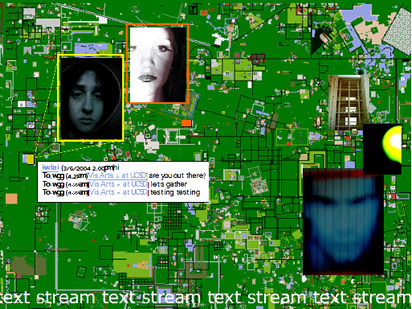
Adriene, tell us about this image.
What is the technology and experience behind this work?
Would you speak about the progression of your work from Paper Tiger television to Desktop Theatre on the internet to Active Campus and Spec Flic on the wireless network?
In your initial post you note these ongoing issues. Can you discuss them by way of examples from your work?
- timing/pacing/duration
this can be thought of from the perspective of participants or from "viewers" - in my experience the "lags" and glitches are all absorbable within the context of a live event. The archiving of this work does not allow for its tension to exist
- relationship of writing to performing, or textuality and orality
this is hugely fascinating to me especially considering the constant evolution of written and spoken language
- use of agitprop to catalyze unexpected engagements
all of my work is engaged within the larger "publc sphere" and cedes a large amount of control to the folks who are engaging with it.
Regarding SPEC-FLIC, your blog shows you in the midst of testing equipment. What are you testing? What is your creative process for working with technology and networks?
Posted by michelle at 09:42 PM | Comments (0)
Distributed Performance or the Left Hand Knows...
July, 1962:
Nam June Paik devised a piano concerto for simultaneous performance in San Francisco and Shanghai, with the left hand part being played in the USA and the right hand in China. The first telecast to Europe and America took place over Telstar 2 in July 1962.
Posted by newradio at 07:33 PM | Comments (0)
Networked Local Performances
Three Performances: 2001-03: A Comment
The three location-specific performances Dialtones: A Telesymphony, Flip Flop, and Texterritory --you had to be there to experience them--introduced in the last posts were produced between 2001 and 2003 They made use of networked technologies--mobile phones, video/audio relayed by wireless broadband--to involve their audiences in the creation of the performances. Each has done this successfully in its own way, while maintaining control, in the case of Dialtones, a tight control, over the performance itself.
Posted by newradio at 10:06 AM | Comments (0)
July 27, 2004
Networked Streaming Audio Performance
forwarded by Shu Lea Cheang -
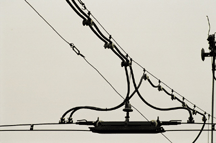
TRAMJAM - VIENNA RUSHHOUR by Mumbai Streaming Attack
A multi-track-multi-driver mix hub streaming jam session of Vienna city vibe, orchestrated in sync with the city's tram routing schedule.
TRAMJAM is a project that Shu Lea Cheang started when teaching networked performance at Zurich's HGKZ. The work will go on to other cities where there are tramlines. The next stop- Rotterdam and the Deaf Festival ’04 Affective Turbulence: The Art of Open Systems in November.
Thanks for sharing this event Shu Lea.
Would you comment on your involvement in this project?
Can you, for instance, compare the Zurich and Vienna experiences?
Is there online documentation of the Zurich events that you can direct folks to?
Collaborative and collective process is really important to us (blog & conference organizers) and we see it as a core component of networked_performance - both within groups developing work, and with the inclusion and contribution of viewers/users/participants/ to the work. The website notes that 'the Mumbai Streaming Attack study group expands to include local participants for each performance'. Do you mean in the respect that participants can upload sounds and contribute in that manner - or do you also connect with local artists for implementation/augmentation of prior iterations of the work? Would you talk about the technology and process involved?
Would you give us an overview of your personal practice and describe how this particular project is a continuation of that or has grown out of your former practice? Would you comment on your specific involvement in this project?
ABOUT THE WORK: Each driver/jammer conceives and collects soundfiles for a chosen tram route, joins together on location and online to perform collective impressions of Vienna city limits, whose tramlines connectivity forms the city's transport mainframe.
Along each tram route, personal, social and political association are considered for the composition of the specific sound files. Local sound artists, hackers, jammers are invited to “drive” and “mix” the (sound)stracks. The city's tram info broadcast cuts in to inform the happenings by the minute as the trams cable through the cities.
TRAMJAM also extends its programming to involve the city's mobile community. Through mobile devices, the transporting public are invited to send in voice/sound/texts messages for the mix.
The live performance is streamed live on the internet and on local radio. We invite the travelling public to listen in with their travelling radios. The orchestration of the tramlines/tramtracks is self-directed syncopation with open source soundfiles that are accessible to all participants.
Mumbai Streaming Attack is a networked performance study group currently based at SNM/HGKZ in Zurich. The group first performed TRAMJAM-ZURICH RUSHHOUR for broadcast at reboot.fm (Berlin) in February, 2004. The group's members expand to include local participants for each tram city performance.
Posted by michelle at 01:58 PM | Comments (2)
July 26, 2004
A PDA walkabout in Joyce's Dublin
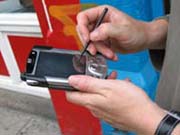
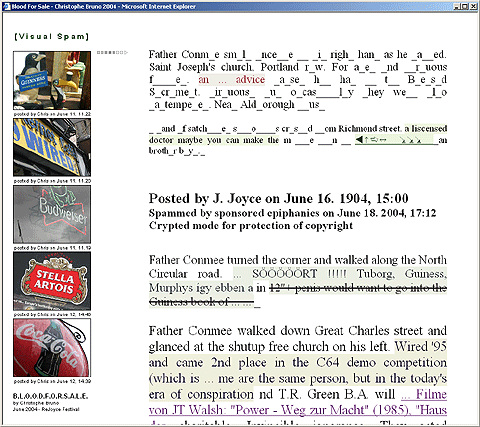
The program allows these "sponsored epiphanies" to disturb and transform the text of Ulysses, "Wandering Rocks", by incorporating themselves into the text. The real-time evolution of the text is displayed and graphically animated, sentence by sentence, projected in different places in Dublin, and online. By the end of the performance, carried out over several days, the original text by Joyce is almost entirely replaced by the "sponsored epiphanies."
Posted by michelle at 06:26 PM | Comments (0)




